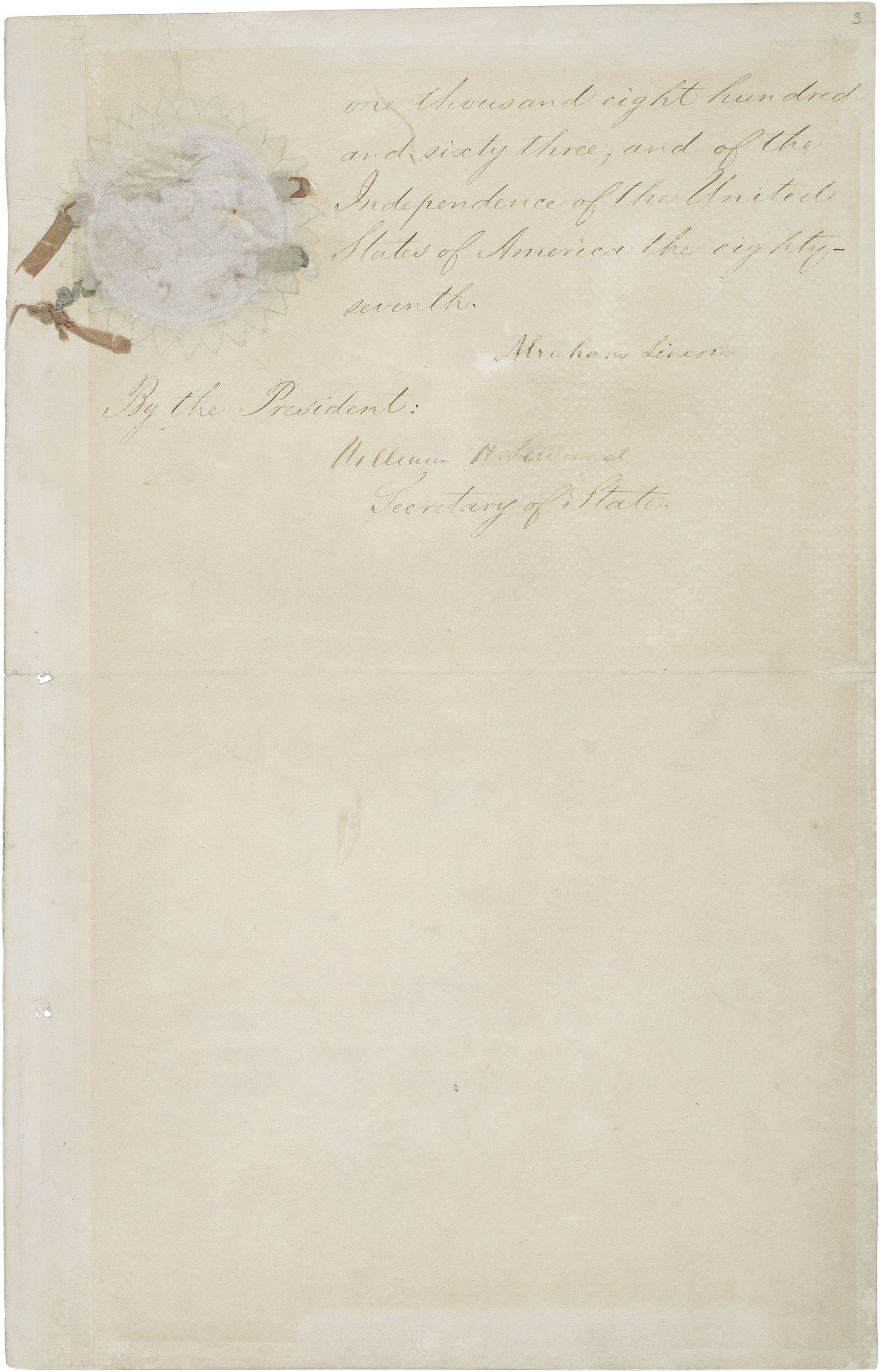What Else Was Happening During the Civil War Era?
Finding a Sequence
All documents and text associated with this activity are printed below, followed by a worksheet for student responses.Introduction
In this activity, you will see 16 documents in random sequence, all of which were created between 1850 and 1877. The years leading up to, during, and following the Civil War are most often remembered for the tension between North and South, the slavery question, President Lincoln, and Reconstruction in the postwar South. Other important changes, however, occurred.Try to guess the correct order of the documents just by looking at their titles (move cursor over document thumbnails). Then, closely examine each document to determine what change was taking place and move the documents into the correct chronological order.
Class:
Worksheet
What Else Was Happening During the Civil War Era?
Finding a Sequence
Examine the documents in this activity. Put the corresponding document numbers in order using the list below. Write your conclusion response in the space provided.Activity Element
Draft of Senate Joint Resolution 16 Submitting the 13th Amendment to the States
Page 1
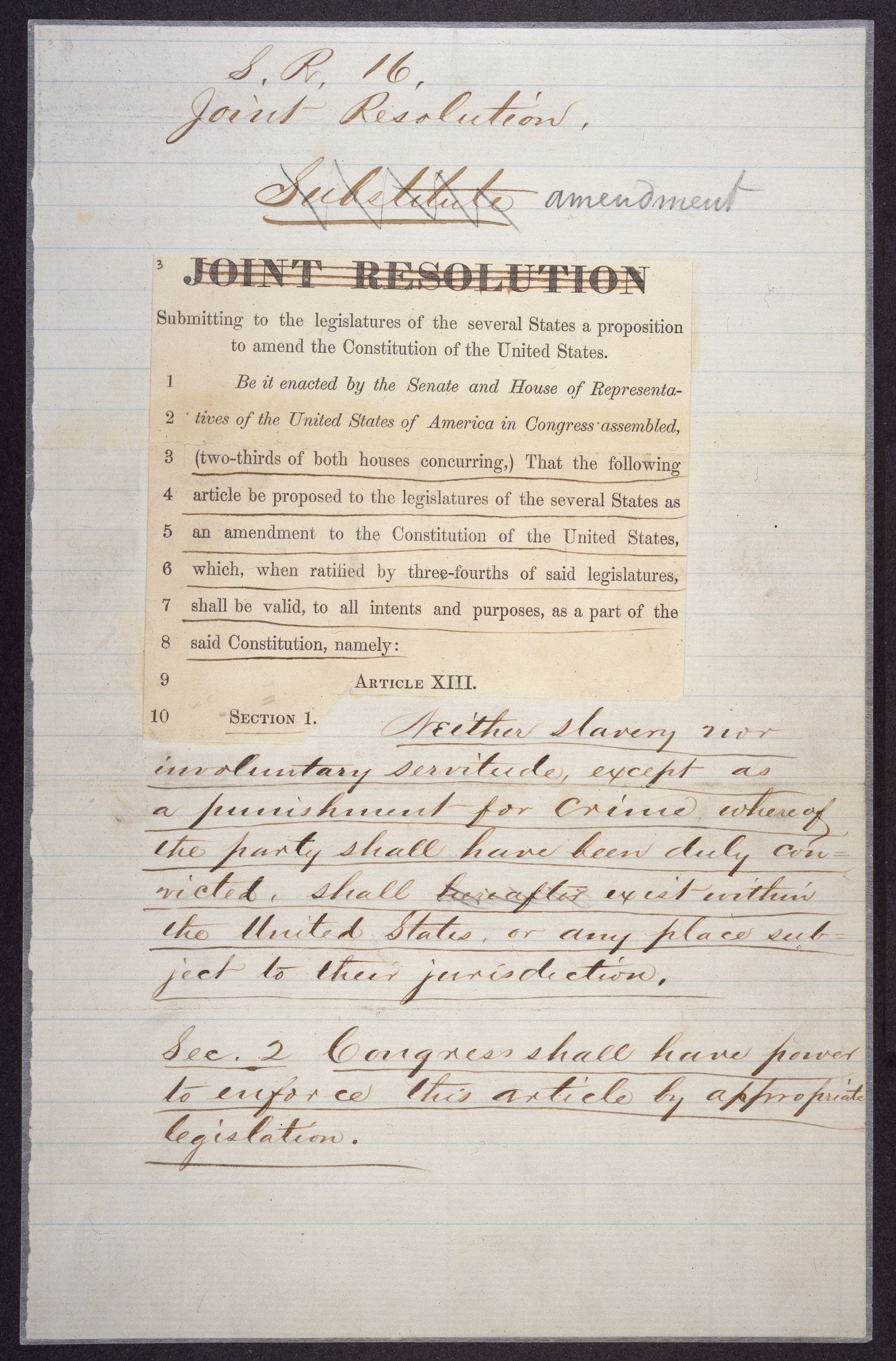
Activity Element
Emancipation Proclamation
Page 1

Activity Element
Treasury Warrant in the Amount of $7.2 Million for the Purchase of Alaska
Page 1

Activity Element
Yellowstone Park Act
Page 1
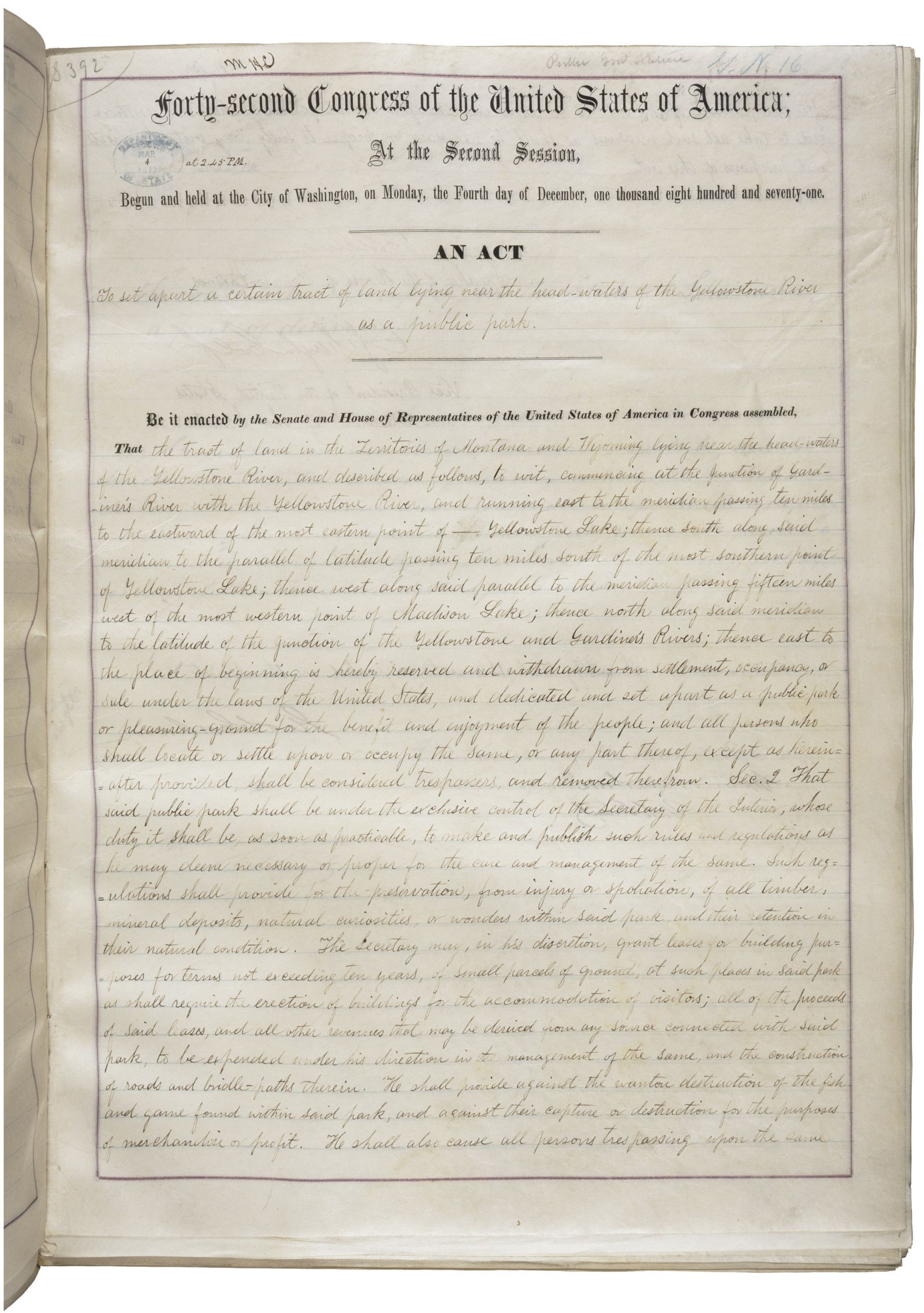
Activity Element
Joint Resolution Proposing the Fourteenth Amendment to the United States Constitution
Page 1
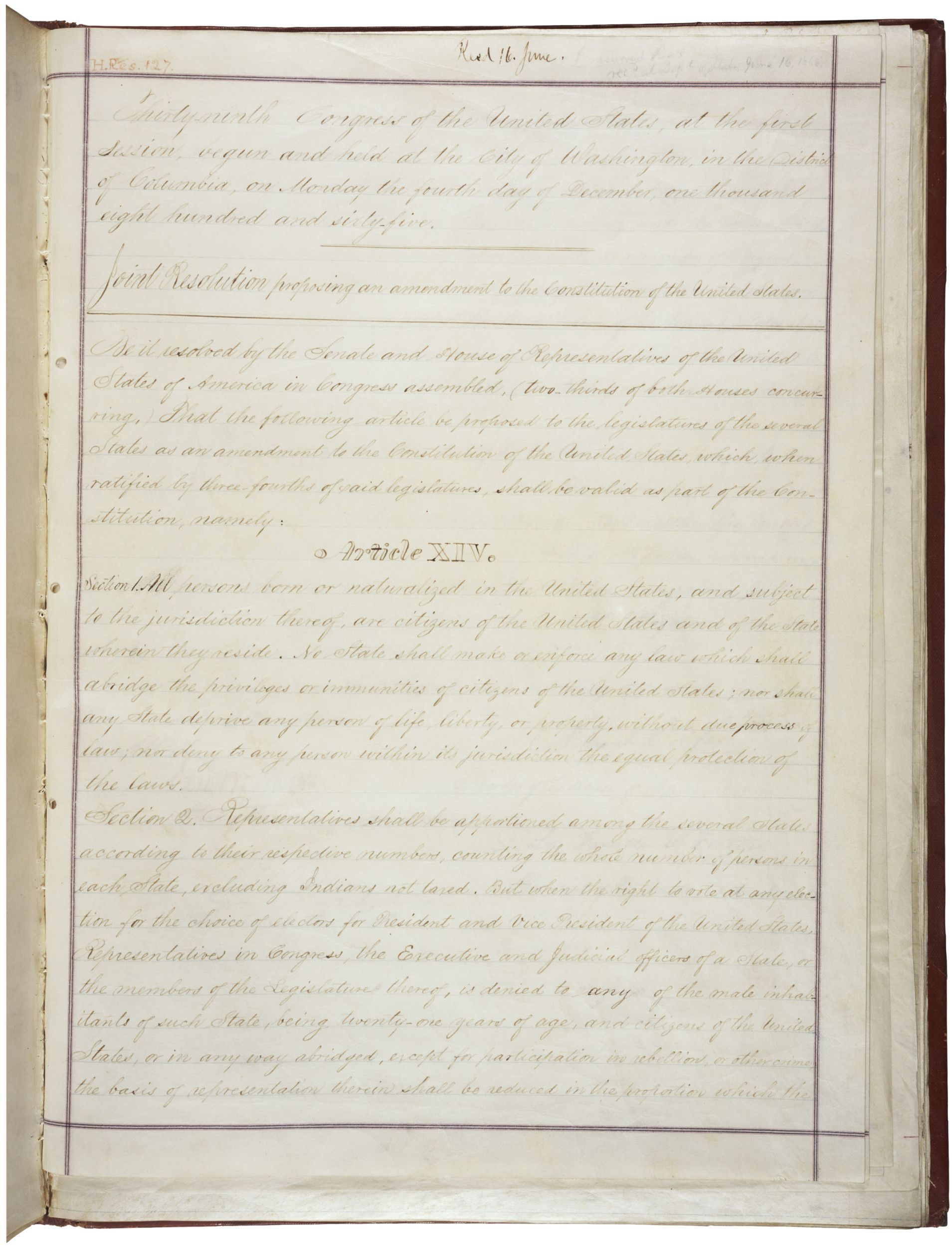
Activity Element
Articles of Agreement in Regard to the Surrender of the Army of Northern Virginia Under General Robert E. Lee
Page 1
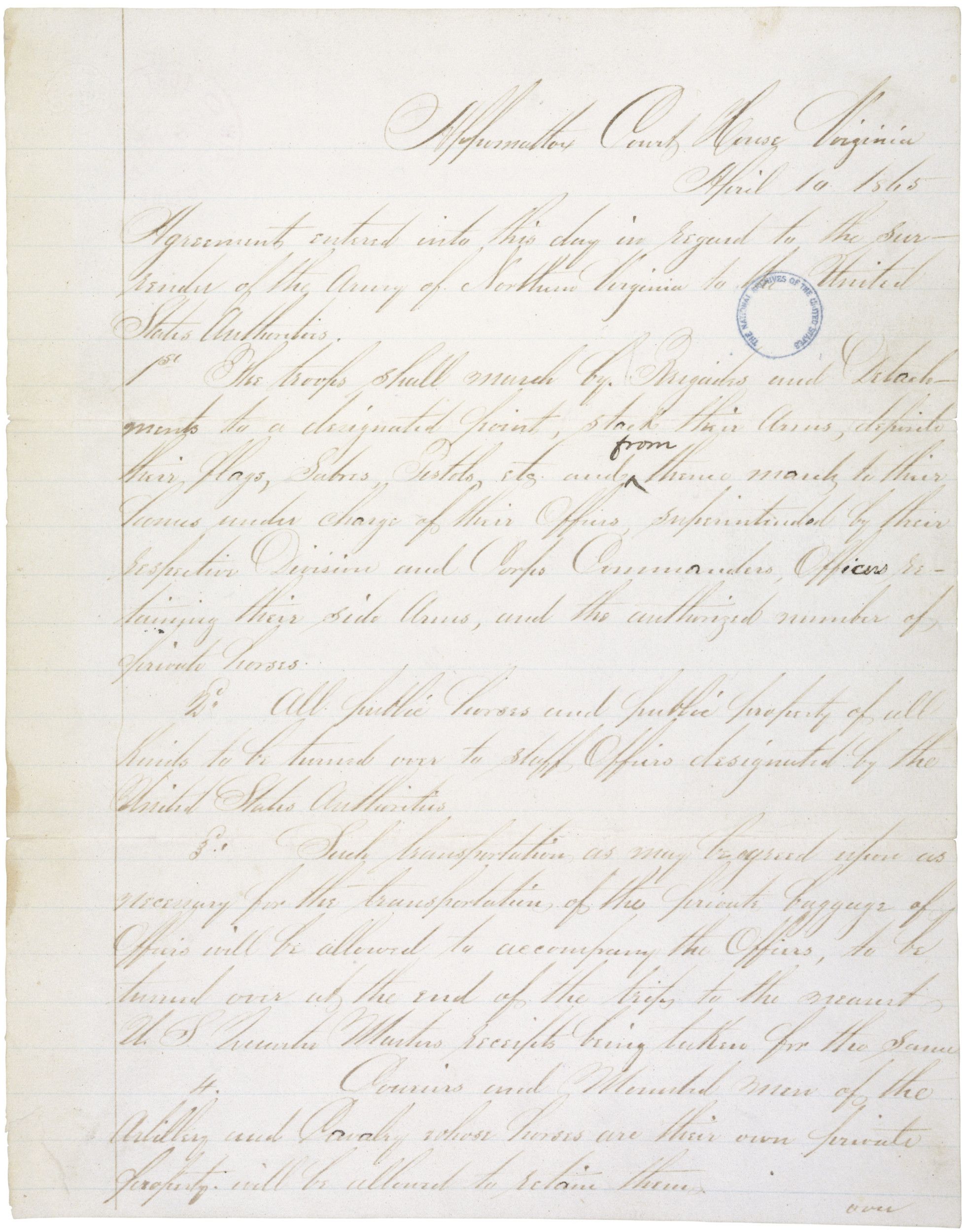
Activity Element
Judgment in the U.S. Supreme Court Case Dred Scott v. John F. A. Sandford
Page 1
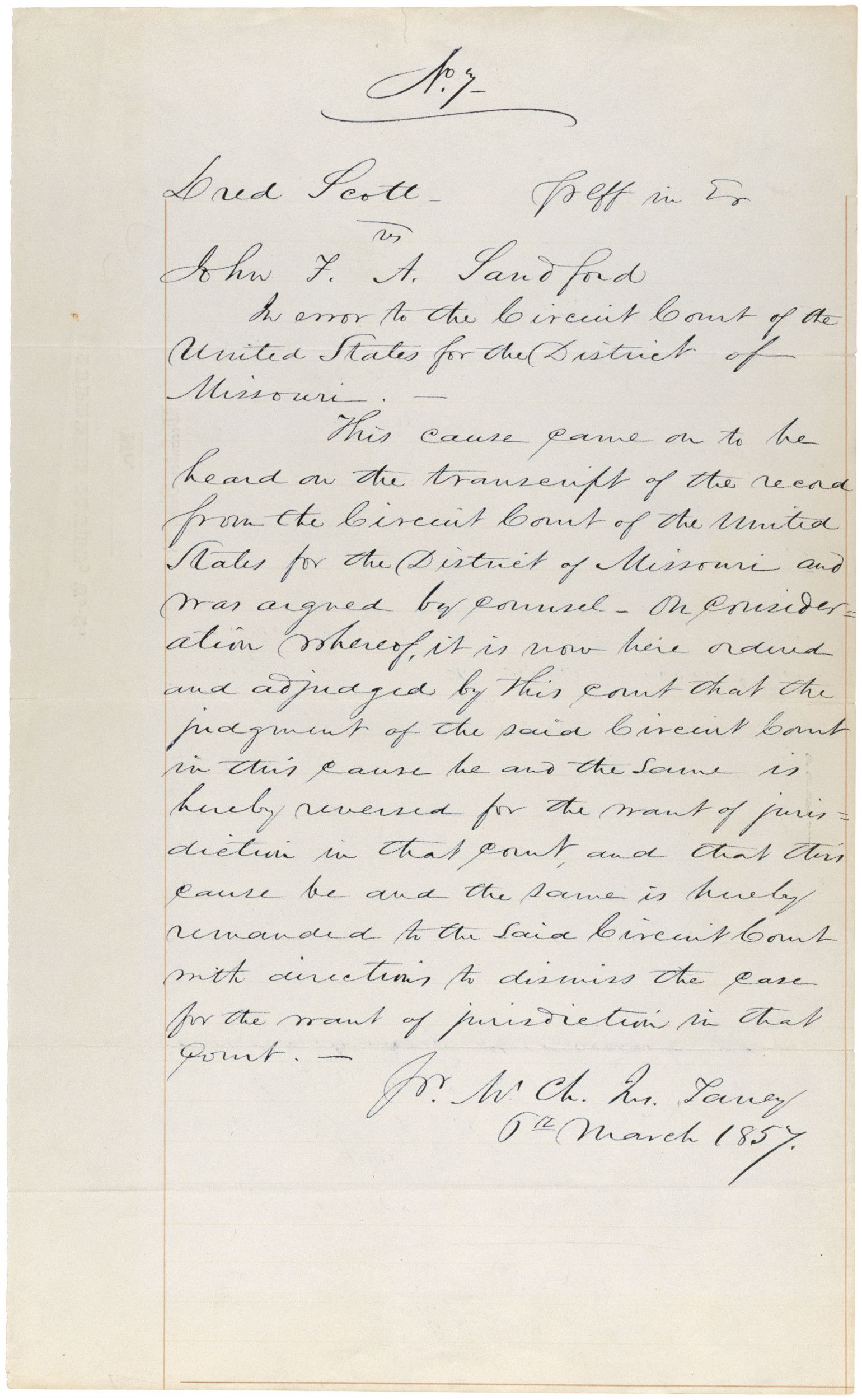
Activity Element
Petition from Lewis Douglass and Others to the Secretary of War
Page 1

Activity Element
Kansas Nebraska Act of 1854
Page 1
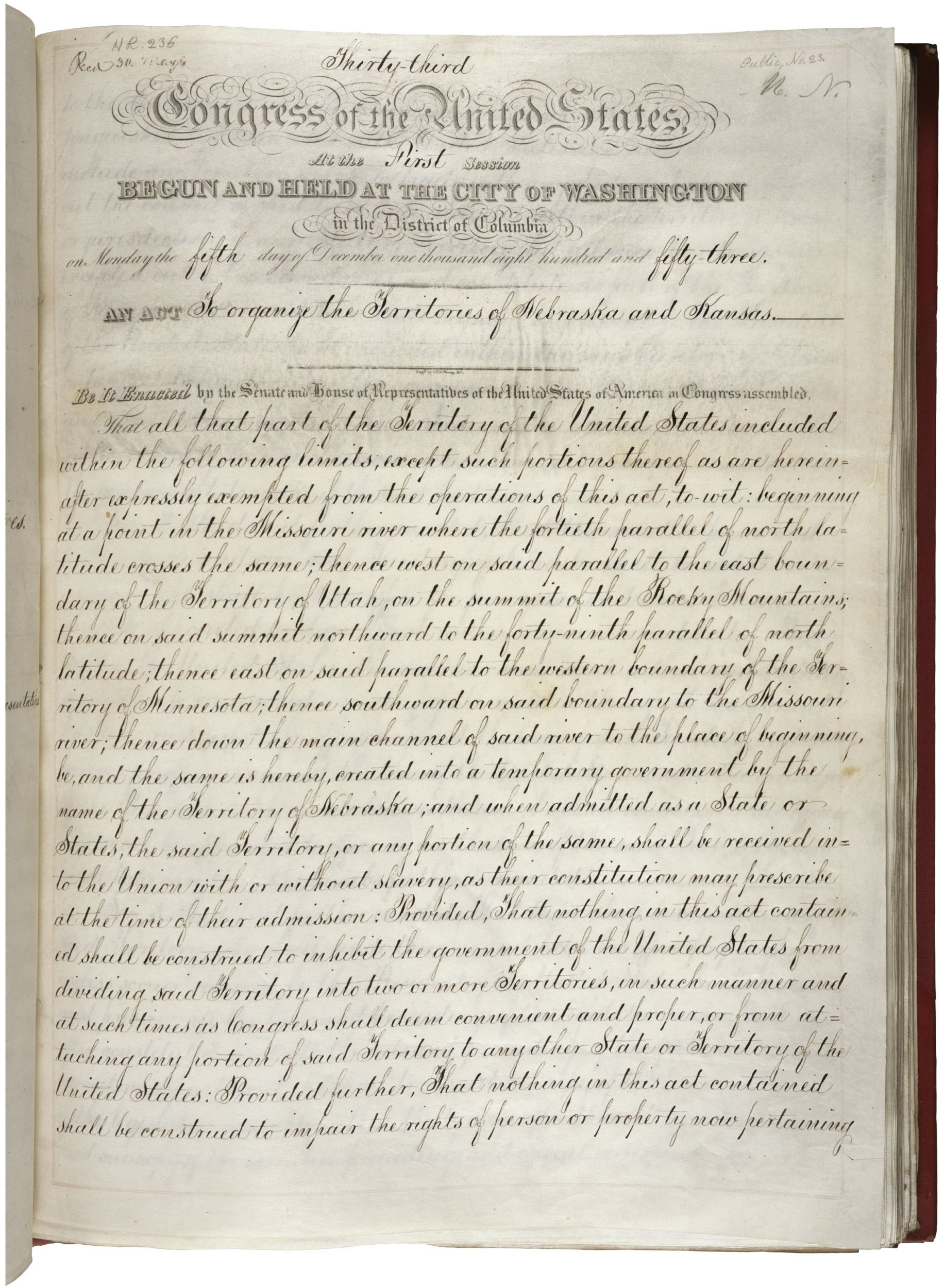
Activity Element
Act of May 20, 1862 (Homestead Act), Public Law 37-64 (12 STAT 392).
Page 1

Activity Element
Fort Laramie Treaty
Page 1
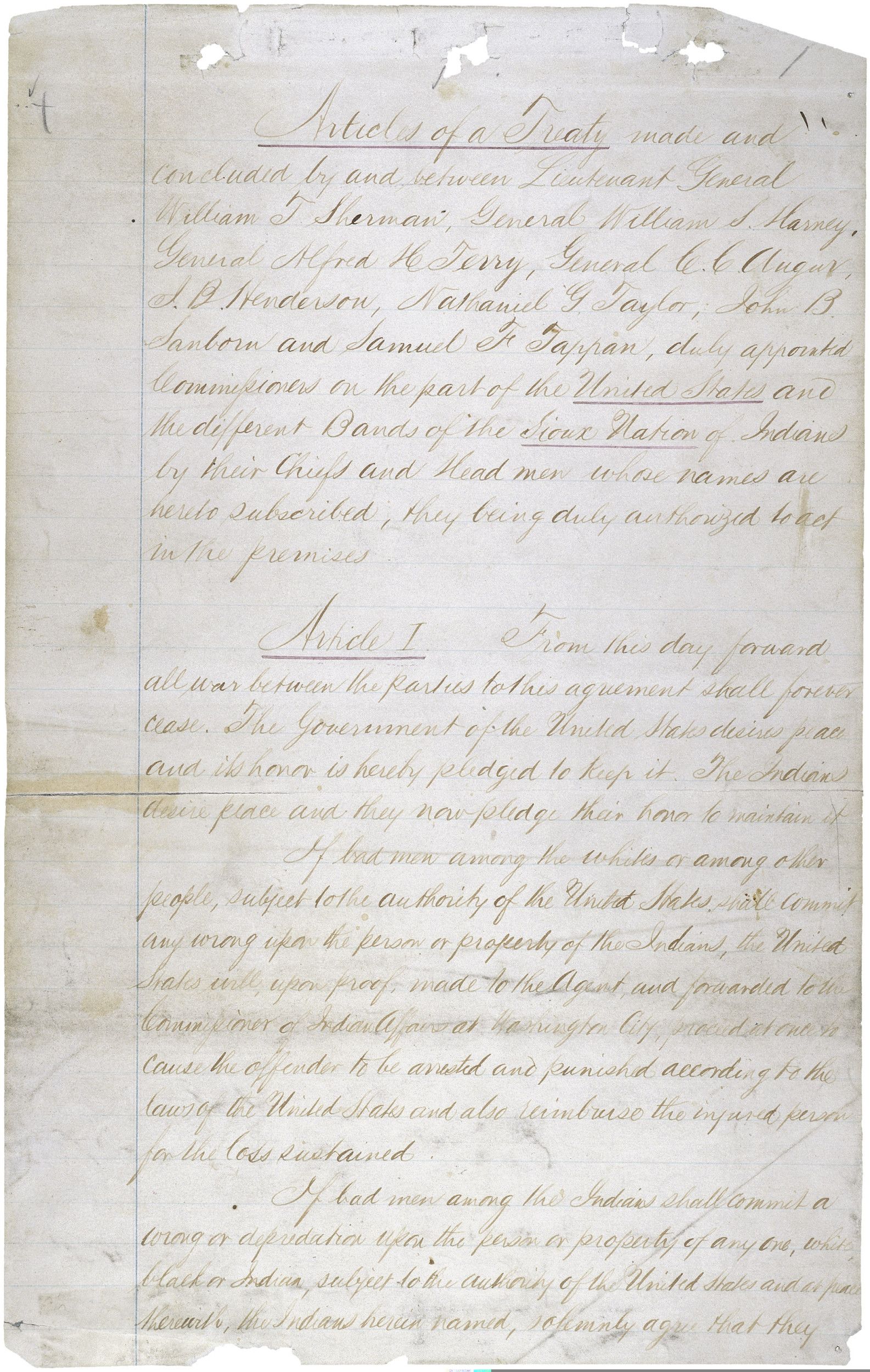
Activity Element
Telegram from Major Robert Anderson to the Secretary of War
Page 1

Activity Element
Resolution introduced by Senator Henry Clay in relation to the adjustment of all existing questions of controversy between the states arising out of the institution of slavery (the resolution later be
Page 1
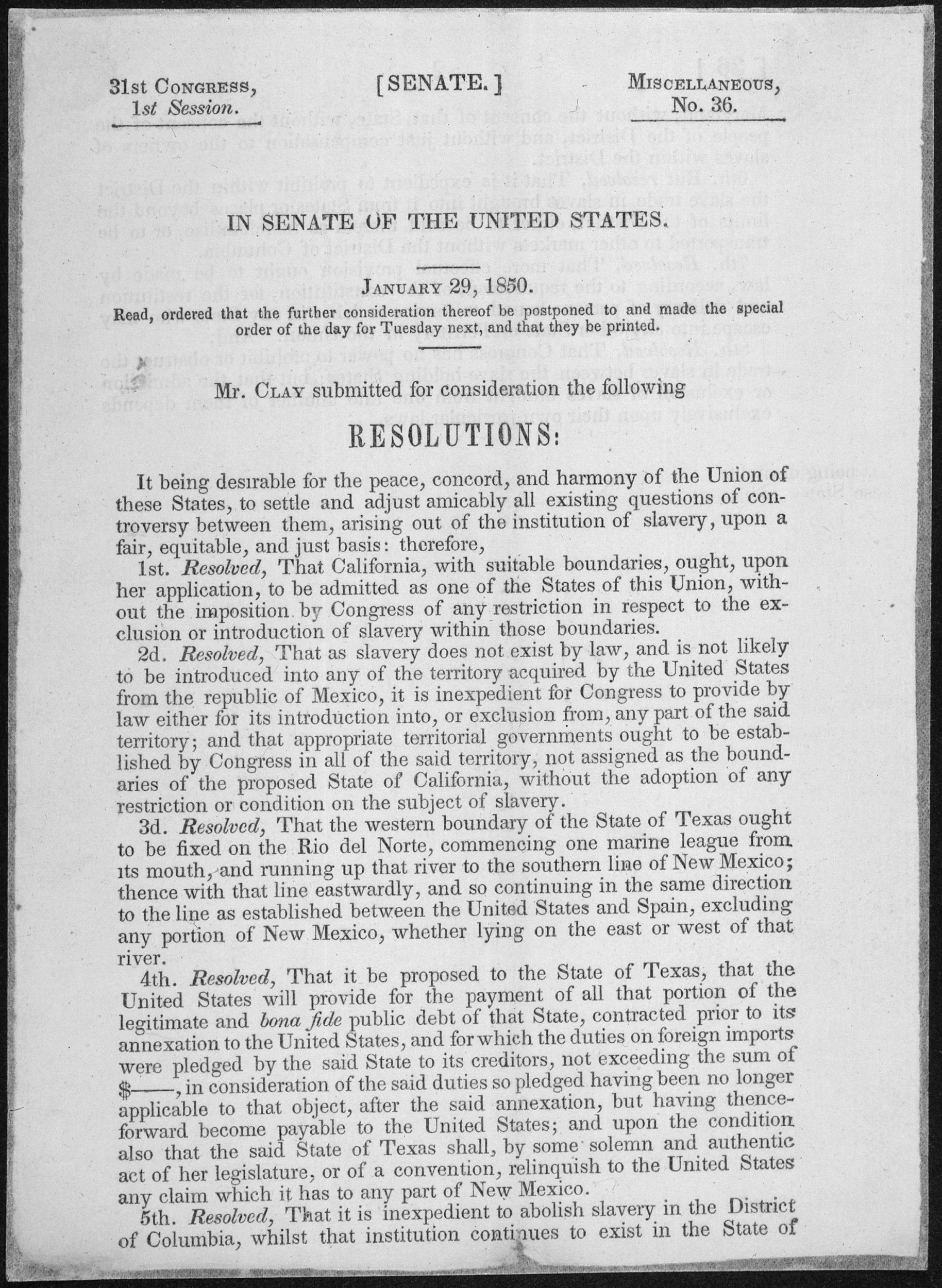
Activity Element
Act of July 2, 1862 (Morrill Act), Public Law 37-108, 12 STAT 503, which established land grant colleges.
Page 1
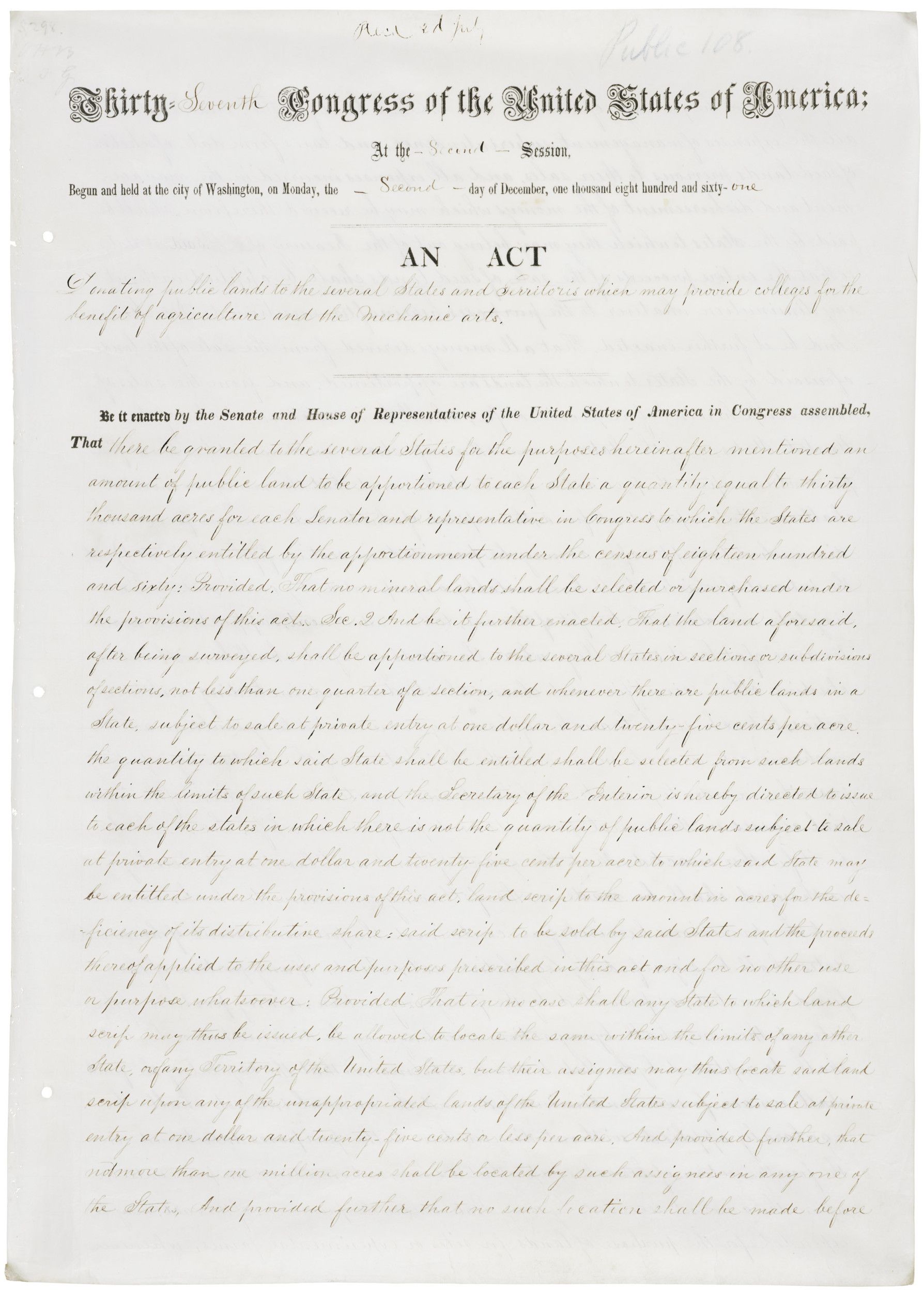
Activity Element
Act of July 1, 1862 (Pacific Railroad Act), 12 STAT 489, which established the construction of a railroad and telegraph line from the Missouri River to the Pacific Ocean.
Page 1
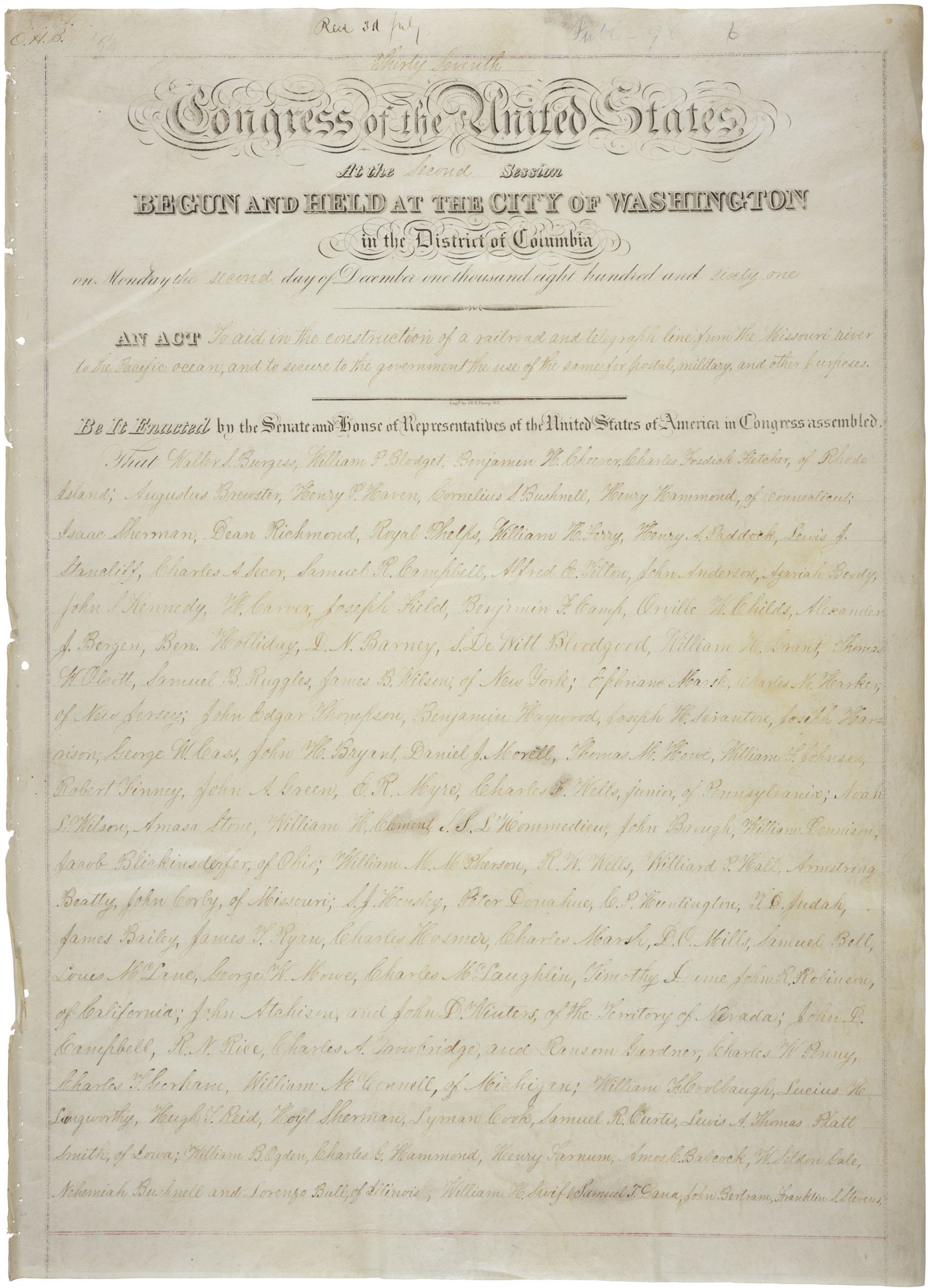
Activity Element
Joint Resolution Proposing the Fifteenth Amendment to the United States Constitution
Page 1
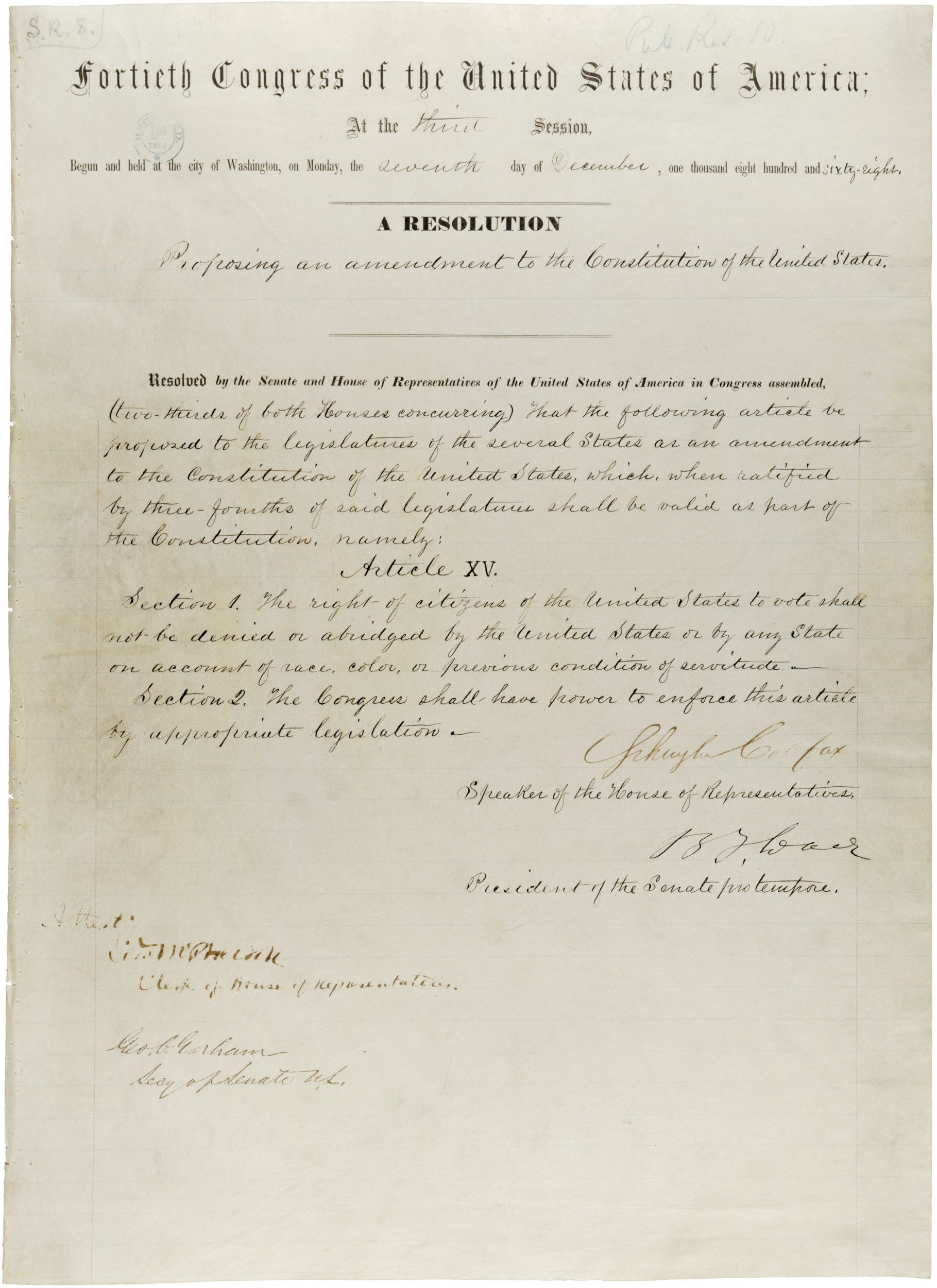
Conclusion
What Else Was Happening During the Civil War Era?
Finding a Sequence
You’ve sequenced the documents and seen a variety of events in American history that occurred between 1850 and 1877.- Were there any surprises about their order from your original guess?
- What else did you find was happening in the United States besides the Civil War?
Your Response
Document
Joint Resolution Proposing the Fourteenth Amendment to the United States Constitution
6/13/1866
Following the Civil War, Congress submitted to the states three amendments as part of its Reconstruction program to guarantee equal civil and legal rights to Black citizens. A major provision of the 14th amendment was to grant citizenship to “All persons born or naturalized in the United States,” thereby granting citizenship to formerly enslaved people.
Another equally important provision was the statement that “nor shall any state deprive any person of life, liberty, or property, without due process of law; nor deny to any person within its jurisdiction the equal protection of the laws.” The right to due process of law and equal protection of the law now applied to both the federal and state governments.
On June 16, 1866, the House Joint Resolution proposing the 14th amendment to the Constitution was submitted to the states. On July 28, 1868, the 14th amendment was declared, in a certificate of the Secretary of State, ratified by the necessary 28 of the 37 States (three-fourths of states), and became part of the supreme law of the land.
Congressman John A. Bingham of Ohio, the primary author of the first section of the 14th amendment, intended that the amendment also nationalize the Bill of Rights by making it binding upon the states. When introducing the amendment, Senator Jacob Howard of Michigan specifically stated that the privileges and immunities clause would extend to the states “the personal rights guaranteed and secured by the first eight amendments.” Historians disagree on how widely Bingham's and Howard's views were shared at the time in the Congress, or across the country in general. No one in Congress explicitly contradicted their view of the Amendment, but only a few members said anything at all about its meaning on this issue. For many years, the Supreme Court ruled that the amendment did not extend the Bill of Rights to the states.
Not only did the 14th amendment fail to extend the Bill of Rights to the states; it also failed to protect the rights of Black citizens. A legacy of Reconstruction was the determined struggle of Black and white citizens to make the promise of the 14th amendment a reality. Citizens petitioned and initiated court cases, Congress enacted legislation, and the executive branch attempted to enforce measures that would guard all citizens’ rights. While these citizens did not succeed in empowering the 14th amendment during the Reconstruction, they effectively articulated arguments and offered dissenting opinions that would be the basis for change in the 20th century.
Transcript
Article XIVSection 1. All persons born or naturalized in the United States, and subject to the jurisdiction thereof, are citizens of the United States and of the State wherein they reside. No State shall make or enforce any law which shall abridge the privileges or immunities of citizens of the United States; nor shall any State deprive any person of life, liberty, or property, without due process of law; nor deny to any person within its jurisdiction the equal protection of the laws.
Section 2. Representatives shall be apportioned among the several States according to their respective numbers, counting the whole number of persons in each State, excluding Indians not taxed. But when the right to vote at any election for the choice of electors for President and Vice-President of the United States, Representatives in Congress, the Executive and Judicial officers of a State, or the members of the Legislature thereof, is denied to any of the male inhabitants of such State, being twenty-one years of age, and citizens of the United States, or in any way abridged, except for participation in rebellion, or other crime, the basis of representation therein shall be reduced in the proportion which the
number of such male citizens shall bear to the whole number of male citizens twenty-one years of age in such State.
Section 3. No person shall be a Senator or Representative in Congress, or elector of President and Vice-President, or hold any office, civil or military, under the United States, or under any State, who, having previously taken an oath, as a member of Congress, or as an officer of the United States, or as a member of any State legislature, or as an executive or judicial officer of any State, to support the Constitution of the United States, shall have engaged in insurrection or rebellion against the same, or given aid or comfort to the enemies thereof. But Congress may by a vote of two-thirds of each House, remove such disability.
Section 4. The validity of the public debt of the United States, authorized by law, including debts incurred for payment of pensions and bounties for services in suppressing insurrection or rebellion, shall not be questioned. But neither the United States nor any State shall assume or pay any debt or obligation incurred in aid of insurrection or rebellion against the United States, or any claim for the loss or emancipation of any slave; but all such debts, obligations and claims shall be held illegal and void.
Section 5. The Congress shall have the power to enforce, by appropriate legislation, the provisions of this article.
Joint Resolution Proposing the Fourteenth Amendment to the United States Constitution
Page 1
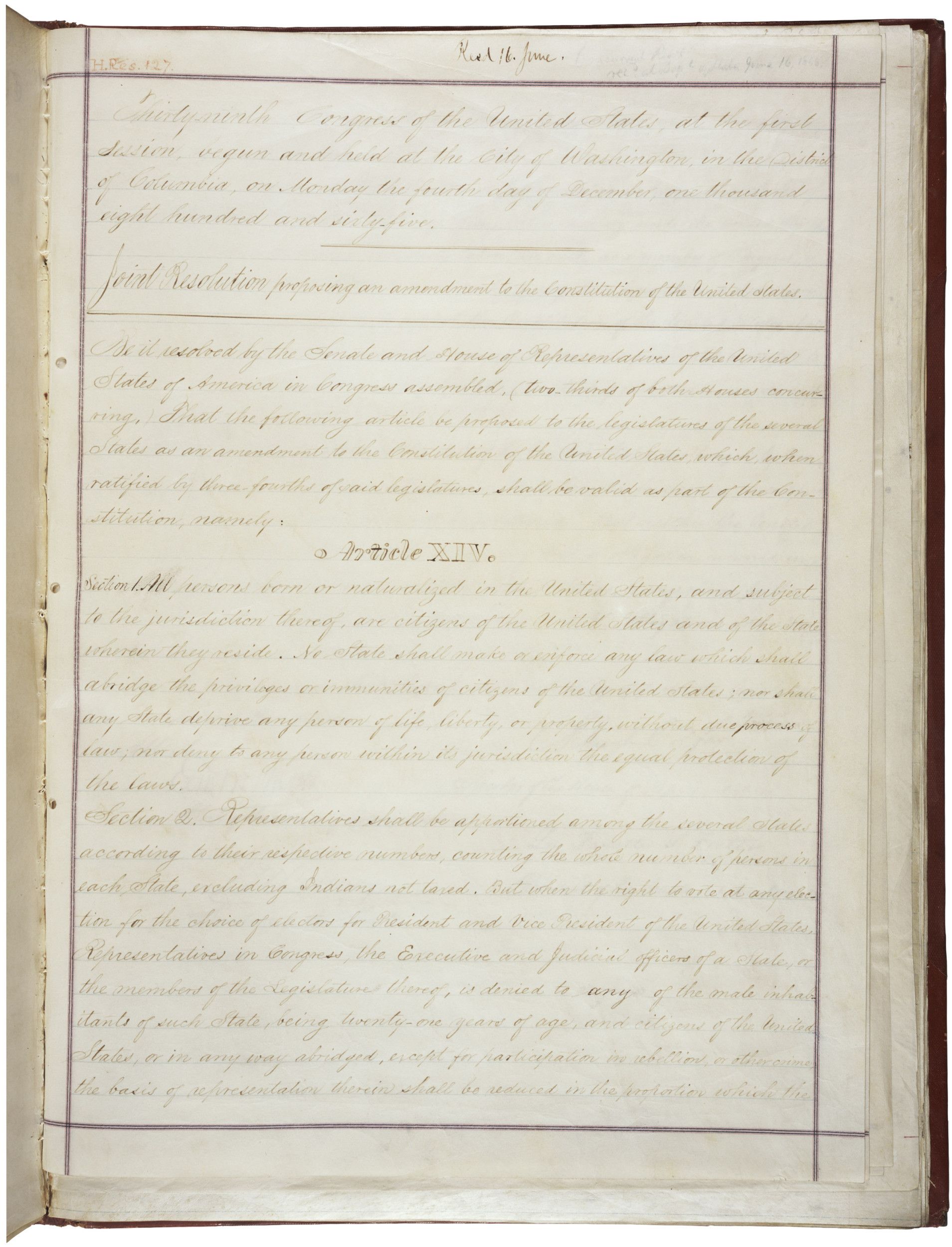
Joint Resolution Proposing the Fourteenth Amendment to the United States Constitution
Page 2
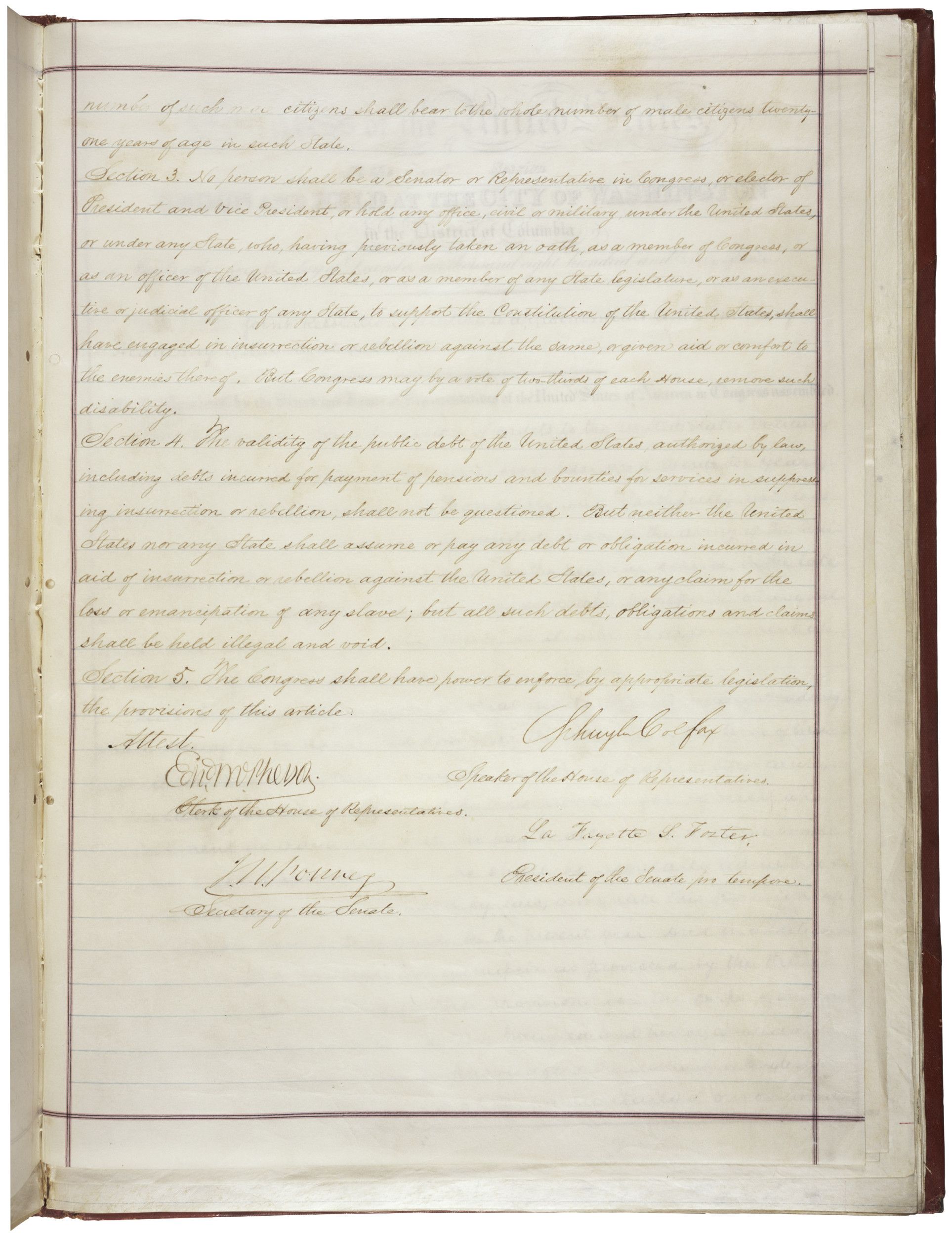
Document
Resolution introduced by Senator Henry Clay in relation to the adjustment of all existing questions of controversy between the states arising out of the institution of slavery (the resolution later became known as the Compromise of 1850)
1/29/1850
By 1850 sectional disagreements related to slavery were straining the bonds of union between the North and South. These tensions became especially critical when Congress began to consider whether western lands acquired after the Mexican-American War would permit slavery. In 1849, California requested permission to enter the Union as a "free state" – meaning one where slavery was banned. Adding more "free state" senators to Congress would destroy the balance between "slave" and "free" states that had existed since the Missouri Compromise of 1820.
Because everyone looked to the Senate to defuse the growing crisis, Senator Henry Clay of Kentucky proposed a series of resolutions designed to "adjust amicably all existing questions of controversy...arising out of the institution of slavery." Clay attempted to frame his compromise so that nationally minded senators would vote for legislation in the interest of the Union.
In one of the most famous congressional debates in American history, the Senate discussed Clay’s solution for seven months. It initially voted down his legislative package, but Senator Stephen A. Douglas of Illinois stepped forward with substitute bills, which passed both Houses. With the Compromise of 1850, Congress had addressed the immediate crisis created by the recent territorial expansion.
But one aspect of the compromise – a strengthened fugitive slave act – soon began to threaten sectional peace. Though a fugitive slave clause was included in the Constitution and supported by legislation since the founding of the nation, the Fugitive Slave Act of 1850 added several new regulations. For example, both federal and local law enforcement in all states (both "slave" and "free") were required to enforce the legislation and arrest suspected fugitive slaves. In addition, anyone aiding an enslaved person escape from bondage was subject to imprisonment and a fine. The enforcement of these strict requirements angered many in the North.
The Compromise of 1850 is composed of five statutes enacted in September of 1850. The acts called for the admission of California as a "free state," provided for a territorial government for Utah and New Mexico, established a boundary between Texas and the United States, called for the abolition of slave trade in Washington, DC, and amended the Fugitive Slave Act.
Transcript
In the Senate of the United StatesJanuary 29, 1850
Read, ordered that the futher consideration therof be postponed to and made the special order of the day for Tuesday next and that they be printed.
Mr. Clay submitted for consideration the following
Resolutions:
It being desirable, for the peace, concord, and harmony of the Union of these States, to settle and adjust amicably all existing questions of controversy between them aris- ing out of the institution of slavery upon a fair, equitable and just basis: therefore,
1. Resolved, That California, with suitable boundaries, ought, upon her application to be admitted as one of the States of this Union, without the imposition by Congress of any restriction in respect to the exclusion or in- troduction of slavery within those bound- aries.
2. Resolved, That as slavery does not exist by law, and is not likely to be introduced into any of the territory acquired by the United States from the republic of Mexico, it is in- expedient for Congress to provide by law either for its introduction into, or exclusion from, any part of the said territory; and that appropriate territorial governments ought to be established by Congress in all of the said territory , not assigned as the boundaries of the proposed State of California, without the adoption of any restriction or condition on the subject of slavery.
3. Resolved, That the western boundary of the State of Texas ought to be fixed on the Rio del Norte, ommencing one marine league from its mouth, and running up that river to the southern line of New Mexico; thence with that line eastwardly, and so continuing in the same direction to the line as established between the United States and Spain, exclud- ing any portion of New Mexico, whether lying on the east or west of that river.
4. Resolved, That it be proposed to the State of Texas, that the United States will provide for the payment of all that portion of the legitimate and bona fide public debt of that State contracted prior to its annexation to the United States, and for which the duties on foreign imports were pledged by the said State to its creditors, not exceeding the sum of- dollars, in consideration of the said duties so pledged having been no longer ap- plicable to that object after the said annexa- tion, but having thenceforward become pay- able to the United States; and upon the condition, also, that the said State of Texas shall, by some solemn and authentic act of her legislature or of a convention, relinquish to the United States any claim which it has to any part of New Mexico.
5. Resolved, That it is inexpedient to abol- ish slavery in the District of Columbia whilst that institution continues to exist in the State of
Maryland, without the consent of that State, without the consent of the people of the District, and without just compensation to the owners of slaves within the District.
6. But, resolved, That it is expedient to prohibit, within the District, the slave trade in slaves brought into it from States or places beyond the limits of the District, either to be sold therein as merchandise, or to be trans- ported to other markets without the District of Columbia.
7. Resolved, That more effectual provision ought to be made by law, according to the
requirement of the constitution, for the restitution and delivery of persons bound to serv- ice or labor in any State, who may escape into any other State or Territory in the Union. And,
8. Resolved, That Congress has no power to promote or obstruct the trade in slaves be- tween the slaveholding States; but that the admission or exclusion of slaves brought from one into another of them, depends exclusively upon their own particular laws.
Resolution introduced by Senator Henry Clay in relation to the adjustment of all existing questions of controversy between the states arising out of the institution of slavery (the resolution later became known as the Compromise of 1850)
Page 1
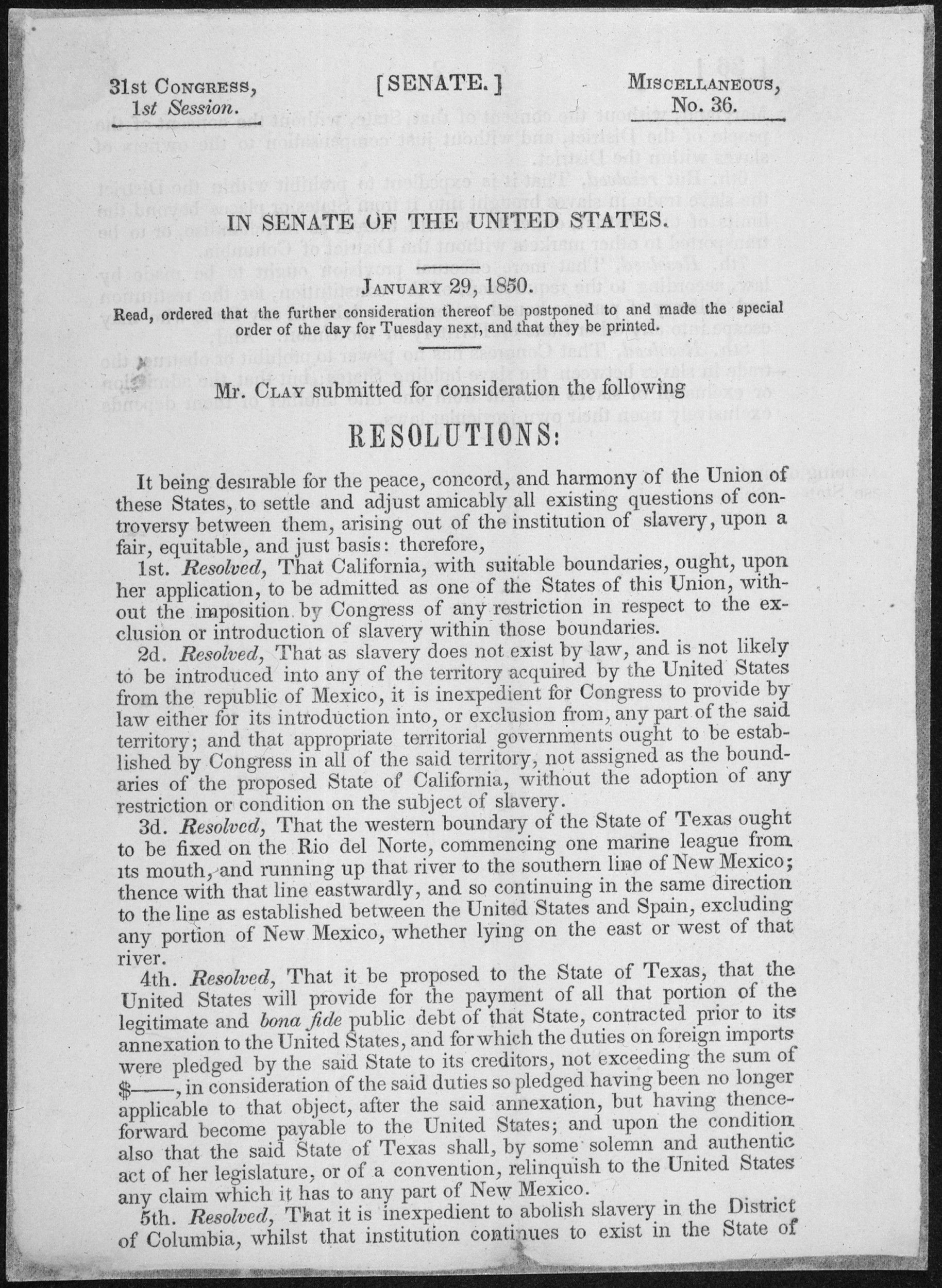
Resolution introduced by Senator Henry Clay in relation to the adjustment of all existing questions of controversy between the states arising out of the institution of slavery (the resolution later became known as the Compromise of 1850)
Page 2
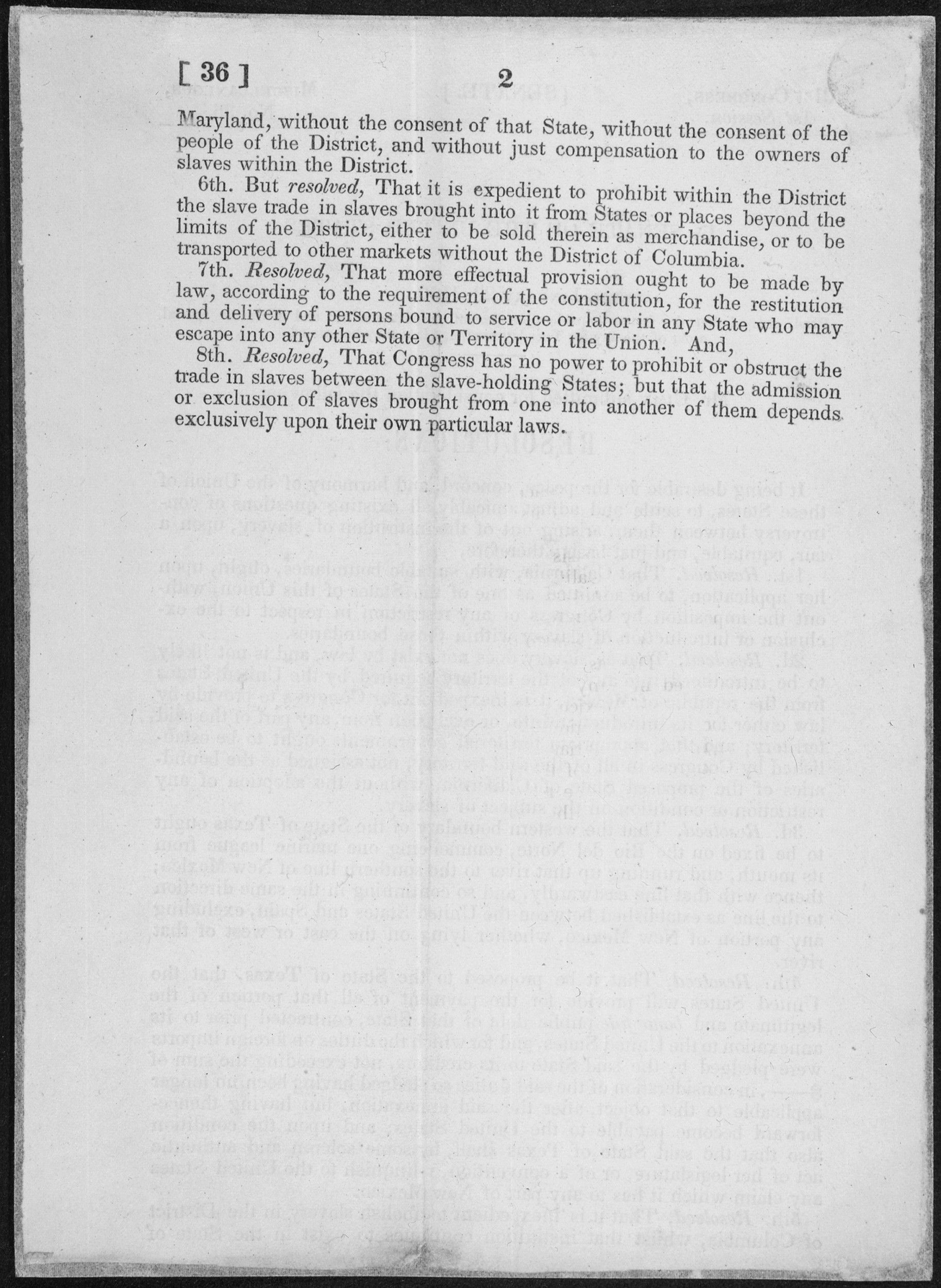
Resolution introduced by Senator Henry Clay in relation to the adjustment of all existing questions of controversy between the states arising out of the institution of slavery (the resolution later became known as the Compromise of 1850)
Page 3

Resolution introduced by Senator Henry Clay in relation to the adjustment of all existing questions of controversy between the states arising out of the institution of slavery (the resolution later became known as the Compromise of 1850)
Page 4

Resolution introduced by Senator Henry Clay in relation to the adjustment of all existing questions of controversy between the states arising out of the institution of slavery (the resolution later became known as the Compromise of 1850)
Page 5
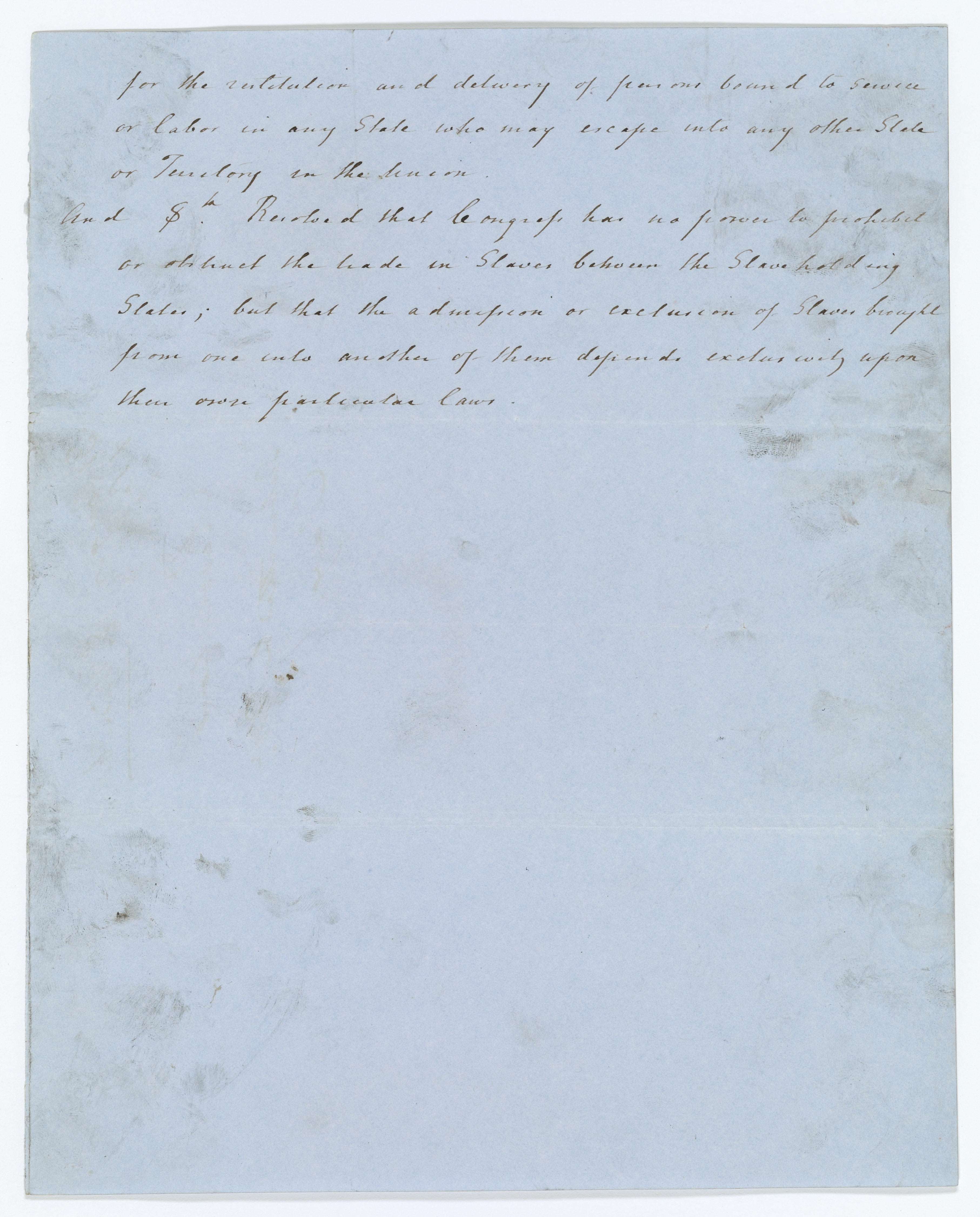
Resolution introduced by Senator Henry Clay in relation to the adjustment of all existing questions of controversy between the states arising out of the institution of slavery (the resolution later became known as the Compromise of 1850)
Page 6

Resolution introduced by Senator Henry Clay in relation to the adjustment of all existing questions of controversy between the states arising out of the institution of slavery (the resolution later became known as the Compromise of 1850)
Page 7
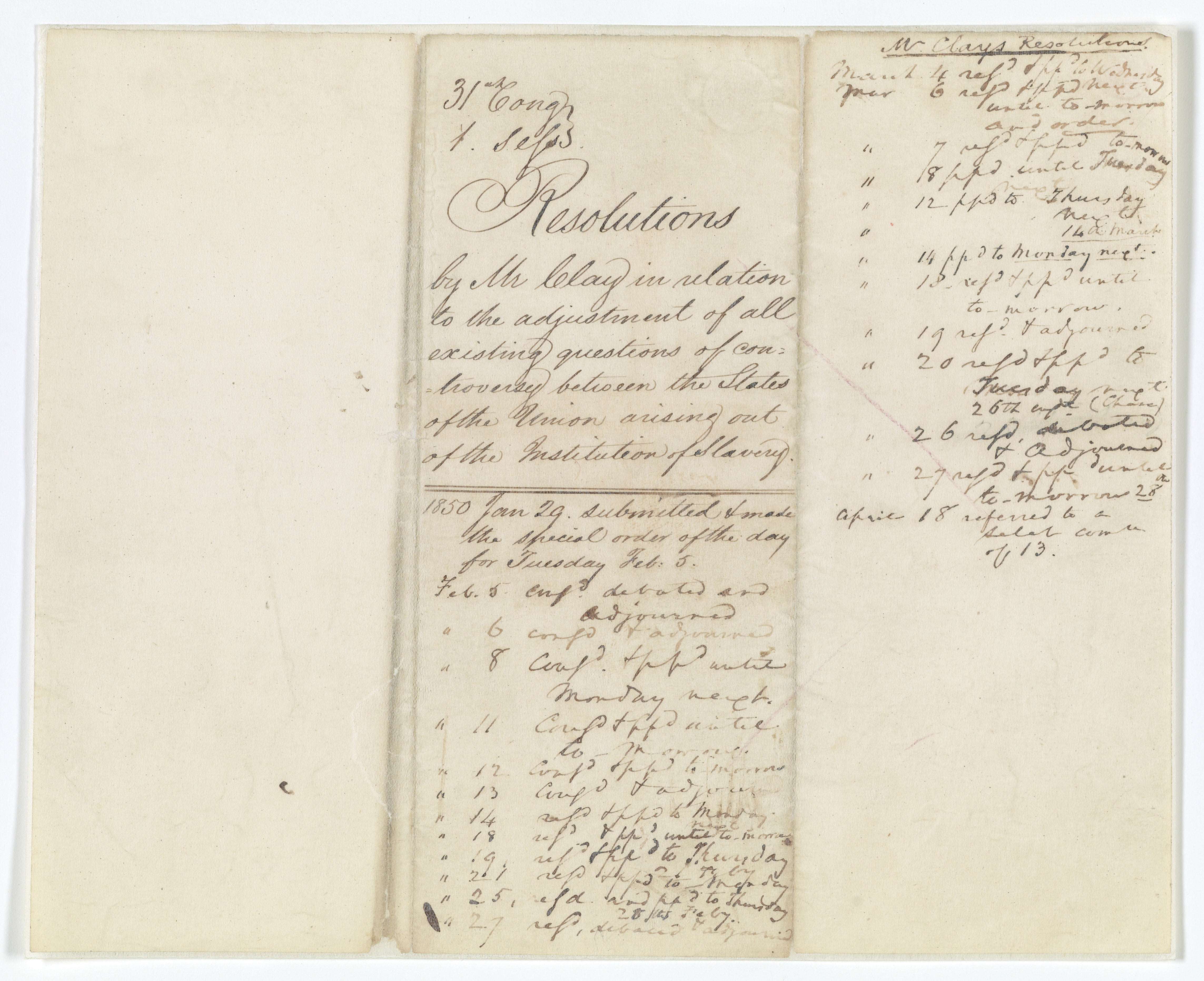
Document
Judgment in the U.S. Supreme Court Case Dred Scott v. John F. A. Sandford
3/6/1857
In 1846, an enslaved Black man named Dred Scott and his wife, Harriet, had sued for their freedom in St. Louis Circuit Court. They claimed that they were free due to their residence in a free territory where slavery was prohibited.
The odds were in their favor. They had lived with their enslaver, an army surgeon, at Fort Snelling, then in the free Territory of Wisconsin. The Scotts' freedom could be established on the grounds that they had been held in bondage for extended periods in a free territory and were then returned to a slave state. Courts had ruled this way in the past.
However, what appeared to be a straightforward lawsuit between two private parties became an 11-year legal struggle that culminated in one of the most notorious decisions ever issued by the Supreme Court. Scott lost his case, which worked its way through the Missouri state courts; he then filed a new federal suit which ultimately reached the Supreme Court.
On its way to the Supreme Court, the Dred Scott case grew in scope and significance as slavery became the single most explosive issue in American politics. By the time the case reached the high Court, it had come to have enormous political implications for the entire nation. Slavery had become the single most explosive issue in American politics.
On March 6, 1857, Chief Justice Roger B. Taney read the majority opinion, which stated that enslaved people were not citizens of the United States and, therefore, could not expect any protection from the federal government or the courts. The opinion also stated that Congress had no authority to ban slavery from a federal territory. This decision moved the nation a step closer to the Civil War.
The decision in Scott v. Sandford, considered by many legal scholars to be the worst ever rendered by the Supreme Court, was overturned by the 13th and 14th amendments to the Constitution, which abolished slavery and declared all persons born in the United States to be citizens of the United States.
Transcript
Missouri - C. C. U. S.No. 7.
Dred Scott, Plff in Er
vs.
John F. A. Sandford
Filed 30th December 1854.
Dismissed for want of jurisdiction.
March 6th 1857
No. 7.
Dred Scott - Plff in Er
vs
John F. A. Sandford
In error to the Circuit Court of the United States for the District of Missouri.
This cause came on to be heard on the transcript of the record from the Circuit Court of the United States for the District of Missouri and was argued by counsel - on consideration whereof, it is now here ordered and adjudged by this court that the judgment of the said Circuit Court in this cause be and the same is hereby reversed for the want of jurisdiction in that court, and that this cause be and the same is hereby remanded to the said Circuit Court with directions to dismiss the case for the want of jurisdiction in that court.
Js. W. Ch. Mr. Taney
6th March 1857
Judgment in the U.S. Supreme Court Case Dred Scott v. John F. A. Sandford
Page 1
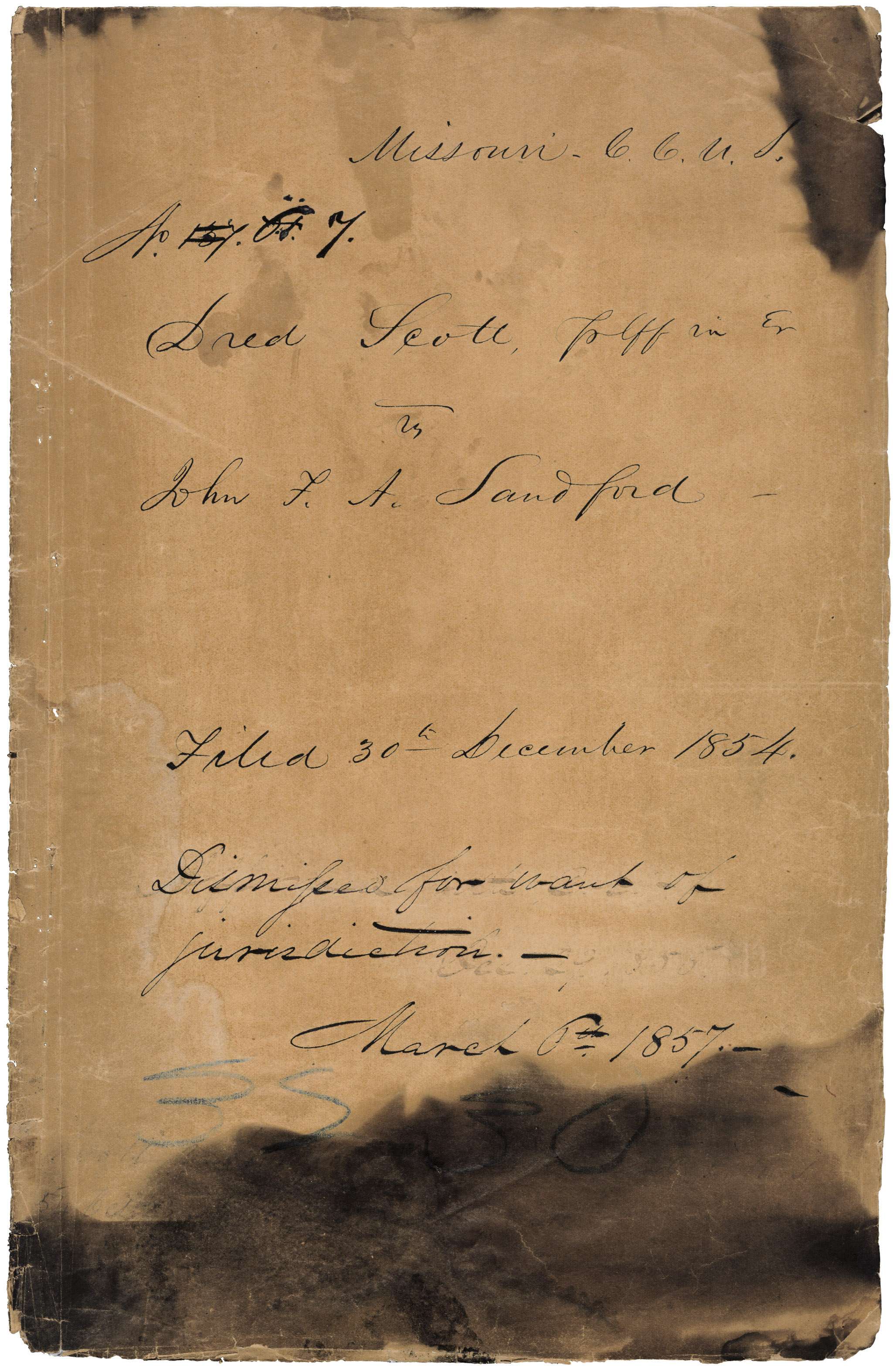
Judgment in the U.S. Supreme Court Case Dred Scott v. John F. A. Sandford
Page 2
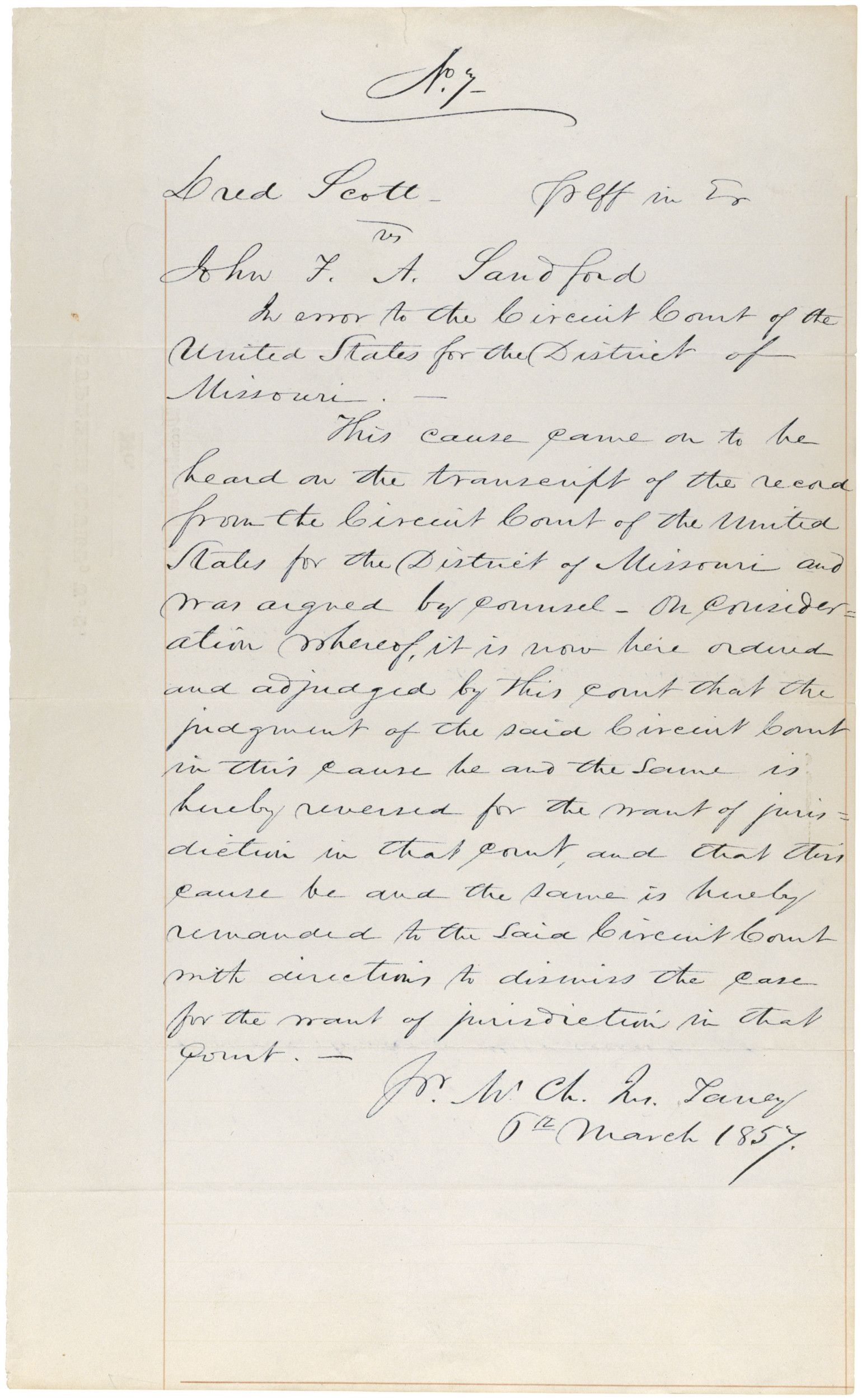
Document
Yellowstone Park Act
3/1/1872
Transcript
Forty-Second Congress of the United States of America;At the Second Session, Begun and held at the City of Washington, on Monday, the Fourth day of December, one thousand eight hundred and seventy-one.
AN ACT to set apart a certain tract of land lying near the headwaters of the Yellowstone River as a public park.
Be it enacted by the Senate and House of Representatives of the United States of America in Congress assembled, That the tract of land in the Territories of Montana and Wyoming, lying near the headwaters of the Yellowstone River, and described as follows, to wit, commencing at the junction of Gardiner's river with the Yellowstone river, and running east to the meridian passing ten miles to the eastward of the most eastern point of Yellowstone lake; thence south along said meridian to the parallel of latitude passing ten miles south of the most southern point of Yellowstone lake; thence west along said parallel to the meridian passing fifteen miles west of the most western point of Madison lake; thence north along said meridian to the latitude of the junction of Yellowstone and Gardiner's rivers; thence east to the place of beginning, is hereby reserved and withdrawn from settlement, occupancy, or sale under the laws of the United States, and dedicated and set apart as a public park or pleasuring-ground for the benefit and enjoyment of the people; and all persons who shall locate or settle upon or occupy the same, or any part thereof, except as hereinafter provided, shall be considered trespassers and removed therefrom.
That said public park shall be under the exclusive control of the Secretary of the Interior, whose duty it shall be, as soon as practicable, to make and publish such rules and regulations as he may deem necessary or proper for the care and management of the same. Such regulations shall provide for the preservation, from injury or spoliation, of all timber, mineral deposits, natural curiosities, or wonders within said park, and their retention in their natural condition. The Secretary may in his discretion, grant leases for building purposes for terms not exceeding ten years, of small parcels of ground, at such places in said park as shall require the erection of buildings for the accommodation of visitors; all of the proceeds of said leases, and all other revenues that may be derived from any source connected with said park, to be expended under his direction in the management of the same, and the construction of roads and bridle-paths therein. He shall provide against the wanton destruction of the fish and game found within said park, and against their capture or destruction for the purposes of merchandise or profit. He shall also cause all persons trespassing upon the same
after the passage of this act to be removed therefrom, and generally shall be authorized to take all such measures as shall be necessary or proper to fully carry out the objects and purposes of this act.
Yellowstone Park Act
Page 1
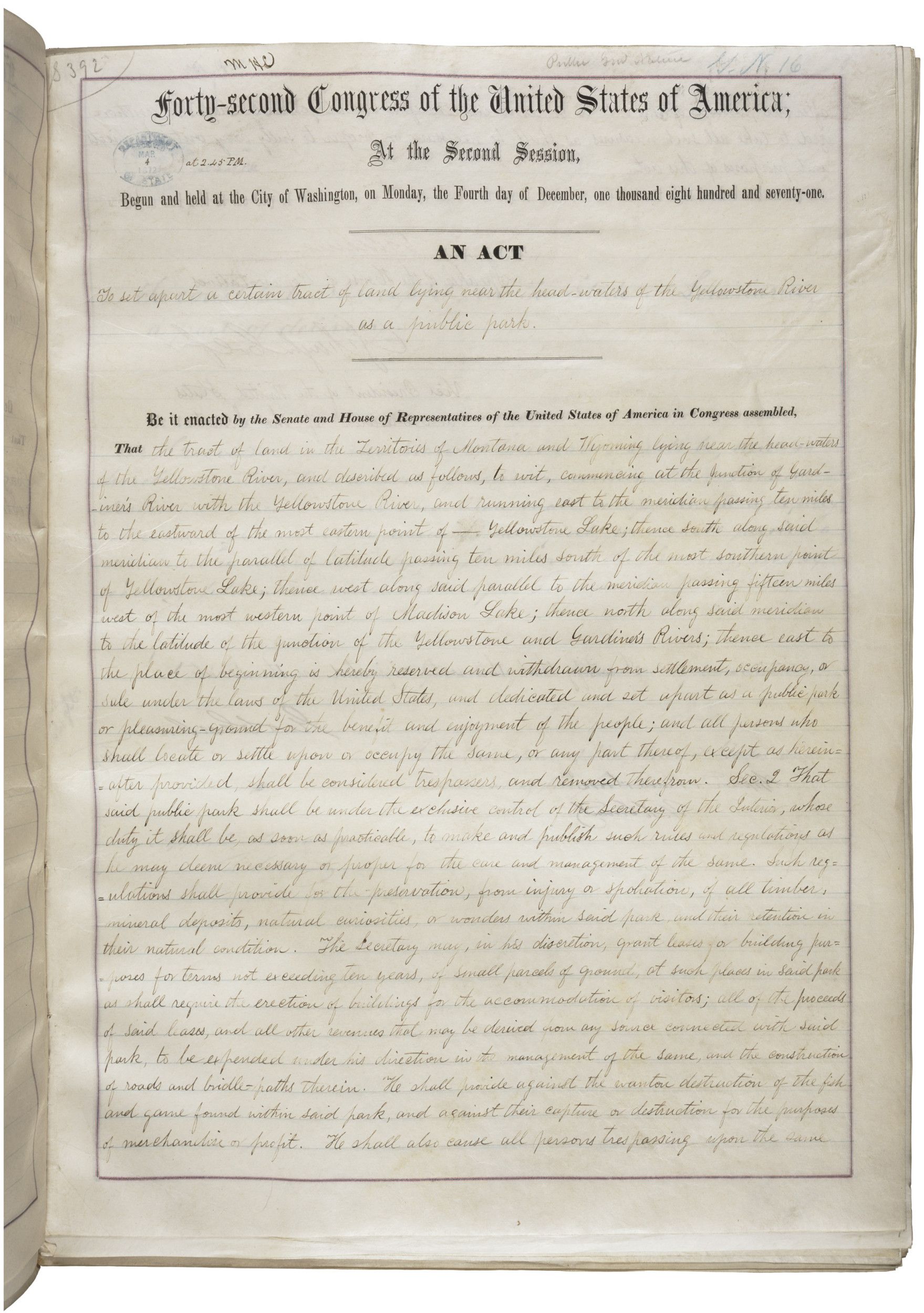
Yellowstone Park Act
Page 2

Document
Act of May 20, 1862 (Homestead Act), Public Law 37-64 (12 STAT 392)
5/20/1862
On January 1, 1863, Daniel Freeman made the first claim under the Act. Claimants were required to "improve" the plot by building a dwelling and cultivating the land. After 5 years on the land, the original filer was entitled to the property, free and clear, except for a small registration fee. Title could also be acquired after only a 6-month residency and trivial improvements, provided the claimant paid the government $1.25 per acre. After the Civil War, Union soldiers could deduct the time they had served from the residency requirements.
In reality, few laborers and farmers could afford to build a farm or acquire the necessary tools, seed, and livestock. Most of those who purchased land under the act came from areas quite close to their new homesteads (Iowans moved to Nebraska, Minnesotans to South Dakota, and so on). Unfortunately, the act was framed so ambiguously that it seemed to invite fraud, and early modifications by Congress only compounded the problem. Most of the land went to speculators, cattlemen, miners, lumbermen, and railroads. Of some 500 million acres dispersed by the General Land Office between 1862 and 1904, only 80 million acres went to homesteaders. Indeed, small farmers acquired more land under the Homestead Act in the 20th century than in the 19th.
Transcript
Rec[?] 21 MayPublic 64
HR 125
Thirty-seventh
Congress of the United States
At the Second Session
BEGUN AND HELD AT THE CITY OF WASHINGTON
In the District of Columbia
On Monday the [second] day of December one thousand eight-hundred and sixty-one
[line]
AN ACT to secure homesteads to actual, settlers on the public domain.
[line]
Be it Enacted by the Senate and House of Representatives of the United States of America in Congress assembled, That any person who is the head of a family, or who has arrived at the age of twenty-one years, and is a citizen of the United States, or who shall have filed his declaration of intention to become such, as required by the naturalization laws of the United States, and who has never borne arms against the United States Government or given aid and comfort to its enemies, shall, from and after the first January, eighteen hundred and. sixty-three, be entitled to enter one quarter section or a less quantity of unappropriated public lands, upon which said person may have filed a preemption claim, or which may, at the time the application is made, be subject to preemption at one dollar and twenty-five cents, or less, per acre; or eighty acres or less of such unappropriated lands, at two dollars and fifty cents per acre, to be located in a body, in conformity to the legal subdivisions of the public lands, and after the same shall have been surveyed: Provided, That any person owning and residing on land may, under the provisions of this act, enter other land lying contiguous to his or her said land, which shall not, with the land so already owned and occupied, exceed in the aggregate one hundred and sixty acres.
SEC. 2. And be it further enacted, That the person applying
for the benefit of this act shall, upon application to the register of the land office in which he or she is about to make such entry, make affidavit before the said register or receiver that he or she is the head of a family, or is twenty-one years or more of age, or shall have performed service in the army or navy of the United States, and that he has never borne arms against the Government of the United States or given aid and comfort to its enemies, and that such application is made for his or her exclusive use and benefit, and that said entry is made for the purpose of actual settlement and cultivation, and not either directly or indirectly for the use or benefit of any other person or persons whomsoever; and upon filing the said affidavit with the register or receiver, and on payment of ten dollars, he or she shall thereupon be permitted to enter the quantity of land specified: Provided, however, That no certificate shall be given or patent issued therefor until the expiration of five years from the date of such entry ; and if, at the expiration of such time, or at any time within two years thereafter, the person making such entry ; or, if he be dead, his widow; or in case of her death, his heirs or devisee; or in case of a widow making such entry, her heirs or devisee, in case of her death ; shall. prove by two credible witnesses that he, she, or they have resided upon or cultivated the same for the term of five years immediately succeeding the time of filing the affidavit aforesaid, and shall make affidavit that no part of said land has been alienated, and that he has borne rue allegiance to the Government of the United States; then, in such case, he, she, or they, if at that time a citizen of the United States, shall be entitled to a patent, as in other cases provided for by law: And provided, further, That in case of the death
of both father and mother, leaving an Infant child, or children, under twenty-one years of age, the right and fee shall ensure to the benefit of said infant child or children ; and the executor,
administrator, or guardian may, at any time within two years after the death of the surviving
parent, and in accordance with the laws of the State in which such children for the time being have their domicil, sell said land for the benefit of said infants, but for no other purpose; and the purchaser shall acquire the absolute title by the purchase, and be en- titled to a patent from the United States, on payment of the office fees and sum of money herein specified.
SEC. 3. And be it further enacted, That the register of the land office shall note all such
applications on the tract books and plats of, his office, and keep a register of all such entries, and make return thereof to the General Land Office, together with the proof upon which they have been founded.
SEC. 4. And be it further enacted, That no lands acquired under the provisions of this act shall in any event become liable to the satisfaction of any debt or debts contracted prior to the issuing of the patent therefor.
SEC. 5. And be it further enacted, That if, at any time after the filing of the affidavit, as required in the second section of this act, and before the expiration of the five years aforesaid, it shall be proven, after due notice to the settler, to the satisfaction of the register of the land office, that the person having filed such affidavit shall have actually changed his or her residence, or abandoned the said land for more than six months at any time, then and in that event the land so entered shall revert to the government.
SEC. 6. And be it further enacted, That no individual shall be permit- ted to acquire title to more than one quarter section under the provisions of this act; and that the Commissioner of the General Land Office is hereby required to prepare and issue such rules and regulations, consistent with this act, as shall be necessary and proper to carry its provisions into effect; and that the registers and receivers of the several land offices shall be entitled to receive the same compensation for any lands entered under the provisions of this act that they are
now entitled to receive when the same quantity of land is entered with money, one half to be paid by the person making the application at the time of so doing, and the other half on the issue of the certificate by the person to whom it may be issued; but this shall not be construed to enlarge the maximum of compensation now prescribed by law for any register or receiver: Provided, That nothing contained in this act shall be so construed as to im- pair or interfere in any manner whatever with existing preemption rights: And provided, further, That all persons who may have filed their applications for a preemption right prior to the passage of this act, shall be entitled to all privileges of this act: Provided, further, That no person who has served, or may hereafter serve, for a period of not less than fourteen days in the army or navy of the United States, either regular or volunteer, under the laws thereof, during the existence of an actual war, domestic or foreign, shall be deprived of the benefits of this act on account of not having attained the age of twenty-one years.
SEC. 7. And be it further enacted, That the fifth section of the act en- titled "An act in addition to an act more effectually to provide for the punishment of certain crimes against the United States, and for other purposes," approved the third of March, in the year eighteen hundred and fifty-seven, shall extend to all oaths, affirmations, and affidavits, re- quired or authorized by this act.
SEC. 8. And be it further enacted, That nothing in this act shall be 80 construed as to prevent any person who has availed him or herself of the benefits of the fir8t section of this act, from paying the minimum price, or the price to which the same may have graduated, for the quantity of land so entered at any time before the expiration of the five years, and obtain- ing a patent therefor from the government, as in other cases provided by law, on making proof of settlement and cultivation as provided by existing laws granting preemption rights.
Galusha A. Grow
Speaker of the House of Representatives
Solomon Foot,
President of the Senate protempore
Approved, May 20, 1862
Abraham Lincoln
Act of May 20, 1862 (Homestead Act), Public Law 37-64 (12 STAT 392)
Page 1
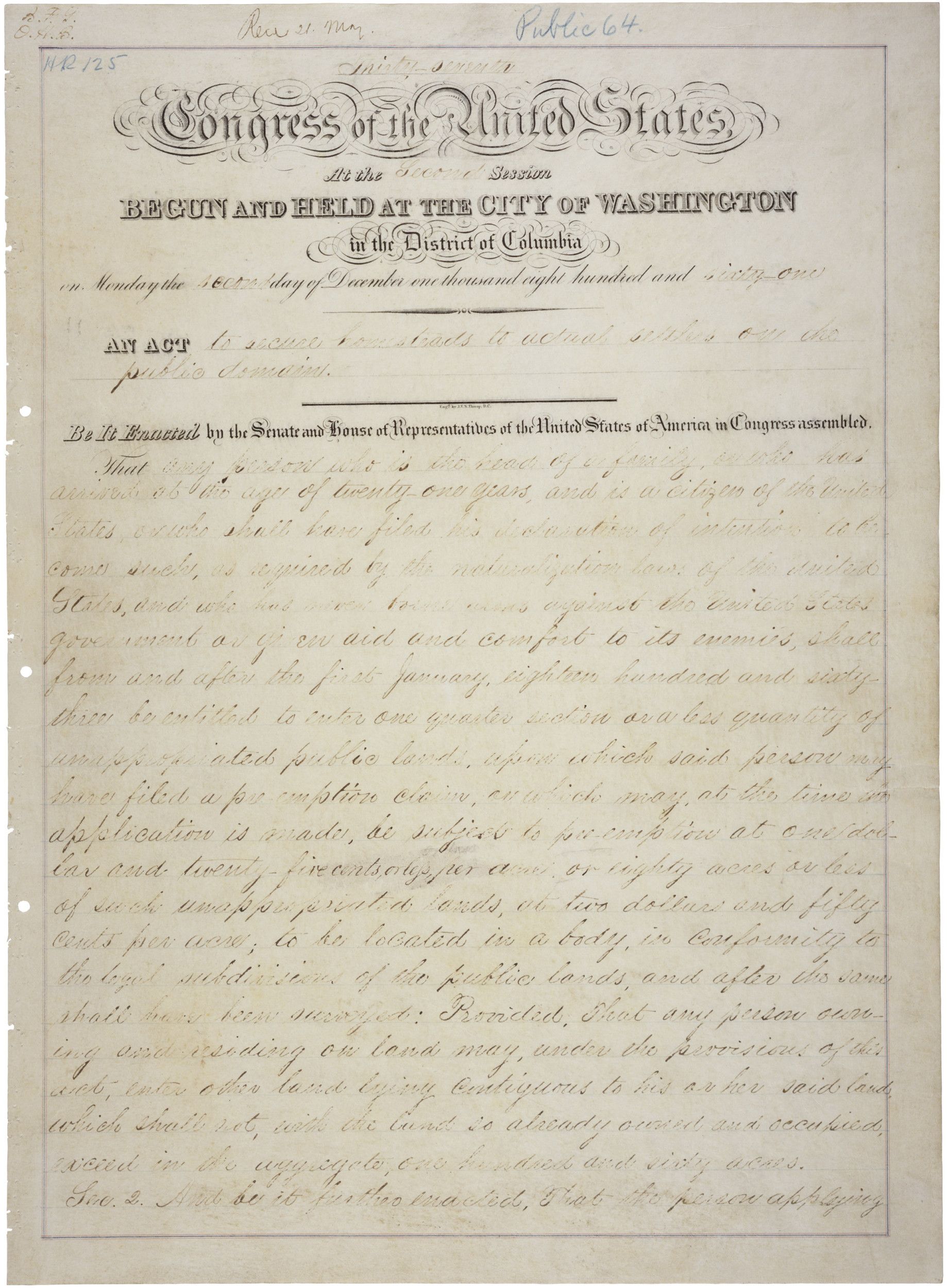
Act of May 20, 1862 (Homestead Act), Public Law 37-64 (12 STAT 392)
Page 2
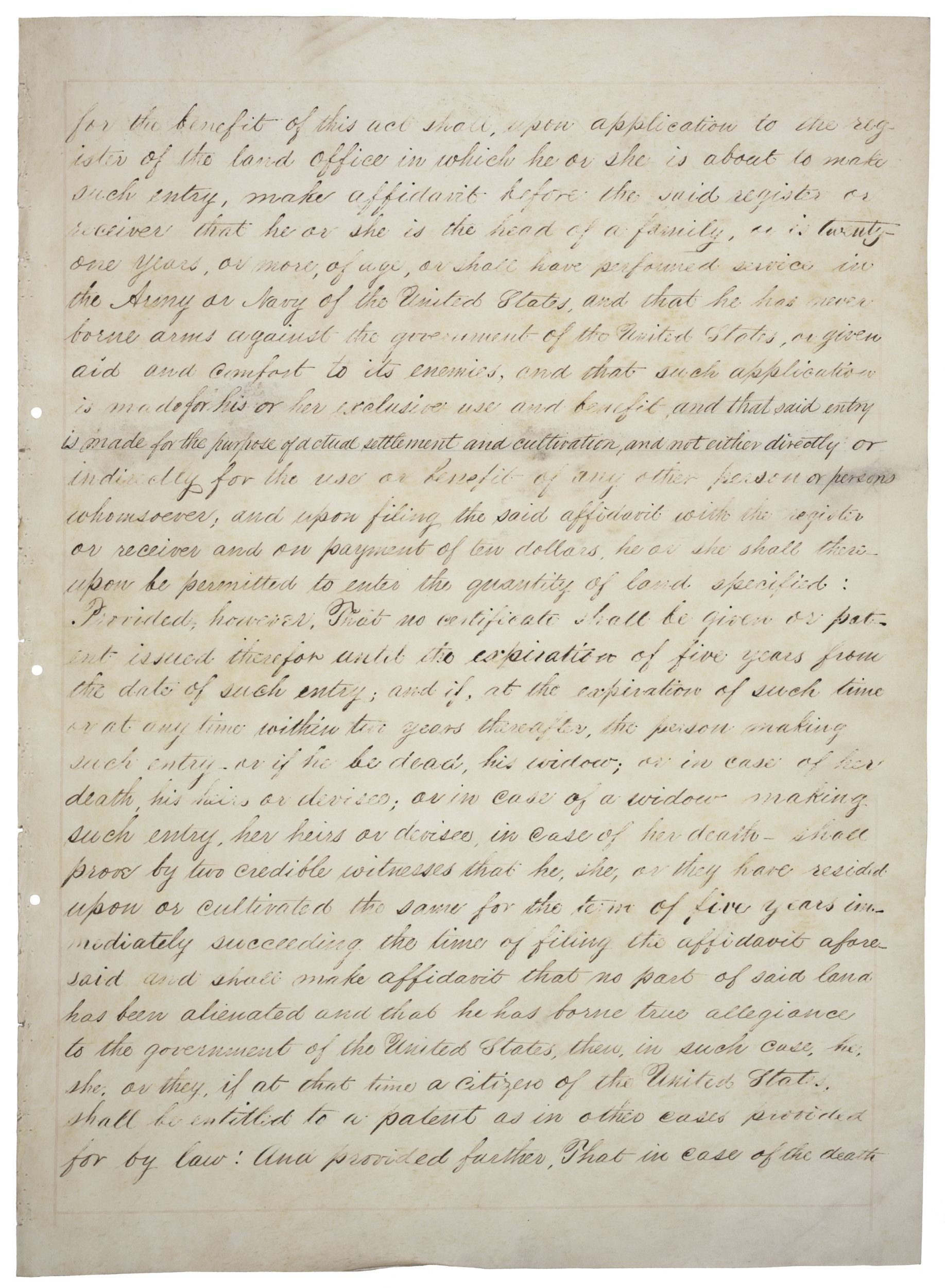
Act of May 20, 1862 (Homestead Act), Public Law 37-64 (12 STAT 392)
Page 3
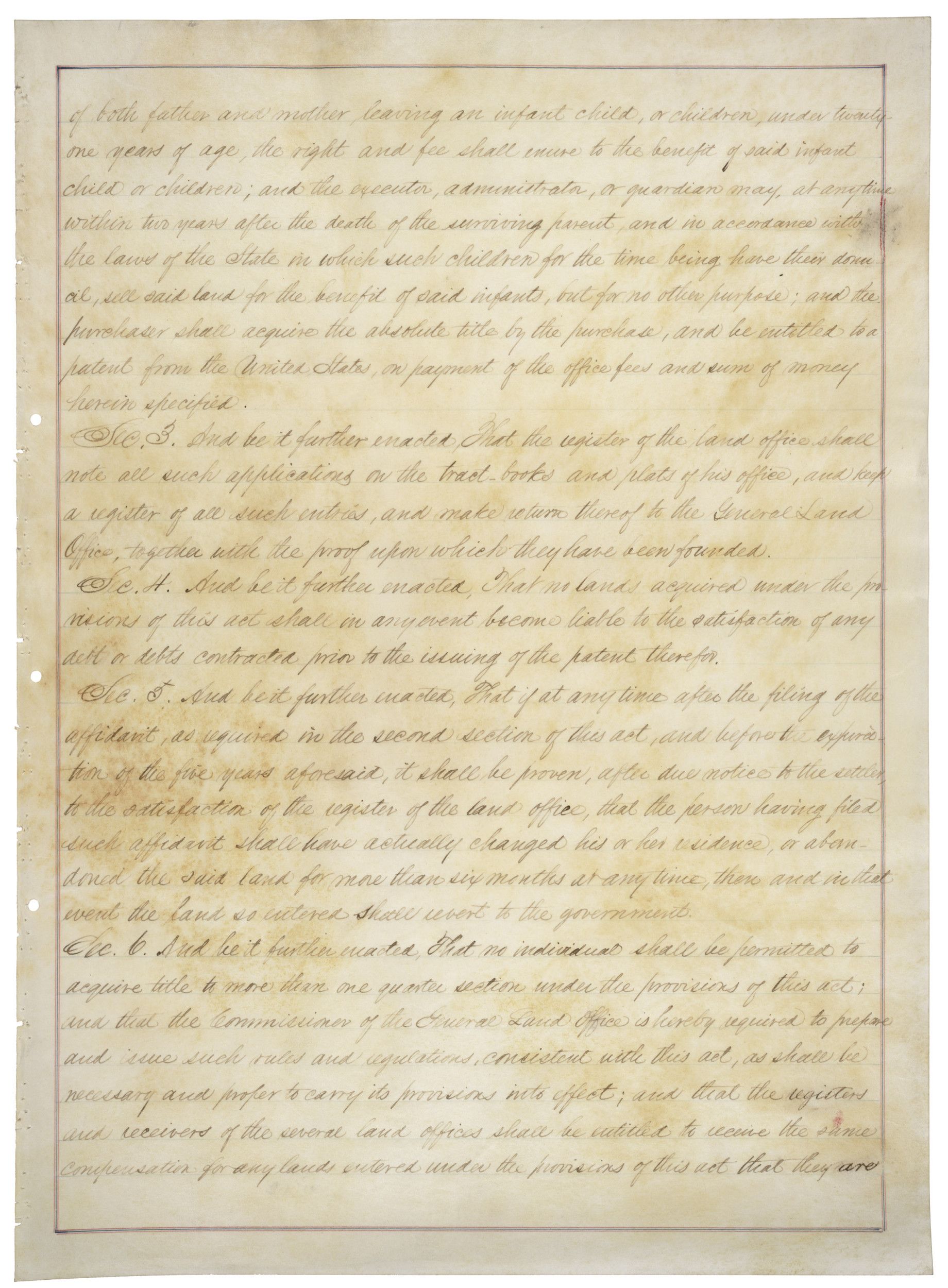
Act of May 20, 1862 (Homestead Act), Public Law 37-64 (12 STAT 392)
Page 4
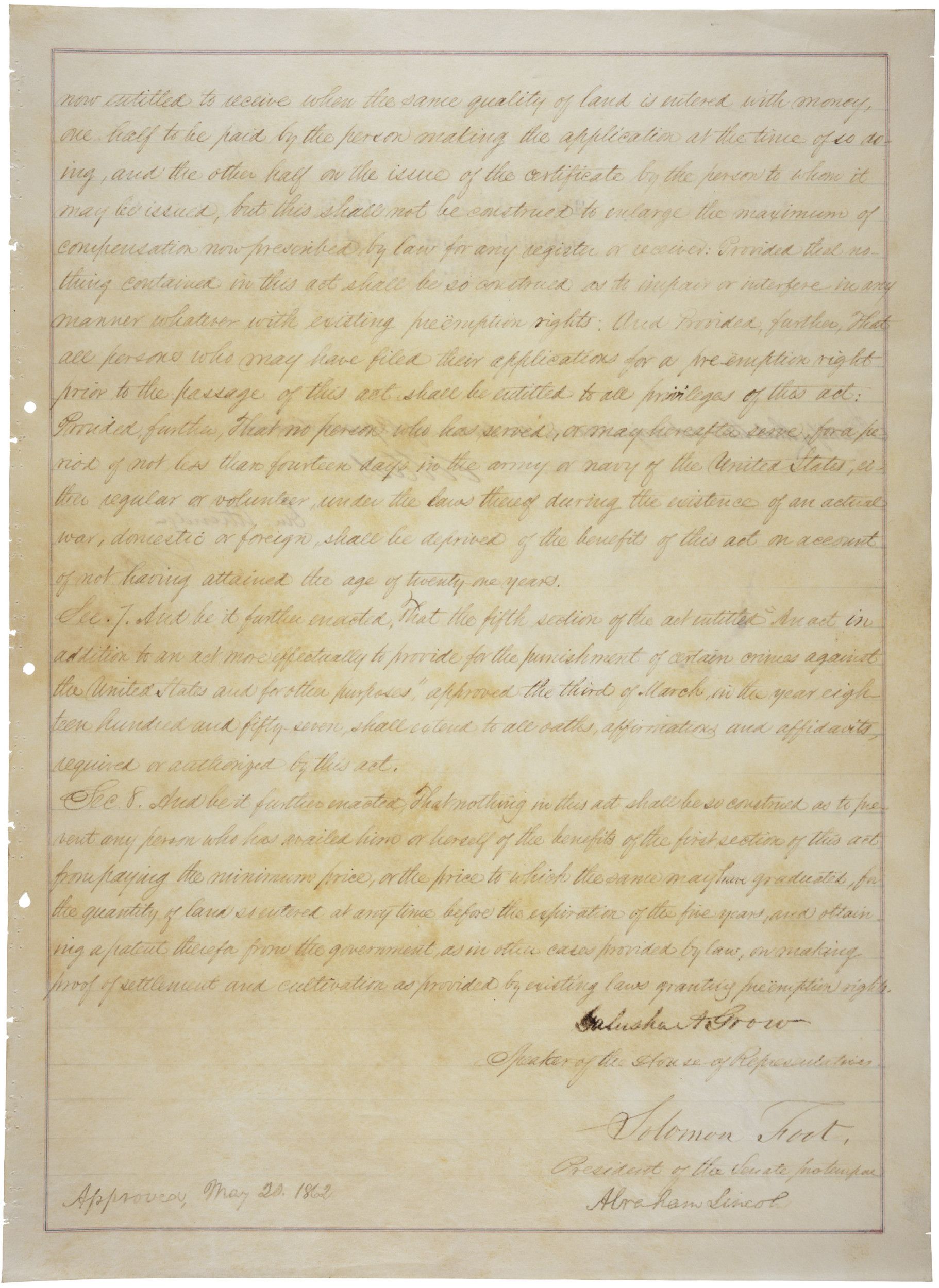
Document
Kansas-Nebraska Act of 1854
1854
In 1820, Congress passed the Missouri Compromise, which admitted Missouri into the nation as a "slave state" and Maine as a "free state." The Compromise established the latitude 36º30' N. as the dividing line for "slave" and "free" states.
The Kansas-Nebraska Act overturned the Compromise. In January 1854, Senator Stephen Douglas of Illiniois introduced a bill that divided the land immediately west of Missouri into two territories, Kansas and Nebraska. He argued in favor of popular sovereignty, or the idea that the settlers of the new territories should decide if slavery would be legal there. Anti-slavery supporters were outraged because, under the terms of the Missouri Compromise of 1820, slavery would have been outlawed in both territories since they were both north of the 36º30' N dividing line between "slave" and "free" states.
After months of debate, the Kansas-Nebraska Act passed on May 30, 1854. Almost immediately, pro-slavery and anti-slavery settlers rushed to Kansas, each side hoping to determine the results of the first election held after the law went into effect. The conflict turned violent, earning the ominous nickname "Bleeding Kansas." The act aggravated the split between North and South on the issue of slavery until reconciliation seemed virtually impossible.
Opponents of the Kansas-Nebraska Act helped found the Republican Party, which opposed the spread of slavery into the territories. As a result of the Kansas-Nebraska Act, the United States moved closer to Civil War.
Transcript
An Act to Organize the Territories of Nebraska and Kansas.Be it enacted by the Senate and House of Representatives of the United States of America in Congress assembled, That all that part of the territory of the United States included within the following limits, except such portions thereof as are hereinafter expressly exempted from the operations of this act, to wit: beginning at a point in the Missouri River where the fortieth parallel of north latitude crosses the same; then west on said parallel to the east boundary of the Territory of Utah, the summit of the Rocky Mountains; thence on said summit northwest to the forty-ninth parallel of north latitude; thence east on said parallel to the western boundary of the territory of Minnesota; thence southward on said boundary to the Missouri River; thence down the main channel of said river to the place of beginning, be, and the same is hereby, created into a temporary government by the name of the Territory Nebraska; and when admitted as a State or States, the said Territory or any portion of the same, shall be received into the Union with without slavery, as their constitution may prescribe at the time of the admission: Provided, That nothing in this act contained shall be construed to inhibit the government of the United States from dividing said Territory into two or more Territories, in such manner and at such tin as Congress shall deem convenient and proper, or from attaching a portion of said Territory to any other State or Territory of the United States: Provided further, That nothing in this act contained shall construed to impair the rights of person or property now pertaining
[pages omitted]
may be enacted during the present Congress, are required to give security for moneys that may be intrusted with them for disbursement, shall give such security, at such time and place, and in such manner as the Secretary of the Treasury may prescribe.
SEC. 37. And be it further enacted, That all treaties, laws, and other, engagements made by the government of the United States with the Indian tribes inhabiting the territories embraced within this act, shall be faithfully and rigidly observed, notwithstanding any thing contained in this act; and that the existing agencies and superintendencies of said Indians be continued with the same powers and duties which are now prescribed by law, except that the President of the United States may, at his discretion, change the location of the office of superintendent.
Approved, May 30, 1854.
Kansas-Nebraska Act of 1854
Page 1
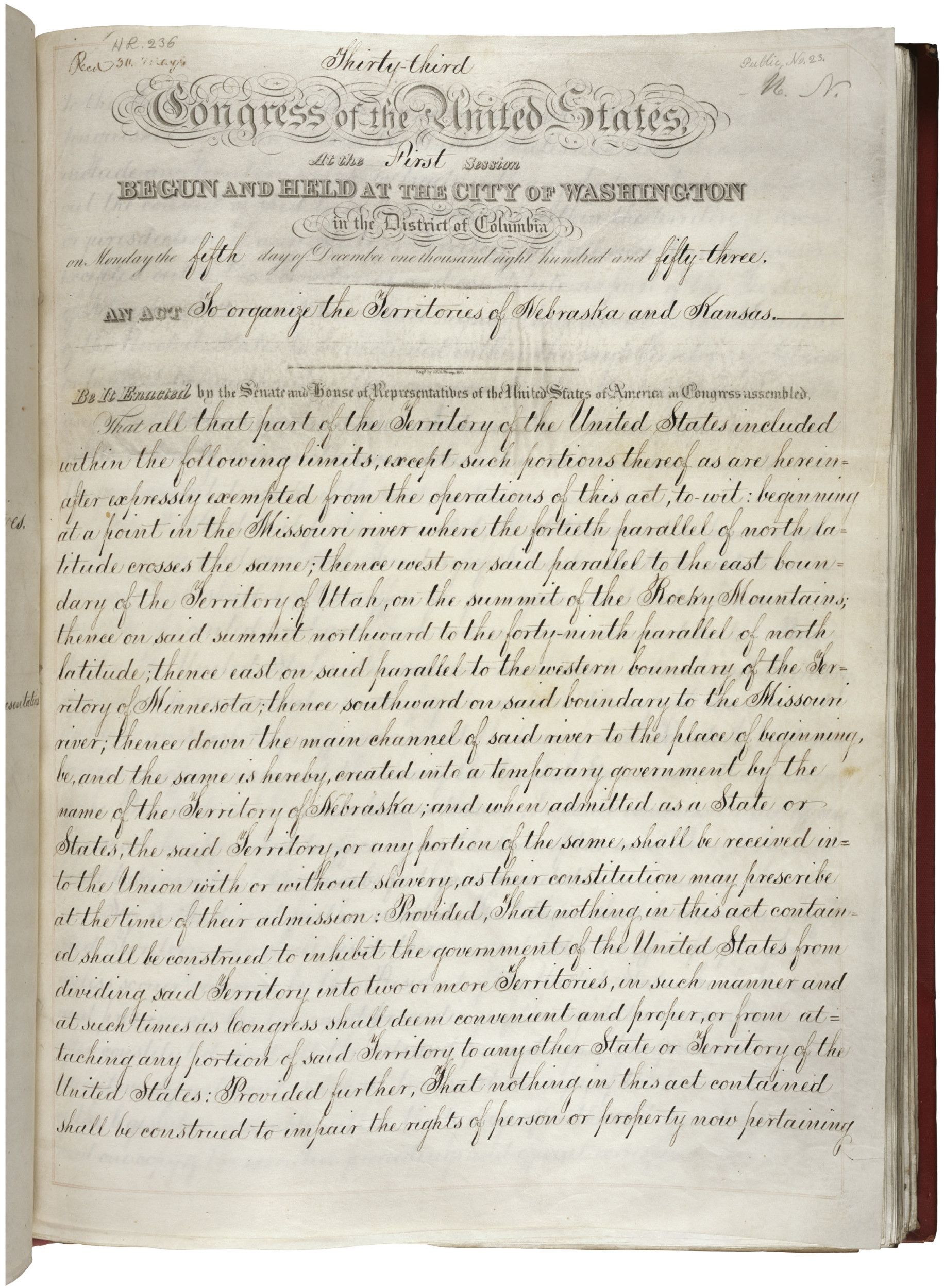
Kansas-Nebraska Act of 1854
Page 2
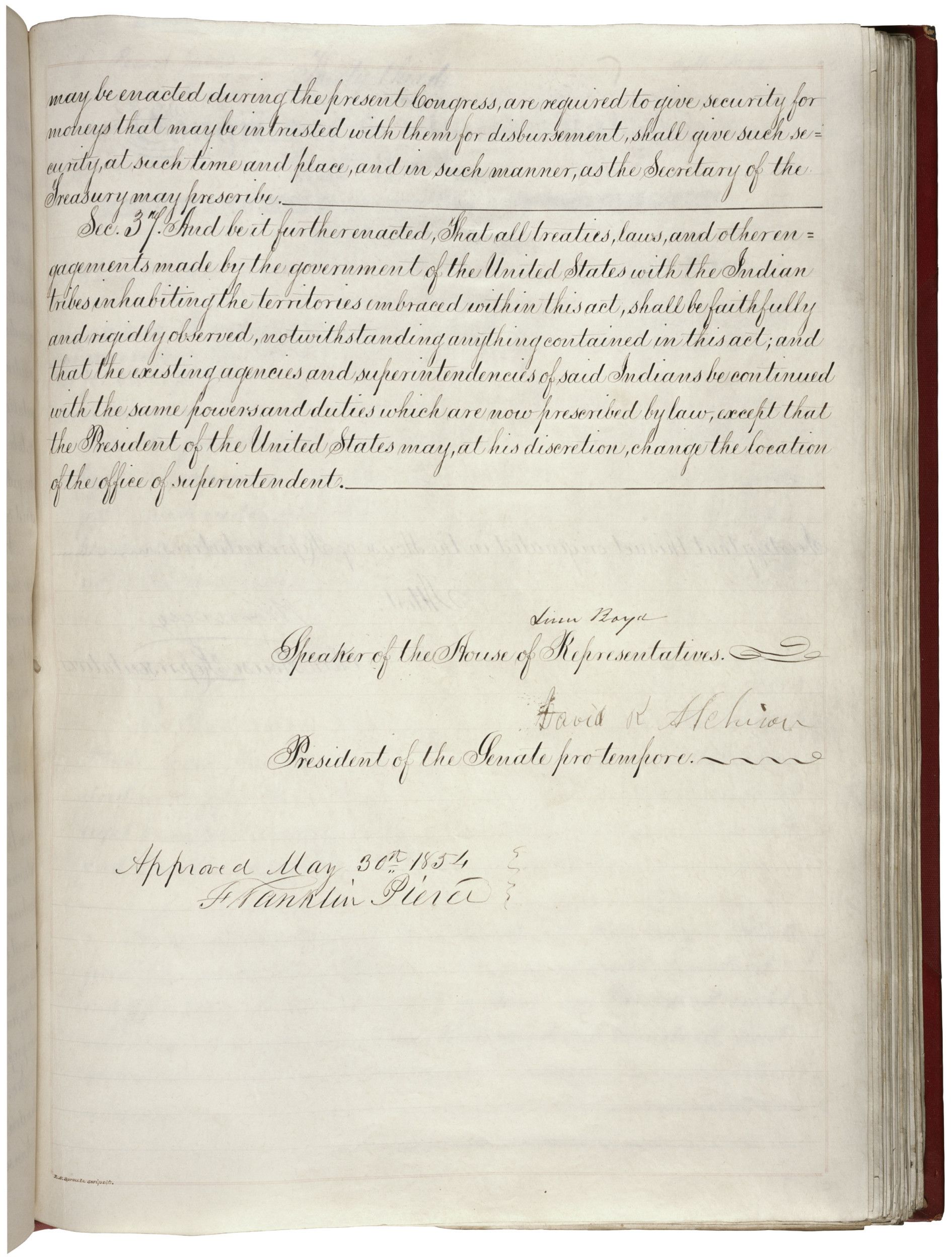
Document
Articles of Agreement in Regard to the Surrender of the Army of Northern Virginia Under General Robert E. Lee
4/10/1865
After the fall of Richmond, the Confederate capital, on April 2, 1865, officials in the Confederate government, including President Jefferson Davis, fled. The dominoes began to fall. The surrender at Appomattox took place a week later on April 9th.
Generals Ulysses S. Grant and Robert E. Lee met in the parlor of a house in Appomattox Court House, Virginia, to discuss the surrender of the Army of Northern Virginia. The surrender formalities lasted four days. The terms were generous: the men of Lee's army could return home in safety if they pledged to end the fighting and deliver their arms to the Union Army.
On April 12, 1865, in a quiet but emotional ceremony, the infantry of Lee's army surrendered their arms, folded their battle flags, and received their parole papers, which guaranteed them safe passage home.
While it was the most significant surrender to take place during the Civil War, Gen. Robert E. Lee, the Confederacy's most respected commander, surrendered only his Army of Northern Virginia to Union Gen. Ulysses S. Grant. Several other Confederate forces – some large units, some small – had yet to surrender before President Andrew Johnson could declare that the Civil War was officially over.
The Grant-Lee agreement served not only as a signal that the South had lost the war but also as a model for the rest of the surrenders that followed. After Richmond fell and Davis fled, Confederate commanders were on their own to surrender their commands to Union forces. Surrenders, paroles, and amnesty for many Confederate combatants would take place over the next several months and into 1866 throughout the South and border states. Not until 16 months after Appomattox, on August 20, 1866, did the President formally declare an end to the war.
Transcript
Appomattox Court House VirginiaApril 10, 1865
Agreement entered into this day in regard to the surrender of the Army of Northern Virginia to the United States Authorities.
1st The troops shall march by Brigades and Detachments to a designated point, stack their Arms, deposit their flags, Sabres, Pistols, etc. and from thence march to their homes under charge of their Officers, superintended by their respective Division and Corps Commanders, Officers, retaining their side Arms, and the authorized number of private horses.
2. All public horses and public property of all kinds to be turned over to Staff Officers designated by the United States Authorities.
3. Such transportation as may be agreed upon as necessary for the transportation of the Private baggage of Officers will be allowed to accompany the Officers, to be turned over at the end of the trip to the nearest U.S. Quarter Masters, receipts being taken for the same.
4. Couriers and Wounded men of the artillery and Cavalry whose horses are their own private property will be allowed to retain them.
5. The surrender of the Army of Northern Virginia shall be construed to include all the forces operating with that Army on the 8th inst., the date of commencement of negociation for surrender, except such bodies of Cavalry as actually made their escape previous to the surrender, and except also such forces of Artillery as were more than Twenty (20) miles from Appomattox Court House at the time of Surrender on the 9th unit.
[Endorsements]
[signed] John Gibbon J. Longstreet
Maj. Genl. Vols. Lt. Gen.
[signed] Chas Griffin J.B. Gordon
Bvt. Maj. Genl. U.S. Vols. Maj. Gen.
W.N. Pendleton
W. Merritt Brig. Genl. & Ch of Art.
Bvt. Maj. Genl.
[stamp] THE NATIONAL ARCHIVES OF THE UNITED STATES
Articles of Agreement in Regard to the Surrender of the Army of Northern Virginia Under General Robert E. Lee
Page 1

Articles of Agreement in Regard to the Surrender of the Army of Northern Virginia Under General Robert E. Lee
Page 2
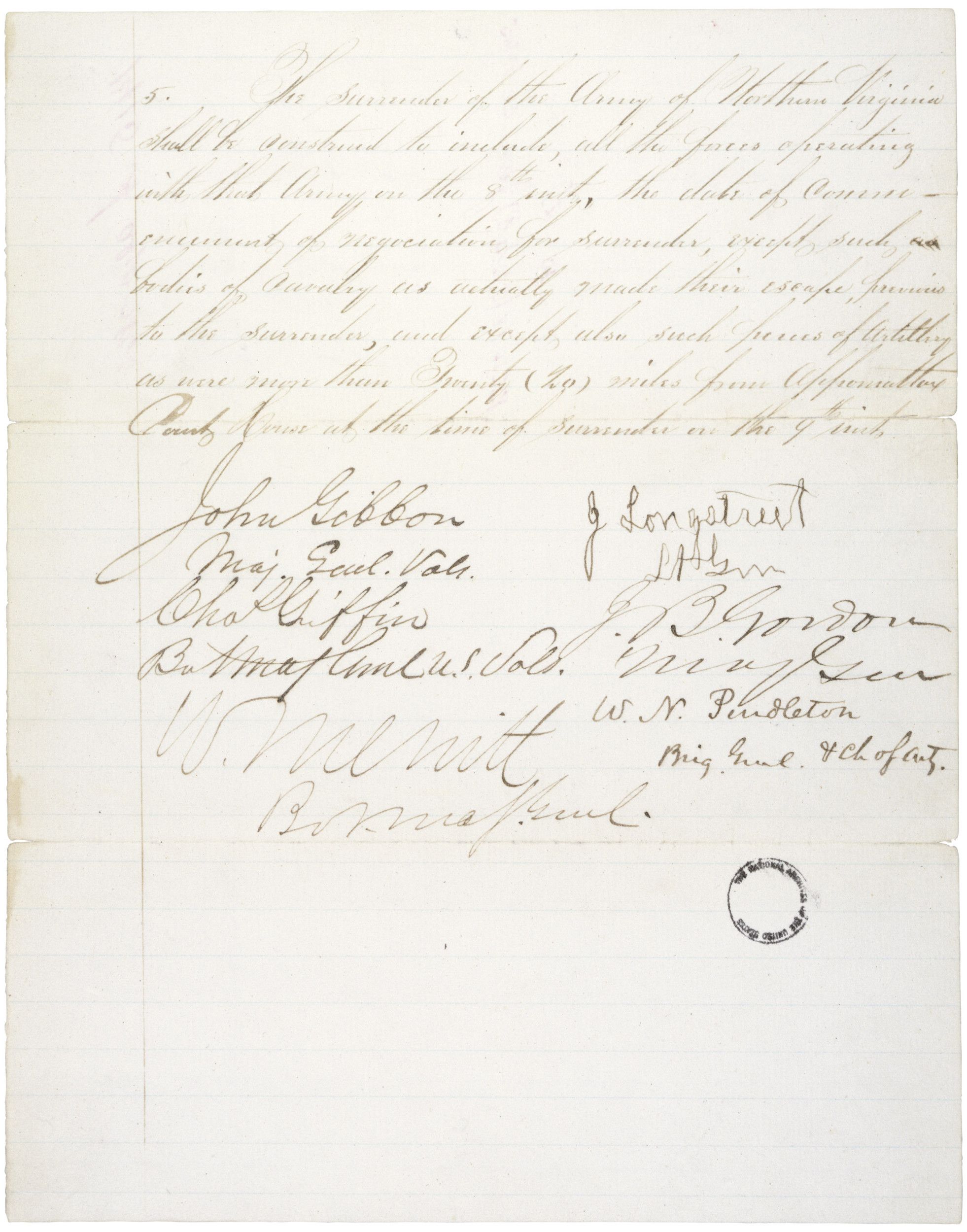
Document
Draft of Senate Joint Resolution 16 Submitting the 13th Amendment to the States
1864
Transcript
S. R. 16Joint Resolution.
[crossed out: Substitute] amendment
[typed text adhered to document]
[crossed out: Joint Resolution]
Submitting to the legislatures of the several States a proposition to amend the Constitution of the United States.
[italics] Be it enacted by the Senate and House of Representatives of the United States of America in Congress assembled, [end italics] (two-thirds of both houses concurring,) That the following article be proposed to the legislatures of the several States as an amendment to the Constitution of the United States, which, when ratified by three-fourths of said legislatures, shall be valid, to all intents and purposes, as a part of the said Constitution, namely:
Article XIII.
Section 1. [handwritten] Neither slaver nor involuntary servitude, except as a punishment for crime whereof the party shall have been duly convicted, shall [crossed out: hereafter] exist within the United States, or any place subject to their jurisdiction.
Sec. 2 Congress shall have power to enforce this article by appropriate legislation.
S.R. 16
Joint Resolution
[horizontal line]
Substitute
Amendment
Draft of Senate Joint Resolution 16 Submitting the 13th Amendment to the States
Page 1
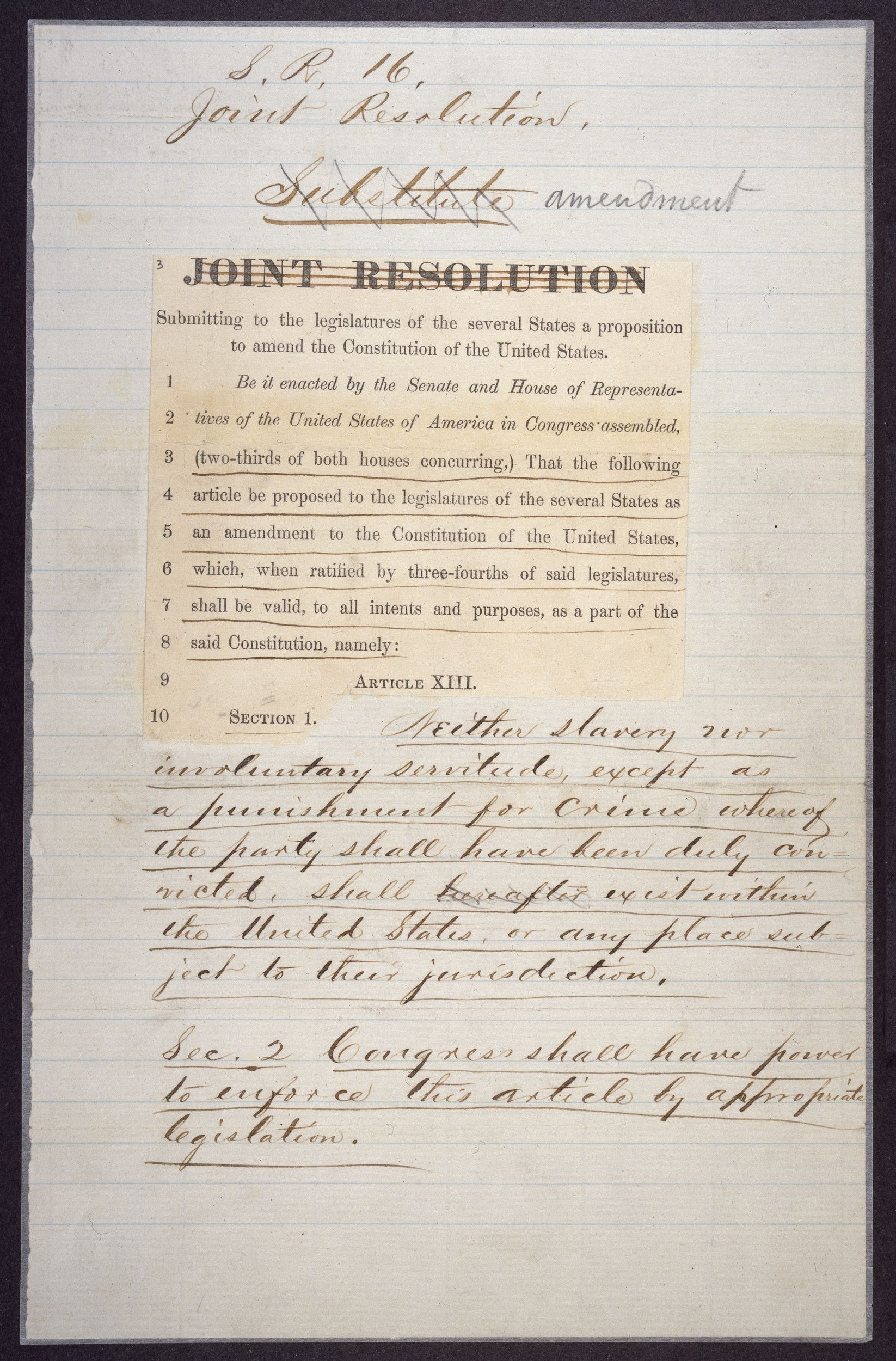
Draft of Senate Joint Resolution 16 Submitting the 13th Amendment to the States
Page 2

Document
Act of July 1, 1862 (Pacific Railroad Act), 12 STAT 489, which established the construction of a railroad and telegraph line from the Missouri River to the Pacific Ocean.
7/1/1862
In the 1850s, Congress had commissioned several topographical surveys across the West to determine the best route for a railroad, but private corporations were reluctant to undertake the task without federal assistance. This Act designated the 32nd parallel as the initial transcontinental route and provided government bonds to fund the project and large grants of lands for rights-of-way. The Act aided the construction of a railroad and telegraph line from the Missouri River to the Pacific Ocean and secured the use of that line to the government.
The legislation authorized two railroad companies, the Union Pacific and the Central Pacific, to construct the lines. Beginning in 1863, the Union Pacific, employing more than 8,000 Irish, German, and Italian immigrants, built west from Omaha, NE. The Central Pacific, whose workforce included over 10,000 Chinese laborers, built eastward from Sacramento, CA. Each company faced unprecedented construction challenges, severe weather, and conflict with American Indians, whose ancestral lands were transected by the railroads.
On May 10, 1869, the last rails were laid and the last spike was driven in a ceremony at Promontory, UT. The completion of the transcontinental railroad shortened a journey of several months to about one week. Congress eventually authorized four transcontinental railroads and granted 174 million acres of public lands for rights-of-way.
Transcript
Thirty SeventhCongress of the United States
At the Second Session
Begun and Held at the City of Washington
in the District of Columbia
on Monday the second day of December one thousand eight hundred and sixty one
An Act To aid in the construction of a railroad and telegraph line from the Missouri River to the Pacific Ocean, and to secure to the Government the use of the same for postal, military, and other purposes.
Be it enacted by the Senate and House of Representatives of the United States of America in Congress assembled, That Walter S. Burgess, William P. Blodget, Benjamin H. Cheever, Charles Fosdick Fletcher, of Rhode Island; Augustus Brewster, Henry P. Haven, Cornelius S. Bushnell, Henry Hammond, of Connecticut; Isaac Sherman, Dean Richmond, Royal Phelps, William H. Ferry, Henry A. Paddock, Lewis J. Stancliff, Charles A. Secor, Samuel R. Campbell, Alfred E. Tilton, John Anderson, Azariah Boody, John S. Kennedy, H. Carver, Joseph Field, , Benjamin F. Camp,Orville W. Childs, Alexander J. Bergen, Ben. Holliday, D. N. Barney, S. De Witt Bloodgood, William H. Grant, Thomas W. Olcott, Samuel B. Ruggles, James B. Wilson, of New York; Ephraim Marsh, Charles M. Harker, of New Jersey; John Edgar Thompson, Benjamin Haywood, Joseph H. Scranton, Joseph Harrison, George W. Cass, John H. Bryant, Daniel J. Morell, Thomas M. Howe, William F. Johnson, Robert Finney, John A. Green, E. R. Myre, Charles F. Wells, junior, of Pennsylvania; Noah L. Wilson, .Amasa Stone, William H. Clement, S. S. L'Hommedieu, John Brough, William Dennison, Jacob Blickinsderfer, of Ohio; William M. McPherson, R. W. Wells, Willard P. Hall, .Armstrong Beatty, John Corby, of Missouri ; S. J. Hensley, Peter Donahue, C. P. Huntington, T. D. Judah, James Bailey, James T. Ryan, Charles Hosmer, Charles Marsh, D. 0. Mills, Samuel Bell, Louis McLal1e, George W. Mowe, Charles McLaughlin, Timothy Dame, John R. Robinson, of California; John Atchison and John D. Winters, of the Territory of Nevada; John D. Campbell, R. N. Rice, Charles A. Trowbridge, and Ransom Gardner, Charles W. Penny, Charles T. Gorham, William McConnell, of Michigan; William F Coolbaugh, Lucius H. Langworthy, Hugh T. Reid, Hoyt Sherman, Lyman Cook, Samuel R. Curtis, Lewis .A. Thomas, Platt Smith, of Iowa; William B. Ogden, Charles G. Hammond, Henry Farnum, .Amos C. Babcock, W. Seldon Gale, Nehemiah Bushnell and Lorenzo Bull, of Illinois; William H. Swift, Samuel T. Dana, John Bertram, Franklin S. Stevens, Edward R. Tinker, of Massachusetts; Franklin Gorin, Laban J. Bradford, and John T. Levis, of Kentucky; James Dunning, John M. Wood, Edwin Noyes, Joseph Eaton, of Maine; Henry H. Baxter, George W. Collamer, Henry Keyes, Thomas H. Canfield, of Vermont ; William S. Ladd, .A. M. Berry, Benjamin F. Harding, of Oregon ; William Bunn, junior, John Catlin, Levi Sterling, John Thompson, Ellhu L. Phillips, Walter D. McIndoe T. B. Stoddard, E.H. Brodhead, A. H. Virgin, of Wisconsin; Charles Paine, Thomas A. Morris, David C. Branham, Samuel Hanna, Jonas Votaw, Jesse L. Villiams, Isaac C. Elston, of Indiana; Thomas Swan, Chauncey Brooks, Edward Wilkins, of Maryland; Francis R. E. Cornell, David Blakely, A. D. Seward, Henry A. Swift, Dwight Woodbury, John McKusick, John R. Jones, of Minnesota; Joseph A. Gilmore, Charles W. Woodman, of New Hampshire; W. H. Grimes, J. C. Stone, Chester Thomas, John Kerr, Werter R. Davis, Luther C. Challiss, Josiah Miller, of Kansas; Gilbert C. Monell and Augustus Kountz, T. M. Marquette, William H. Taylor, .Alyin Saunders, of Nebraska; John Evans, of Colorado; together with commissioners to be appointed by the Secretary of the Interior, and all persons who shall or may be associated with them, and their successors, are hereby created and erected into a body corporate and politic in deed and in law, by the name, style, and title of “The Union Pacific Railroad Company;" and by that name shall have perpetual succession, and shall be able to sue and to be sued, plead and be impleaded, defend and be defended, in all courts of law and equity within the United States, and may make and have a common seal; and the said corporation is hereby authorized and empowered to layout, locate, construct, furnish, maintain, and enjoy a continuous railroad and telegraph, with the appurtenances, from a point on the one hundredth meridian of longitude west from Greenwich, between the south margin of the valley of the Republican River and the north margin of the valley of the Platte River, in the Territory of Nebraska, to the western boundary of Nevada Territory, upon the route and terms hereinafter provided, and is hereby vested with all the powers, privileges, and immunities necessary to carry into effect the purposes of this act as herein set forth. The capital stock of said company shall consist of one hundred thousand shares of one thousand dollars each, which shall be subscribed for and held in not more than two hundred shares by anyone person, and shall be transferable in such manner as the by-laws of said corporation shall provide. The persons hereinbefore named, together with those to be appointed by the Secretary of the Interior, are hereby constituted and appointed commissioners, and such body shall be called the Board of Commissioners of the Union Pacific Railroad and Telegraph Company, and twenty-five shall constitute a quorum for the transaction of business. The first meeting of said board shall be held at Chicago at such time as the commissioners from Illinois herein named shall appoint, not more than three nor less than one month after the passage of this act, notice of which shall be given by them to the other commissioners by depositing a call thereof in the post office at Chicago, post paid, to their address at least forty days before said meeting, and also by publishing said notice in one daily newspaper in each of the cities of Chicago and Saint Louis. Said board shall organize by the choice from its number of a president, secretary, and treasurer, and they shall require from said treasurer such bonds as may be deemed proper, and may from time to time increase the amount thereof as they may deem proper. It shall be the duty of said board of commissioners to open books, or cause books to be opened, at such times and in such principal cities in the United States as they or a quorum of them shall determine, to receive subscriptions to the capital stock of said corporation, and a cash payment of ten per centum on all subscriptions, and to receipt therefor. So soon as two thousand shares shall be in good faith subscribed for, and ten dollars per share actually paid into the treasury of the company, the said president and secretary of said board of commissioners shall appoint a time and place for the first meeting of the subscribers to the stock of said company, and shall give notice thereof in at least one newspaper in each State in which subscription books have been opened at least thirty days previous to the day of meeting, and such subsribers as shall attend the meeting so called, either in person or by proxy, shall then and there elect by ballot not less than thirteen directors for said corporation; and in such election each share of said capital shall entitle the owner thereof to one vote. The president and secretary of the board of commissioners shall act as inspectors of said election, and shall certify under their hands the names of the directors elected at said meeting; and the said commissioners, treasurer, and secretary shall then deliver over to said directors all the properties, subscription books and other books in their possession, and thereupon the duties of said commissioners, and the officers previously appointed by them shall cease and determine forever, and thereafter the stockholders shall constitute said body politic and corporate. At the time of the first and each triennial election of directors by the stockholders two additional directors shall be appointed by the President of the United States, who shall act with the body of directors, and to be denominated directors on the part of the government; any vacancy happening in the government directors at any time may be filled by thc President of the United States. The directors to be appointed by the President shall not be stockholders in the Union Pacific Railroad Company. The directors so chosen shall, as soon as may be after their election, elect from their own number a president and vice-president, and shall also elect a treasurer and secretary. No person shall be a director in said company unless he shall be a bona fide owner of at least five shares of stock in the said company, except the two directors to be appointed by the President as aforesaid. Said company, at any regular meeting of the stockholders called for that purpose, shall have power to make by-laws, rules, and regulations as they shall deem needful and proper, touching the disposition of the stock, property, estate, and effects of the company, not inconsistent herewith, the transfer of shares, the term of office, duties, and conduct of their officers and servants, and all matters whatsoever which may appertain to the concerns of said company; and the said board of directors shall have power to appoint such engineers, agents, and subordinates as may from time to time be necessary to carry into effect the object of this act, and to do all acts and things touching the location' and construction of said road and telegraph. Said directors may require payment of subscriptions to the capital stock, after due notice, at such times and in such proportions as they shall deem necessary to complete the railroad and telegraph within the time in this act prescribed. Said president, vice-president, and directors shall hold their office for three years, and until their successors are duly elected and qualified, or for such less time as the by-laws of the corporation may prescribe; and a majority of said directors shall constitute a quorum for the transaction of business. The secretary and treasurer shall give such bonds, with such security, as the said board shall from time to time require, and shall hold their offices at the will and pleasure of the directors. Annual meetings of the stockholders of the said corporation, for the choice of officers (when they are to be chosen) and for the transaction of annual business, shall be holden at such time and place and upon such notice as may be prescribed in the by-laws.
Sec. 2. And he it further enacted, That the right of way through the public lands be, and the same is hereby, granted to said company for the construction of said railroad and telegraph line; and the right, power, and authority is hereby given to said company to take from the public lands adjacent to the line of said road, earth, stone, timber, and other materials for the construction thereof; said right of way is granted to said railroad to the extent of two hundred feet in width on each side of said railroad where it may pass over the public lands, including all necessary grounds for stations, buildings, workshops, and depots, machine shops, switches, side tracks, turntables, and, water stations. The United States shall extinguish as rapidly as may be the Indian titles to all lands falling under the operation of this act and required for the said right of way and; grants hereinafter made.
Sec 3. And be it further enacted, That there be, and is hereby , granted to the said company, for the purpose of aiding in the construction , of said railroad and telegraph line, and to secure the safe and speedy transportation of the mails, troops, munitions of war, and public stores thereon, every alternate section of public land, designated by odd numbers, to the amount of five alternate sections per mile on each side of said railroad, on the line thereof, and within the limits often miles on each side of said ro1ld, not sold, reserved, or otherwise disposed of by the United States, and to which a preemption or homestead claim may not have attached, at the time the line of said road is definitely fixed : Provided, That all mineral lands shall be excepted from the operation of this act; but where the same shall contain timber, the timber thereon is hereby granted to said company. And all such lands, so granted by this section, which shall not be sold or disposed of by said company within three years after the entire road shall have been completed, shall be subject to settlement and preemption, like other lands, at a price not exceeding one dollar and twenty-five cents per acre, to be paid to said company.
Sec. 4. And be it further enacted, That whenever said company shall have completed forty consecutive miles of any portion of said railroad and telegraph line, ready for the service contemplated by this act, and supplied with all necessary drains, culverts, viaducts, crossings, sidings, bridges, turnouts, watering places, depots, equipments, furniture, and all other appurtenances of a first class railroad, the rails and all the other iron used in the construction and equipment of said road to be American manufacture of the best quality, the President of the United States shall appoint three commissioners to examine the same and report to him in relation thereto; and if it shall appear to him that forty consecutive miles of said railroad and telegraph line have been completed and equipped in all respects as required by this act, then, upon certificate of said commissioners to that effect, patents shall issue conveying the right and title to said lands to said company, on each side of the road as far as the same is completed, to the amount aforesaid; and patents shall in like manner issue as each forty miles of said railroad and telegraph line are completed, upon certificate of said commissioners. Any vacancies occurring in said board of commissioners by death, resignation, or otherwise, shall be filled by the President of the United States: Provided, however, That Do such commissioners shall be appointed by the President of the United States unless there shall be presented to him a statement, verified on oath by the president of said company, that such forty miles have been completed, in the manner required by this act, and setting forth with certainty the points where such forty miles begin and where the same end;; which oath shall be taken before a judge of a court of record.
Sec. 5. And be it further enacted, That for the purposes herein mentioned the Secretary of the Treasury shall, upon the certificate in writing of said commissioners of the completion and equipment of forty consecutive miles of said railroad and telegraph, in accordance with the provisions of this act, issue to said company bonds of the United States of one thousand dollars each, payable in thirty years after date, bearing six per centum per annum interest (said interest payable semi-annually,) which interest may be paid in United States treasury notes or any other money or currency which the United States have or shall declare lawful money and a legal tender, to the amount of sixteen of said bonds per mile for such section of forty miles; and to secure the repayment to the United States, as hereinafter provided, of the amount of said bonds so issued and delivered to said company, together with all interest thereon which .shall have been paid by the United States, the issue of said bonds and delivery to the company shall ipso facto constitute a first mortgage on the whole line of the railroad and telegraph, together with the rolling stock, fixtures and property of every kind and description, and in consideration of which said bonds may be issued ; and on the refusal or failure of said company to redeem said bonds, or any part of them, when required so to do by the Secretary of the Treasury, in accordance with the provisions of this act the said road, with all the rights, functions, immunities, and appurtences thereunto belonging, and also all lands granted to the said company by the United States, which, at the time of said default, shall remain in the ownership of the said company, may be taken possession of by the Secretary of the Treasury, for the use and benefit of the United States: Provided, this section shall not apply to that part of any road now constructed.
Sec. 6. And be it further enacted, That the grants aforesaid are made upon condition that said company shall pay said bonds at maturity, and shall keep said railroad and telegraph line in repair and use, and shall at all times transmit despatches over said telegraph line, and transport mails, troops, and munitions of war, supplies, and public storage upon said railroad for the government, whenever required to do so by any department , thereof, and that the government shall at all times have the preference in the use of the same for all the purposes aforesaid, (at fair and reasonable rates of compensation, not to exceed the amounts paid by private parties for the same kind of service ;) and all compensation for services rendered for the government shall be applied to the payment of said bonds and interest until the whole amount is fully paid. Said company may also pay the United States, wholly or in part, in the same or other bonds, treasury notes, or other evidences of debt against the United States, to be allowed at par; and after said road is completed, until said bonds and interest are paid, at least five per centum of the net earnings of said road "hall also be annually applied to the payment thereof.
Sec. 7. And be it further enacted, That said company shall file their assent to this act, under the seal of said company, in the Department of the Interior, within one year after the passage of this act, and shall com-plete said railroad and telegraph from the point of beginning ,as herein provided, to the western boundary of Nevada Territory before the first day of July, one thousand eight hundred and seventy-four: Provided, That within two years after the passage of this act said company shall designate the general route of said road, as near as may be, and shall file a map of the same in the Department of the Interior, whereupon the Secretary of the Interior shall cause the lands within fifteen miles of said designated route or routes to be withdrawn from preemption, private entry, and sale; and when any portion of said route shall be finally located, the Secretary of the Interior shall cause the said lands hereinbefore granted to be surveyed and set off as fast as may be necessary for the purposes herein named: Provided, That in fixing the point of con-nection of the main trunk with the eastern connections, it shall be fixed at the most practicable point for the construction of the Iowa and Missouri branches, as hereinafter provided.
Sec. 8. And be it further enacted, That the line of said railroad and telegraph shall commence at a point on the one hundredth meridian of a longitude west from Greenwich, between the south margin of the valley of the Republican River and the north margin of the valley of the Platte River, in the Territory of Nebraska, at a point to be fixed by the President of the United States, after actual surveys ; thence running westerly upon the most direct, central, and practicable route, through the territories of the United States, the western boundary of the Territory of Nevada, there to meet and connect with the line of the Central Pacific Railroad Company of California.
Sec. 9. And be it further enacted, That the Leavenworth, Pawnee, and Western Railroad Company of Kansas are hereby authorized to construct a railroad and telegraph line, from the Missouri River, at the mouth of the Kansas River, on the south side thereof, so as to connect with the Pacific railroad of Missouri, to the aforesaid point, on the one hundredth meridian of longitude west from Greenwich, as herein provided, upon the same terms and conditions in all respects as are provided in this act for the construction of the railroad and telegraph line first mentioned, and to meet and connect with the same at the meridian of longitude aforesaid ; and in case the general route or line of road from the Missouri River to the Rocky Mountains should be so located as to require a departure northwardly from the proposed line of said Kansas railroad before it reaches the meridian of longitude aforesaid, the location of said Kansas road shall be made so as to conform thereto; and said railroad through Kansas shall be so located between the mouth of the Kansas River, as aforesaid, and the aforesaid point, on the one hundredth meridian of longitude, that the several railroads from Missouri and Iowa, herein authorized to connect with the same, can make connection within the limits prescribed in this act, provided the same can be done without deviating from the general direction of the whole line to the Pacific coast. The route in Kansas, west of the meridian of Fort Riley, to the aforesaid point, on the one hundredth meridian of longitude, to be subject to the approval of the President of the United States, and to be determined by him on actual survey. And said Kansas company may proceed to build said railroad to the aforesaid point, on the one hundredth meridian of longitude west from Greenwich, in the territory of Nebraska. The Central Pacific Railroad Company of California, a corporation existing under the laws of the State of California, are hereby authorized to construct a railroad and telegraph line from the Pacific coast, at or near San Francisco, or the navigable waters of the Sacramento River, to the eastern boundary of California, upon the same terms and conditions, in all respects, as are contained in this act for the construction of said railroad and telegraph line first mentioned, and to meet and connect with the first mentioned railroad and telegraph line on the eastern boundary of California. Each of said companies shall file their acceptance of the conditions of this act in the Department of the Interior within six months after the passage of this act.
Sec. 10. And be it further enacted, That the said company chartered, by the State of Kansas shall complete one hundred miles of their said road, commencing at the mouth of the Kansas River as aforesaid, within two years after filing their assent to the conditions of this act, as herein provided, and one hundred miles per year thereafter until the whole is completed; and the said Central Pacific Railroad Company of California shall complete fifty miles of their said road within two years after filing their assent to the provisions of this act, as herein provided, and fifty miles per year thereafter until the whole is completed; and after completing their roads, respectively, said companies, or either of them, may unite upon equal terms with the first-named company in constructing so much of said railroad and telegraph line and branch railroads and telegraph lines in Luis act hereinafter mentioned, through the Territories from the State of California to the Missouri River, as shall then remain to be constructed, on the same terms and conditions as provided in this act in relation to the said Union Pacific Railroad Company. And the Hannibal and St. Joseph Railroad, the Pacific Railroad Company of Missouri, and the first-named company, or either of them, on filing their assent to this act, as aforesaid, may unite upon equal terms, under this act, with the said Kansas company, in constructing said railroad and telegraph, to said meridian of longitude, with the consent of the said State of Kansas ; and in case said first-named company shall complete their line to the eastern boundary of California before it is completed across said State by the Central Pacific Railroad Company of California, said first-named company is hereby authorized to continue in constructing the same through California, with the consent of said State, upon the terms mentioned in this act, until said roads shall meet and connect, and the whole line of said railroad and telegraph is completed; and the Central Pacific Railroad Company of California, after completing its road across said State, is authorized to continue the construction of said railroad and telegraph through the Territories of the United States to the Missouri River, including the branch roads specified in this act, upon the routes hereinbefore and hereinafter indicated, on the terms and conditions provided in this act in relation to the said Union Pacific Railroad Company, until said roads shall meet and connect, and the whole line of said railroad and branches and telegraph is completed.
Sec. 11. And be it further enacted, That for three hundred miles of said road most mountainous and difficult of construction, to wit: one hundred and fifty miles westwardly from the eastern base of the Rocky Mountains, and one hundred and fifty miles eastwardly from the western, base of the Sierra Nevada mountains, said points to be fixed by the President of the United States, the bonds to be issued to aid in the construction thereof shall be treble the number per mile hereinbefore provided, and the same shall be issued, and the lands herein granted be .set apart, upon the construction of every twenty miles thereof, upon the certificate of the commissioners as aforesaid that twenty consecutive miles of the same are completed and between the sections last named of one hundred and fifty miles each, the bonds to be issued to aid in the construction thereof shall be double the number per mile first mentioned, and the same shall be issued, and the lands herein granted be set apart, upon the construction of every twenty miles thereof, upon the certificate of the commissioners as aforesaid that twenty consecutive miles of the same are completed: Provided, That no more than fifty thousand of said bonds shall be issued under this act to aid in constructing the main line of said railroad and telegraph.
Sec. 12. And be it further enacted, That whenever the route of said railroad shall cross the boundary of any State or Territory, or said meridian of longitude, the two companies meeting or uniting there shall agree upon its location at that point, with reference to the most direct and practicable through route, and in case of difference between them as to said location the President of the United States shall determine the said location; the companies named in each State and Territory to locate the road across the same between the points so agreed upon, except as herein provided. The track upon the entire line of railroad and branches shall be of uniform width, to be determined by the President of the United States, so that, when completed, cars can be run from the Missouri River to the Pacific coast; the grades and curves shall not exceed the maximum grades and curves of the Baltimore and Ohio railroad; the whole line of said railroad and branches and telegraph shall be operated and used for all purposes of communication, travel, and transportation, so far as the public and government are concerned, as one connected, continuous line; and the companies herein named in Missouri, Kansas, and California, filing their assent to the provisions of this act, shall receive and transport all iron rails, chairs, spikes, ties, timber, and all materials required for constructing and furnishing said first-mentioned line between the aforesaid point, on the one hundredth meridian of longitude and western boundary of Nevada Territory, whenever the same is required by said first-named company, at cost, over that portion of the roads of said companies constructed under the provisions of this act.
Sec. 13. And be it further enacted, That the Hannibal and Saint Joseph Railroad Company of Missouri may extend its roads from Saint Joseph, via Atchison, to connect and unite with the road through Kansas, upon filing its assent to the provisions of this act, upon the same terms and conditions, inall respects for one hundred miles in length next to the Missouri River, as are provided in this act for the construction of the railroad and telegraph line first mentioned, and may for this purpose use any railroad charter which has been or may be granted by the legislature of Kansas ; Provided, That if actual survey shall render it desirable, the said company may construct their road, with the consent of the Kansas legislature, on the most direct and practicable route west from St. Joseph, Missouri, so as to connect and unite with the road leading from the western boundary of Iowa at any point east of the one hundredth meridian of west longitude, or with the main trunk road at said point ; but in no event shall lands or bonds be given to said company, as herein directed, to aid in the construction of their said road for a greater distance than one hundred miles. And the Leavenworth, Pawnee, and Western Railroad Company of Kansas may construct their road from Leavenworth to unite with the road through Kansas.
Sec. 14. And be it further enacted, That the said Union Pacific Railroad Company is hereby authorized and required to construct a single line of railroad and telegraph from a point on the western boundary of the State of Iowa, to be fixed by the President of the United States, upon the most direct and practicable route, to be subject to his approval, so as to form a connection with the lines of said company at some point on the one hundredth meridian of longitude aforesaid, from the point of commencement on the western boundary of the State of Iowa, upon the same terms and conditions, in all respects, as are contained in this act for the construction of the said railroad and telegraph first mentioned; and the said Union Pacific Railroad Company shall complete one hundred miles of the road and telegraph in this section provided for, in two years after filing their assent to the conditions of this act, as by the terms of this act required, and at the rate of one hundred miles per year thereafter, until the whole is completed: Provided, That a failure upon the part of said company to make said connection in the time aforesaid, and to perform the obligations imposed on said company by this section and to operate said road in the same manner as the main line shall be operated, shall forfeit to the government of the United States all the rights, privileges, and franchises granted to and conferred upon said company by this act. And whenever there shall be a line of railroad completed through Minnesota or Iowa to Sioux City, then the said Pacific Railroad Company is hereby authorized and required to construct a railroad and telegraph from Said Sioux City upon the most direct and practicable route to a point on, and so as to connect with, the branch railroad and telegraph in this section hereinbefore mentioned, or with the said Union Pacific Railroad, said point of junction to be fixed by the President of the United States, not further west than the one hundredth meridian of longitude aforesaid, and on the same terms and conditions as provided in this act for the construction of the Union Pacific Railroad as aforesaid, and to complete the same at the rate of one hundred miles per year; and should said company fail to comply with the requirements of this act in relation to the said Sioux City railroad and telegraph, the said company shall suffer the same forfeitures prescribed in relation to the Iowa branch railroad and telegraph hereinbefore mentioned.
Sec. 15. And be it further enacted, That any other railroad company now incorporated, or hereafter to be incorporated, shall have the right to connect their road with the road and branches provided for by this act, at such places and upon such just and equitable terms as the President of the United States may prescribe. Wherever the word company is used in this act it shall be construed to embrace the words their associates, successors, and assigns, the same as if the words had been properly added thereto.
Sec. 16. And be it further enacted, That at any time after the passage of this act all of the railroad companies named herein, and assenting hereto, or any two or more of them, are authorized to form themselves into one consolidated company; notice of such consolidation, in writing, shall be filed in the Department of the Interior, and such consolidated company shall thereafter proceed to construct said railroad and branches and telegraph line upon the terms and conditions provided in this act.
Sec. 17. And be it further enacted, That in case said company or companies shall fail to comply with the terms and conditions of this act, by not completing said road and telegraph and branches within a reasonable time, or by not keeping the same in repair and use, but shall permit the same, for an unreasonable time, to remain unfinished, or out of repair, and unfit for use, Congress may pass any act to insure the speedy completion of said road and branches, or put the same in repair and use, and may direct the income of said railroad and telegraph line to be thereafter devoted to the use of the United States, to repay all such expenditures caused by the default and neglect of such company or companies : Provided, That if said roads are not completed, so as to form a continuous line of railroad, ready for use, from the Missouri River to the navigable waters of the Sacramento River, in California, by the first day of July, eighteen hundred and seventy-six, the whole of all of said railroads before mentioned and to be constructed under the provisions of this act, together with all their furniture, fixtures, rolling stock, machine shops, lands, tenements, and hereditaments, and property of every kind and character, shall be forfeited to and be taken possession of by the United States : Provided, That of the bonds of the United States in this act provided to be delivered for any and all parts of the roads to be constructed east of the one hundredth meridian of west longitude from , Greenwich, and for any part of the road west of the west foot of the Sierra Nevada mountain, there shall be reserved of each part and installment twenty-five per centum, to be and remain in the United States treasury, undelivered, until said road and all parts thereof provided for in this act are entirely completed; and of all the bonds provided to be delivered for the said road, between the two points aforesaid, there shall be reserved out of each installment fifteen per centum, to be and remain in the treasury until the whole of the road provided for in this act is fully completed; and if the said road or any part thereof shall fail of completion at the time limited therefor in this act, then and in that case the said part of said bonds so reserved shall be forfeited to the United States.
Sec. 18. And be it further enacted, That whenever it appears that the , net earnings of the entire road and telegraph, including the amount allowed for services rendered for the United States, after deducting all, expenditures, including repairs, and the furnishing, running, and managing of said road, shall exceed ten per centum upon its cost, exclusive of the five per centum to be paid to the United States, Congress may reduce the rates of fare thereon, if unreasonable in amount, and may fix and establish the same by law. And the better to accomplish the object of this act, namely, to promote the public interest and welfare by the construction of said railroad and telegraph line, and keeping the same in working order, and to secure to the government at all times (but particularly in time of war) the use and benefits of the same for postal, military and other purposes, Congress may, at any time, having due regard for the rights of said companies named herein, add to, alter, amend, or repeal this act.
Sec. 19. And be it further enacted, That the several railroad companies herein named are authorized to enter into an arrangement with the Pacific Telegraph Company, the Overland Telegraph Company, and the California State Telegraph Company, so that the present line of telegraph between the Missouri River and San Francisco may be moved upon or along the line of said railroad and branches as fast as said roads and branches are built; and if said arrangement be entered into and the transfer of said telegraph line be made in accordance therewith to the line of said railroad and branches, such transfer shall, for all purposes of this act, be held and considered a fulfillment on the part of said railroad companies of the provisions of this act in regard to the construction of said line of telegraph. And, in case of disagreement, said telegraph companies are authorized to remove their line of telegraph along and upon the line of railroad herein contemplated without prejudice to the rights of said railroad companies named herein.
Sec. 20. And he it further enacted, That the corporation hereby created and the roads connected therewith, under the provisions of this act, shall make to the Secretary of the Treasury an annual report wherein shall be set forth-
First. The names of the stockholders and their places of residence, so far as the same can be ascertained;
Second. The names and residences of the directors, and all other officers of the company;
Third. The amount of stock subscribed, and the amount thereof actually paid in;
Fourth. A description of the lines of road surveyed, of the lines thereof fixed upon for the construction of the road, and the cost of such surveys;
Fifth. The amount received from passengers on the road;
Sixth. The amount received for freight thereon;
Seventh. A statement of the expense of said road and its fixtures;
Eighth. A statement of the indebtedness of said company, setting forth the various kinds thereof. Which report shall be sworn to by the president of the said company, and shall be presented to the Secretary of the Treasury on or before the first day of July in each year.
[signature] Galusha A. Grow
Speaker of the House of Representatives
[signature] Solomon Foot
President of the Senate pro tempore
[signature] Abraham Lincoln
Approved, July 1, 1862.
Act of July 1, 1862 (Pacific Railroad Act), 12 STAT 489, which established the construction of a railroad and telegraph line from the Missouri River to the Pacific Ocean.
Page 1
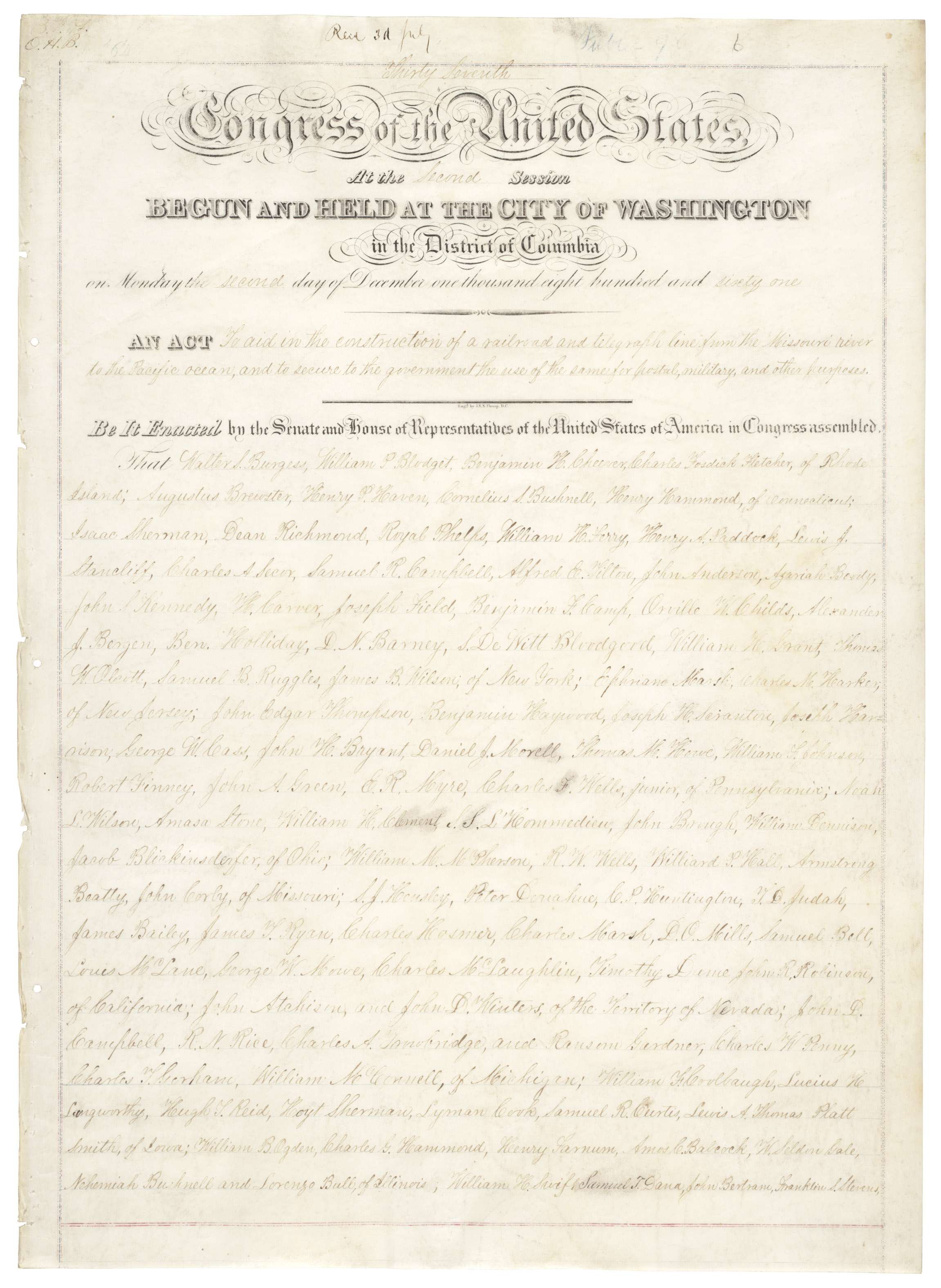
Act of July 1, 1862 (Pacific Railroad Act), 12 STAT 489, which established the construction of a railroad and telegraph line from the Missouri River to the Pacific Ocean.
Page 2
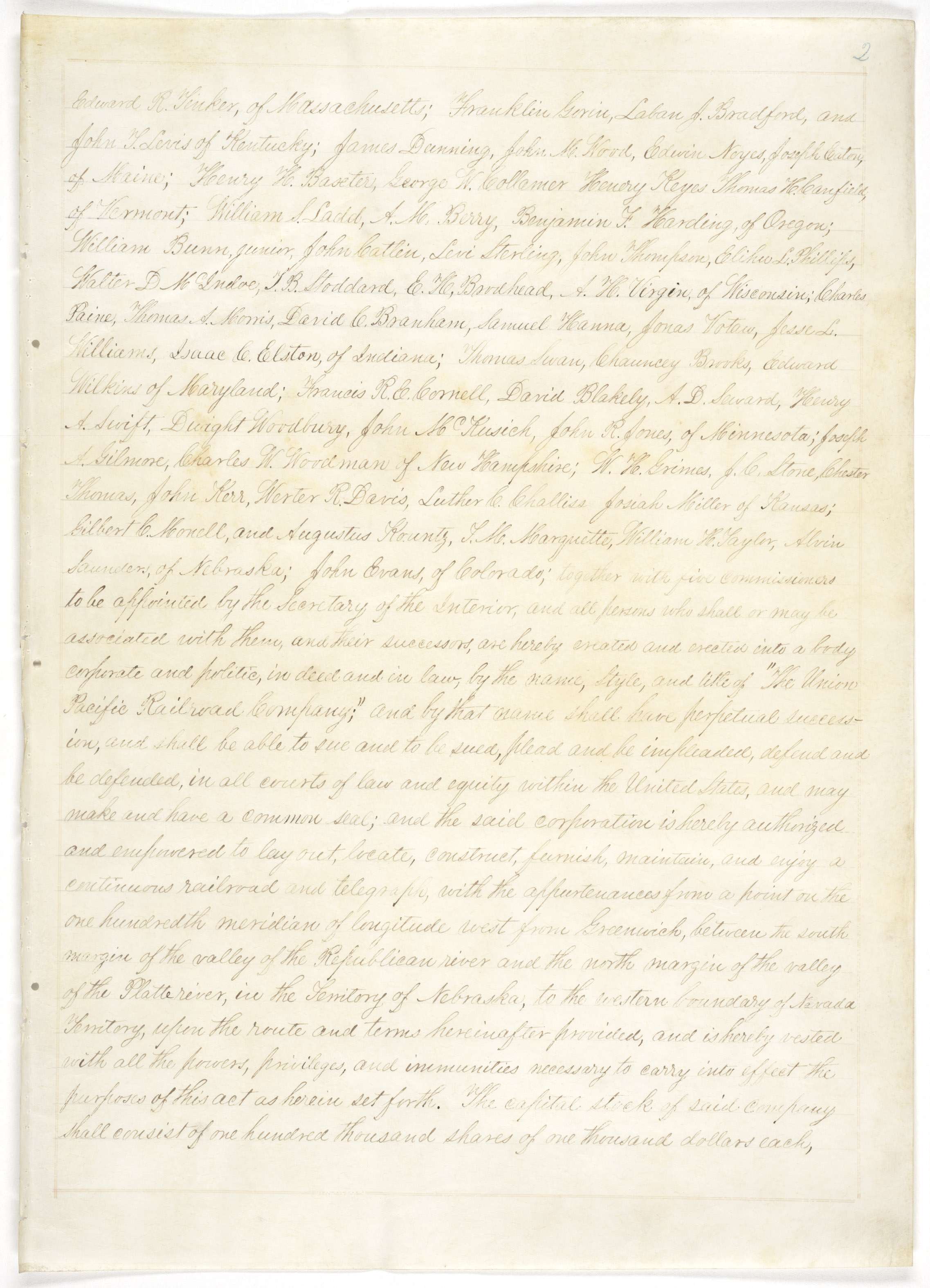
Act of July 1, 1862 (Pacific Railroad Act), 12 STAT 489, which established the construction of a railroad and telegraph line from the Missouri River to the Pacific Ocean.
Page 3
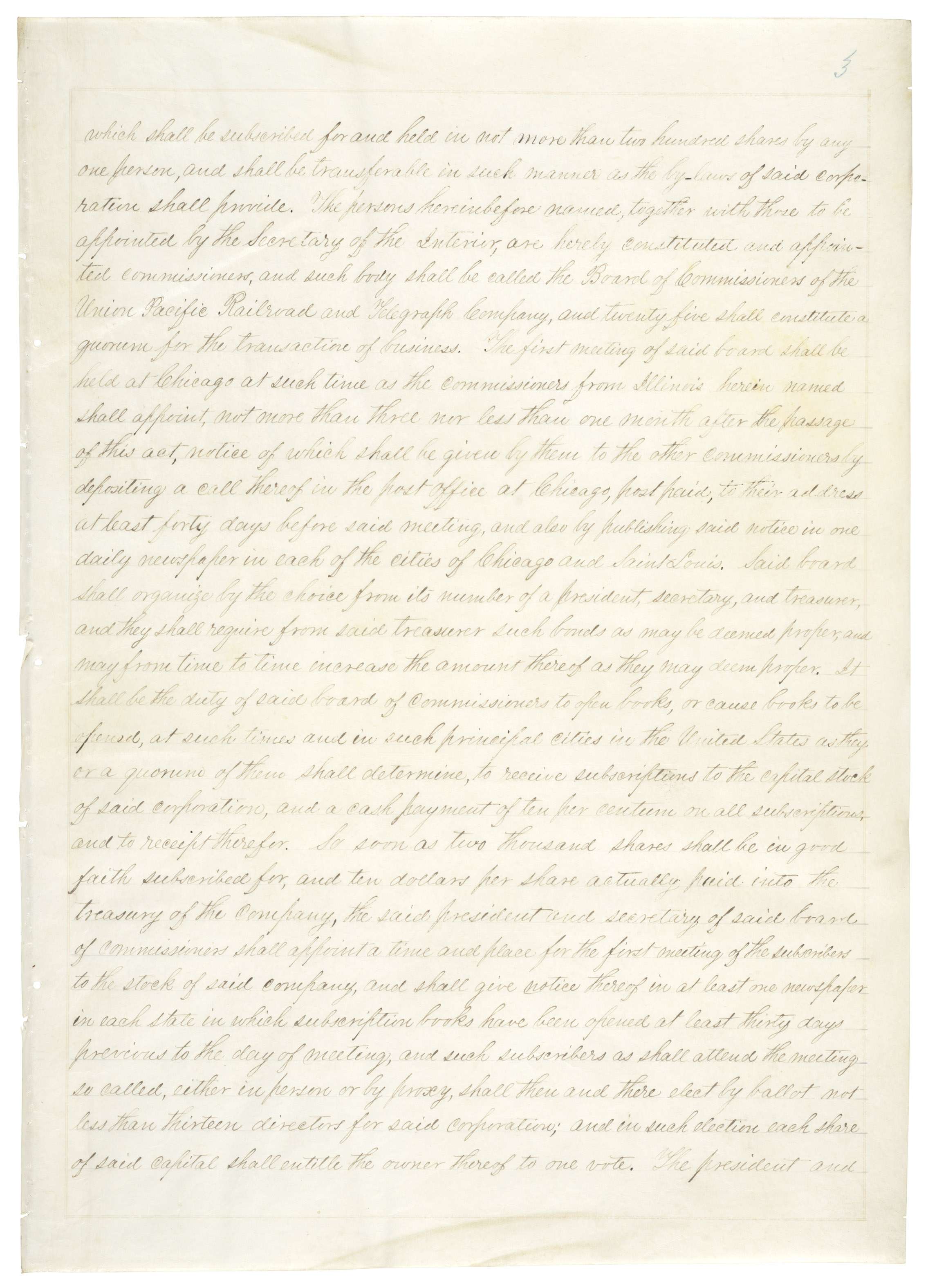
Act of July 1, 1862 (Pacific Railroad Act), 12 STAT 489, which established the construction of a railroad and telegraph line from the Missouri River to the Pacific Ocean.
Page 4
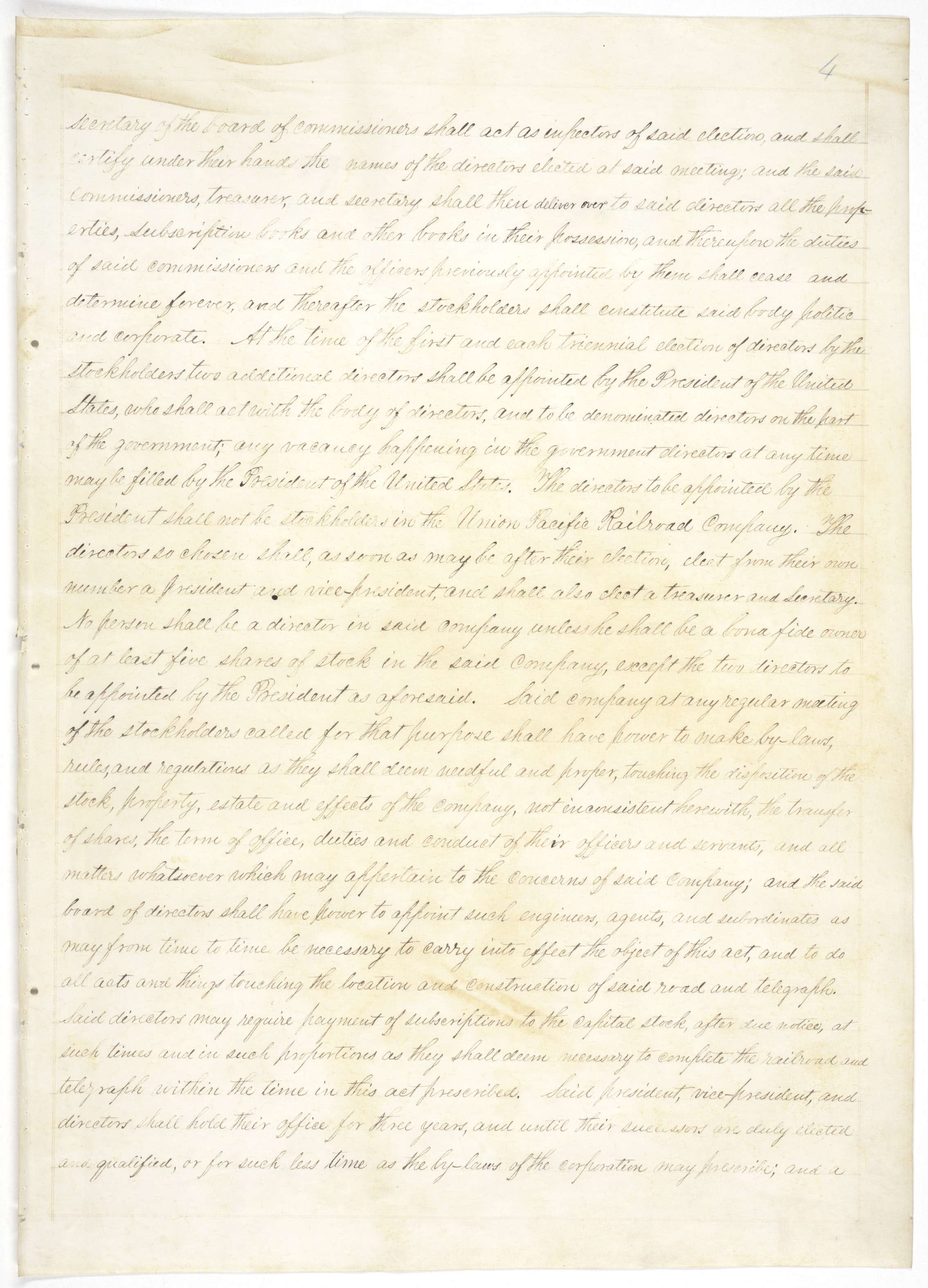
Act of July 1, 1862 (Pacific Railroad Act), 12 STAT 489, which established the construction of a railroad and telegraph line from the Missouri River to the Pacific Ocean.
Page 5
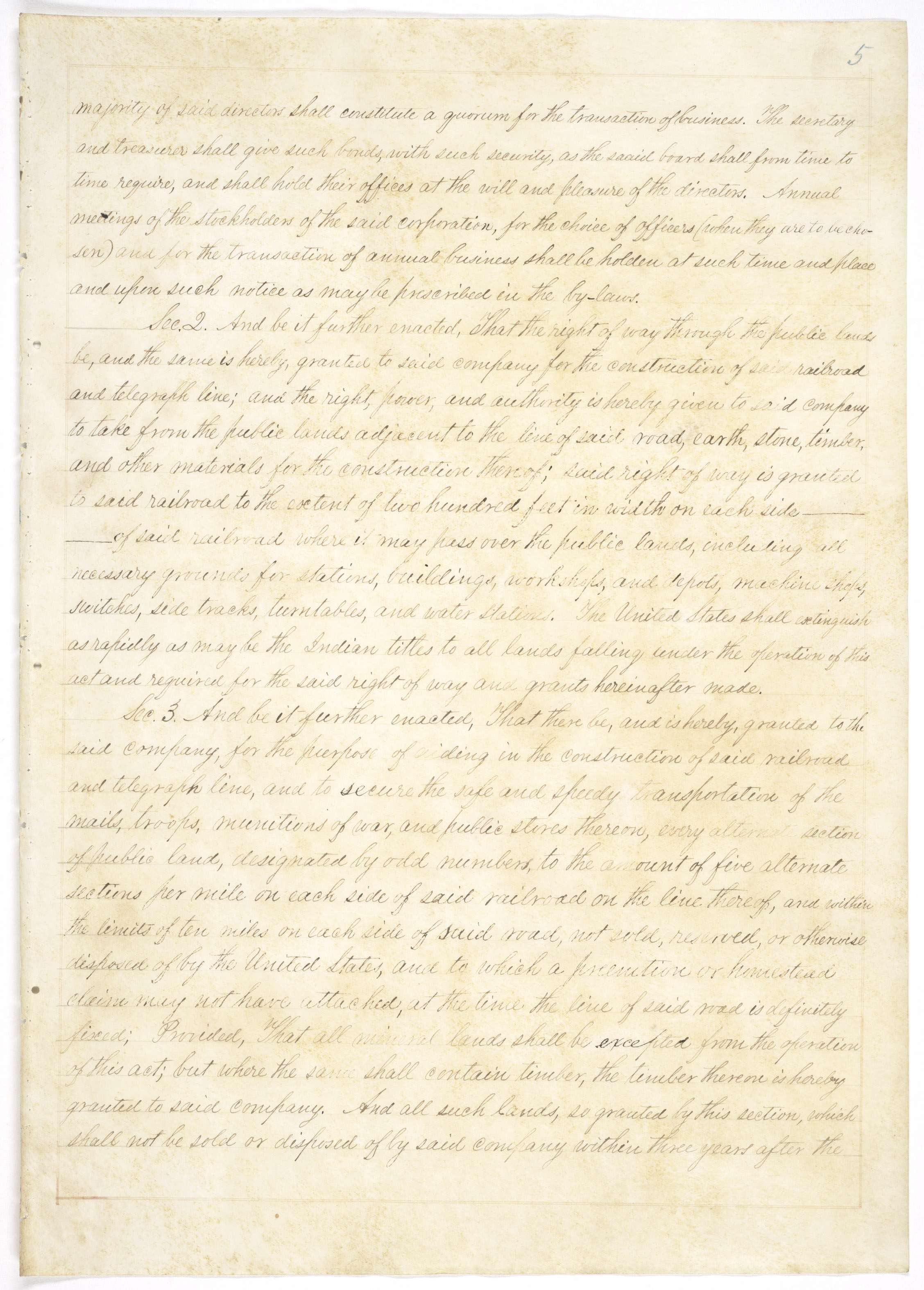
Act of July 1, 1862 (Pacific Railroad Act), 12 STAT 489, which established the construction of a railroad and telegraph line from the Missouri River to the Pacific Ocean.
Page 6
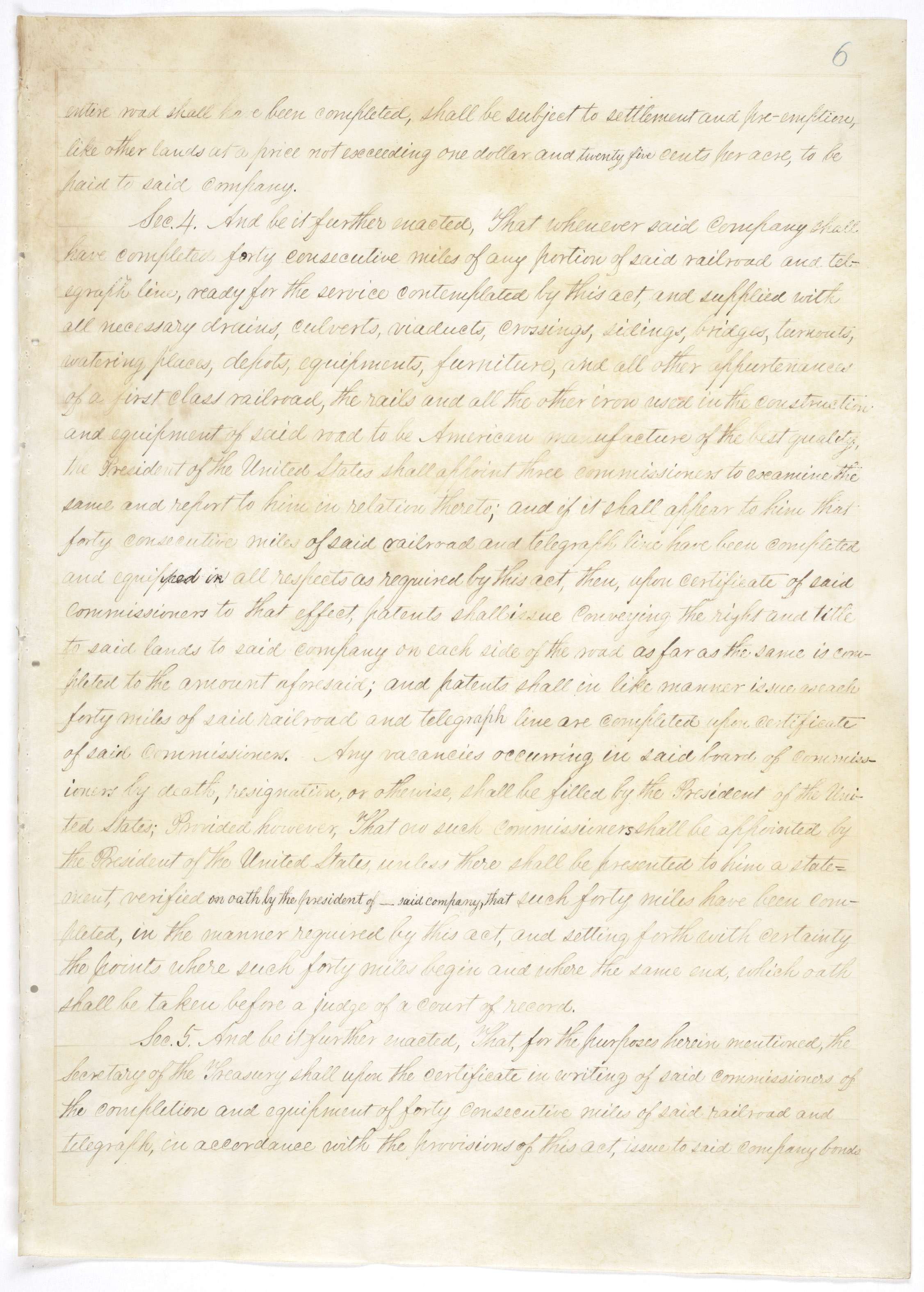
Act of July 1, 1862 (Pacific Railroad Act), 12 STAT 489, which established the construction of a railroad and telegraph line from the Missouri River to the Pacific Ocean.
Page 7
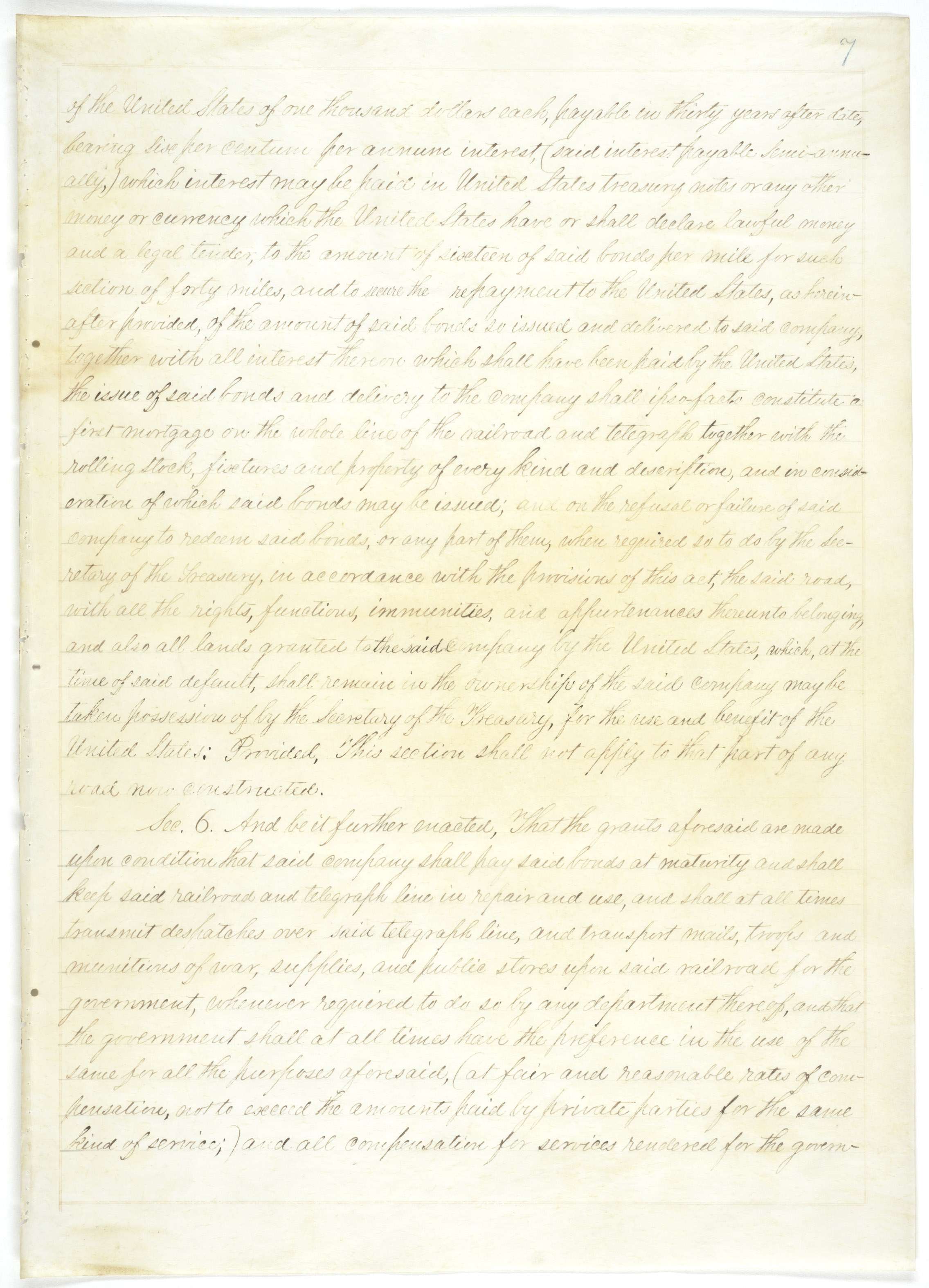
Act of July 1, 1862 (Pacific Railroad Act), 12 STAT 489, which established the construction of a railroad and telegraph line from the Missouri River to the Pacific Ocean.
Page 8
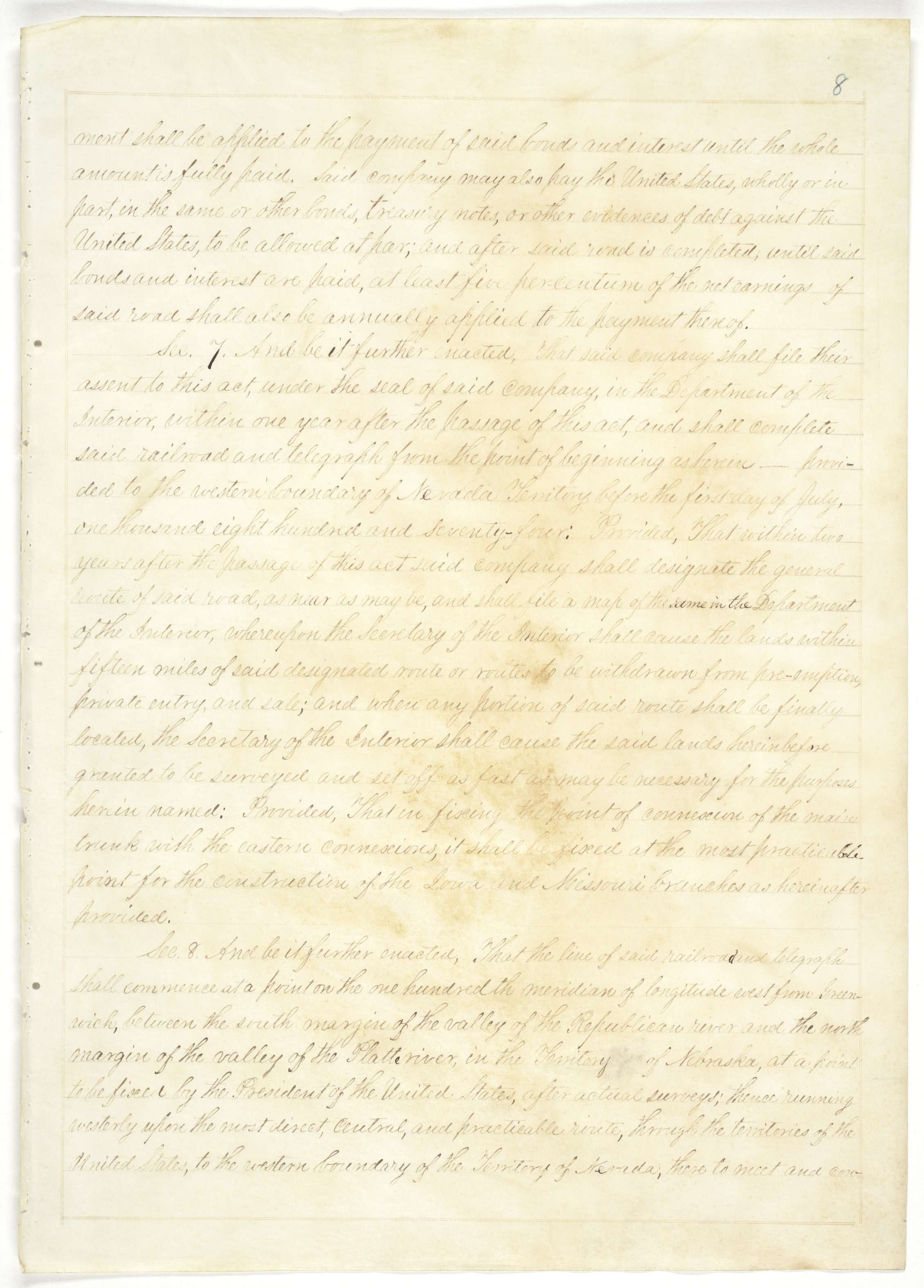
Act of July 1, 1862 (Pacific Railroad Act), 12 STAT 489, which established the construction of a railroad and telegraph line from the Missouri River to the Pacific Ocean.
Page 9
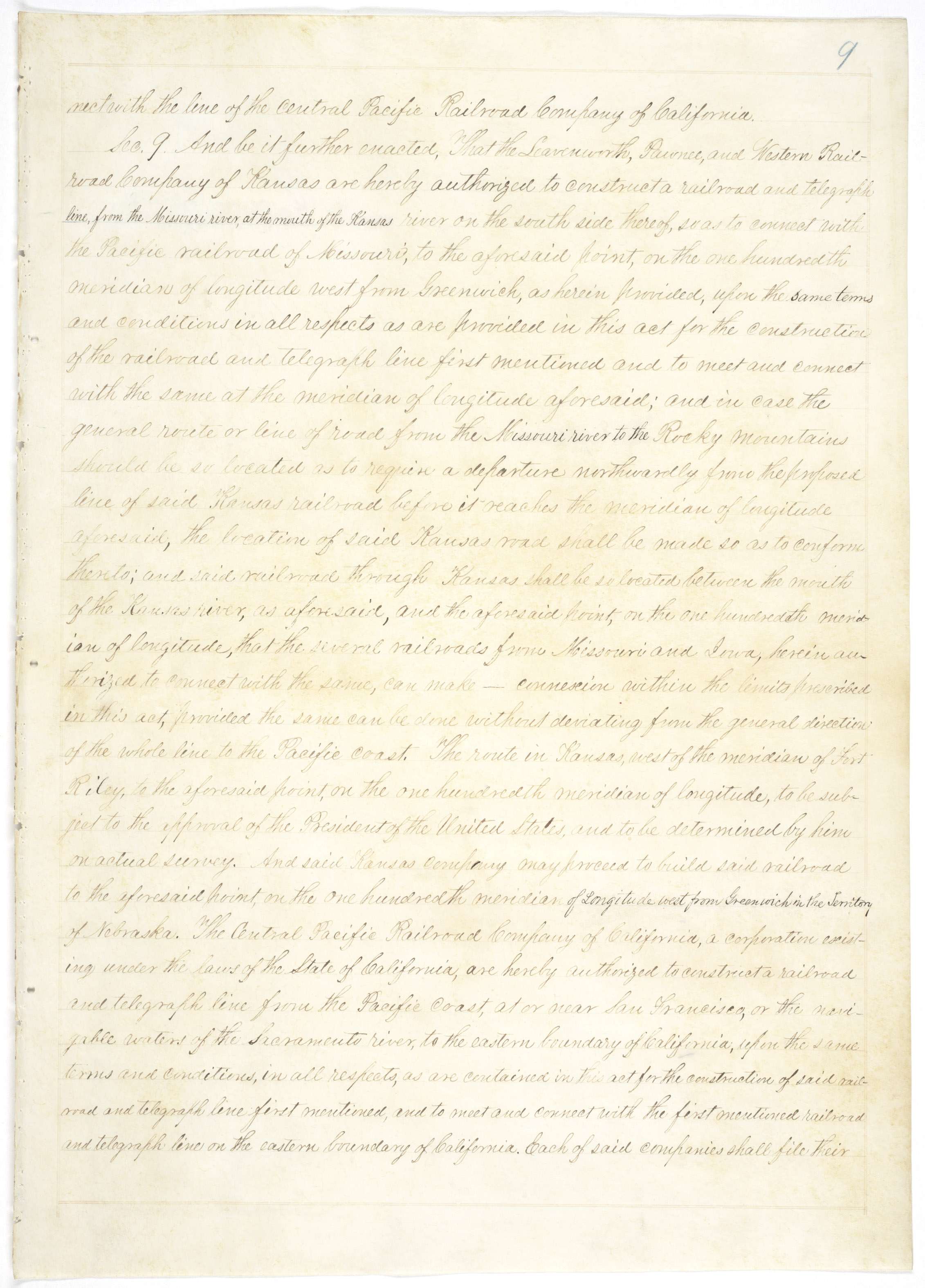
Act of July 1, 1862 (Pacific Railroad Act), 12 STAT 489, which established the construction of a railroad and telegraph line from the Missouri River to the Pacific Ocean.
Page 10
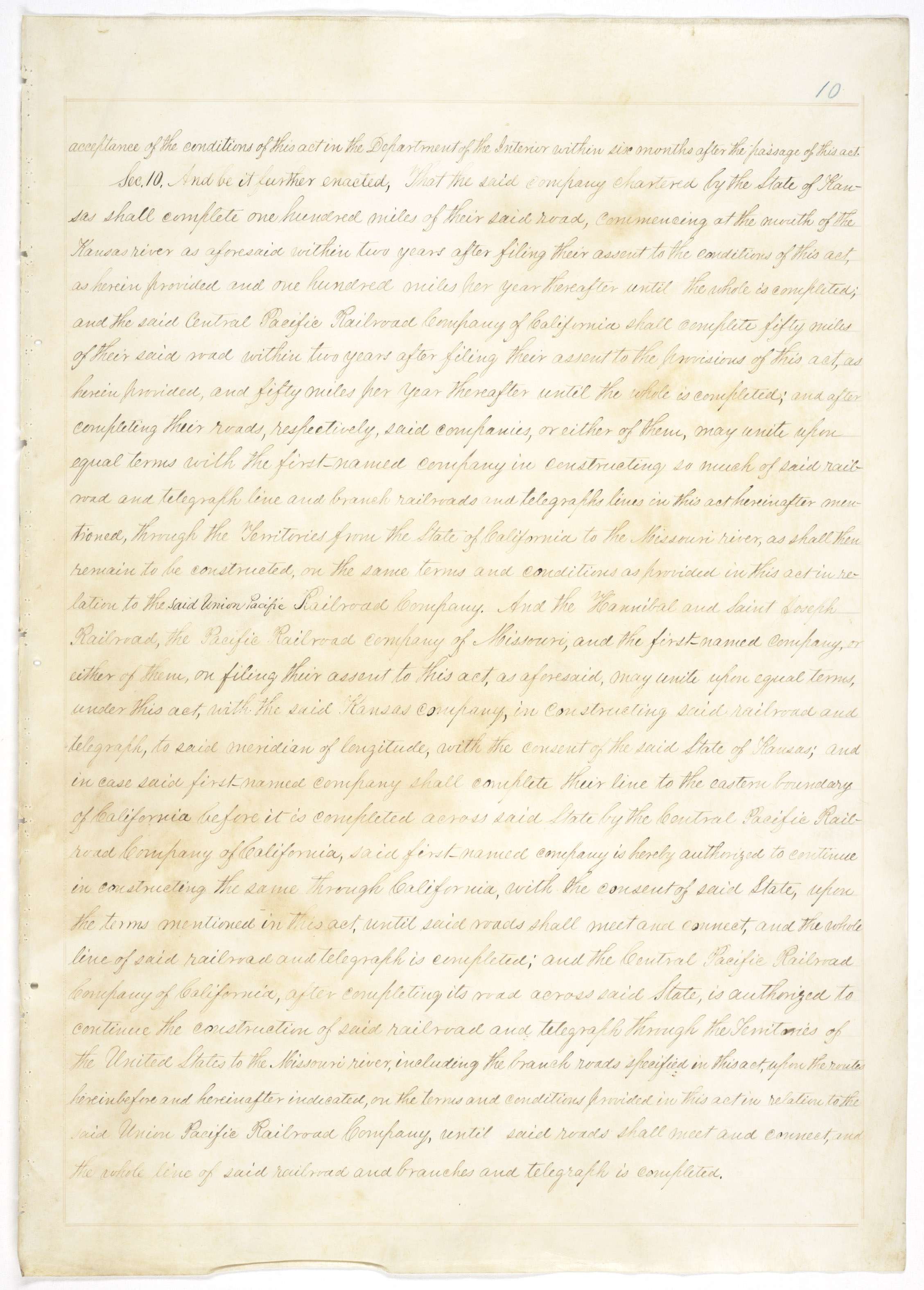
Act of July 1, 1862 (Pacific Railroad Act), 12 STAT 489, which established the construction of a railroad and telegraph line from the Missouri River to the Pacific Ocean.
Page 11
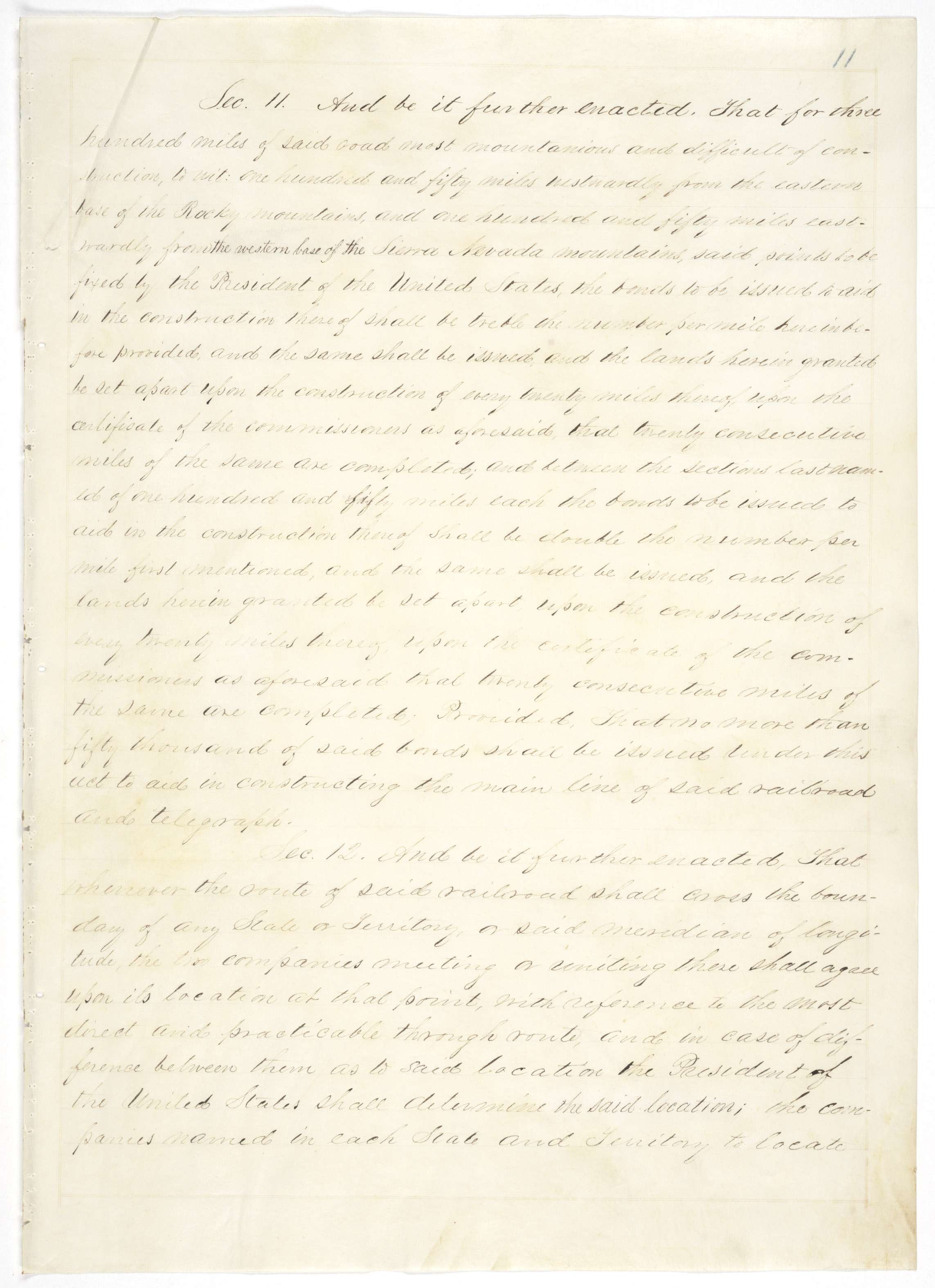
Act of July 1, 1862 (Pacific Railroad Act), 12 STAT 489, which established the construction of a railroad and telegraph line from the Missouri River to the Pacific Ocean.
Page 12
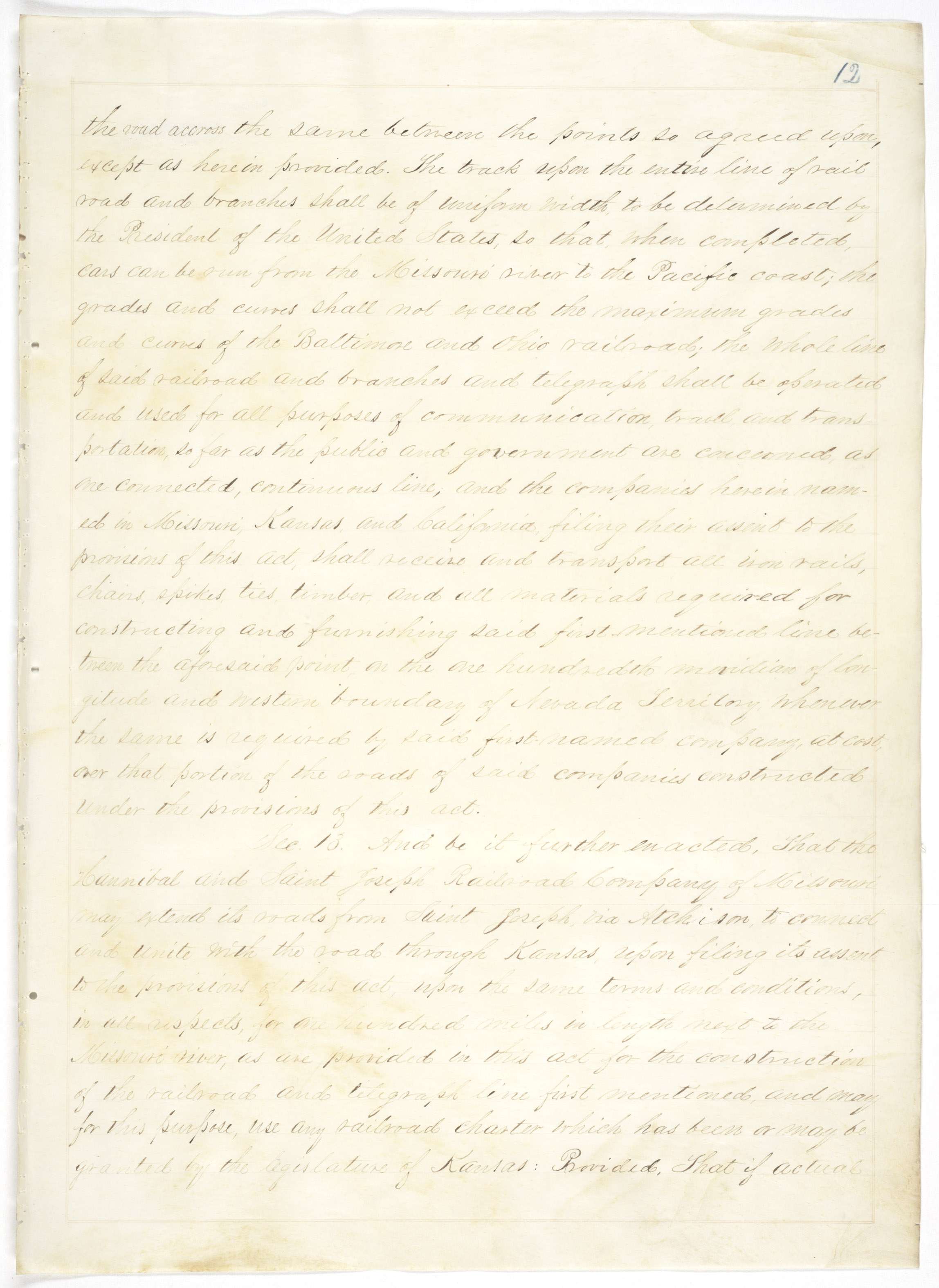
Act of July 1, 1862 (Pacific Railroad Act), 12 STAT 489, which established the construction of a railroad and telegraph line from the Missouri River to the Pacific Ocean.
Page 13
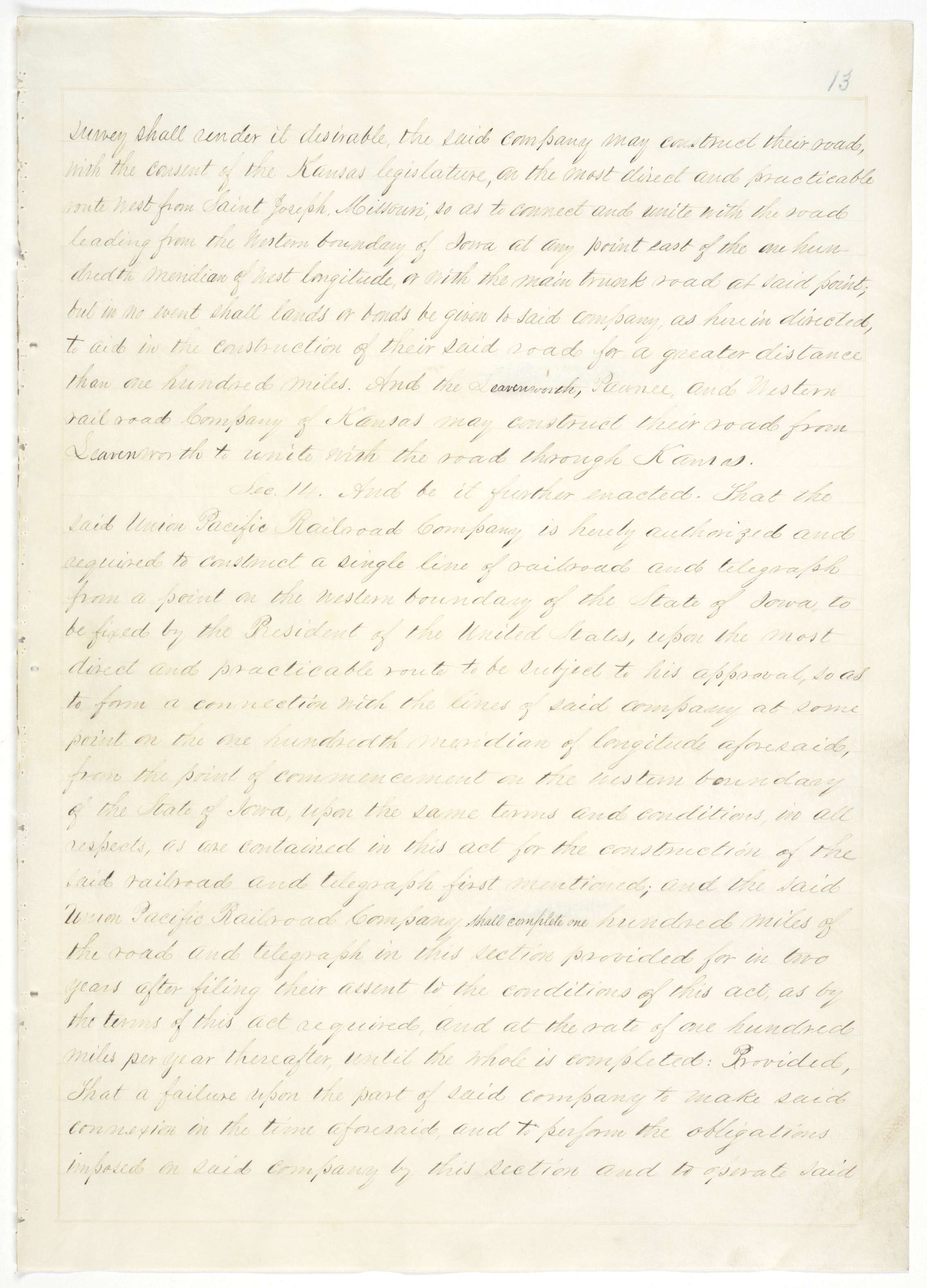
Act of July 1, 1862 (Pacific Railroad Act), 12 STAT 489, which established the construction of a railroad and telegraph line from the Missouri River to the Pacific Ocean.
Page 14
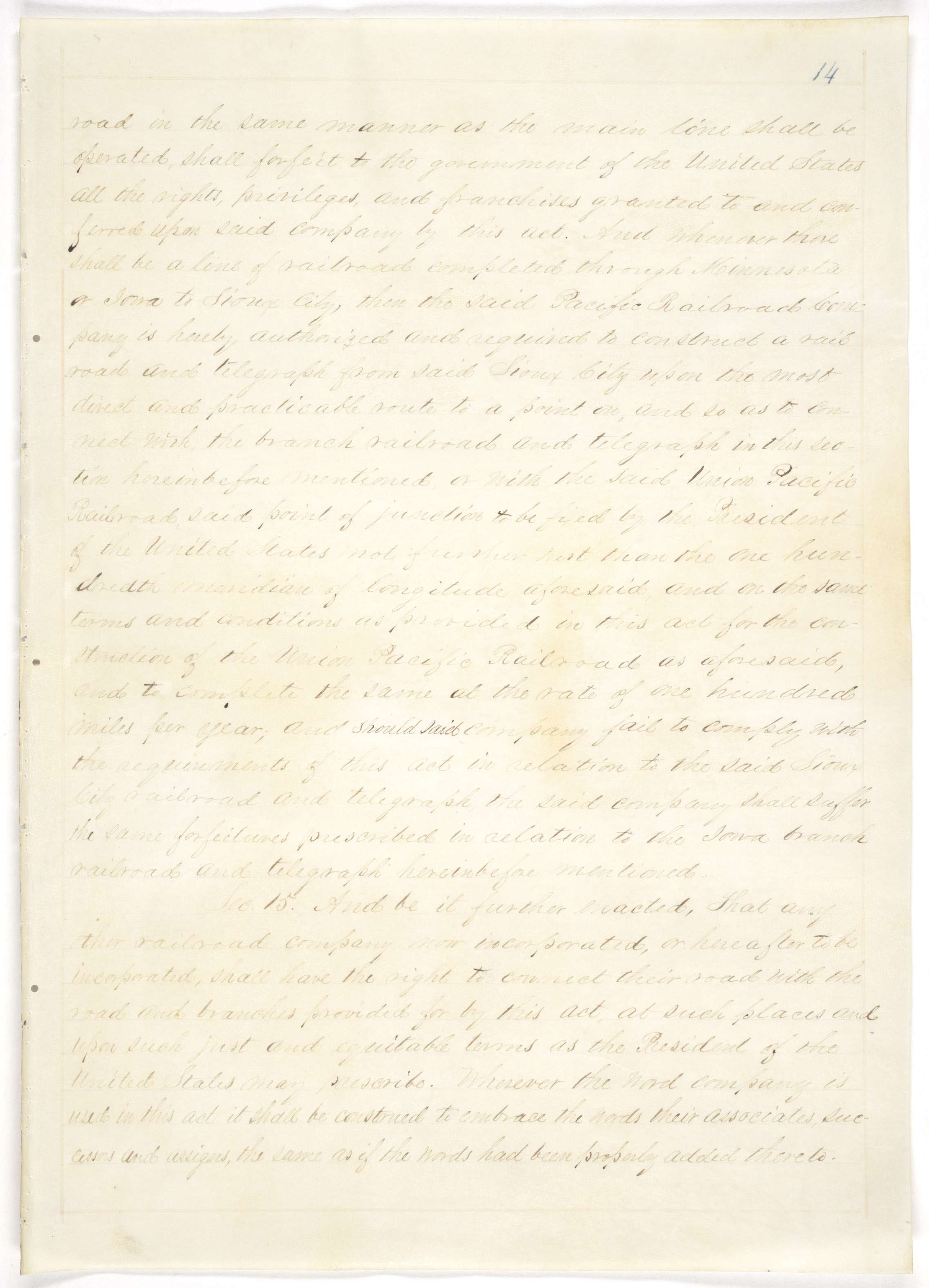
Act of July 1, 1862 (Pacific Railroad Act), 12 STAT 489, which established the construction of a railroad and telegraph line from the Missouri River to the Pacific Ocean.
Page 15
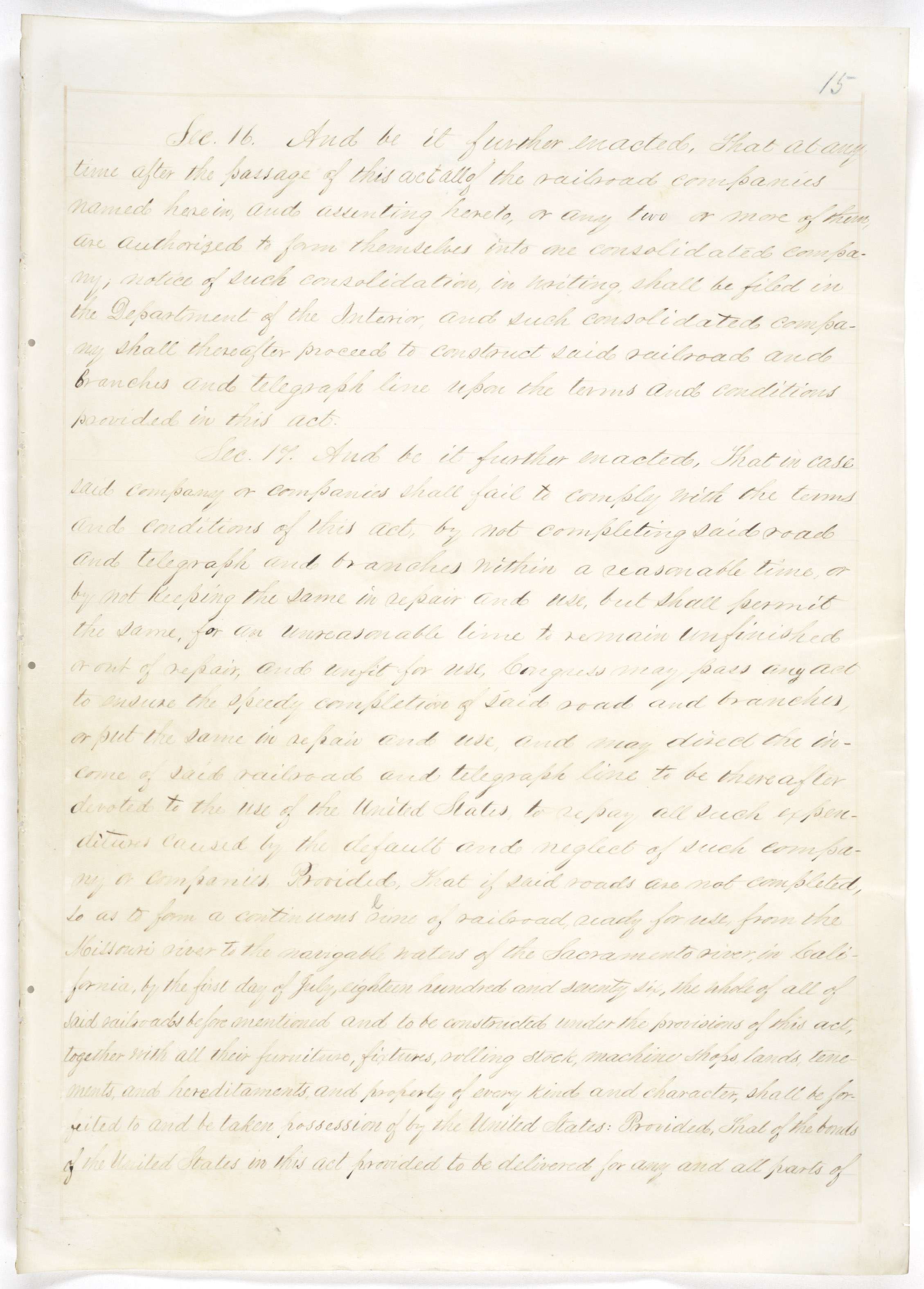
Act of July 1, 1862 (Pacific Railroad Act), 12 STAT 489, which established the construction of a railroad and telegraph line from the Missouri River to the Pacific Ocean.
Page 16
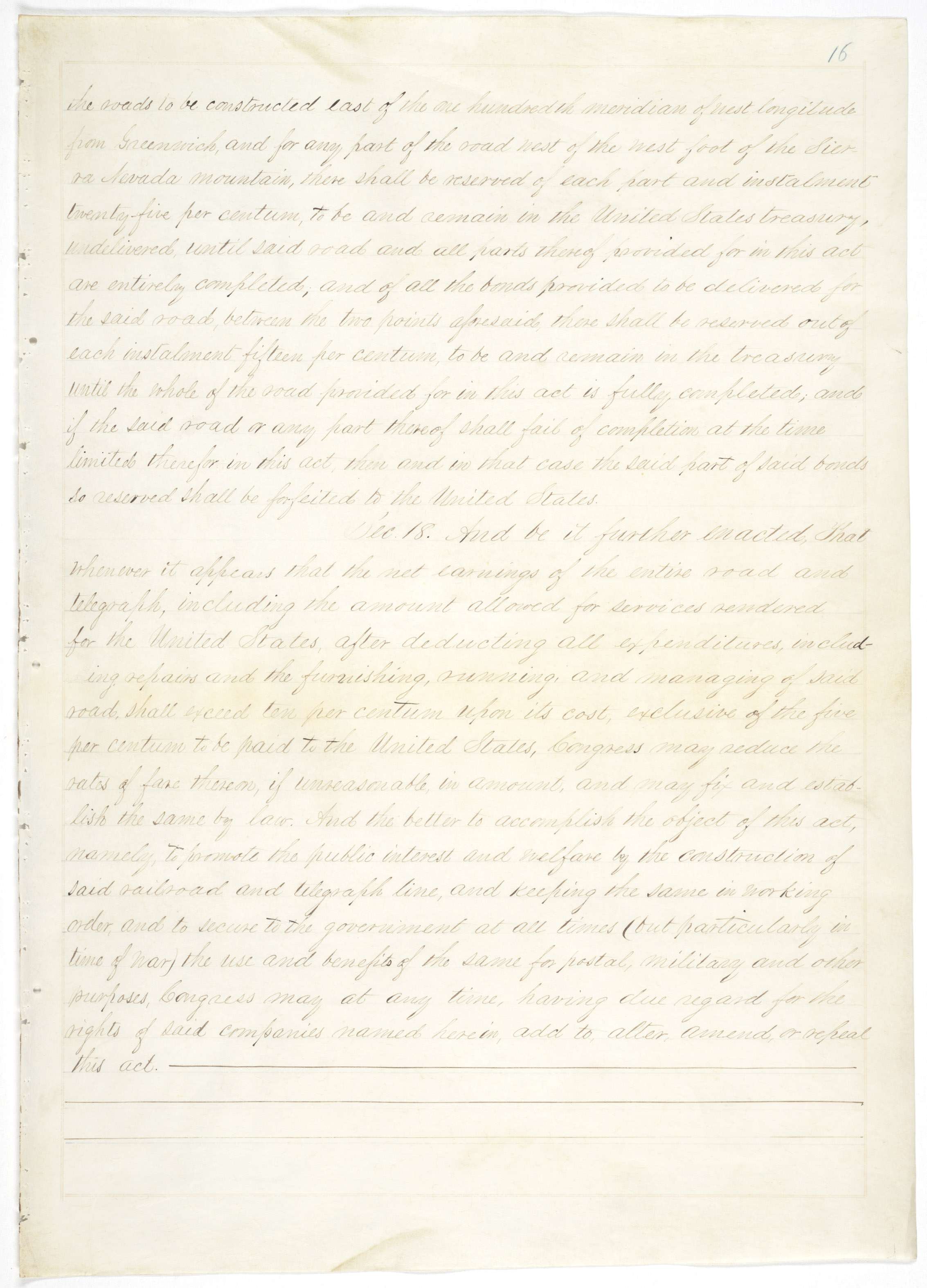
Act of July 1, 1862 (Pacific Railroad Act), 12 STAT 489, which established the construction of a railroad and telegraph line from the Missouri River to the Pacific Ocean.
Page 17
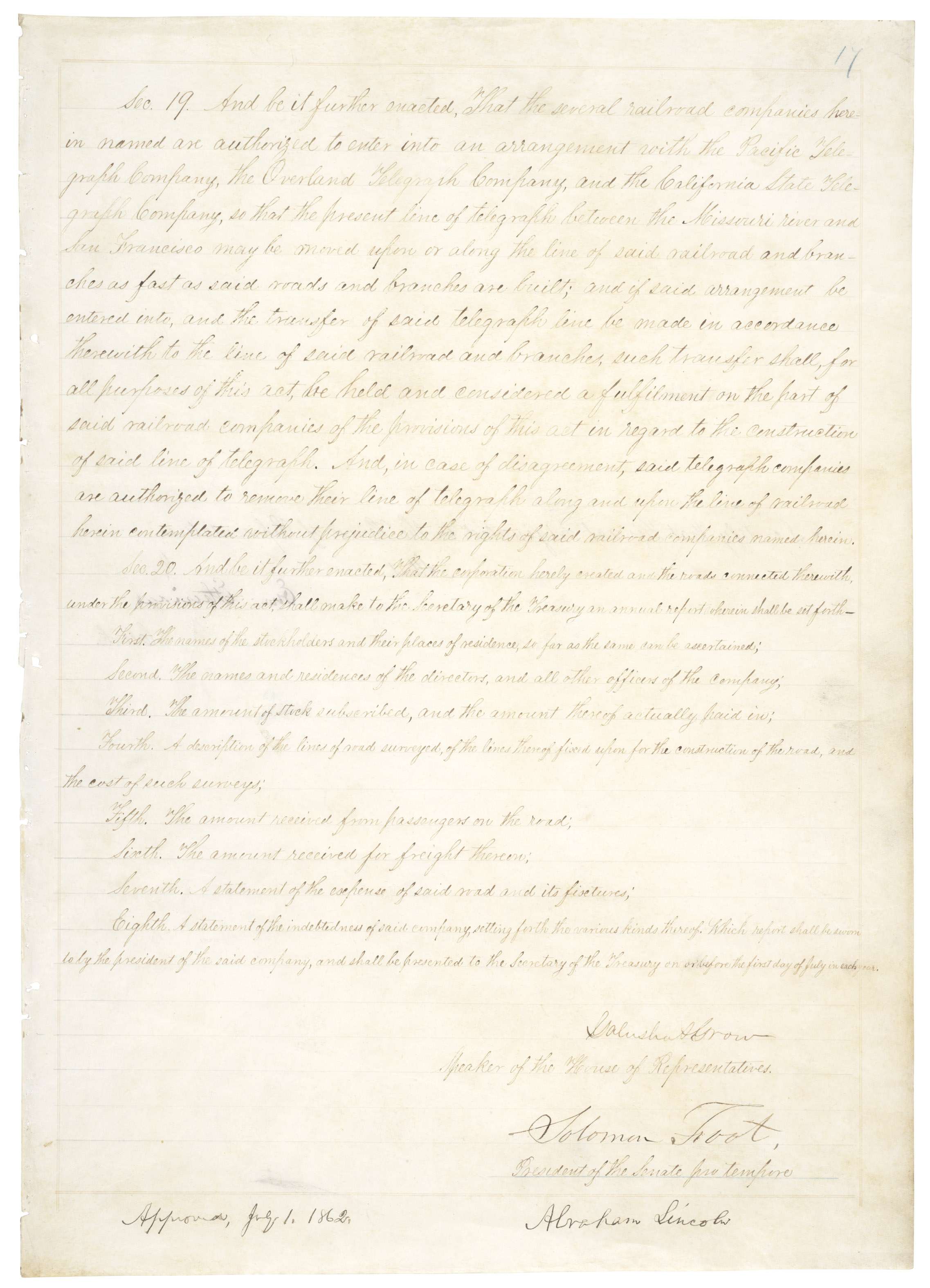
Document
Act of July 2, 1862 (Morrill Act), Public Law 37-108, 12 STAT 503, which established land grant colleges.
7/2/1862
Sponsored by Senator Justin Morrill of Vermont, the "Act Donating public lands to the several States and [Territories] which may provide colleges for the benefit of agriculture and the Mechanic arts" marked the first federal aid to higher education. But the government’s recognition of its obligation to provide schools for its future citizens dates from the beginning of the republic. In the Northwest Ordinance of 1787, the Continental Congress wrote, "Knowledge, being necessary to good government and the happiness of mankind, schools and the means of education shall forever be encouraged." With this ordinance, Congress established a precedent for the support of public education that would grow to substantial commitments in later years.
Land was the key to the federal government’s early involvement. Much of this land had been, and would continue to be, taken from Native American tribes. It was ceded through treaties, agreements, and seizure. Often tribes were effectively forced to sign treaties ceding land because of their living conditions or threat of violence. In many cases, the federal government did not uphold its end of these treaties.
These now "public lands" were surveyed into six-mile square townships, and a one-square-mile section in each township was reserved for the support of public schools. The land itself was rarely used for school construction but rather was sold off, with proceeds used to fund the school program. The system invited misuse by opportunists, and substantial portions of the educational land-grants never benefited education. Nevertheless, land-grant support became a substantial factor in providing education to most American children who could never hope to attend private or charity-supported schools.
The Morrill Act committed the federal government to grant each state 30,000 acres of public land issued in the form of "land scrip" certificates for each of its representatives and senators in Congress. Although many states squandered the revenue from this endowment, which grew to an allocation of over 100 million acres, the Morrill land grants laid the foundation for a national system of state colleges and universities. In some cases, the land sales financed existing institutions; in others, new schools were chartered by the states. Major universities such as Nebraska, Washington State, Clemson, and Cornell were chartered as land-grant schools.
People of color were often excluded from these educational opportunities due to their race. The Second Morrill Act of 1890 was aimed at the former Confederate states and sought to rectify this discrimination. It required states to establish separate land-grant institutions for Black students or demonstrate that admission was not restricted by race. The act granted money instead of land and resulted in the establishment of several historically Black universities and colleges, including Alabama A&M, Prairie View A&M University, and Tuskegee University.
Transcript
AN ACT Donating Public Lands to the several States and Territories which may provide Colleges for the Benefit of Agriculture and Mechanic Arts.Be it enacted by the Senate and House of Representatives of the United States of America in Congress assembled, That there be granted to the several States, for the purposes hereinafter mentioned, an amount of public land, to be apportioned to each State a quantity equal to thirty thousand acres for each senator and representative in Congress to which the States are respectively entitled by the apportionment under the census of eighteen hundred and sixty: Provided, That no mineral lands shall be selected or purchased under the provisions of this Act.
And be it further enacted, That the land aforesaid, after being surveyed, shall be apportioned to the several States in sections or subdivisions of sections, not less than one quarter of a section; and whenever there are public lands in a State subject to sale at private entry at one dollar and twenty-five cents per acre, the quantity to which said State shall be entitled shall be selected from such lands within the limits of such State, and the Secretary of the Interior is hereby directed to issue to each of the States in which there is not the quantity of public lands subject to sale at private entry at one dollar and twenty-five cents per acre, to which said State may be entitled under the provisions of this act, land scrip to the amount in acres for the deficiency of its distributive share: said scrip to be sold by said States and the proceeds thereof applied to the uses and purposes prescribed in this act, and for no other use or purpose whatsoever: Provided, That in no case shall any State to which land scrip may thus be issued be allowed to locate the same within the limits of any other State, or of any Territory of the United States, but their assignees may thus locate said land scrip upon any of the unappropriated lands of the United States subject to sale at private entry at one dollar and twenty-five cents, or less, per acre: And provided, further, That not more than one million acres shall be located by such assignees in any one of the States: And provided, further, That no such location shall be made before
one year from the passage of this Act.
And be it further enacted, That all the expenses of management, superintendence, and taxes from date of selection of said lands, previous to their sales, and all expenses incurred in the management and disbursement of the moneys which may be received therefrom, shall be paid by the States to which they may belong, out of the Treasury of said States, so that the entire proceeds of the sale of said lands shall be applied without any diminution whatever to the purposes hereinafter mentioned.
And be it further enacted, That all moneys derived from the sale of the lands aforesaid by the States to which the lands are apportioned, and from the sales of land scrip hereinbefore provided for, shall be invested in stocks of the United States, or of the States, or some other safe stocks, yielding not less than five per centum upon the par value of said stocks; and that the moneys so invested shall constitute a perpetual fund, the capital of which shall remain forever undiminished, (except so far as may be provided in section fifth of this act,) and the interest of which shall be inviolably appropriated, by each State which may take and claim the benefit of this act, to the endowment, support, and maintenance of at least one college where the leading object shall be, without excluding other scientific and classical studies, and including military tactics, to teach such branches of learning as are related to agriculture and the mechanic arts, in such manner as the legislatures of the States may respectively prescribe, in order to promote the liberal and practical education of the industrial classes in the several pursuits and professions in life.
And be it further enacted, That the grant of land and land scrip hereby authorized shall be made on the following conditions, to which, as well as to the provisions hereinbefore contained, the previous assent of the several States shall be signified by legislative acts:
First. If any portion of the fund invested, as provided by the foregoing section, or any portion of the interest thereon, shall, by any action or contingency, be diminished or lost, it shall be replaced by the State to which it belongs, so that the capital of the fund shall remain forever undiminished; and the annual interest shall be regularly applied without diminution to the purposes mentioned in the fourth section of this act, except that a sum, not exceeding ten per centum upon the amount received by any State under the provisions of this act may be expended for the purchase of lands for sites or experimental farms, whenever
authorized by the respective legislatures of said States.
Second. No portion of said fund, nor the interest thereon, shall be applied, directly or indirectly, under any pretence whatever, to the purchase, erection, preservation, or repair of any building or buildings.
Third. Any State which may take and claim the benefit of the provisions of this act shall provide, within five years from the time of its acceptance as provided in subdivision seven of this section, at least not less than one college, as described in the fourth section of this act, or the grant to such State shall cease; and said State shall be bound to pay the United States the amount received of any lands previously sold; and that the title to purchasers under the State shall be valid.
Fourth. An annual report shall be made regarding the progress of each college, recording any improvements and experiments made, with their cost and results, and such other matters, including State industrial and economical statistics, as may be supposed useful; one copy of which shall be transmitted by mail [free] by each, to all the other colleges which may be endowed under the provisions of this act, and also one copy to the Secretary of the Interior.
Fifth. When lands shall be selected from those which have been raised to double the minimum price, in consequence of railroad grants, they shall be computed to the States at the maximum price, and the number of acres proportionally diminished.
Sixth. No State while in a condition of rebellion or insurrection against the government of the United States shall be entitled to the benefit of this act.
Seventh. No State shall be entitled to the benefits of this act unless it shall express its acceptance thereof by its legislature within three years from July 23, 1866:
Provided, That when any Territory shall become a State and be admitted into the Union, such new State shall shall be entitled to the benefits of the said act of July two, eighteen hundred and sixty-two, by expressing the acceptance therein required within three years from the date of its admission into the Union, and providing the college or colleges within five years after such acceptance, as prescribed in this act.
And be it further enacted, That land scrip issued under the provisions of this act shall not be subject to location until after the first day of January, one thousand eight hundred and sixty-three.
And be it further enacted, That the land officers shall receive the same fees for locating land scrip issued under the provisions of this act as is now allowed for the location of military bounty land warrants under existing laws: Provided, their maximum compensation shall not be thereby increased.
And be it further enacted, That the Governors of the several States to which scrip shall be issued under this act shall be required to report annually to Congress all sales made of such scrip until the whole shall be disposed of, the amount received for the same, and what appropriation has been made of the proceeds.
Approved July 2, 1862
Act of July 2, 1862 (Morrill Act), Public Law 37-108, 12 STAT 503, which established land grant colleges.
Page 1
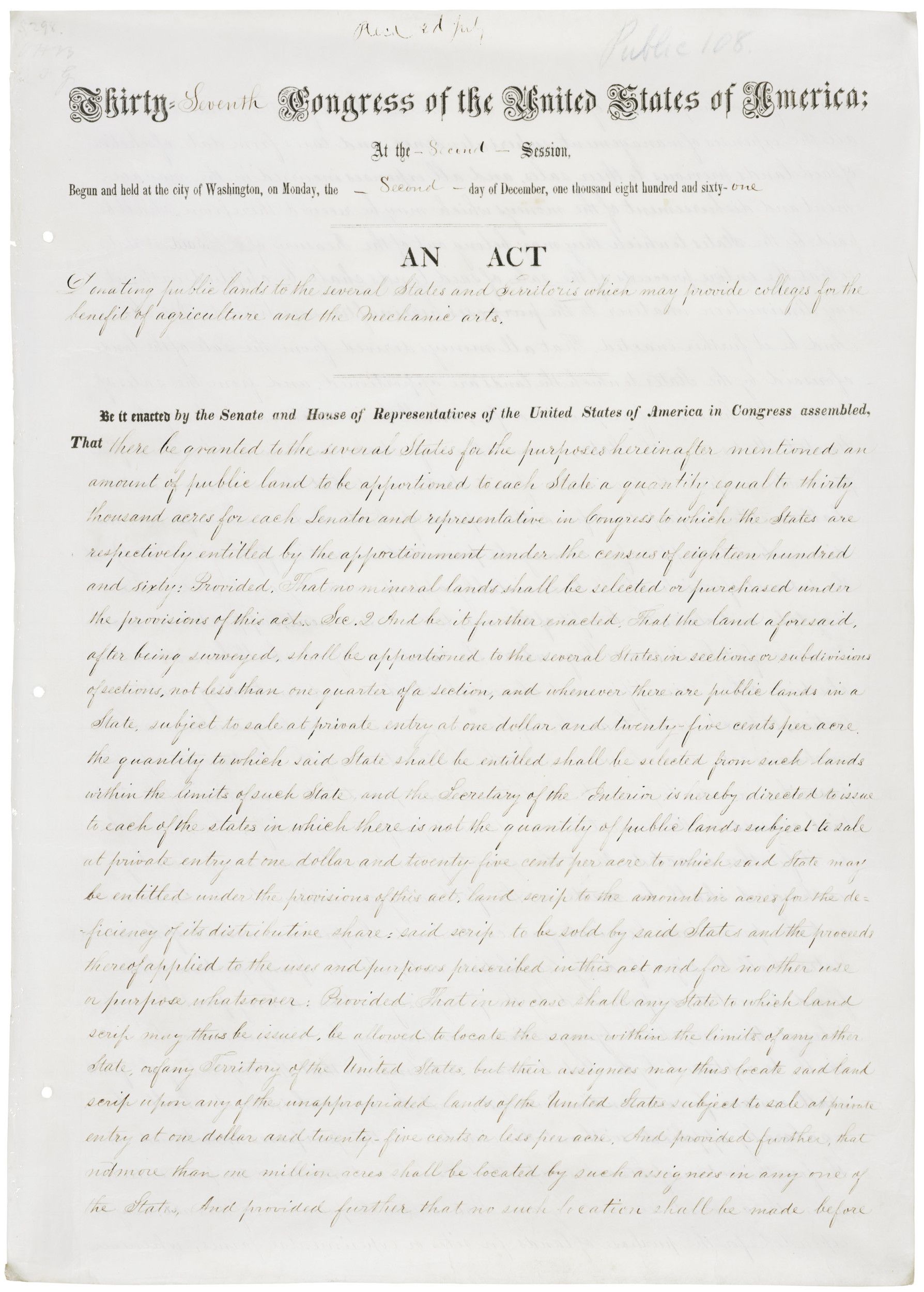
Act of July 2, 1862 (Morrill Act), Public Law 37-108, 12 STAT 503, which established land grant colleges.
Page 2
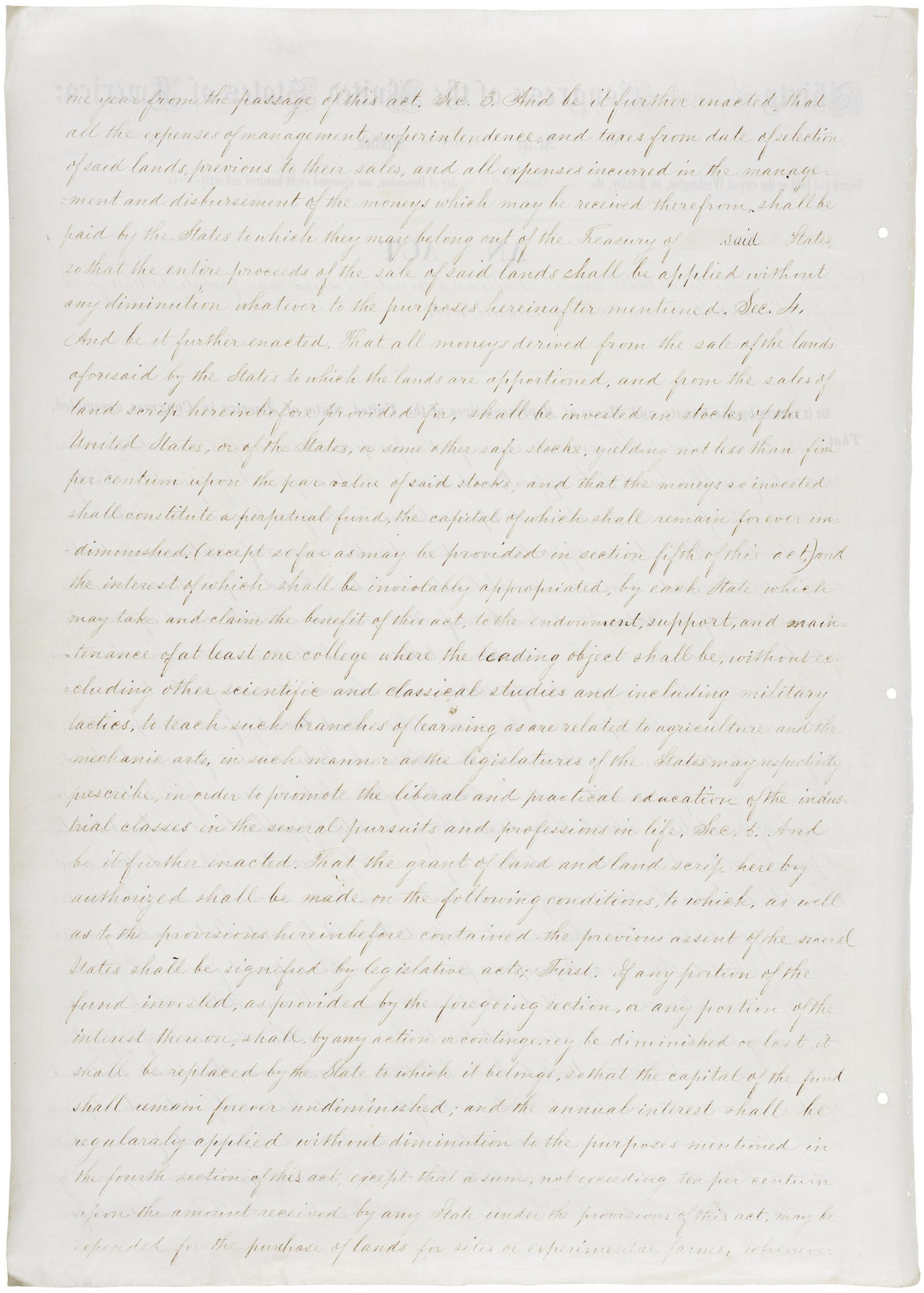
Act of July 2, 1862 (Morrill Act), Public Law 37-108, 12 STAT 503, which established land grant colleges.
Page 3
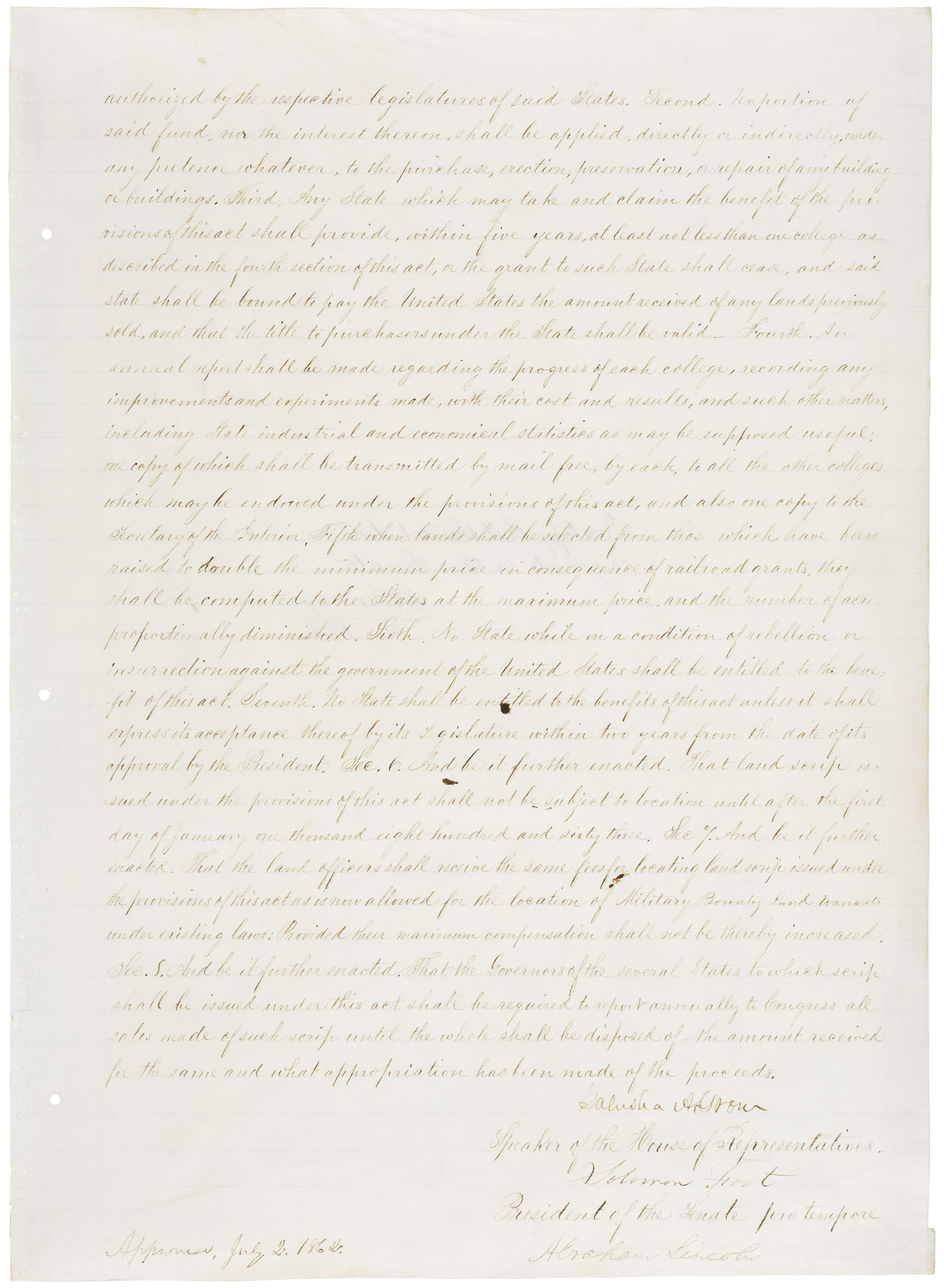
Document
Fort Laramie Treaty
4/29/1868
In the 19th century, the U.S. Government's drive for expansion clashed violently with Native Americans' resolve to preserve their lands, sovereignty, and ways of life. This struggle over land has defined the relationship between the U.S. Government and Native tribes.
From the 1860s through the 1870s, warfare and skirmishes broke out frequently on the American frontier. In 1865, a congressional committee studied the uprisings and wars in the American West. They produced a "Report on the Condition of the Indian Tribes" in 1867. This led to an act to establish an Indian Peace Commission to end the wars and prevent future conflicts.
The U.S. Government set out to establish a series of treaties with Native tribes that would force American Indians to give up their lands and move further west onto reservations. In the spring of 1868, a conference was held at Fort Laramie, in present-day Wyoming. Under the Indian Peace Commission, General William T. Sherman and his staff negotiated a peace treaty with the Sioux (Brule, Oglala, Miniconjou, Yanktonai, Hunkpapa, Blackfeet, Cuthead, Two Kettle, Sans Arcs, and Santee) and the Arapaho. At least one representative of each individual tribe signed the treaty at Fort Laramie, Wyoming.
The goal of the treaty was to bring peace between White settlers and the tribes, who agreed to relocate to the Black Hills in the Dakota Territory. All the tribes involved gave up many thousands of acres of land that had been promised in earlier treaties, but retained hunting and fishing rights in their older territory. They also agreed not to attack railroads or settlers.
In exchange, the U.S. Government established the Great Sioux Reservation, consisting of a large portion of the western half of what is now the state of South Dakota, including the Black Hills, which are sacred to the Sioux people.
Though the reservation land was set aside for exclusive use by the Sioux people, in 1874, General George A. Custer led an expedition into the Black Hills accompanied by miners who were seeking gold. Once gold was found in the Black Hills, miners were soon moving onto the Sioux hunting grounds and demanding protection from the U.S. Army. Soon, the Army was ordered to move against wandering bands of Sioux hunting on the range in accordance with their treaty rights.
In 1876, Custer, leading an Army detachment, encountered an encampment of Sioux and Cheyenne at the Little Bighorn River. Custer's detachment was annihilated, but the United States would continue its battle against the Sioux Tribe in the Black Hills until the government confiscated the land in 1877. To this day, ownership of the Black Hills remains the subject of a legal dispute between the U.S. Government and the Sioux Nation.
Treaties between the United States and American Indian tribes date back to the country's beginning. After the Revolutionary War, the United States had continued the European practice of negotiating treaties with the Native Peoples similarly to how they negotiated with foreign governments. This practice changed gradually over time.
In 1831, the Supreme Court case Cherokee Nation v. Georgia changed the status of Native tribes from "independent, sovereign nations" to "domestic dependent nations." Treaties, however, still followed the pattern of requiring negotiations between the U.S. government and tribal governments and ratification by Congress. Not all negotiated treaties were ratified.
In 1871, Congress passed the Indian Appropriations Act, which suspended all further treaties with Native governments. After that time, all changes or additions to Native lands or status were conducted by Executive Order, Acts of Congress, and decisions of the Federal Courts. To this day federally recognized American Indian tribes and Alaska Natives retain the right of self-government and usually hold a legal position directly under the federal government.
Transcript
ARTICLES OF A TREATY MADE AND CONCLUDED BY AND BETWEENLieutenant General William T. Sherman, General William S. Harney, General Alfred H. Terry, General O. O. Augur, J. B. Henderson, Nathaniel G. Taylor, John G. Sanborn, and Samuel F. Tappan, duly appointed commissioners on the part of the United States, and the different bands of the Sioux Nation of Indians, by their chiefs and headmen, whose names are hereto subscribed, they being duly authorized to act in the premises.
ARTICLE I.
From this day forward all war between the parties to this agreement shall for ever cease. The government of the United States desires peace, and its honor is hereby pledged to keep it. The Indians desire peace, and they now pledge their honor to maintain it.
If bad men among the whites, or among other people subject to the authority of the United States, shall commit any wrong upon the person or property of the Indians, the United States will, upon proof made to the agent, and forwarded to the Commissioner of Indian Affairs at Washington city, proceed at once to cause the offender to be arrested and punished according to the laws of the United States, and also reimburse the injured person for the loss sustained.
If bad men among the Indians shall commit a wrong or depredation upon the person or property of nay one, white, black, or Indian, subject to the authority of the United States, and at peace therewith, the Indians herein named solemnly agree that they
will, upon proof made to their agent, and notice by him, deliver up the wrongdoer to the United States, to be tried and punished according to its laws, and, in case they willfully refuse so to do, the person injured shall be reimbursed for his loss from the annuities, or other moneys due or to become due to them under this or other treaties made with the United States; and the President, on advising with the Commissioner of Indian Affairs, shall prescribe such rules and regulations for ascertaining damages under the provisions of this article as in his judgment may be proper, but no one sustaining loss while violating the provisions of this treaty, or the laws of the United States, shall be reimbursed therefor.
ARTICLE II.
The United States agrees that the following district of country, to wit, viz: commencing on the east bank of the Missouri river where the 46th parallel of north latitude crosses the same, thence along low-water mark down said east bank to a point opposite where the northern line of the State of Nebraska strikes the river, thence west across said river, and along the northern line of Nebraska to the 104th degree of longitude west from Greenwich, thence north on said meridian to a point where the 46th parallel of north latitude intercepts the same, thence due east along said parallel to the place of beginning; and in addition thereto, all existing reservations of the east back of said river, shall be and the same is, set apart for the absolute and undisturbed use and occupation of the Indians herein named,
and for such other friendly tribes or individual Indians as from time to time they may be willing, with the consent of the United States, to admit amongst them; and the United States now solemnly agrees that no persons, except those herein designated and authorized so to do, and except such officers, agents, and employees of the government as may be authorized to enter upon Indian reservations in discharge of duties enjoined by law, shall ever be permitted to pass over, settle upon, or reside in the territory described in this article, or in such territory as may be added to this reservation for the use of said Indians, and henceforth they will and do hereby relinquish all claims or right in and to any portion of the United States or Territories, except such as is embraced within the limits aforesaid, and except as hereinafter provided.
ARTICLE III.
If it should appear from actual survey or other satisfactory examination of said tract of land, that it contains less than 160 acres of tillable land, for each person, who at the time may be authorized to reside on it, under the provisions of this treaty, and a very considerable number of such persons shall be disposed to comence cultivating the soil as farmers, the United States agrees to set apart, for the use of said Indians, as herein provided, such additional quantity of arable land, adjoining to said reservation, or as
near to the same as it can be obtained, as may be required to provide the necessary amount.
ARTICLE IV.
The United States agrees, at its own proper expense, to construct, at some place on the Missouri river, near the centre of said reservation where timber and water may be convenient, the following buildings, to wit, a warehouse, a store-room for the use of the agent in storing goods belonging to the Indians, to cost not less than $2,500; an agency building, for the residence of the agent, to cost not exceeding $3,000; a residence for the physician, to cost not more than $3,000; and five other buildings, for a carpenter, farmer, blacksmith, miller, and engineer-each to cost not exceeding $2,000; also, a school-house, or mission building, so soon as a sufficient number of children can be induced by the agent to attend school, which shall not cost exceeding $5,000.
The United States agrees further to cause to be erected on said reservation, near the other buildings herein authorized, a good steam circular saw-mill, with a grist-mill and shingle machine attached to the same, to cost not exceeding $8,000.
ARTICLE V.
The United States agrees
that the agent for said Indians shall in the future make his home at the agency building; that he shall reside among them, and keep an office open at all times for the purpose of prompt and diligent inquiry into such matters of complaint by and against the Indians as may be presented for investigation under the provisions of their treaty stipulations, as also for the faithful discharge of other duties enjoined on him by law. In all cases of depredation on person or property he shall cause the evidence to be taken in writing and forwarded, together with his findings, to the Commissioner of Indian Affairs, whose decision, subject to the revision of the Secretary of the Interior, shall be binding on the parties to this treaty.
ARTICLE VI.
If any individual belonging to said tribes of Indians, or legally incorporated with them, being the head of a family, shall desire to commence farming, he shall have the privilege to select, in the presence and with the assistance of the agent then in charge, a tract of land within said reservation, not exceeding three hundred and twenty acres in extent, which tract, when so selected, certified, and recorded in the "Land Book" as herein directed, shall cease to be held in common, but the same may be occupied and held in the exclusive possession of the person selecting it, and of his family, so long as he or they may
continue to cultivate it.
Any person over eighteen years of age, not being the head of a family, may in like manner select and cause to be certified to him or her, for purposes of cultivation, a quantity of land, not exceeding eighty acres in extent, and thereupon be entitled to the exclusive possession of the same as above directed.
For each tract of land so selected a certificate, containing a description thereof and the name of the person selecting it, with a certificate endorsed thereon that the same has been recorded, shall be delivered to the party entitled to it, by the agent, after the same shall have been recorded by him in a book to be kept in his office, subject to inspection, which said book shall be known as the "Sioux Land Book."
The President may, at any time, order a survey of the reservation, and, when so surveyed, Congress shall provide for protecting the rights of said settlers in their improvements, and may fix the character of the title held by each. The United States may pass such laws on the subject of alienation and descent of property between the Indians and their descendants as may be thought proper. And it is further stipulated that any
male Indians over eighteen years of age, of any band or tribe that is or shall hereafter become a party to this treaty, who now is or who shall hereafter become a resident or occupant of any reservation or territory not included in the tract of country designated and described in this treaty for the permanent home of the Indians, which is not mineral land, nor reserved by the United States for special purposes other than Indian occupation, and who shall have made improvements thereon of the value of two hundred dollars or more, and continuously occupied the same as a homestead for the term of three years, shall be entitled to receive from the United States a patent for one hundred and sixty acres of land including his said improvements, the same to be in the form of the legal subdivisions of the surveys of the public lands. Upon application in writing, sustained by the proof of two disinterested witnesses, made to the register of the local land office when the land sought to be entered is within a land district, and when the tract sought to be entered is not in any land district, then
upon said application and proof being made to the Commissioner of the General Land Office, and the right of such Indian or Indians to enter such tract or tracts of land shall accrue and be perfect from the date of his first improvements thereon, and shall continue as long as be continues his residence and improvements and no longer. And any Indian or Indians receiving a patent for land under the foregoing provisions shall thereby and from thenceforth become and be a citizen of the United States and be entitled to all the privileges and immunities of such citizens, and shall, at the same time, retain all his rights to benefits accruing to Indians under this treaty.
ARTICLE VII.
In order to insure the
civilization of the Indians entering into this treaty, the necessity of education is admitted, especially of such of them as are or may be settled on said agricultural reservations, and they, therefore, pledge themselves to compel their children, male and female, between the ages of six and sixteen years, to attend school, and it is hereby made the duty of the agent for said Indians to see that this stipulation is strictly complied with; and the United States agrees that for every thirty children between said ages, who can be induced or compelled to attend school, a house shall be provided, and a teacher competent to teach the elementary branches of an English education shall be furnished, who will reside among said Indians and faithfully discharge his or her duties as a teacher. The provisions of this article to continue for not less than twenty years.
ARTICLE VIII.
When the head of a family or lodge shall have selected lands and received his certificate as above directed, and the agent shall be satisfied that he intends in good faith to commence cultivating the soil for a living, he shall be entitled to receive seeds and agricultural implements for the first year, not exceeding in value one hundred dollars, and for each succeeding year he shall continue to farm,
for a period of three years more, he shall be entitled to receive seeds and implements as aforesaid, not exceeding in value twenty-five dollars. And it is further stipulated that such persons as commence farming shall receive instruction from the farmer herein provided for, and whenever more than one hundred persons shall enter upon the cultivation of the soil, a second blacksmith shall be provided, with such iron, steel, and other material as may be needed.
ARTICLE IX.
At any time after ten years fro the making of this treaty, the United States shall have the privilege of withdrawing the physician, farmer, blacksmith, carpenter, engineer, and miller herein provided for, but in case of such withdrawal, an additional sum thereafter of ten thousand dollars per annum shall be devoted to the education of said Indians, and the Commissioner of Indian Affairs shall, upon careful inquiry into their condition, make such rules and regulations for the expenditure of said sums as will best promote the education and moral improvement of said tribes.
ARTICLE X.
In lieu of all sums of money or other annuities provided to be paid
to the Indians herein named under any treaty or treaties heretofore made, the United States agrees to deliver at the agency house on the reservation herein named, on or before the first day of August of each year, for thirty years, the following articles, to wit:
For each male person over 14 years of age, a suit of good substantial woollen clothing, consisting of coat, pantaloons, flannel shirt, hat, and a pair of home-made socks.
For each female over 12 years of age, a flannel shirt, or the goods necessary to make it, a pair of woollen hose, 12 yards of calico, and 12 yards of cotton domestics.
For the boys and girls under the ages named, such flannel and cotton goods as may be needed to make each a suit as aforesaid, together with a pair of woollen hose for each.
And in order that the Commissioner of Indian Affairs may be able to estimate properly for the articles herein named, it shall be the duty of the agent each year to forward to him a full and exact census of the Indians, on which the estimate from year to year can be based.
And in addition to the clothing herein named, the sum of $10 for each person entitled to the beneficial effects of this treaty shall be annually appropriated for a
period of 30 years, while such persons roam and hunt, and $20 for each person who engages in farming, to be used by the Secretary of the Interior in the purchase of such articles as from time to time the condition and necessities of the Indians may indicate to be proper. And if within the 30 years, at any time, it shall appear that the amount of money needed for clothing, under this article, can be appropriated to better uses for the Indians named herein, Congress may, by law, change the appropriation to other purposes, but in no event shall the amount of the appropriation be withdrawn or discontinued for the period named. And the President shall annually detail an officer of the army to be present and attest the delivery of all the goods herein named, to the Indians, and he shall inspect and report on the quantity and quality of the goods and the manner of their delivery. And it is hereby expressly stipulated that each Indian over the age of four years, who shall have removed to and settled permanently upon said reservation, one pound of meat and one pound of flour per day, provided the Indians cannot furnish their own subsistence at an earlier date. And it is further stipulated that the United States will furnish and deliver to each lodge of Indians or family of persons legally incorporated with the, who shall remove to the reservation herein described and commence farming, one good American cow, and one good well-broken pair of American oxen within 60 days after such lodge or family shall have so settled upon said reservation.
ARTICLE XI.
In consideration of the advantages and benefits conferred by this treaty and the many pledges of friendship by the United States, the tribes who are parties to this agreement hereby stipulate that they will relinquish all right to occupy permanently the territory outside
their reservations as herein defined, but yet reserve the right to hunt on any lands north of North Platte, and on the Republican Fork of the Smoky Hill river, so long as the buffalo may range thereon in such numbers as to justify the chase. And they, the said Indians, further expressly agree:
1st. That they will withdraw all opposition to the construction of the railroads now being built on the plains.
2d. That they will permit the peaceful construction of any railroad not passing over their reservation as herein defined.
3d. That they will not attack any persons at home, or travelling, nor molest or disturb any wagon trains, coaches, mules, or cattle belonging to the people of the United S
tates, or to persons friendly therewith.
4th. They will never capture, or carry off from the settlements, white women or children.
5th. They will never kill or scalp white men, nor attempt to do them harm.
6th. They withdraw all pretence of opposition to the construction of the railroad now being built along the Platte river and westward to the Pacific ocean, and they will not in future object to the construction of railroads, wagon roads, mail stations, or other works of utility or necessity, which may be ordered or permitted by the laws of the United States. But should such roads or other works be constructed on the lands of their reservation, the government will pay the tribe whatever amount of damage may be assessed by three disinterested commissioners to be appointed by the President for that purpose, one of the said commissioners to be a chief or headman of the tribe.
7th. They agree to withdraw all opposition to the military posts or roads now established south of the North Platte river, or that may be established, not in violation of treaties heretofore made or hereafter to be made with any of the Indian tribes.
ARTICLE XII.
No treaty for the cession of any portion or part of the reservation herein described which may be held in common, shall be of any validity or force as against the said Indians unless executed and signed by at least three-fourths of all the adult male Indians occupying or interested in the same, and no cession by the tribe shall be understood or construed in such manner as to deprive, without his consent, any individual member of the tribe of his rights to any tract of land selected by him as provided in Article VI of this treaty.
ARTICLE XIII.
The United States hereby agrees to furnish annually to the Indians the physician, teachers, carpenter, miller, engineer, farmer, and blacksmiths, as herein contemplated, and that such appropriations shall be made from time to time, on the estimate of the Secretary of the Interior, as will be sufficient to employ such persons.
ARTICLE XIV.
It is agreed that the sum of five hundred dollars annually for three years from date shall be expended in presents to the ten persons of said tribe who in the judgment of the agent may grow the most valuable crops for the respective year.
ARTICLE XV.
The Indians herein named agree that when the agency house and other buildings shall be constructed on the reservation named, they will regard said reservation their permanent home, and they will make no permanent settlement elsewhere; but they shall have the right, subject to the conditions and modifications of this treaty, to hunt, as stipulated in Article XI hereof.
ARTICLE XVI.
The United States hereby agrees and stipulates that the country north of the North Platte river and east of the summits of the Big Horn mountains shall be held and considered to be unceded. Indian territory, and also stipulates and agrees that no white person or persons shall be permitted to settle upon or occupy any portion of the same; or without the consent of the Indians, first had and obtained, to pass through the same; and it is further agreed by the United States, that within ninety days after the conclusion of peace with all the bands of the Sioux nation, the military posts now established in the territory in this article named shall be abandoned, and that the road leading to them and by them to the settlements in the Territory of Montana shall be closed.
ARTICLE XVII.
It is hereby expressly understood and agreed by and between the respective parties to this treaty that the execution of this treaty and its ratification by the United States Senate shall have the effect, and shall be construed as abrogating and annulling all treaties and agreements heretofore entered into between the respective parties hereto, so far as such treaties and agreements obligate the United States to furnish and provide money, clothing, or other articles of property to such Indians and bands of Indians as become parties to this treaty, but no further.
In testimony of all which, we, the said commissioners, and we, the chiefs and headmen of the Brule band of the Sioux nation, have hereunto set our hands and seals at Fort Laramie, Dakota Territory, this twenty-ninth day of April, in the year one thousand eight hundred and sixty-eight.
N. G. TAYLOR,
W. T. SHERMAN,
Lieutenant General
WM. S. HARNEY,
Brevet Major General U.S.A.
JOHN B. SANBORN,
S. F. TAPPAN,
C. C. AUGUR,
Brevet Major General
ALFRED H. TERRY,
Brevet Major General U.S.A.
Attest:
A. S. H. WHITE, Secretary.
Executed on the part of the Brule band of Sioux by the chiefs and headman whose names are hereto annexed, they being thereunto duly authorized, at Fort Laramie, D. T., the twenty-ninth day of April, in the year A. D. 1868.
MA-ZA-PON-KASKA, his X mark, Iron Shell.
WAH-PAT-SHAH, his X mark, Red Leaf.
HAH-SAH-PAH, his X mark, Black Horn.
ZIN-TAH-GAH-LAT-WAH, his X mark, Spotted Tail.
ZIN-TAH-GKAH, his X mark, White Tail.
ME-WAH-TAH-NE-HO-SKAH, his X mark, Tall Man.
SHE-CHA-CHAT-KAH, his X mark, Bad Left Hand.
NO-MAH-NO-PAH, his X mark, Two and Two.
TAH-TONKA-SKAH, his X mark, White Bull.
CON-RA-WASHTA, his X mark, Pretty Coon.
HA-CAH-CAH-SHE-CHAH, his X mark, Bad Elk.
WA-HA-KA-ZAH-ISH-TAH, his X mark, Eye Lance.
MA-TO-HA-KE-TAH, his X mark, Bear that looks behind.
BELLA-TONKA-TONKA, his X mark, Big Partisan.
MAH-TO-HO-HONKA, his X mark, Swift Bear.
TO-WIS-NE, his X mark, Cold Place.
ISH-TAH-SKAH, his X mark, White Eye.
MA-TA-LOO-ZAH, his X mark, Fast Bear.
AS-HAH-HAH-NAH-SHE, his X mark, Standing Elk.
CAN-TE-TE-KI-YA, his X mark, The Brave Heart.
SHUNKA-SHATON, his X mark, Day Hawk.
TATANKA-WAKON, his X mark, Sacred Bull.
MAPIA SHATON, his X mark, Hawk Cloud.
MA-SHA-A-OW, his X mark, Stands and Comes.
SHON-KA-TON-KA, his X mark, Big Dog.
Attest:
ASHTON S. H. WHITE, Secretary of Commission.
GEORGE B. WITHS, Phonographer to Commission.
GEO. H. HOLTZMAN.
JOHN D. HOWLAND.
JAMES C. O'CONNOR.
CHAR. E. GUERN, Interpreter.
LEON T. PALLARDY, Interpreter.
NICHOLAS JANIS, Interpreter.
Executed on the part of the Ogallalla band of Sioux by the chiefs and headmen whose names are hereto subscribed, they being thereunto duly authorized, at Fort Laramie, the 25th day of May, in the year A. D. 1868.
TAH-SHUN-KA-CO-QUI-PAH, his mark, Man-afraid-of-his-horses.
SHA-TON-SKAH, his X mark, White Hawk.
SHA-TON-SAPAH, his X mark, Black Hawk.
EGA-MON-TON-KA-SAPAH, his X mark, Black Tiger
OH-WAH-SHE-CHA, his X mark, Bad Wound.
PAH-GEE, his X mark, Grass.
WAH-NON SAH-CHE-GEH, his X mark, Ghost Heart.
COMECH, his X mark, Crow.
OH-HE-TE-KAH, his X mark, The Brave.
TAH-TON-KAH-HE-YO-TA-KAH, his X mark, Sitting Bull.
SHON-KA-OH-WAH-MEN-YE, his X mark, Whirlwind Dog.
HA-KAH-KAH-TAH-MIECH, his X mark, Poor Elk.
WAM-BU-LEE-WAH-KON, his X mark, Medicine Eagle.
CHON-GAH-MA-HE-TO-HANS-KA, his X mark, High Wolf.
WAH-SECHUN-TA-SHUN-KAH, his X mark, American Horse.
MAH-KAH-MAH-HA-MAK-NEAR, his X mark, Man that walks under the ground.
MAH-TO-TOW-PAH, his X mark, Four Bears.
MA-TO-WEE-SHA-KTA, his X mark, One that kills the bear.
OH-TAH-KEE-TOKA-WEE-CHAKTA, his X mark, One that kills in a hard place.
TAH-TON-KAH-TA-MIECH, his X mark, The Poor Bull.
OH-HUNS-EE-GA-NON-SKEN, his X mark, Mad Shade.
SHAH-TON-OH-NAH-OM-MINNE-NE-OH-MINNE, his X mark, Whirling hawk.
MAH-TO-CHUN-KA-OH, his X mark, Bear's Back.
CHE-TON-WEE-KOH, his X mark, Fool Hawk.
WAH-HOH-KE-ZA-AH-HAH, his X mark,
EH-TON-KAH, his X mark, Big Mouth.
MA-PAH-CHE-TAH, his X mark, Bad Hand.
WAH-KE-YUN-SHAH, his X mark, Red Thunder.
WAK-SAH, his X mark, One that Cuts Off.
CHAH-NOM-QUI-YAH, his X mark, One that Presents the Pipe.
WAH-KE-KE-YAN-PUH-TAH, his X mark, Fire Thunder.
MAH-TO-NONK-PAH-ZE, his X mark, Bear with Yellow Ears.
CON-REE-TEH-KA, his X mark, The Little Crow.
HE-HUP-PAH-TOH, his X mark, The Blue War Club.
SHON-KEE-TOH, his X mark, The Blue Horse.
WAM-BALLA-OH-CONQUO, his X mark, Quick Eagle.
TA-TONKA-SUPPA, his X mark, Black Bull.
MOH-TOH-HA-SHE-NA, his X mark, The Bear Hide.
Attest:
S. E. WARD.
JAS. C. O'CONNOR.
J. M. SHERWOOD.
W. C. SLICER.
SAM DEON.
H. M. MATHEWS.
JOSEPH BISS
NICHOLAS JANIS, Interpreter.
LEFROY JOTT, Interpreter.
ANTOINE JANIS, Interpreter.
Executed on the part of the Minneconjou band of Sioux by the chiefs and headmen whose names are hereunto subscribed, they being thereunto duly authorized.
HEH-WON-GE-CHAT, his X mark, One Horn.
OH-PON-AH-TAH-E-MANNE, his X mark, The Elk that Bellows Walking.
HEH-HO-LAH-ZEH-CHA-SKAH, his X mark, Young White Bull.
WAH-CHAH-CHUM-KAH-COH-KEEPAH, his X mark, One that is Afraid of Shield.
HE-HON-NE-SHAKTA, his X mark, The Old Owl.
MOC-PE-A-TOH, his X mark, Blue Cloud.
OH-PONG-GE-LE-SKAH, his X mark, Spotted Elk.
TAH-TONK-KA-HON-KE-SCHUE, his X mark, Slow bull.
SHONK-A-NEE-SHAH-SHAH-ATAH-PE, his X mark, The Dog Chief.
MA-TO-TAH-TA-TONK-KA, his X mark, Bull Bear.
WOM-BEH-LE-TON-KAH, his X mark, The Big Eagle.
MATOH, EH-SCHNE-LAH, his X mark, The Lone Bear.
MA-TOH-OH-HE-TO-KEH, his X mark, The Brave Bear.
EH-CHE-MA-KEH, his X mark, The Runner.
TI-KI-YA, his X mark, The Hard.
HE-MA-ZA, his X mark, Iron Horn.
Attest:
JAS. C O'CONNOR,
WM. D. BROWN,
NICHOLAS JANIS,
ANTOINE JANIS,
Interpreters.
Executed on the part of the Yanctonais band of Sioux by the chiefs and headmen whose names are hereto subscribed, they being thereunto duly authorized:
MAH-TO-NON-PAH, his X mark, Two Bears.
MA-TO-HNA-SKIN-YA, his X mark, Mad Bear.
HE-O-PU-ZA, his X mark, Louzy.
AH-KE-CHE-TAH-CHE-KA-DAN, his X mark, Little Soldier.
MAH-TO-E-TAN-CHAN, his X mark, Chief Bear.
CU-WI-TO-WIA, his X mark, Rotten Stomach.
SKUN-KA-WE-TKO, his X mark, Fool Dog.
ISH-TA-SAP-PAH, his X mark, Black Eye.
IH-TAN-CHAN, his X mark, The Chief.
I-A-WI-CA-KA, his X mark, The One who Tells the Truth.
AH-KE-CHE-TAH, his X mark, The Soldier.
TA-SHI-NA-GI, his X mark, Yellow Robe.
NAH-PE-TON-KA, his X mark, Big Hand.
CHAN-TEE-WE-KTO, his X mark, Fool Heart.
HOH-GAN-SAH-PA, his X mark, Black Catfish.
MAH-TO-WAH-KAN, his X mark, Medicine Bear.
SHUN-KA-KAN-SHA, his X mark, Red Horse.
WAN-RODE, his X mark, The Eagle.
CAN-HPI-SA-PA, his X mark, Black Tomahawk.
WAR-HE-LE-RE, his X mark, Yellow Eagle.
CHA-TON-CHE-CA, his X mark, Small Hawk, or Long Fare.
SHU-GER-MON-E-TOO-HA-SKA, his X mark, Fall Wolf.
MA-TO-U-TAH-KAH, his X mark, Sitting Bear.
HI-HA-CAH-GE-NA-SKENE, his X mark, Mad Elk.
Arapahoes.
LITTLE CHIEF, his X mark.
TALL BEAR, his X mark.
TOP MAN, his X mark.
NEVA, his X mark.
THE WOUNDED BEAR, his X mark.
WHIRLWIND, his X mark.
THE FOX, his X mark.
THE DOG BIG MOUTH, his X mark.
SPOTTED WOLF, his X mark.
SORREL HORSE, his X mark.
BLACK COAL, his X mark.
BIG WOLF, his X mark.
KNOCK-KNEE, his X mark.
BLACK CROW, his X mark.
THE LONE OLD MAN, his X mark.
PAUL, his X mark.
BLACK BULL, his X mark.
BIG TRACK, his X mark.
THE FOOT, his X mark.
BLACK WHITE, his X mark.
YELLOW HAIR, his X mark.
LITTLE SHIELD, his X mark.
BLACK BEAR, his X mark.
WOLF MOCASSIN, his X mark.
BIG ROBE, his X mark.
WOLF CHIEF, his X mark.
Witnesses:
ROBERT P. MCKIBBIN,
Captain 4th Infantry, and Bvt. Lieut. Col. U. S. A.,
Commanding Fort Laramie.
WM. H. POWELL,
Brevet Major, Captain 4th Infantry.
HENRY W. PATTERSON,
Captain 4th Infantry.
THEO E. TRUE,
Second Lieutenant 4th Infantry.
W. G. BULLOCK.
FORT LARAMIE, WYOMING TERRITORY
November 6, 1868.
MAH-PI-AH-LU-TAH, his X mark, Red Cloud.
WA-KI-AH-WE-CHA-SHAH, his X mark, Thunder Man.
MA-ZAH-ZAH-GEH, his X mark, Iron Cane.
WA-UMBLE-WHY-WA-KA-TUYAH, his X mark, High Eagle.
KO-KE-PAH, his X mark, Man Afraid.
WA-KI-AH-WA-KOU-AH, his X mark, Thunder Flying Running.
Witnessess:
W. MCE. DYE,
Brevet Colonel U. S. Army,
Commanding.
A. B. CAIN,
Captain 4th Infantry, Brevet Major U. S. Army.
ROBT. P. MCKIBBIN,
Captain 4th Infantry, Bvt. Lieut. Col. U. S. Army.
JNO. MILLER,
Captain 4th Infantry.
G. L. LUHN,
First Lieutenant 4th Infantry, Bvt. Capt. U. S. Army.
H. C. SLOAN,
Second Lieutenant 4th Infantry.
Fort Laramie Treaty
Page 1
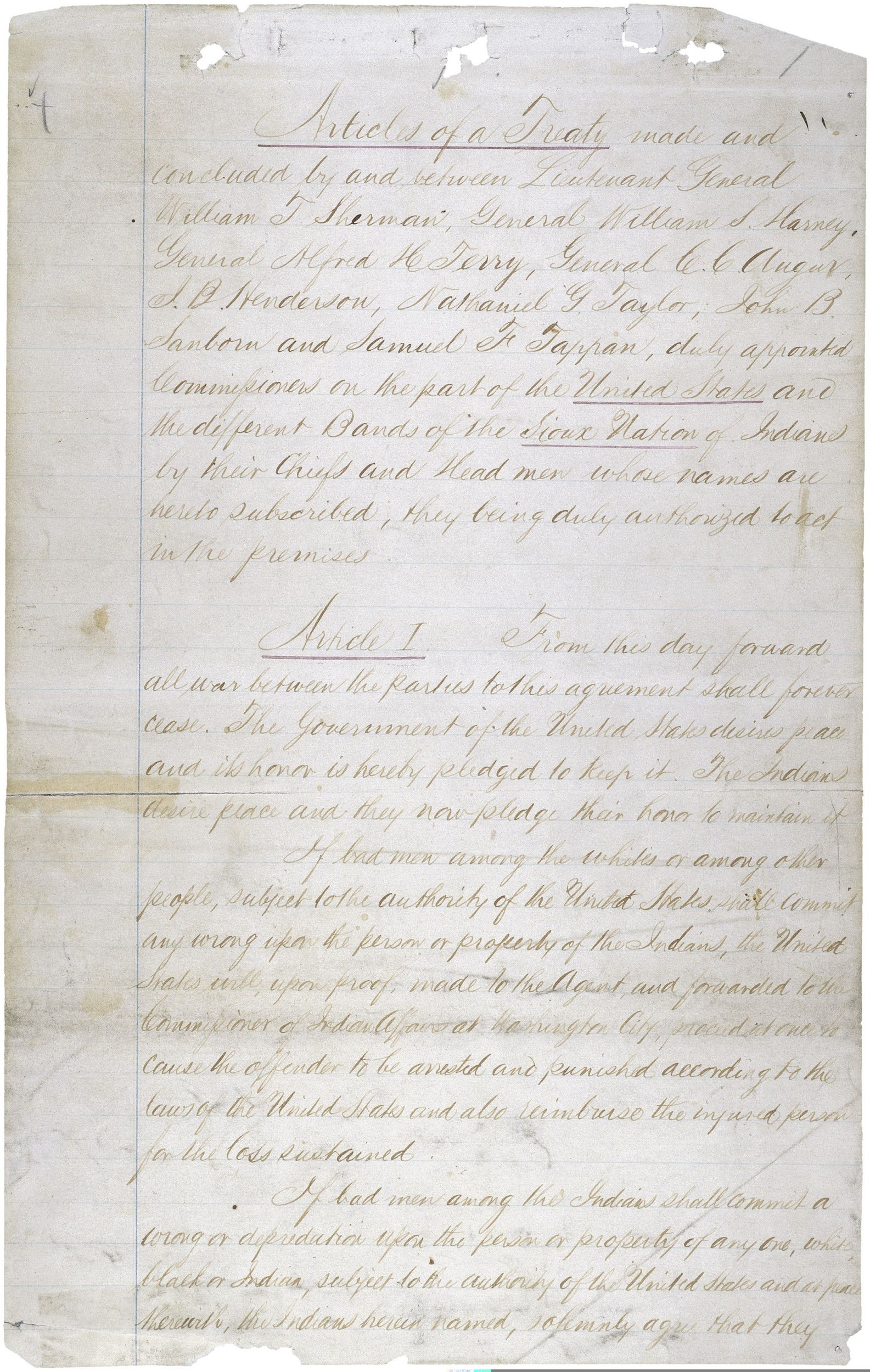
Fort Laramie Treaty
Page 2
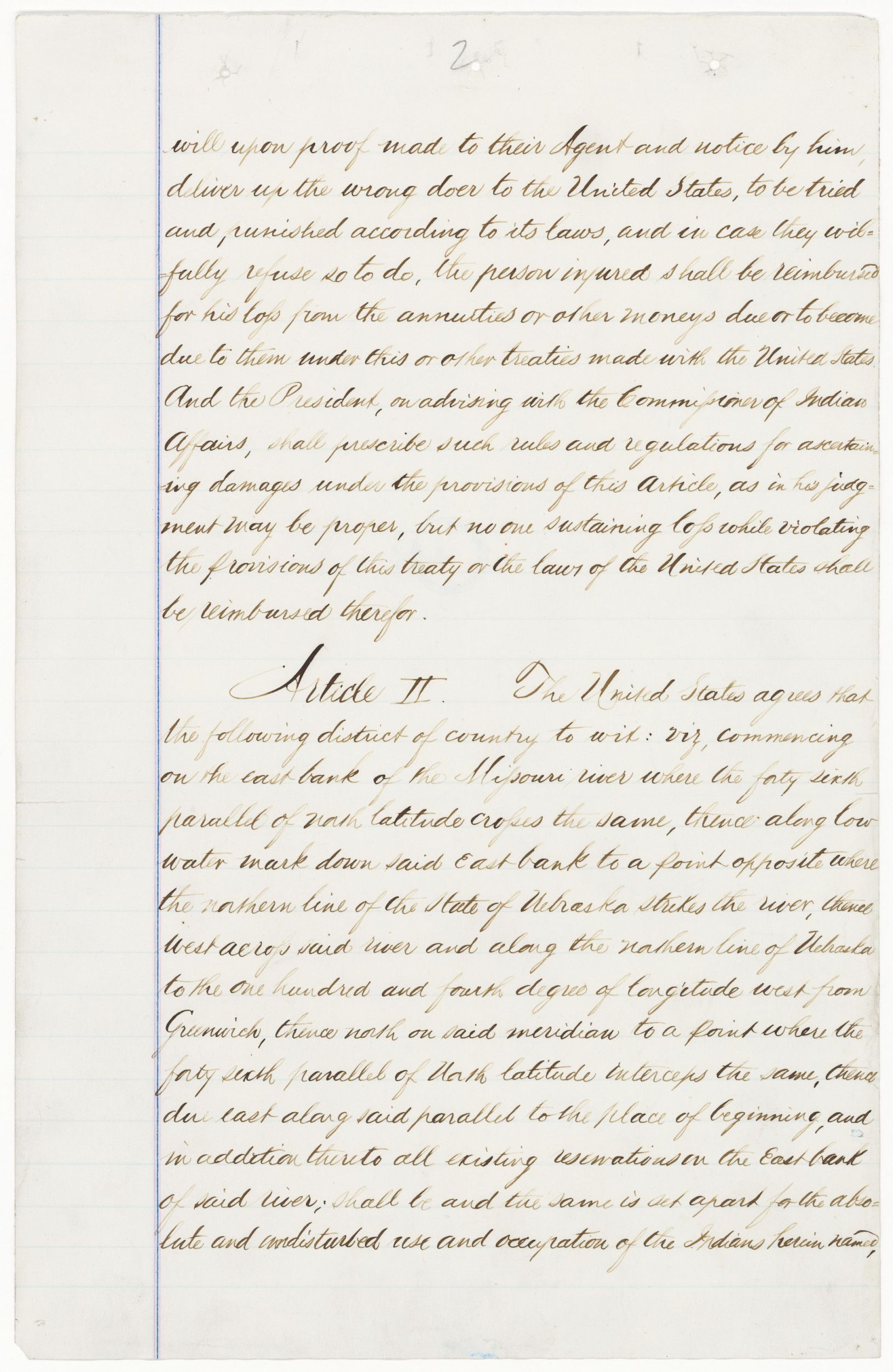
Fort Laramie Treaty
Page 3
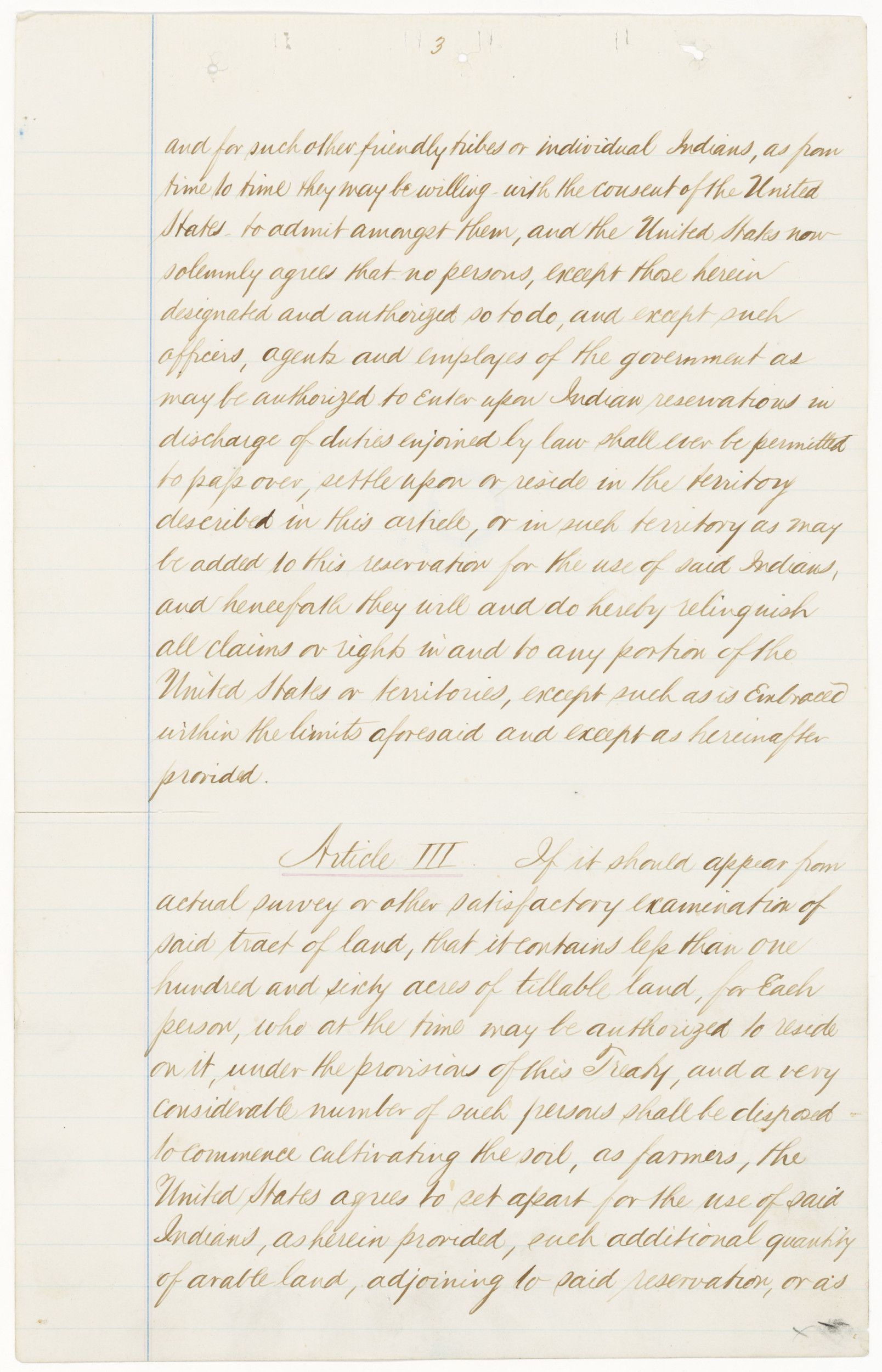
Fort Laramie Treaty
Page 4
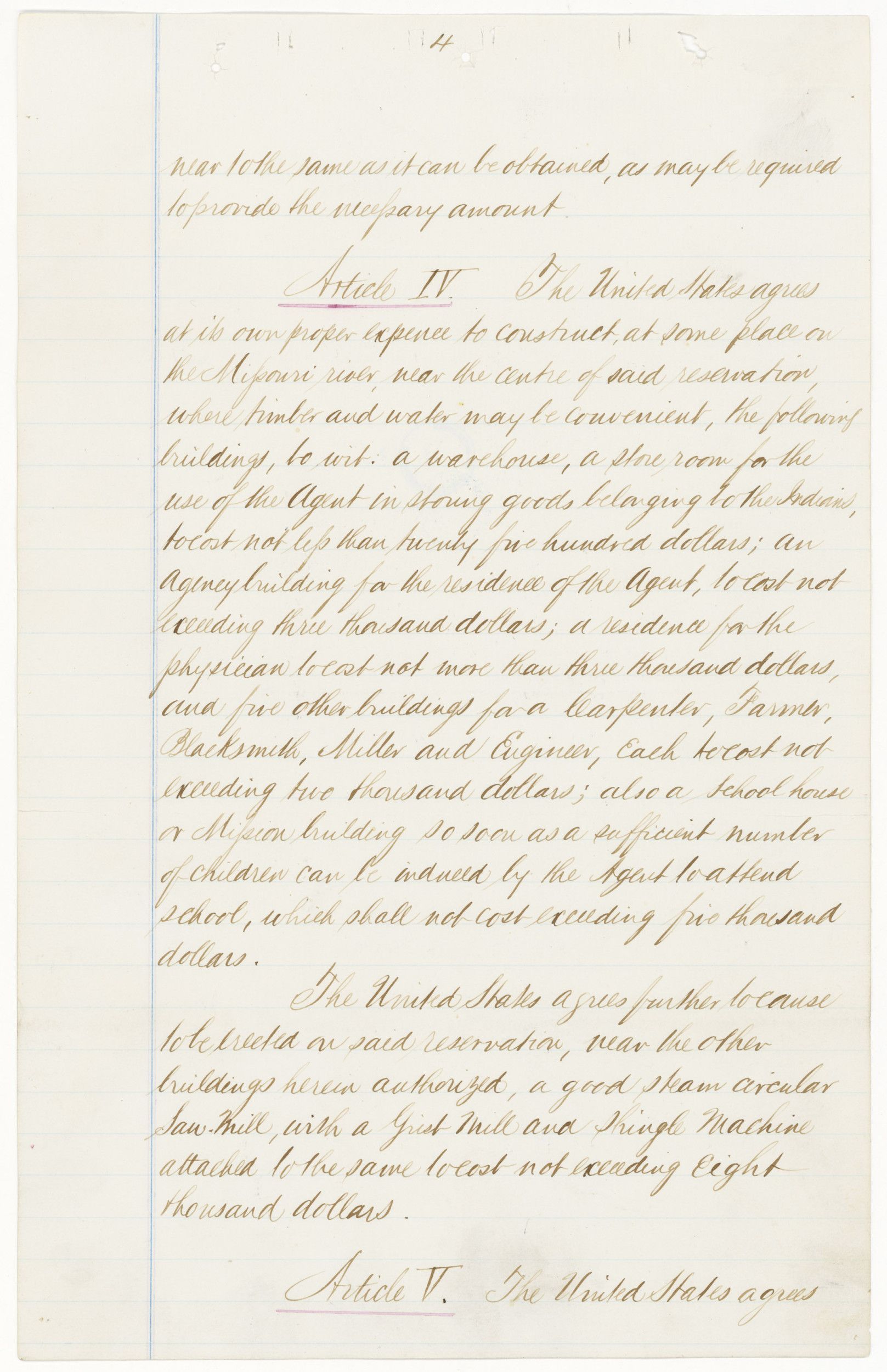
Fort Laramie Treaty
Page 5
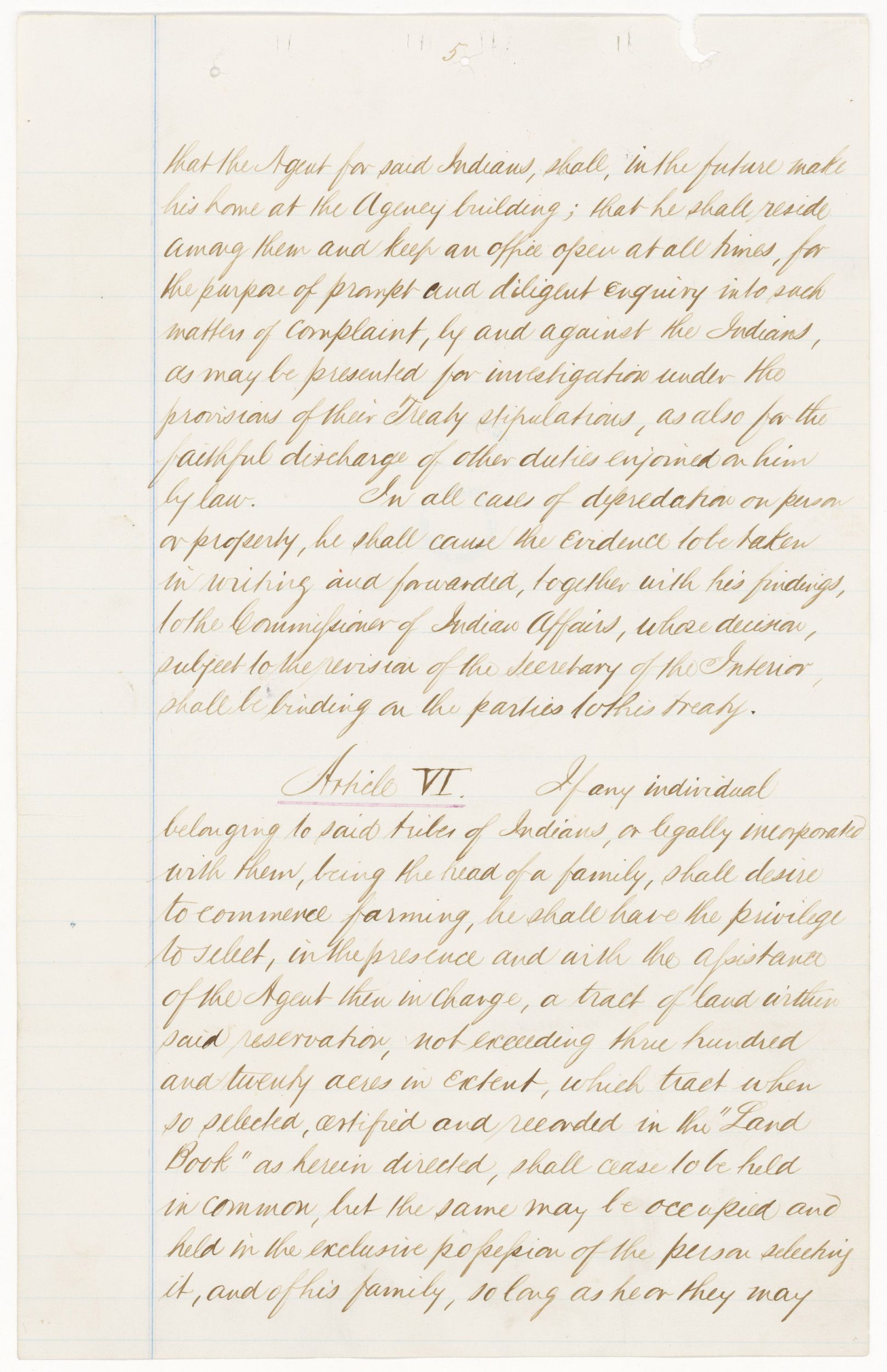
Fort Laramie Treaty
Page 6
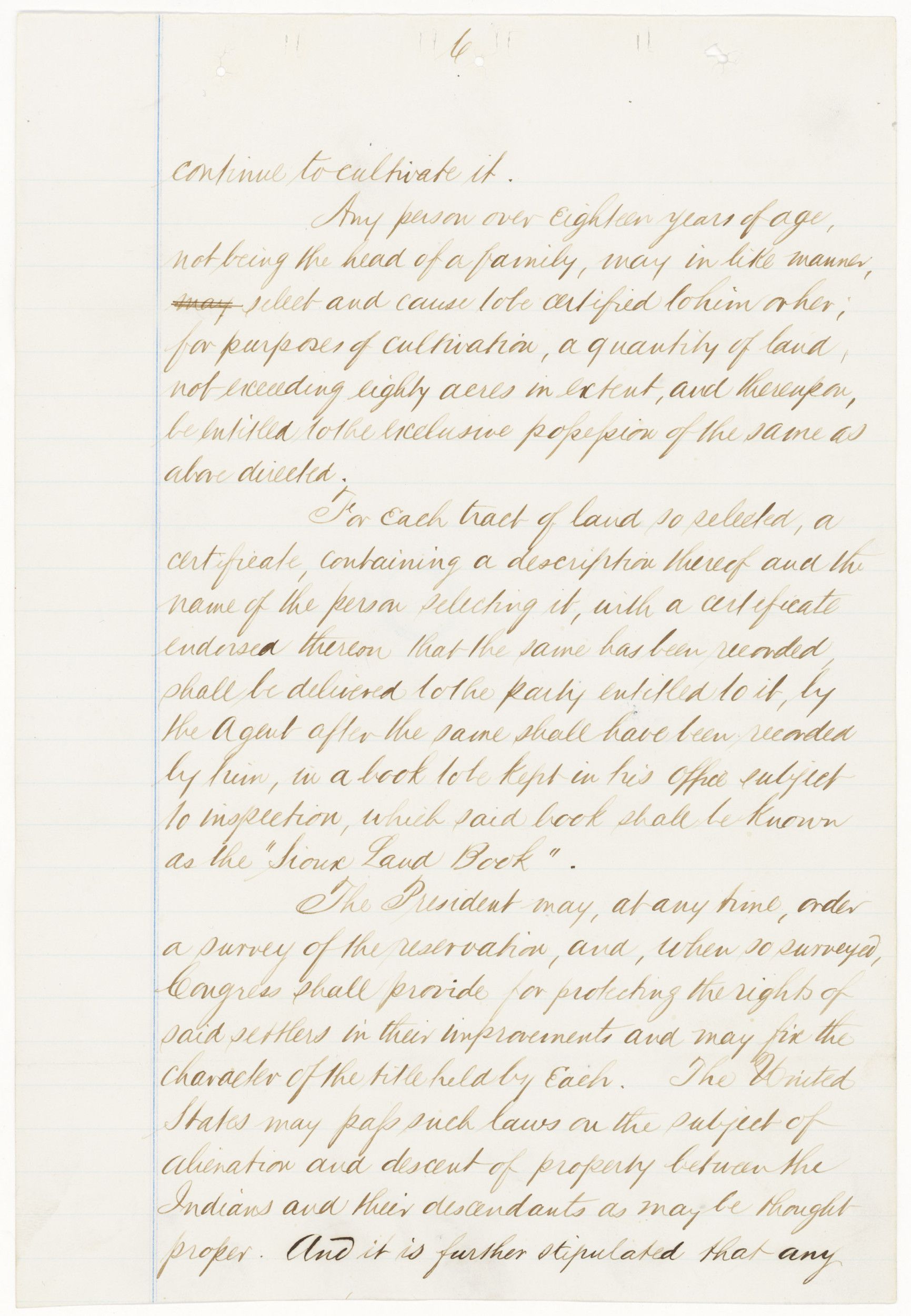
Fort Laramie Treaty
Page 7
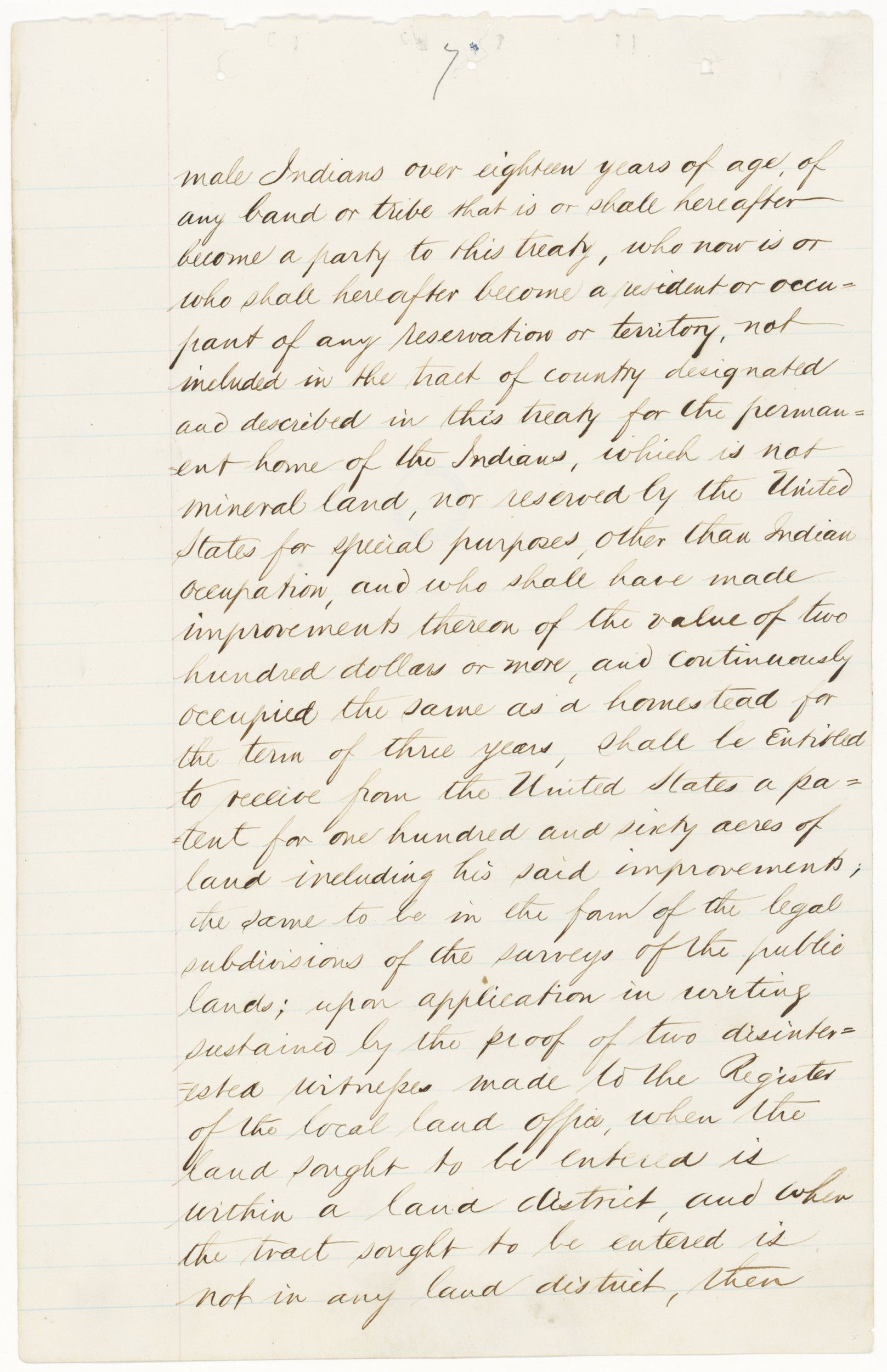
Fort Laramie Treaty
Page 8
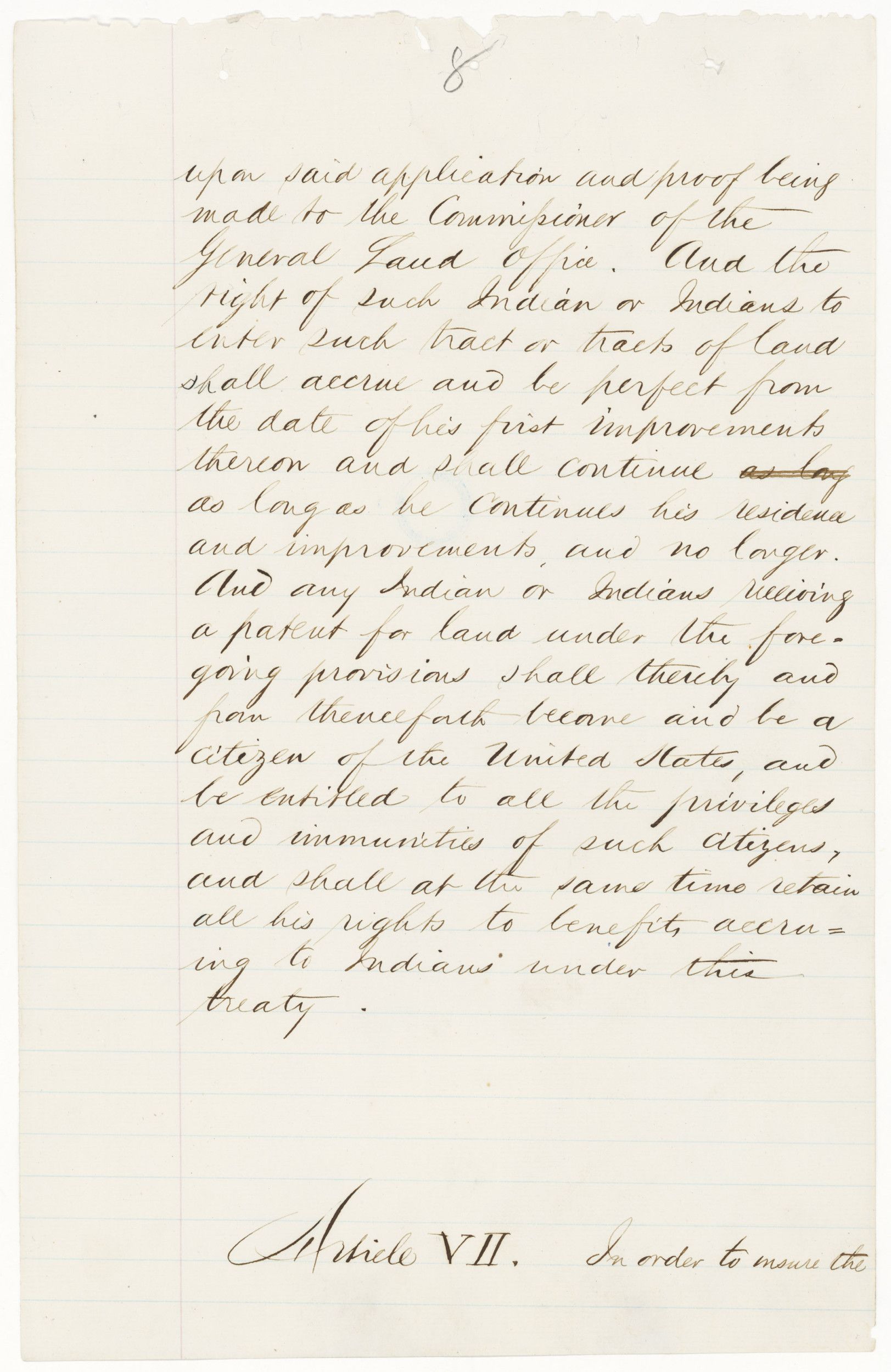
Fort Laramie Treaty
Page 9
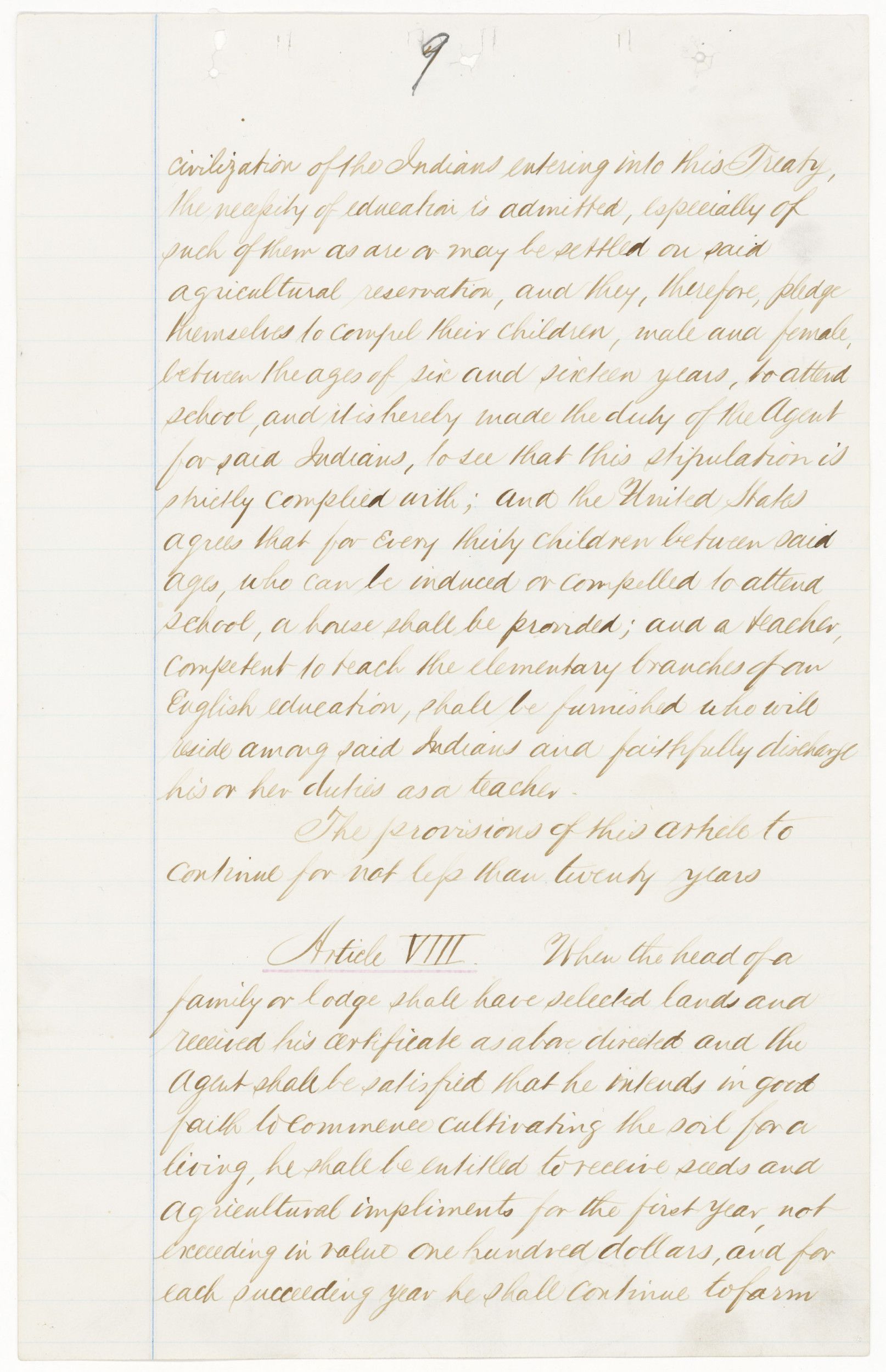
Fort Laramie Treaty
Page 10
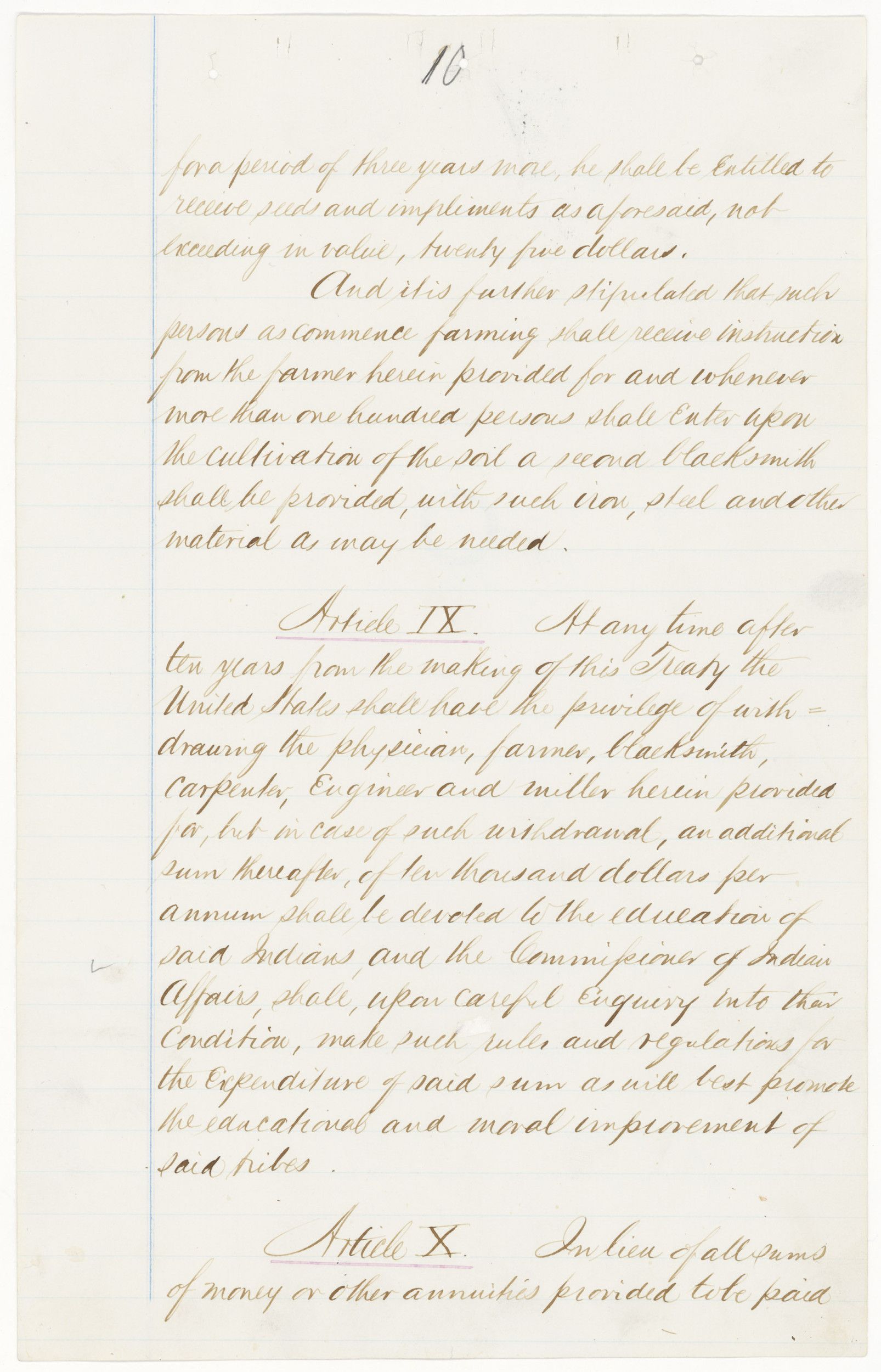
Fort Laramie Treaty
Page 11
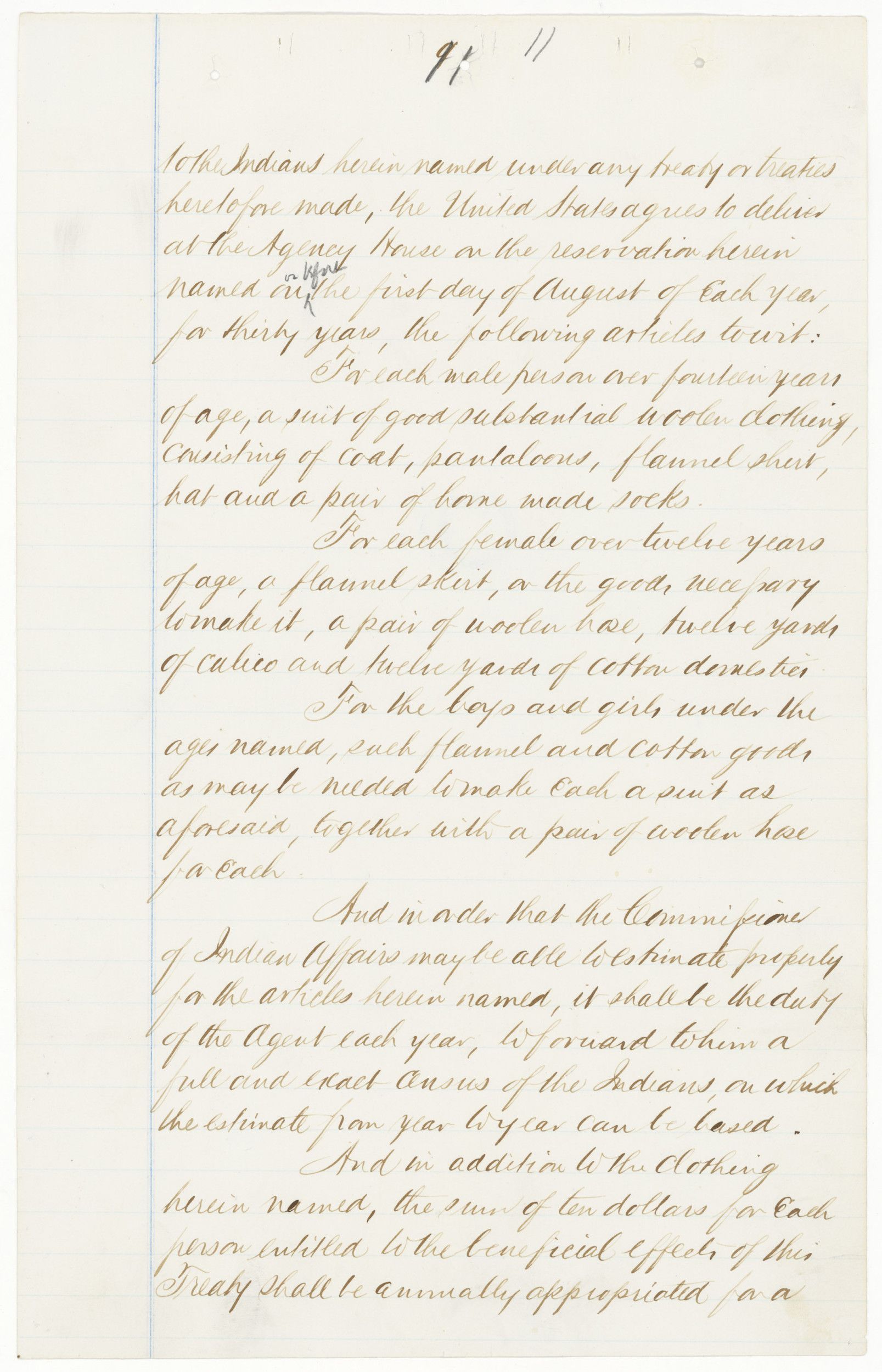
Fort Laramie Treaty
Page 12
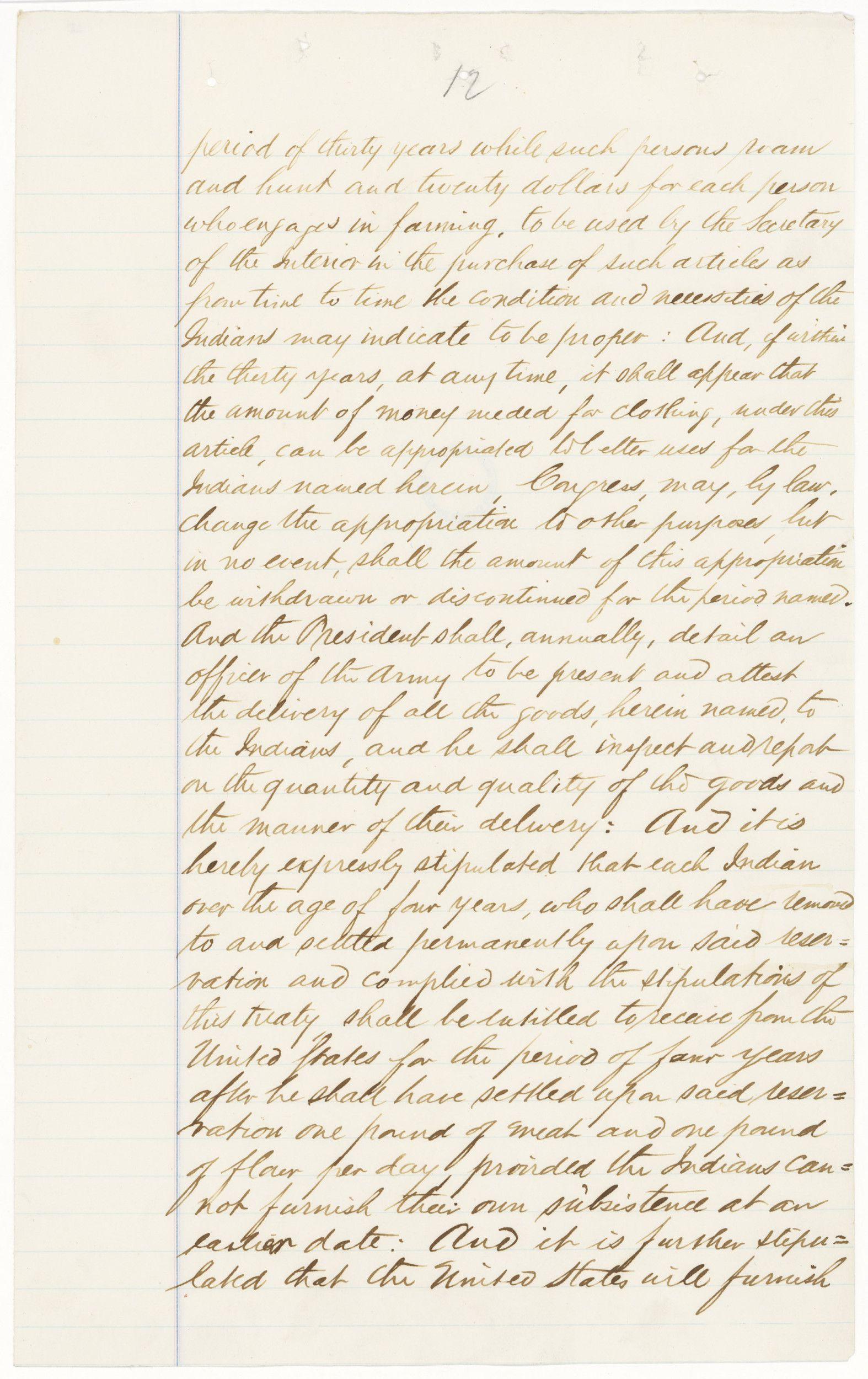
Fort Laramie Treaty
Page 13

Fort Laramie Treaty
Page 14
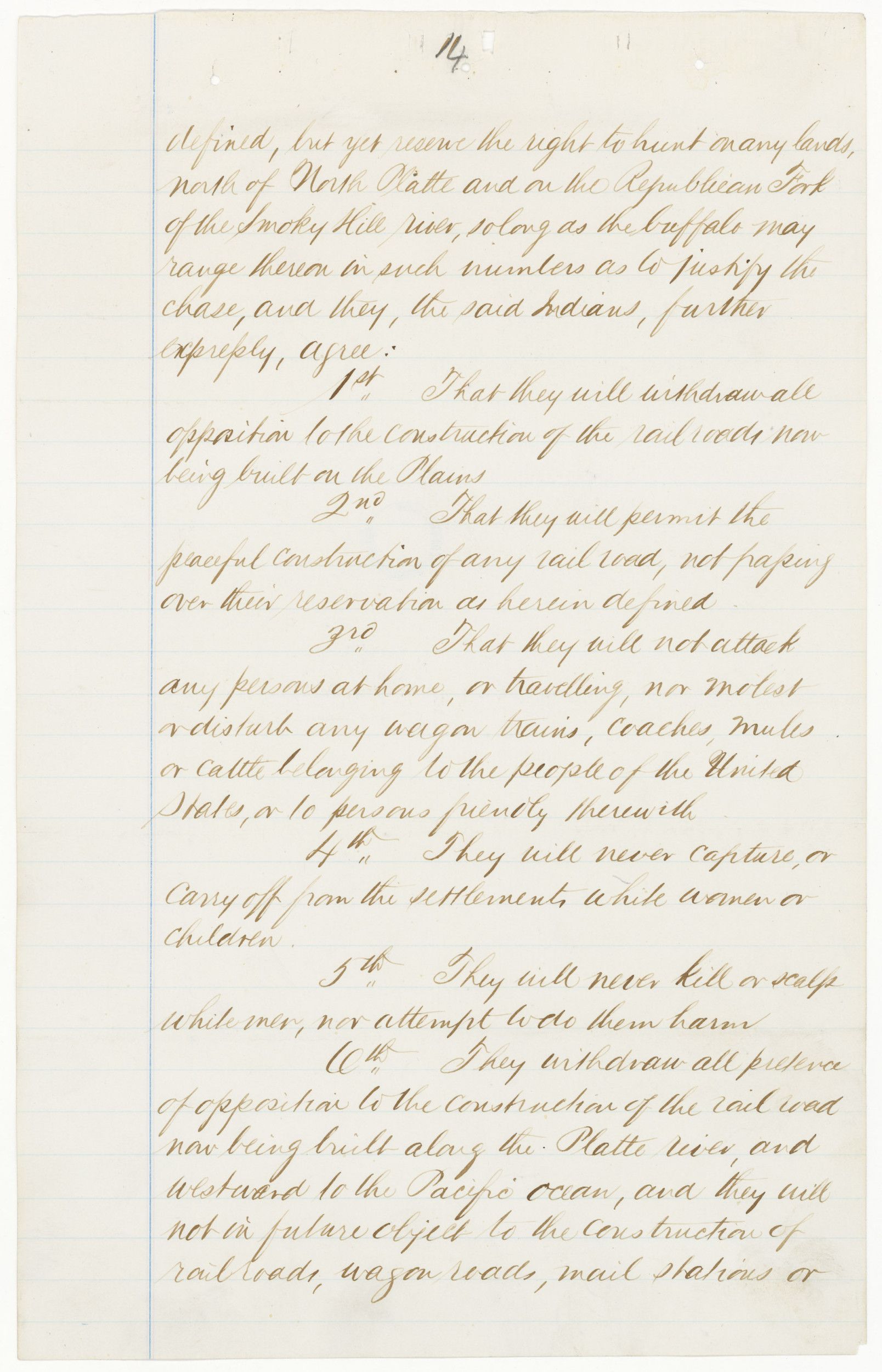
Fort Laramie Treaty
Page 15
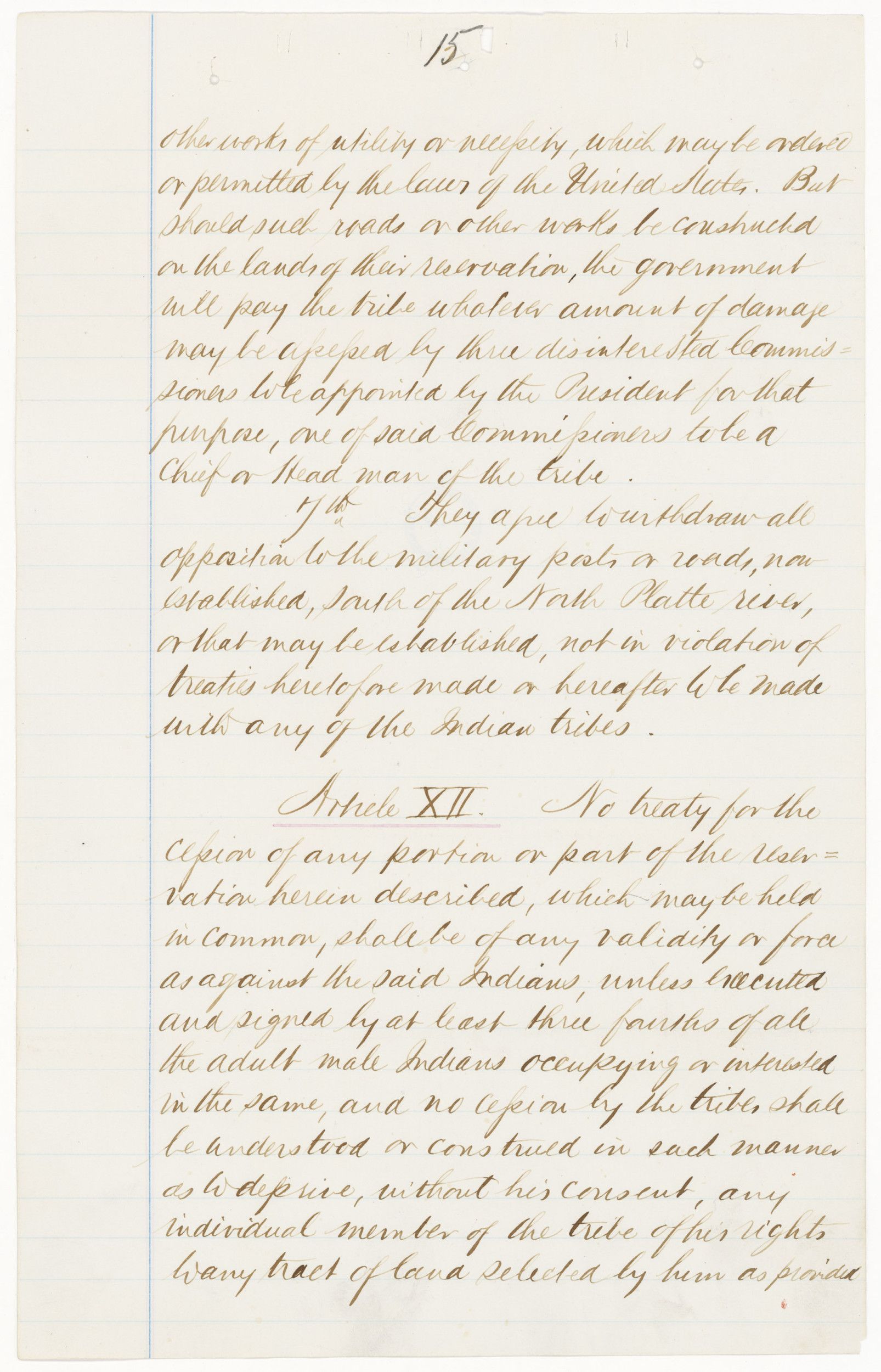
Fort Laramie Treaty
Page 16
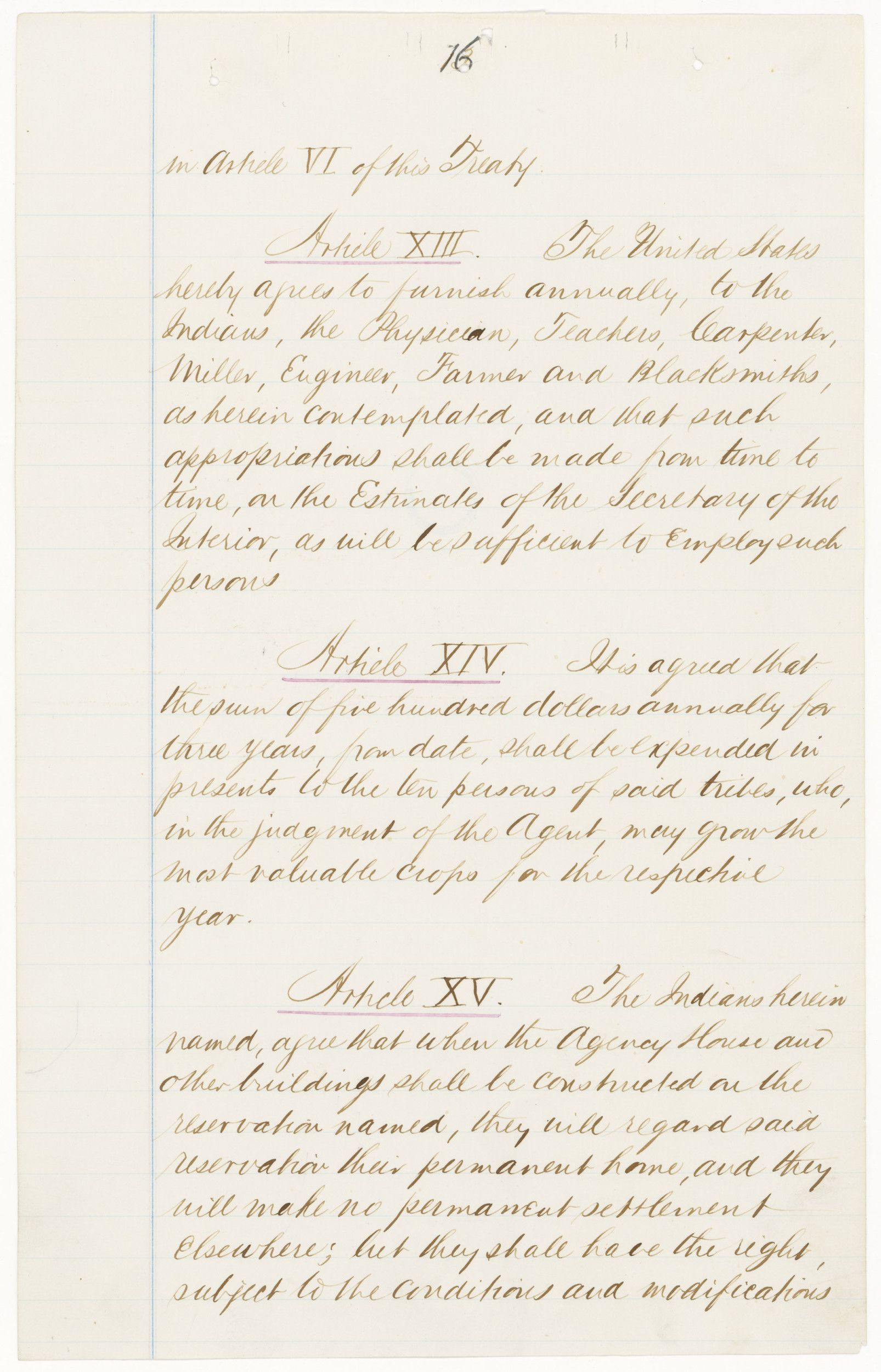
Fort Laramie Treaty
Page 17
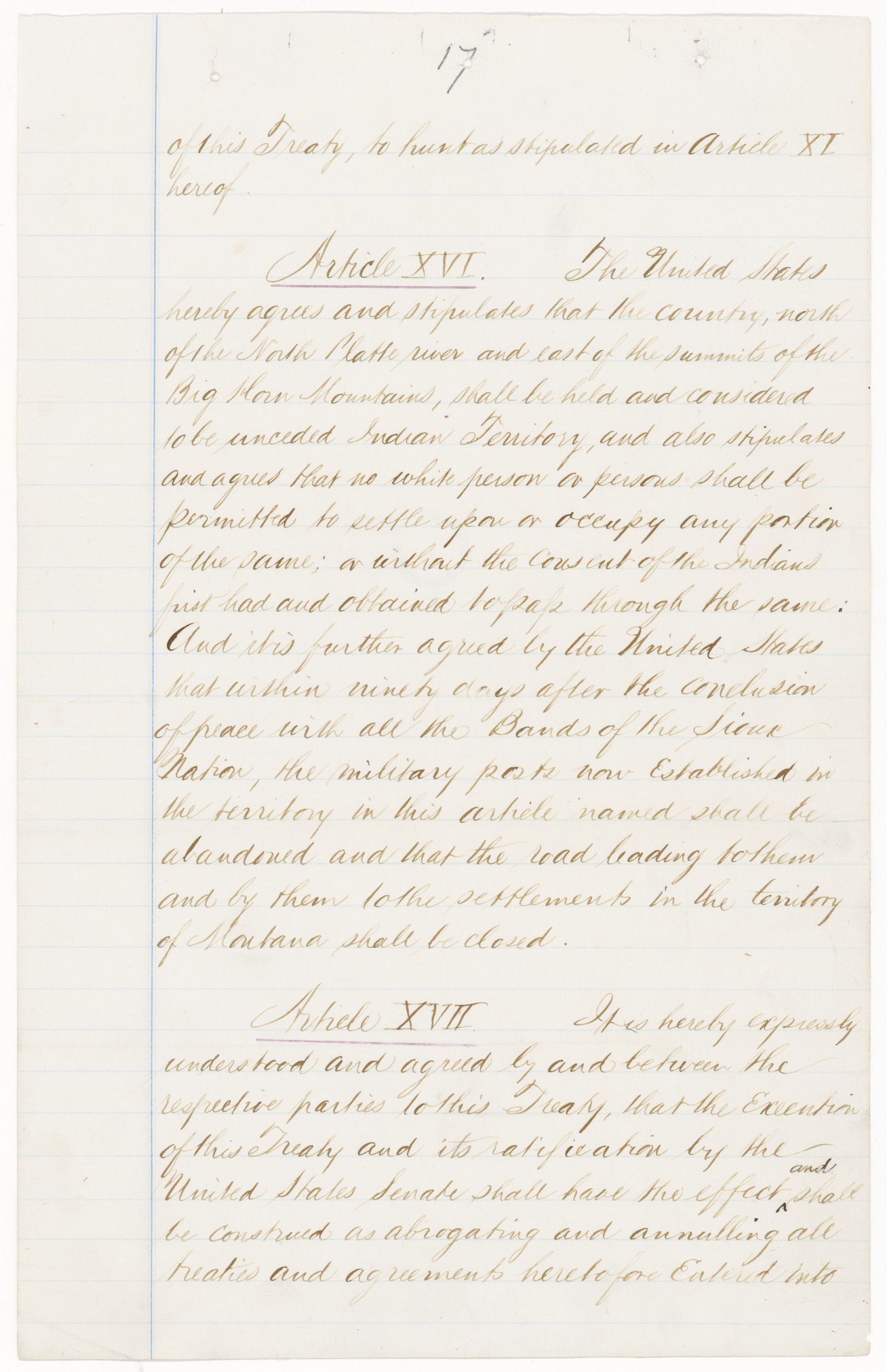
Fort Laramie Treaty
Page 18
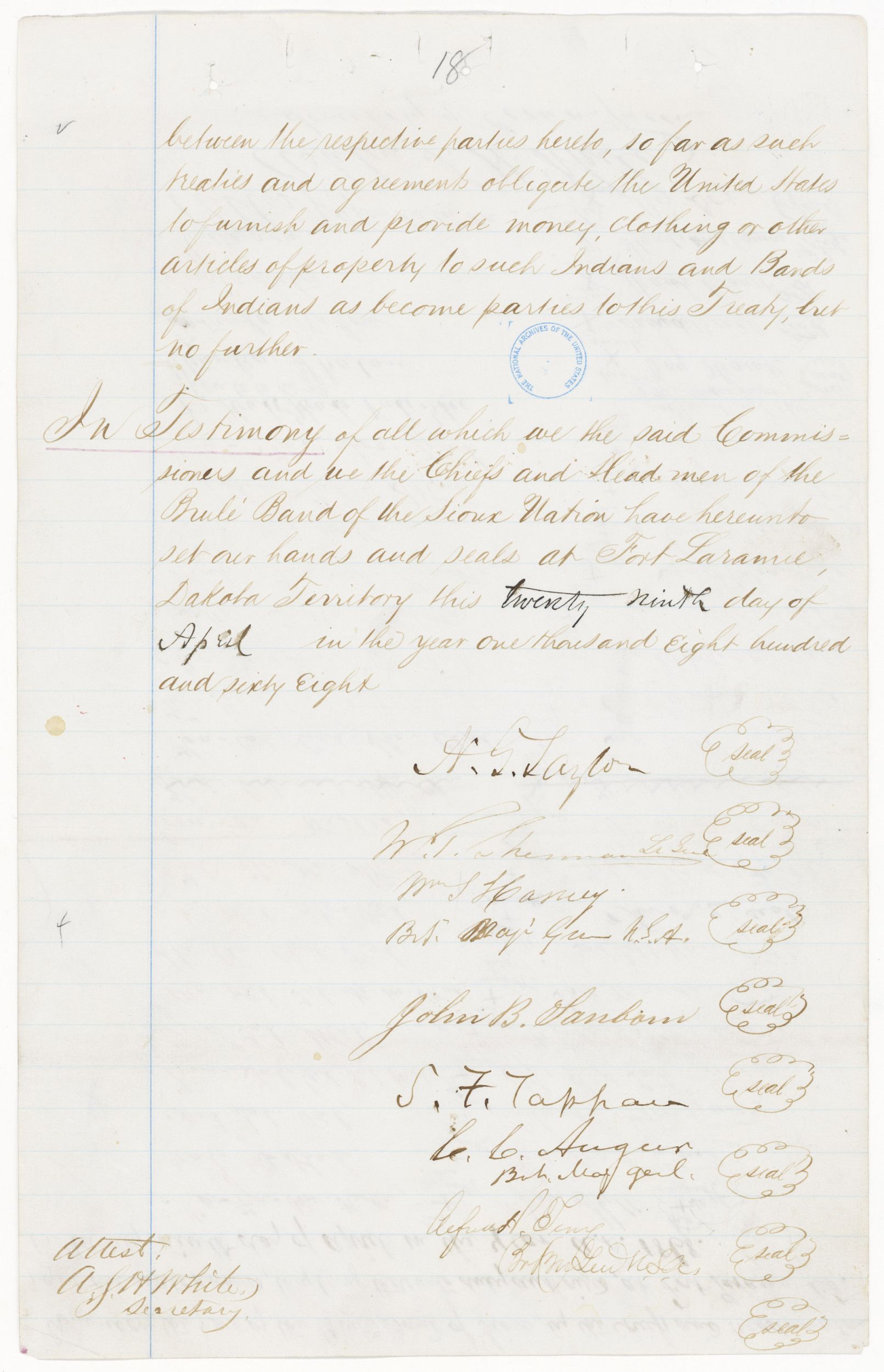
Fort Laramie Treaty
Page 19
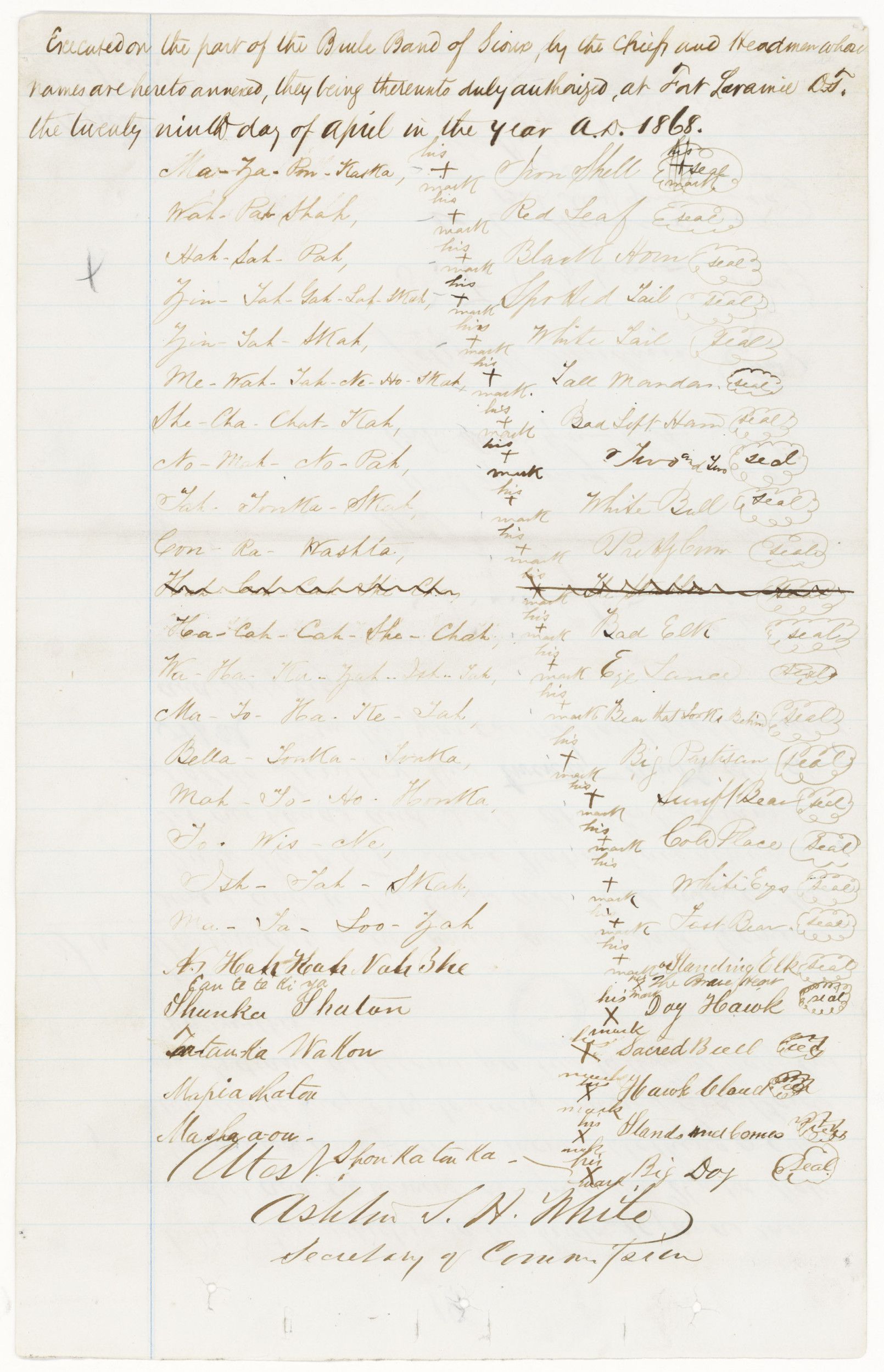
Fort Laramie Treaty
Page 20
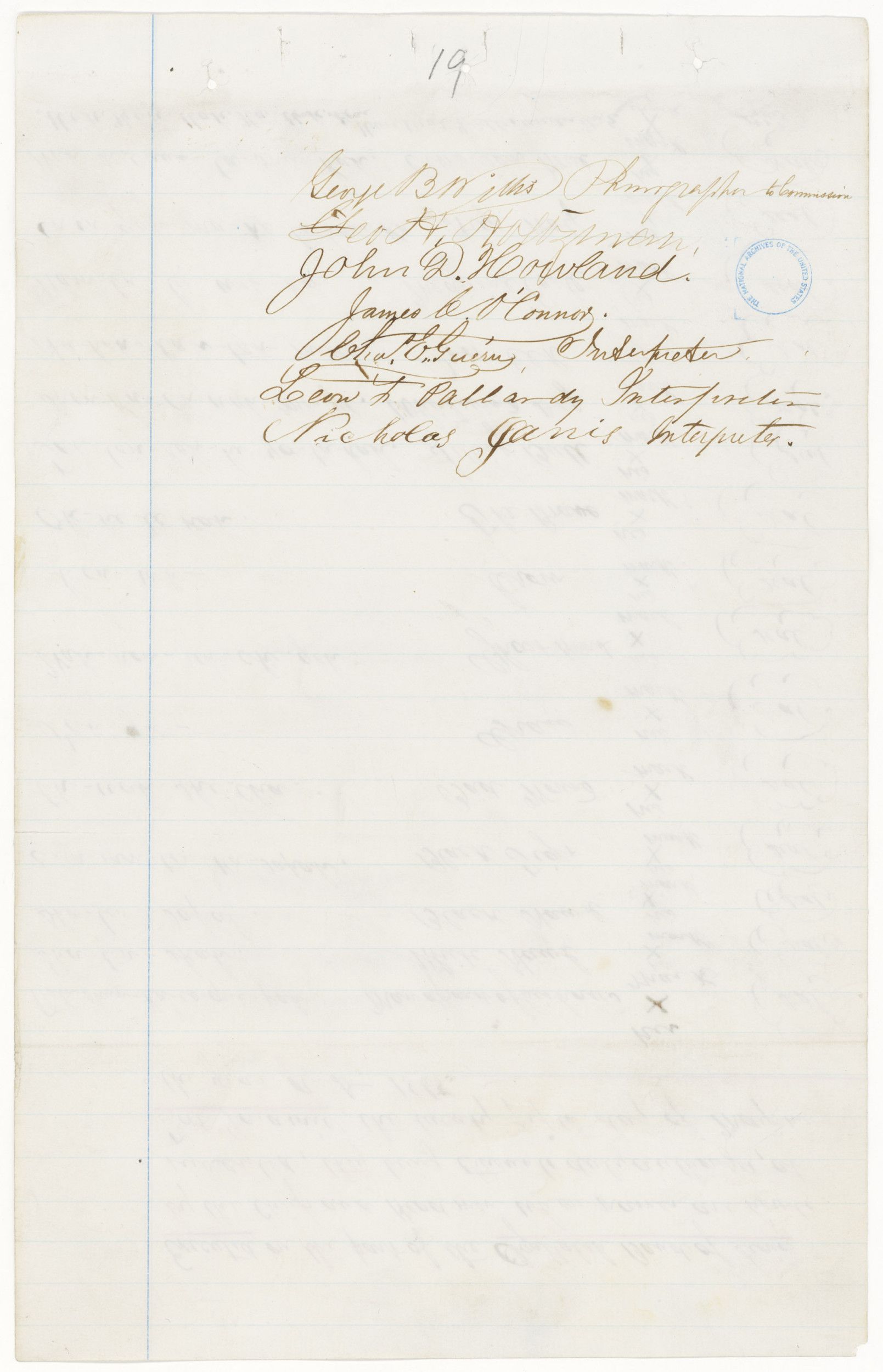
Fort Laramie Treaty
Page 21
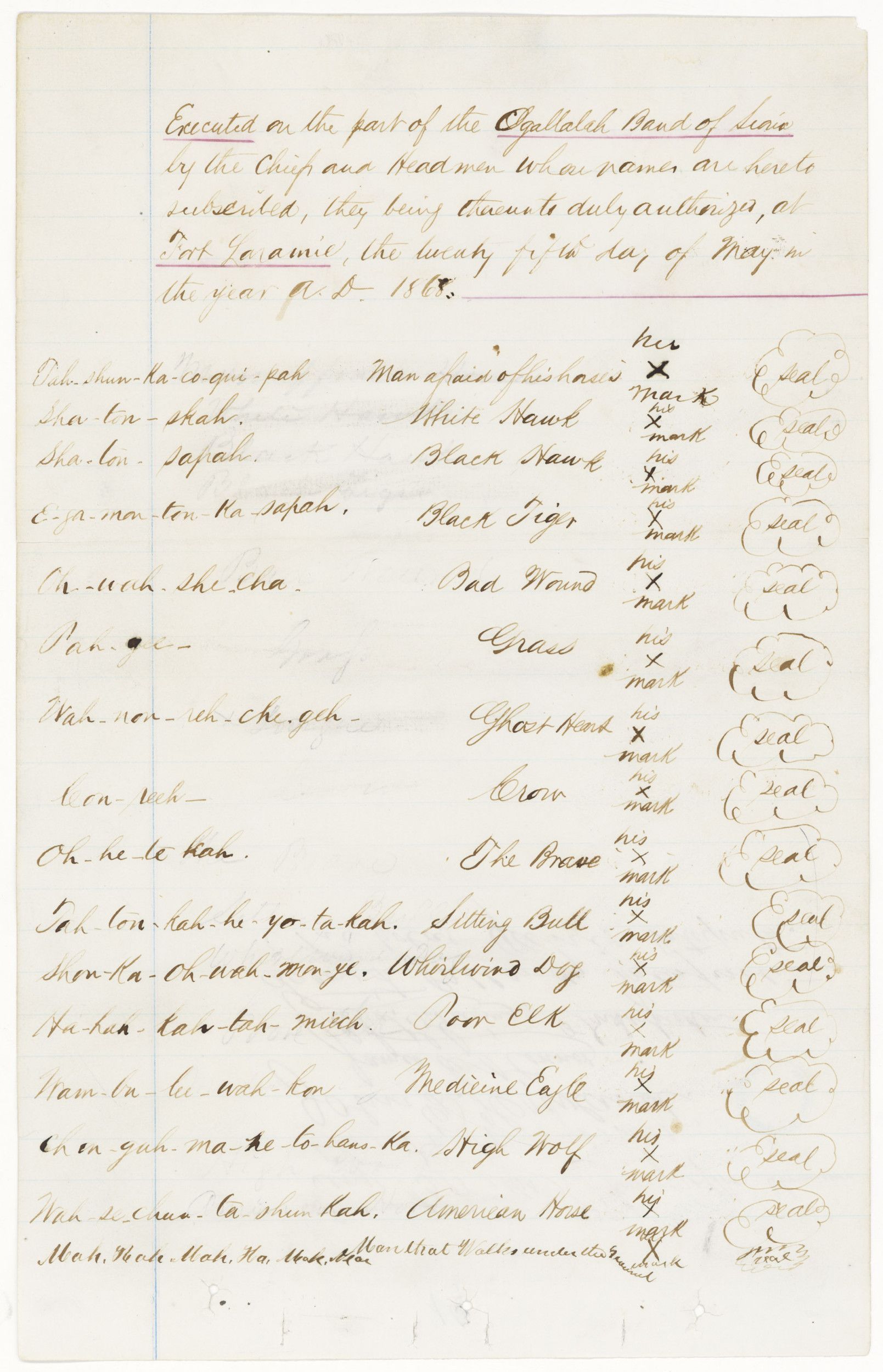
Fort Laramie Treaty
Page 22
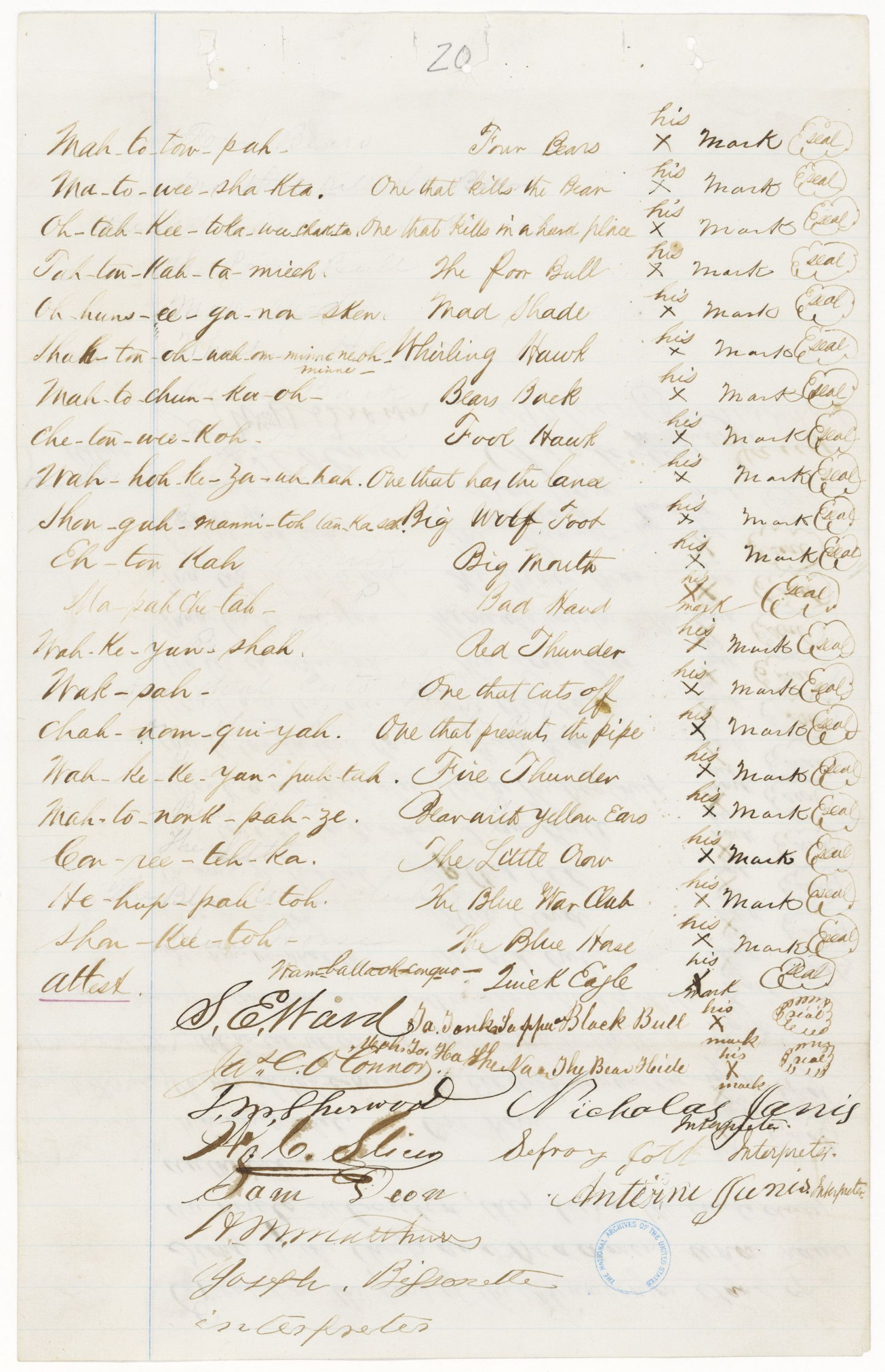
Fort Laramie Treaty
Page 23
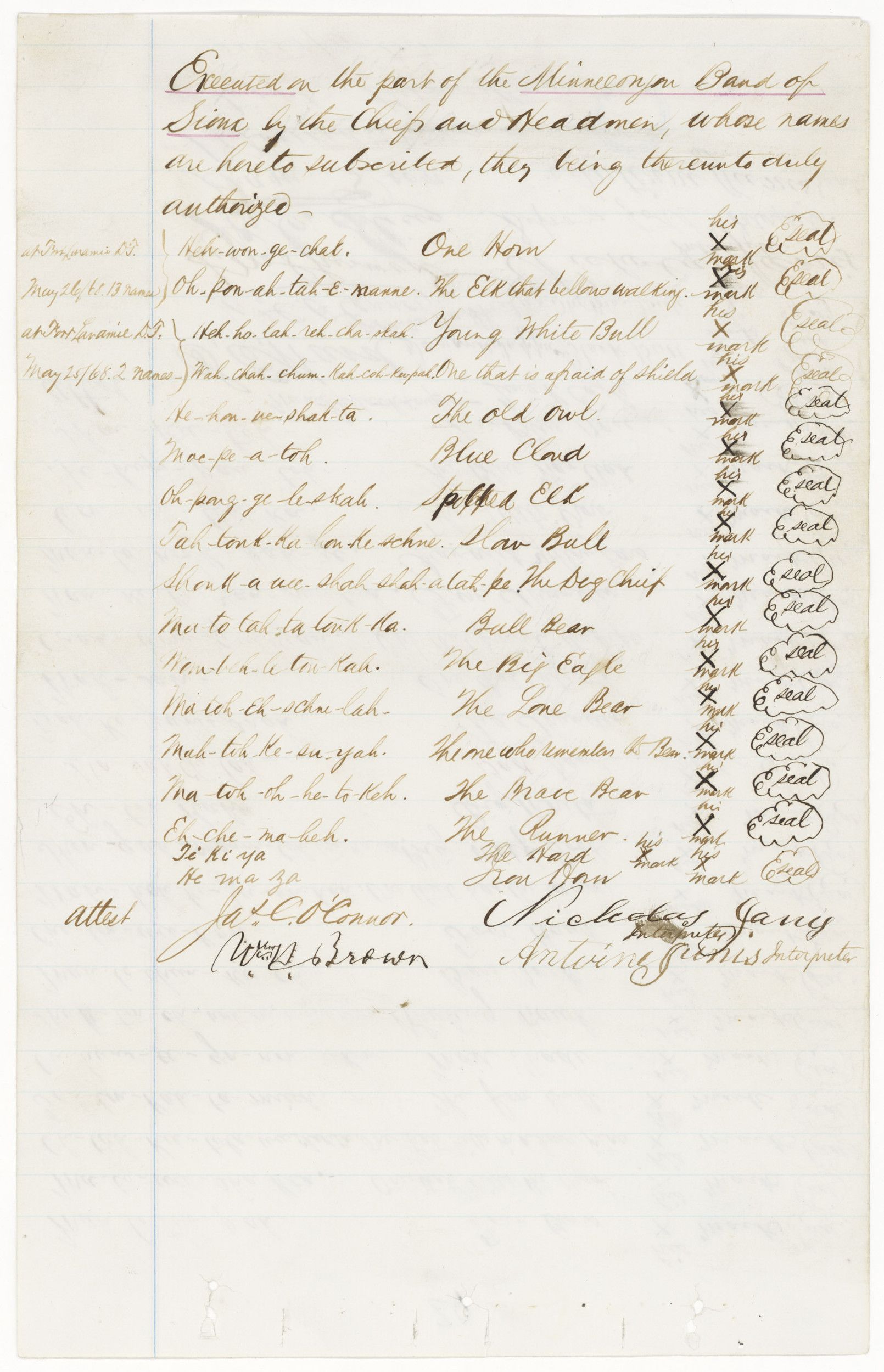
Fort Laramie Treaty
Page 24
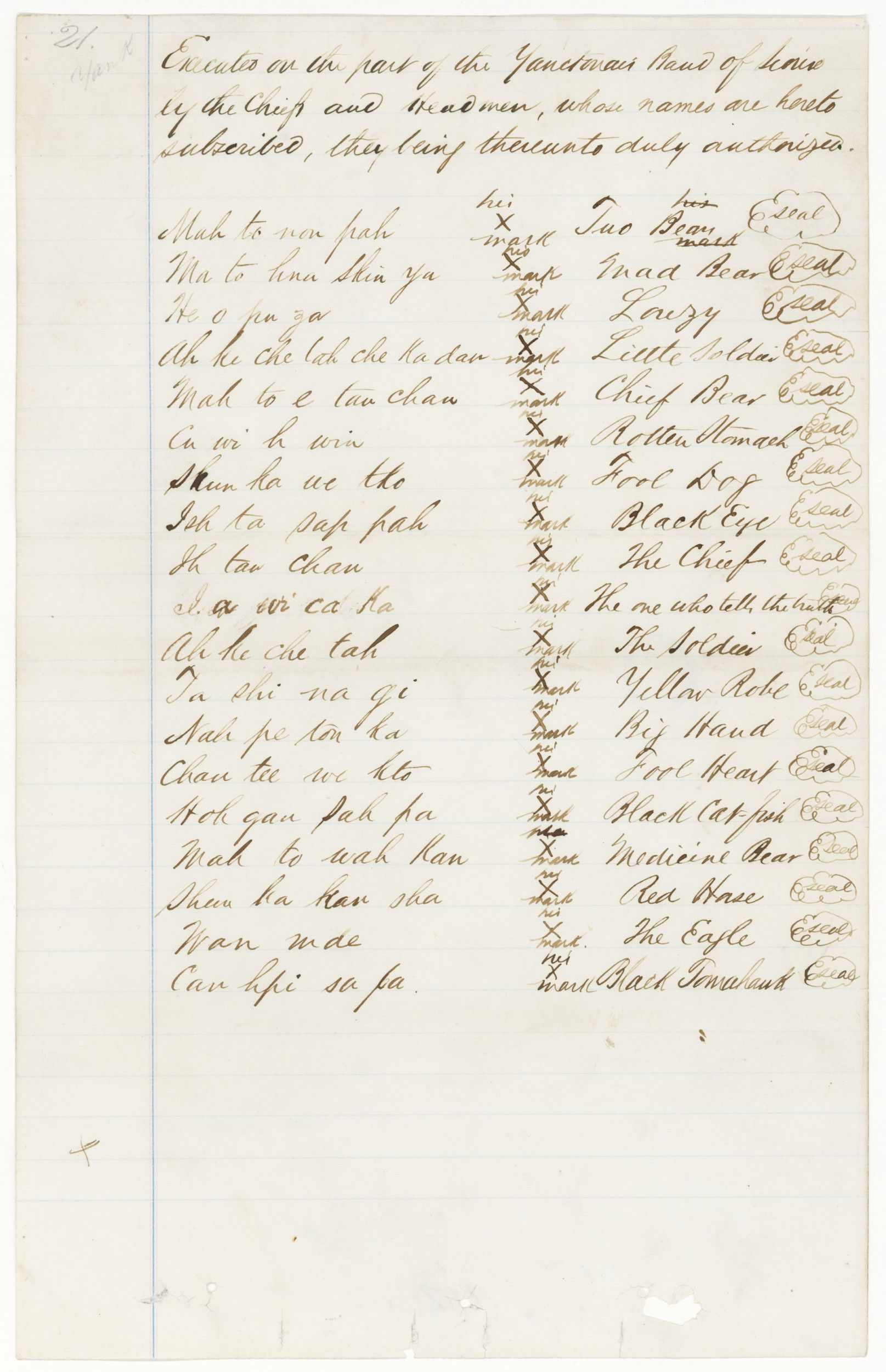
Fort Laramie Treaty
Page 25
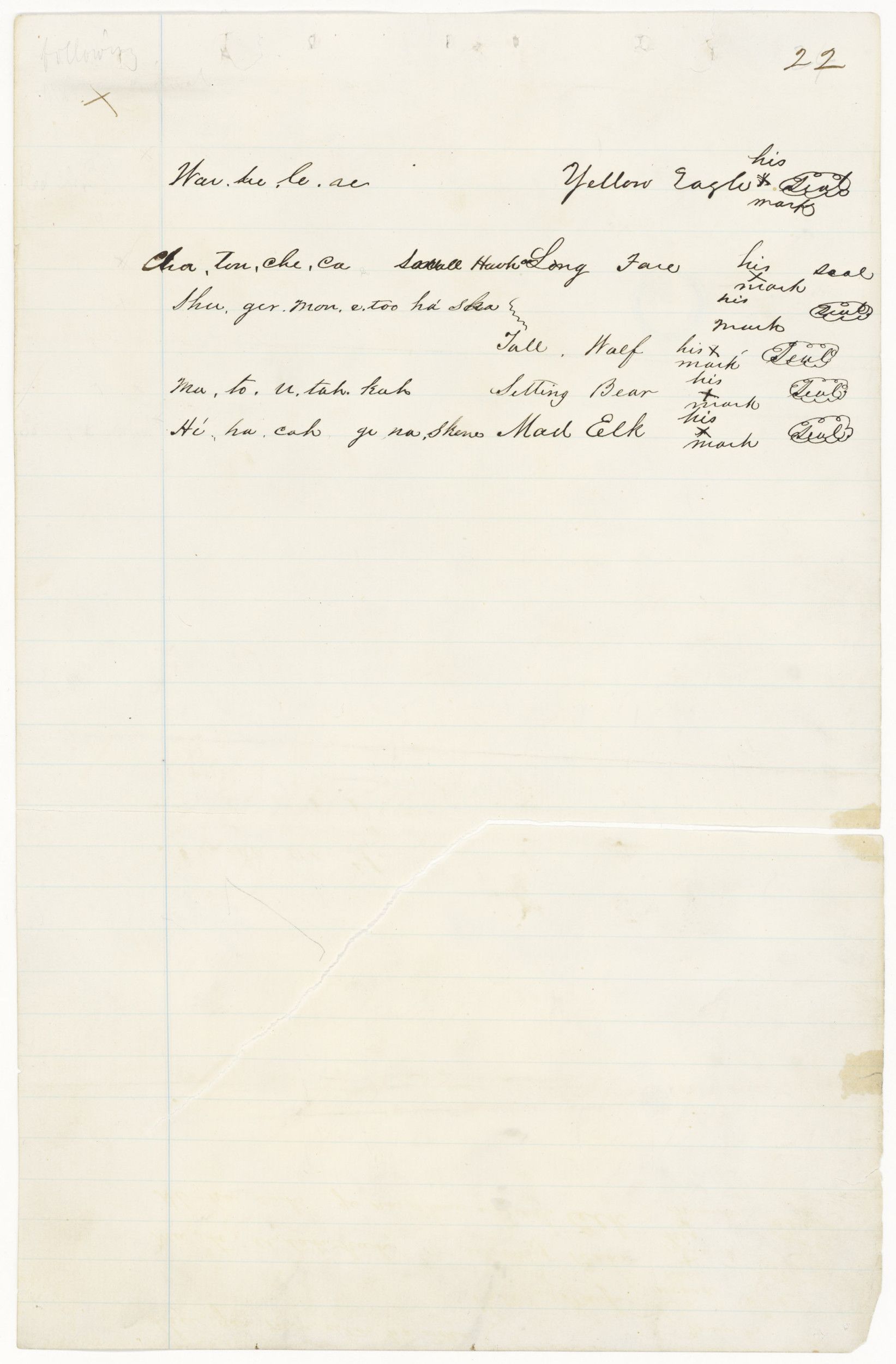
Fort Laramie Treaty
Page 26
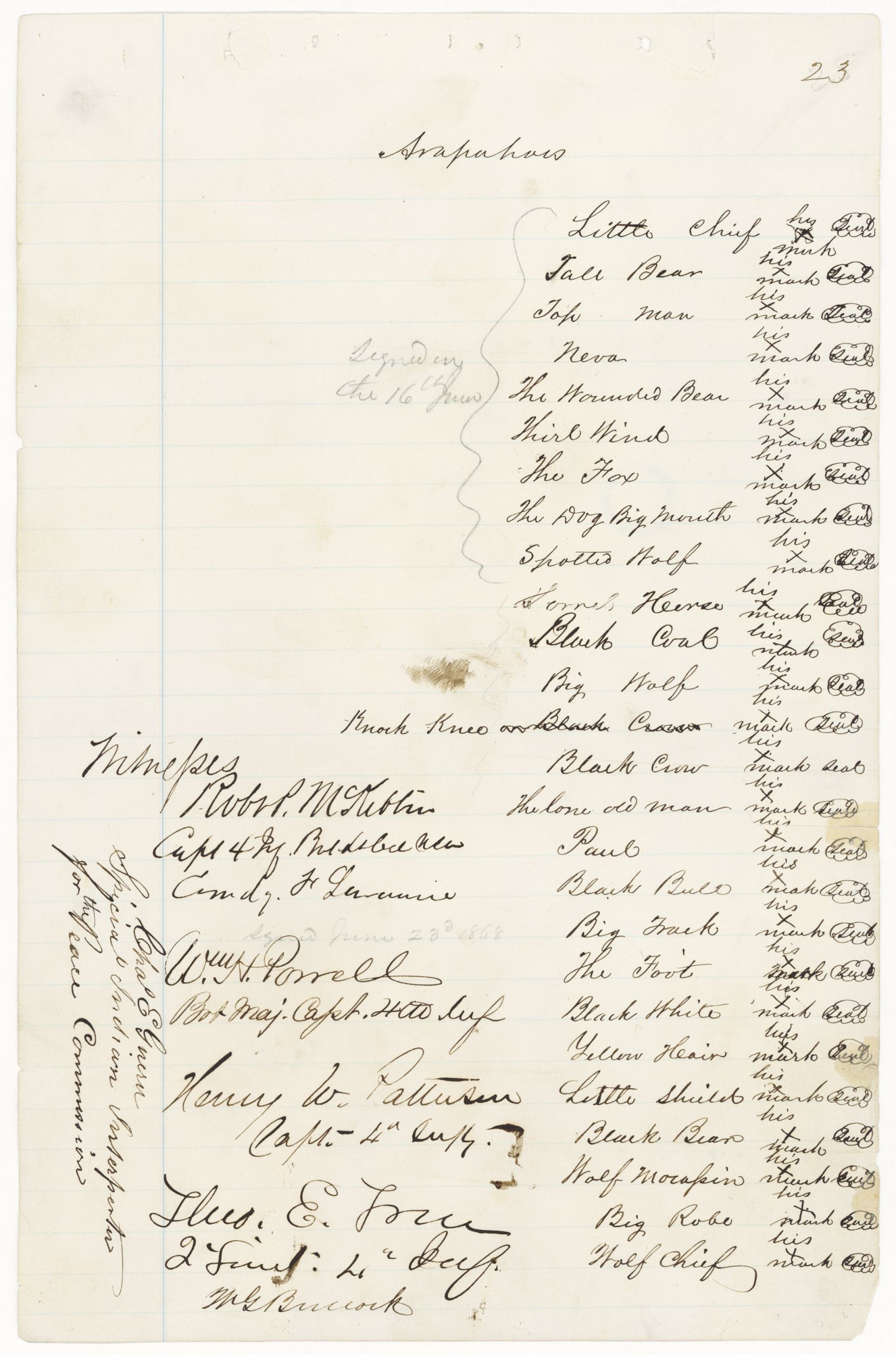
Fort Laramie Treaty
Page 27
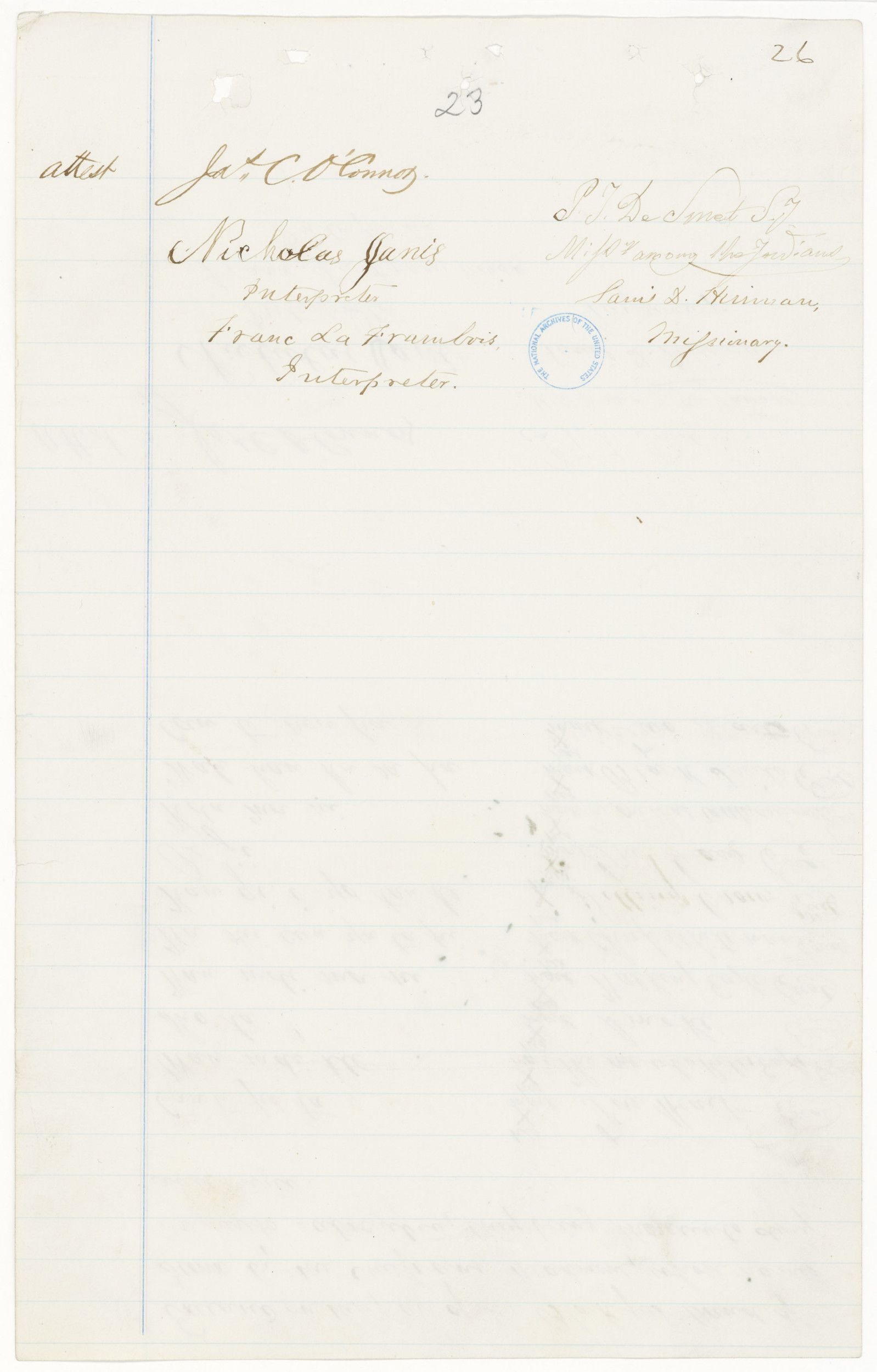
Fort Laramie Treaty
Page 28
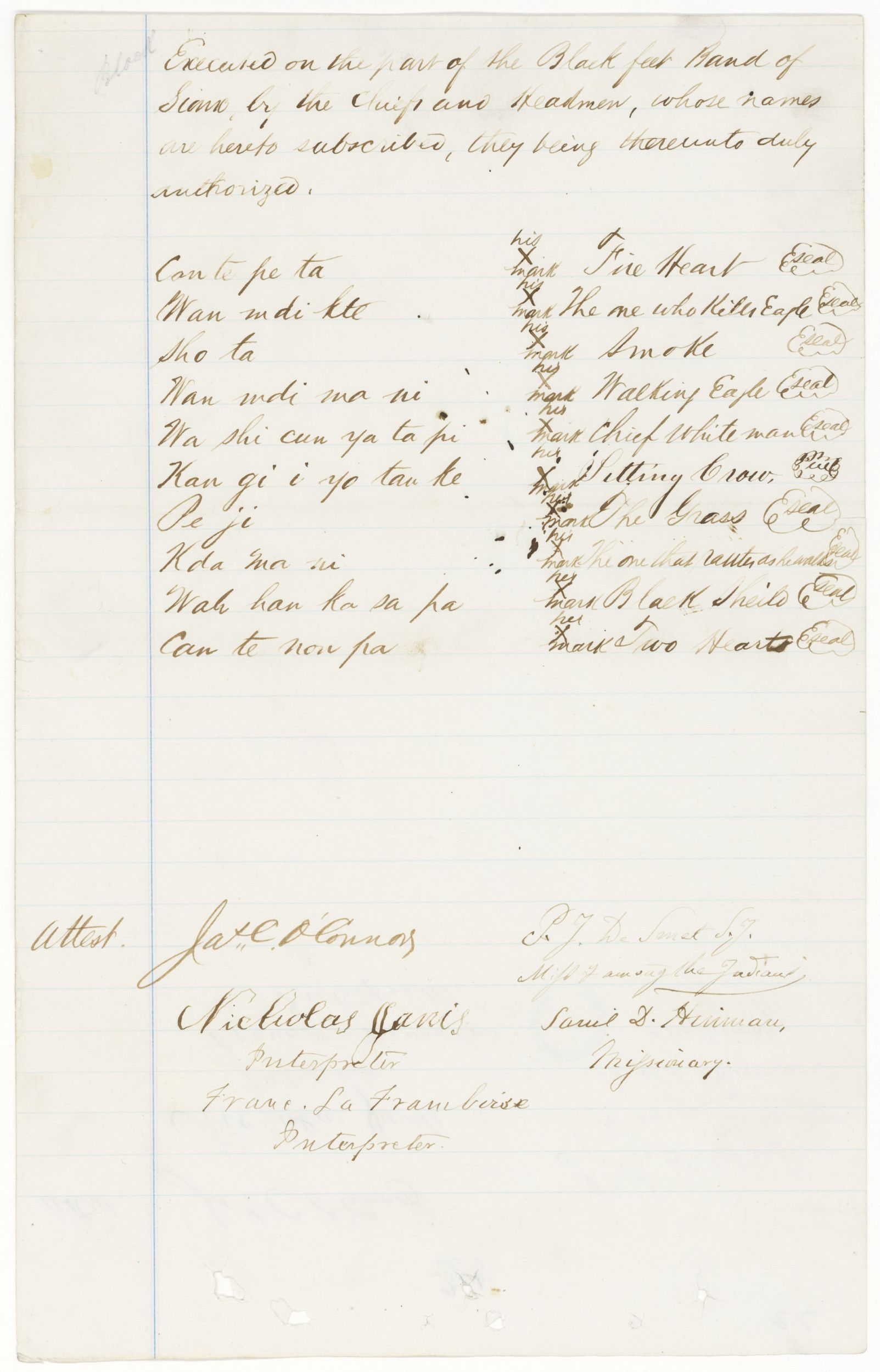
Fort Laramie Treaty
Page 29
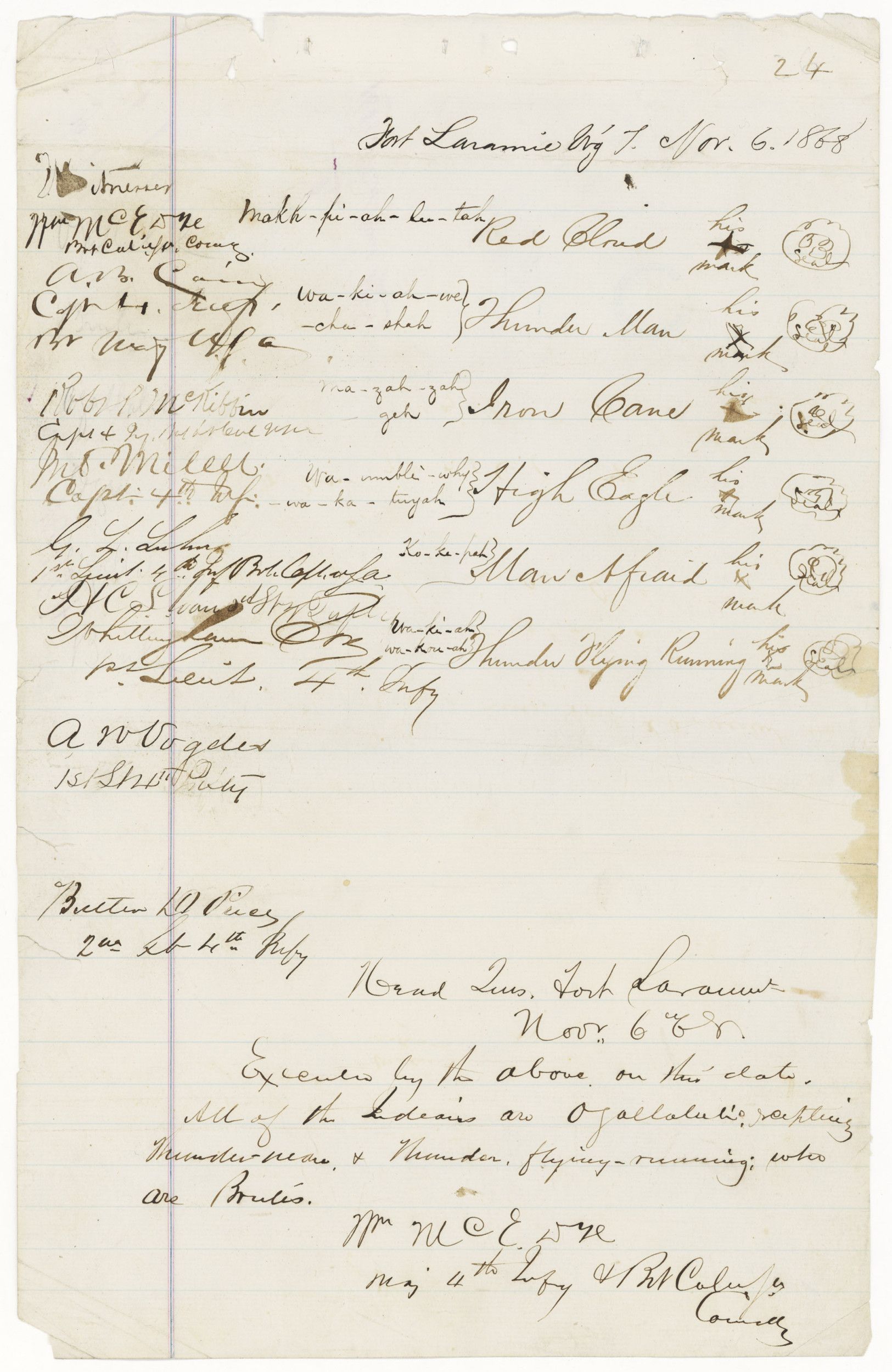
Fort Laramie Treaty
Page 30
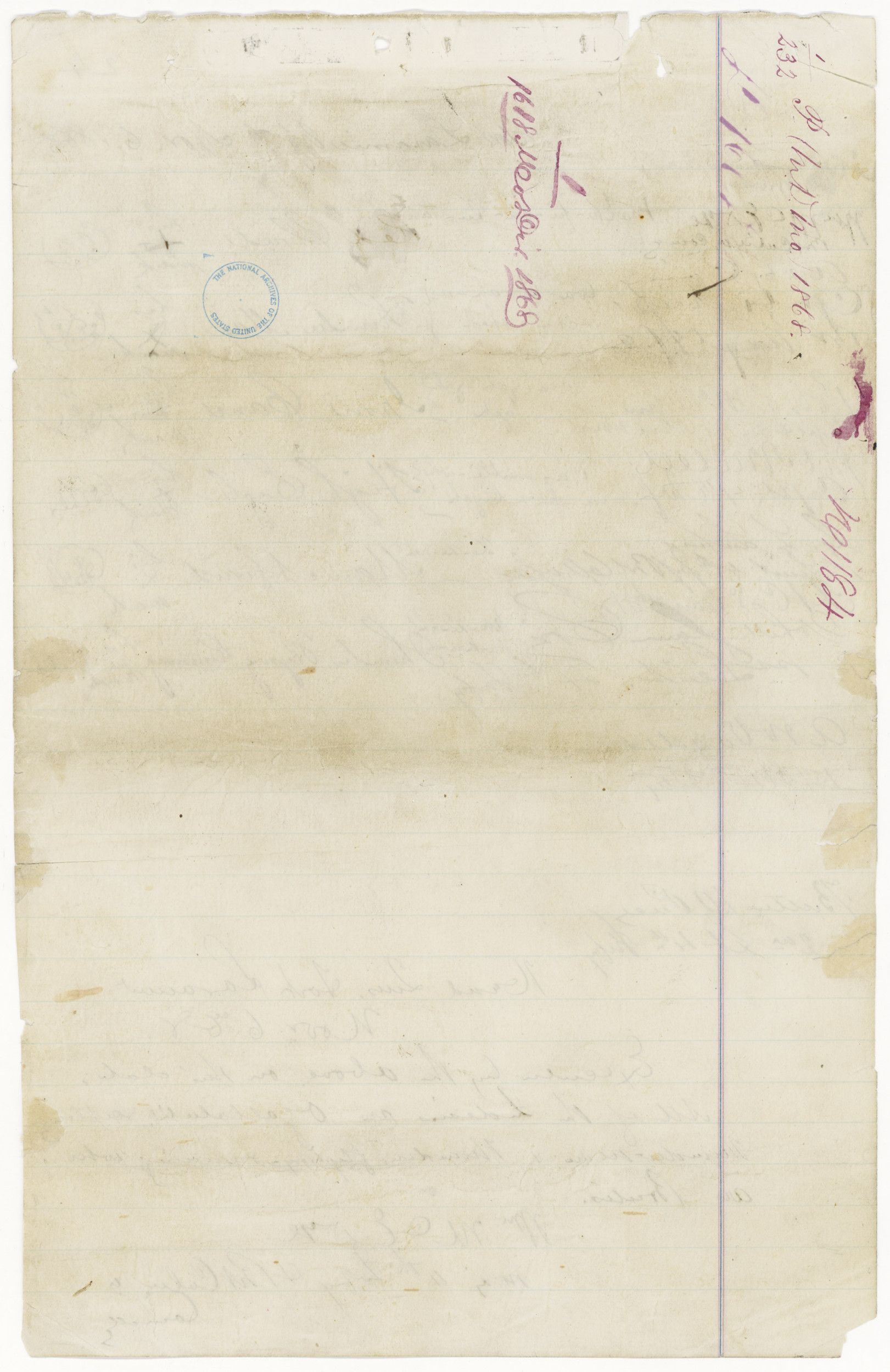
Fort Laramie Treaty
Page 31
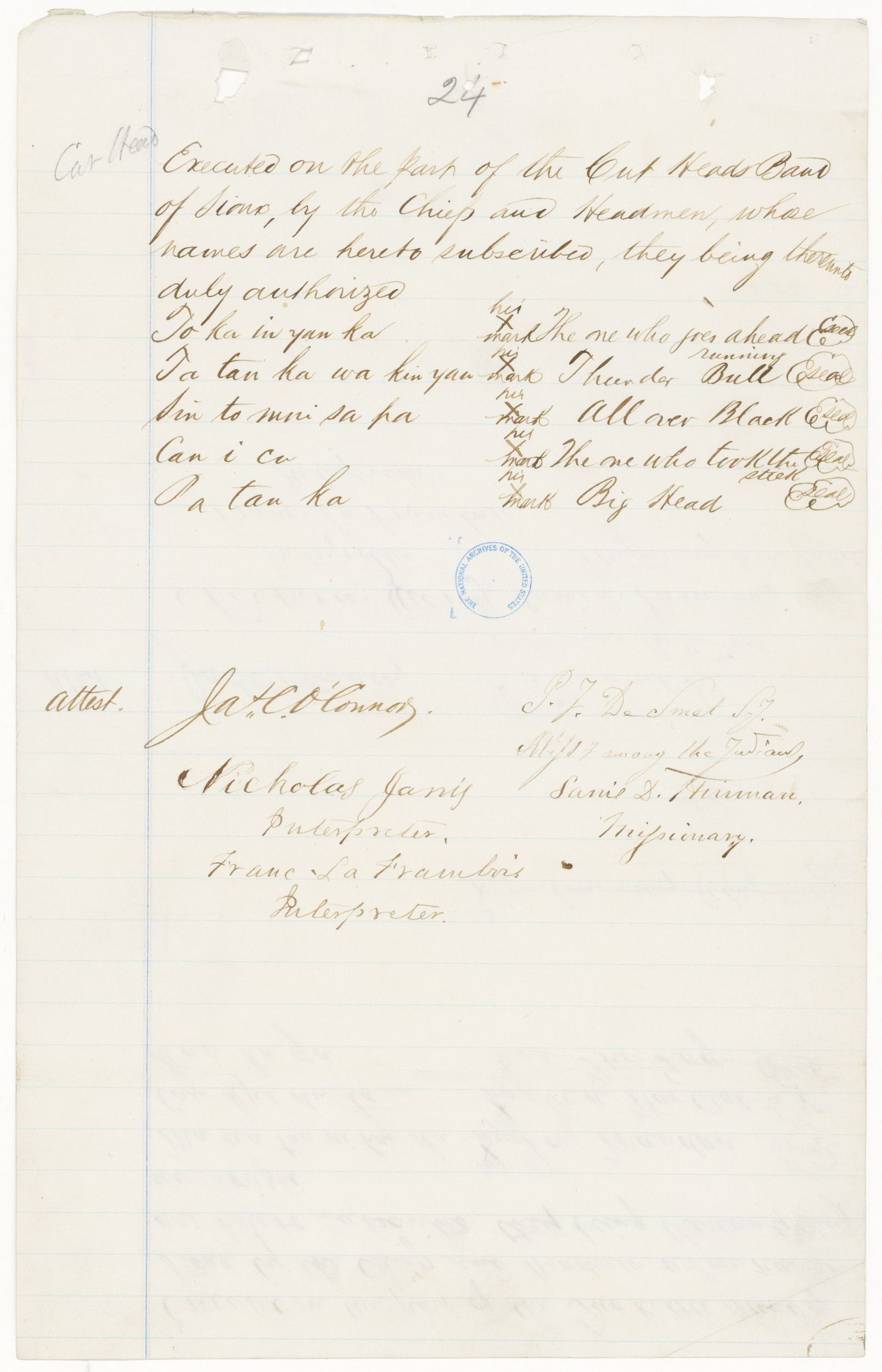
Fort Laramie Treaty
Page 32
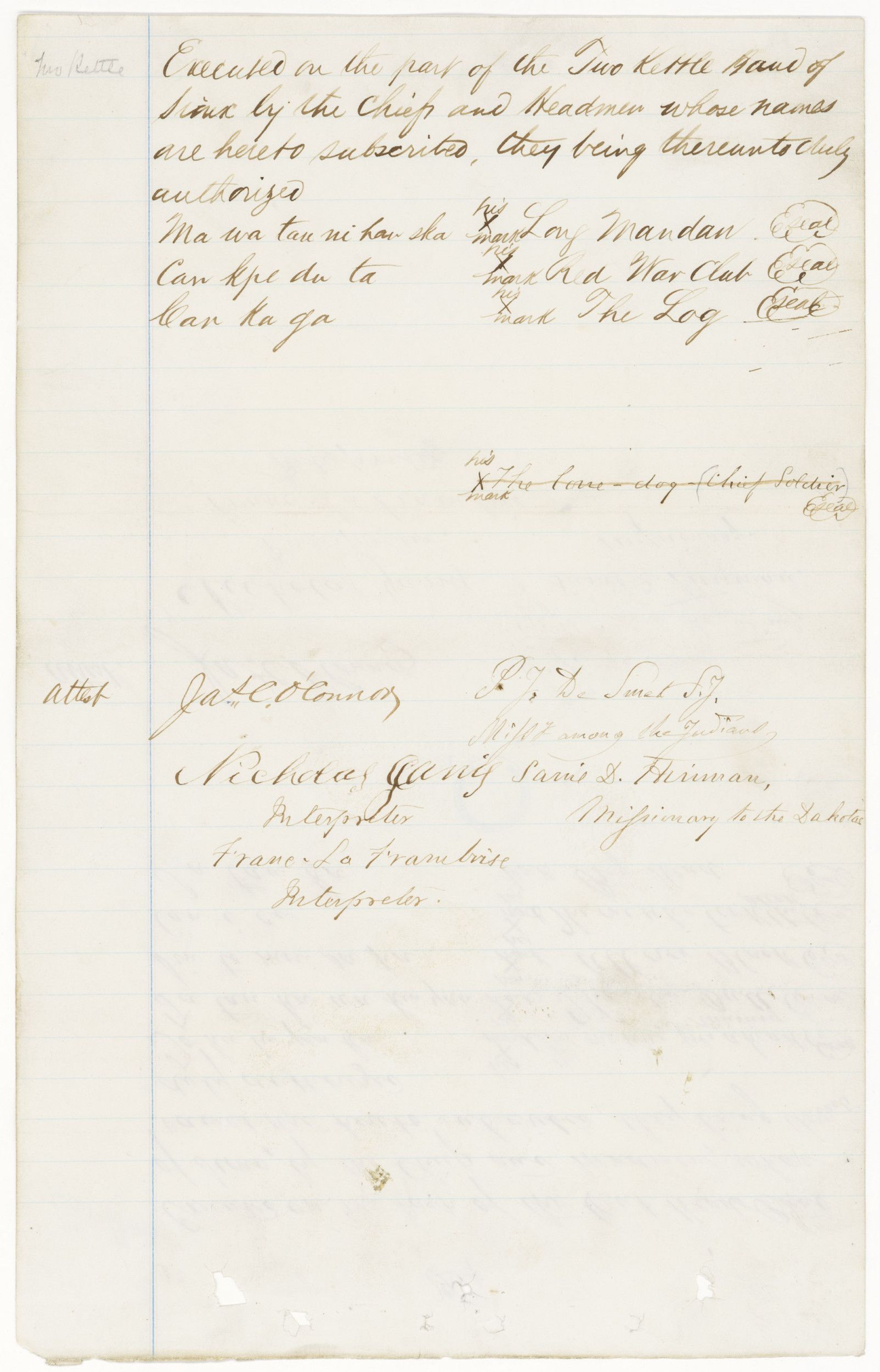
Fort Laramie Treaty
Page 33
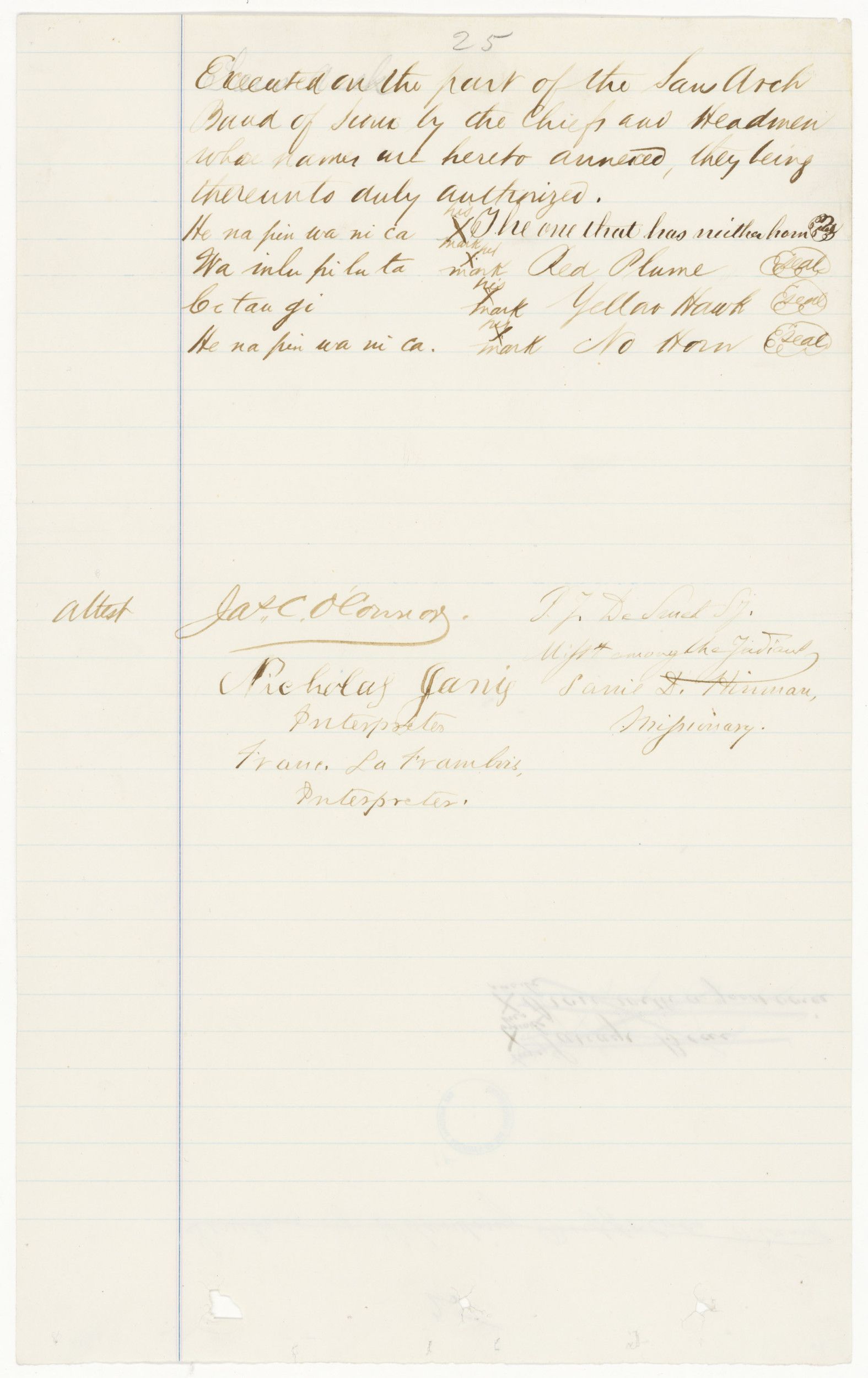
Fort Laramie Treaty
Page 34
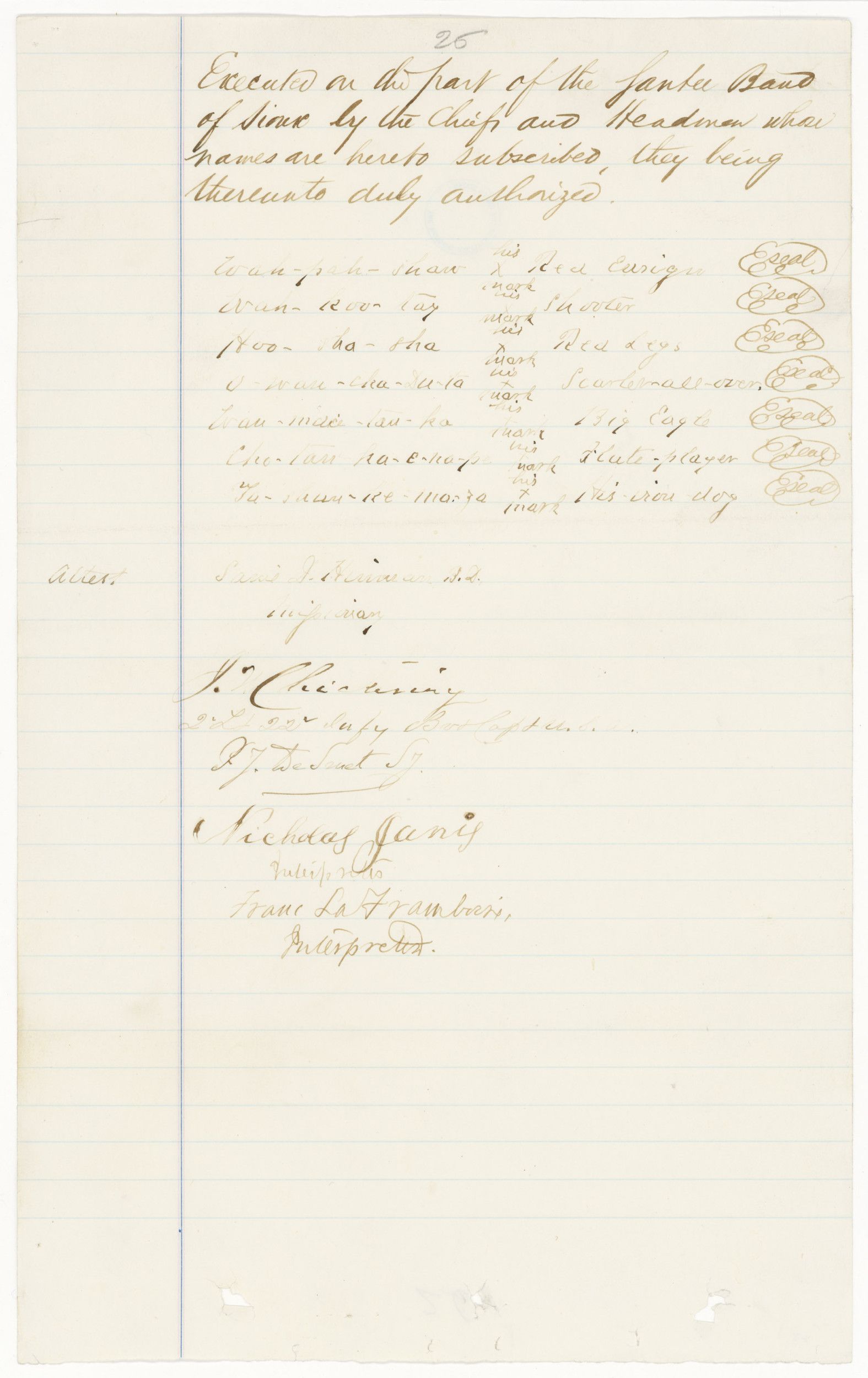
Fort Laramie Treaty
Page 35
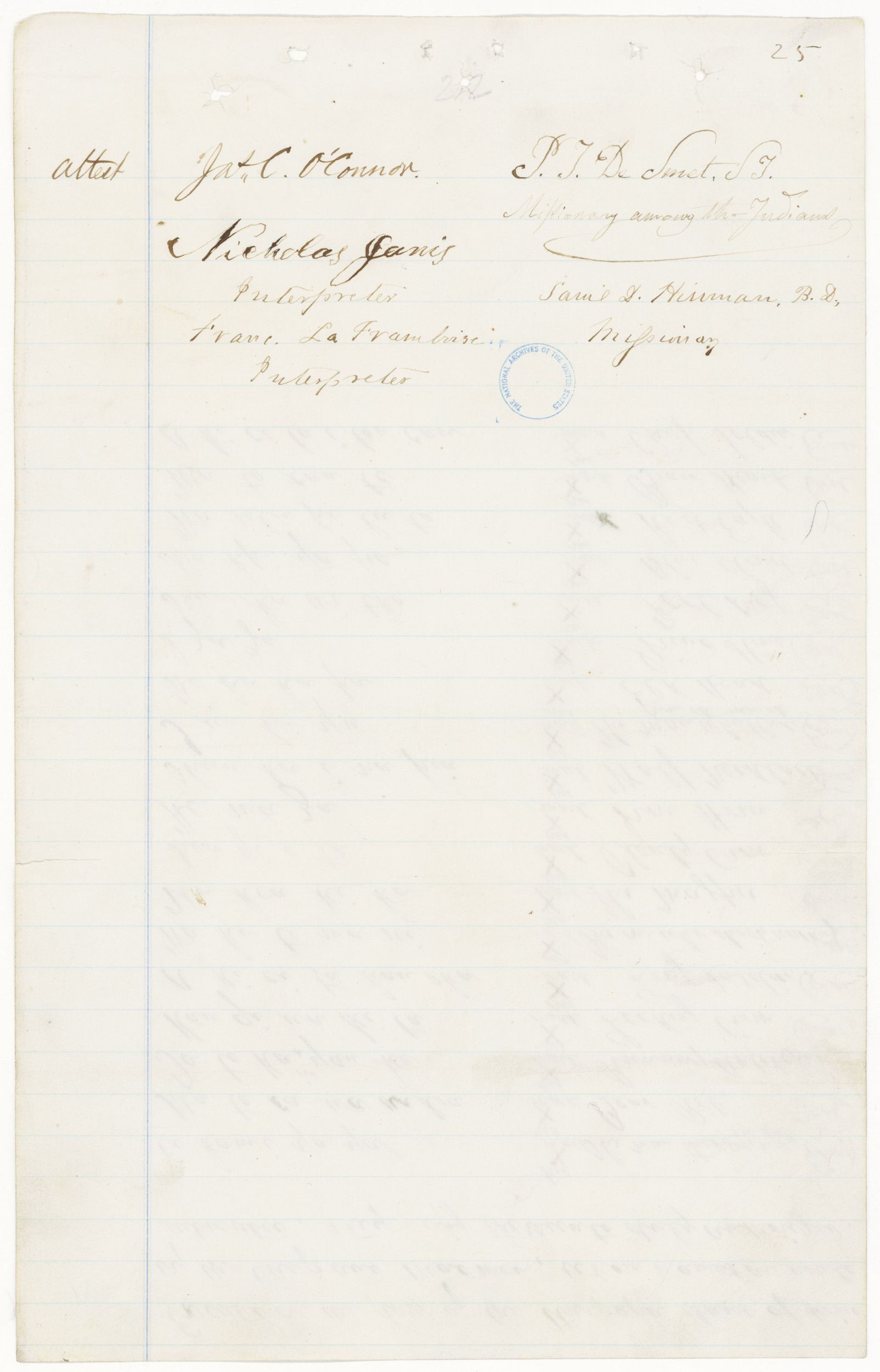
Fort Laramie Treaty
Page 36
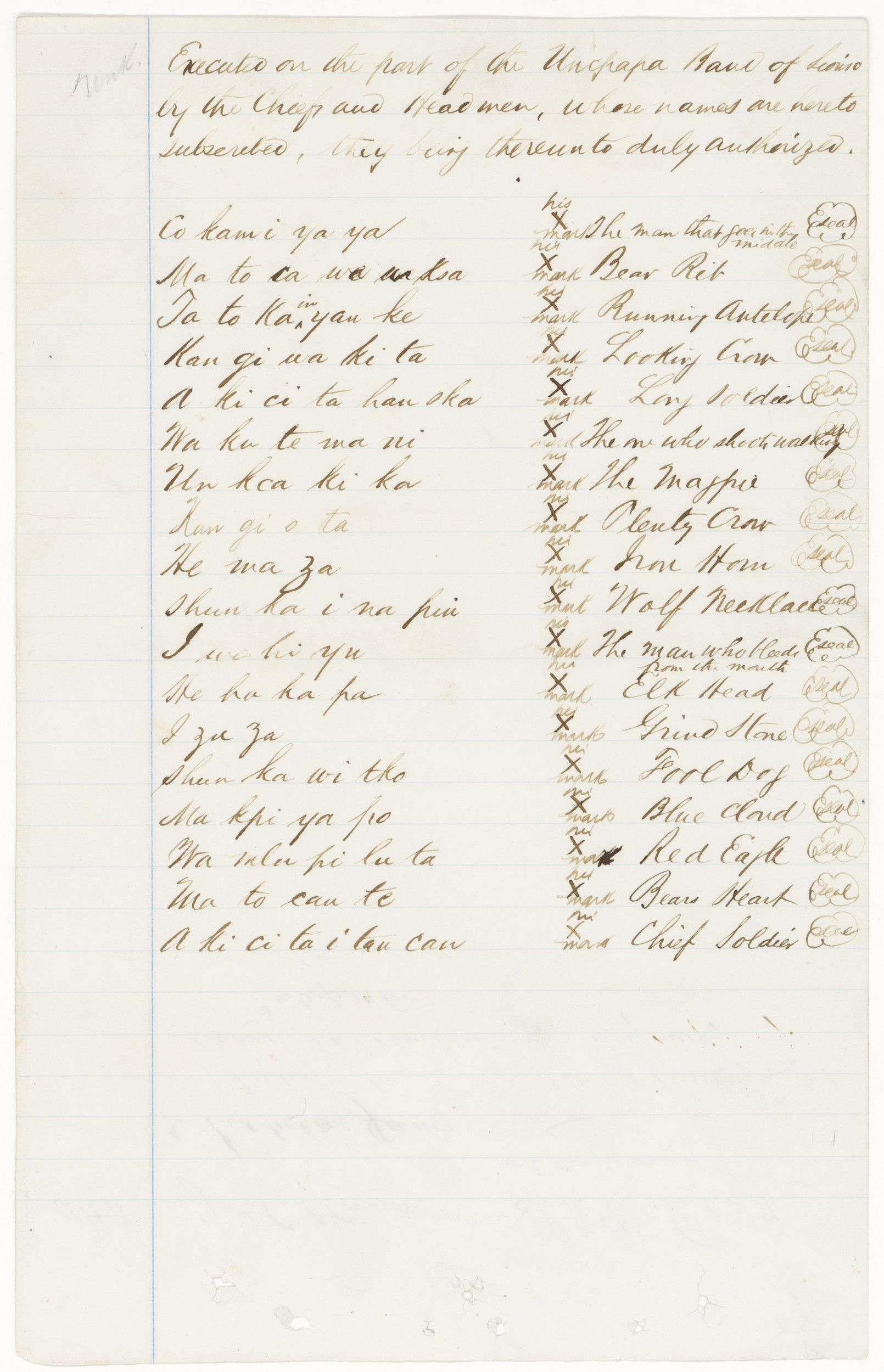
Document
Treasury Warrant in the Amount of $7.2 Million for the Purchase of Alaska
8/1/1868
In 1866 the Russian government had offered to sell the territory to the United States. Secretary of State William H. Seward, enthusiastic about the prospects of American Expansion, negotiated the deal for the Americans. Edouard de Stoeckl, Russian minister to the United States, negotiated for the Russians.
Opponents of the Alaska Purchase called it “Seward’s Folly” or “Seward’s Icebox” until 1896, when the great Klondike Gold Strike convinced even the harshest critics that Alaska was a valuable addition to American territory.
Treasury Warrant in the Amount of $7.2 Million for the Purchase of Alaska
Page 1

Treasury Warrant in the Amount of $7.2 Million for the Purchase of Alaska
Page 2
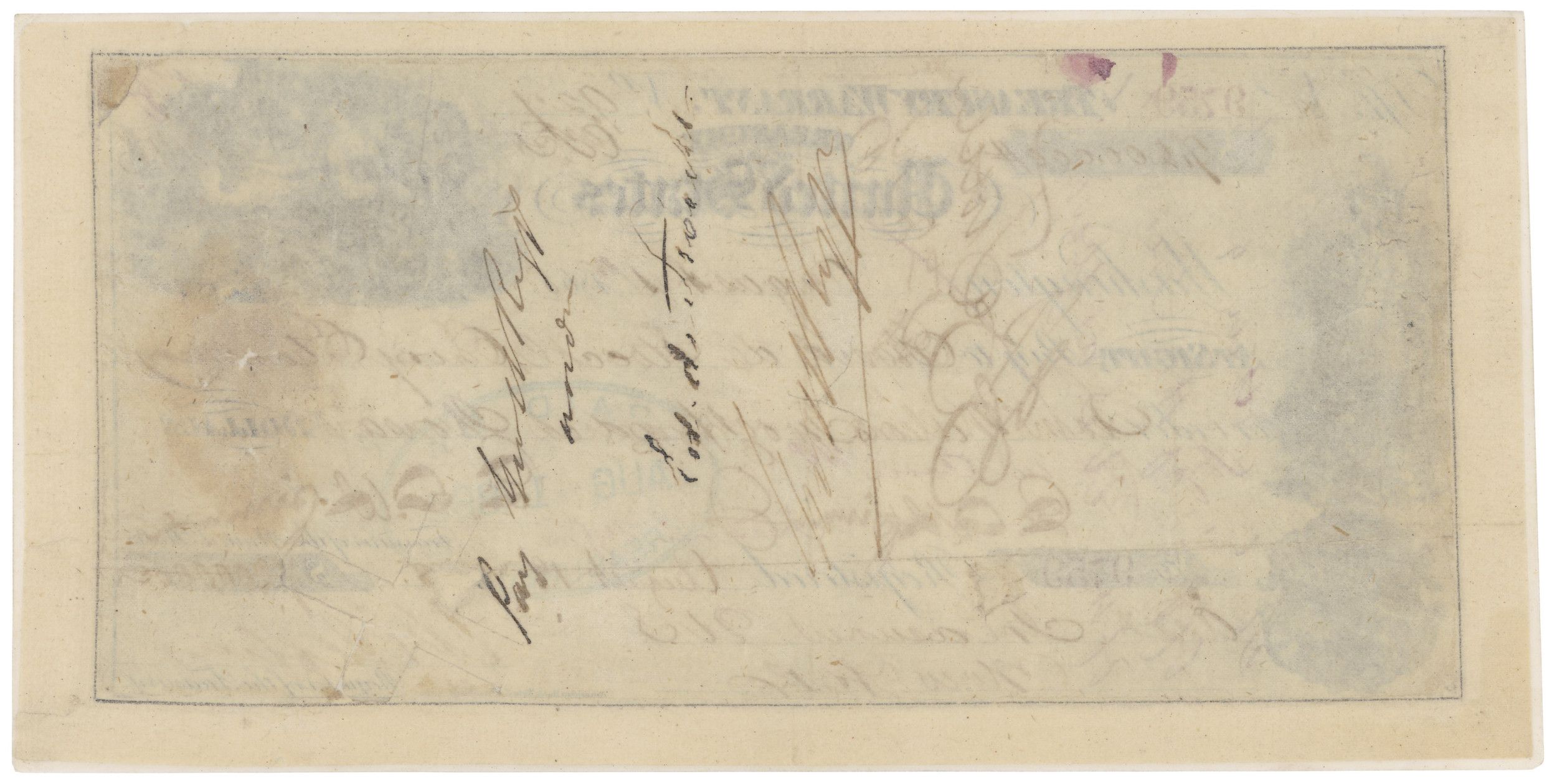
Document
Telegram from Major Robert Anderson to the Secretary of War
4/18/1861
When Abraham Lincoln took office, the nation was breaking apart. South Carolina, Mississippi, Florida, Alabama, Georgia, Louisiana, and Texas had already seceded. In his inaugural address on March 4, 1861, President Abraham Lincoln asserted that secession was unconstitutional, that the Union of the states was perpetual, and states could not leave it at will.
As the first states seceded, they seized most forts, arsenals, and federal property inside their borders. On April 10, 1861, Brigadier General Pierre G.T. Beauregard, in command of the provisional Confederate forces at Charleston, South Carolina, demanded the surrender of the U.S. garrison of Fort Sumter in Charleston Harbor. Garrison commander Major Robert Anderson refused.
On April 12, the Confederate batteries opened fire on the fort, which was unable to reply effectively. At 2:30 p.m., April 13, Major Anderson surrendered Fort Sumter, evacuating the garrison on the following day. The battle had started at 4:30 a.m. and ended 34 hours later.
Major Anderson notified Secretary of War Simon Cameron of the outcome of the battle by telegram five days after he surrendered to Confederate Brigadier General Pierre G.T. Beauregard, as seen in this document.
The bombardment of Fort Sumter was the opening engagement of the American Civil War. From 1863 to 1865, the Confederates at Fort Sumter withstood a 22-month siege by Union forces. During this time, most of the fort was reduced to brick rubble.
Transcript
S.S. Baltic. off Sandy Hook apr. Eighteenth Ten Thirty A.M. via New York. Hon. S. Cameron. Secy. War Washn. Having defended Fort Sumter for thirty four hours until the quarters were entirely burned the main gates destroyed by fire. The gorge walls seriously injured. The magazine surrounded by flames and its doors closed from the effects of heat. Four barrells and three cartridges of powder only being available and no provisions remaining but pork. I accepted terms of evacuation offered by General Beauregard being on same offered by him on the eleventh inst. Prior to the commencement of hostilities and marched out of the fort Sunday afternoon the fourteenth inst. With colors flying and drums beating. Bringing away company and private property and saluting my flag with fifty guns. Robert Anderson. Major First Artillery. Commanding.Telegram from Major Robert Anderson to the Secretary of War
Page 1
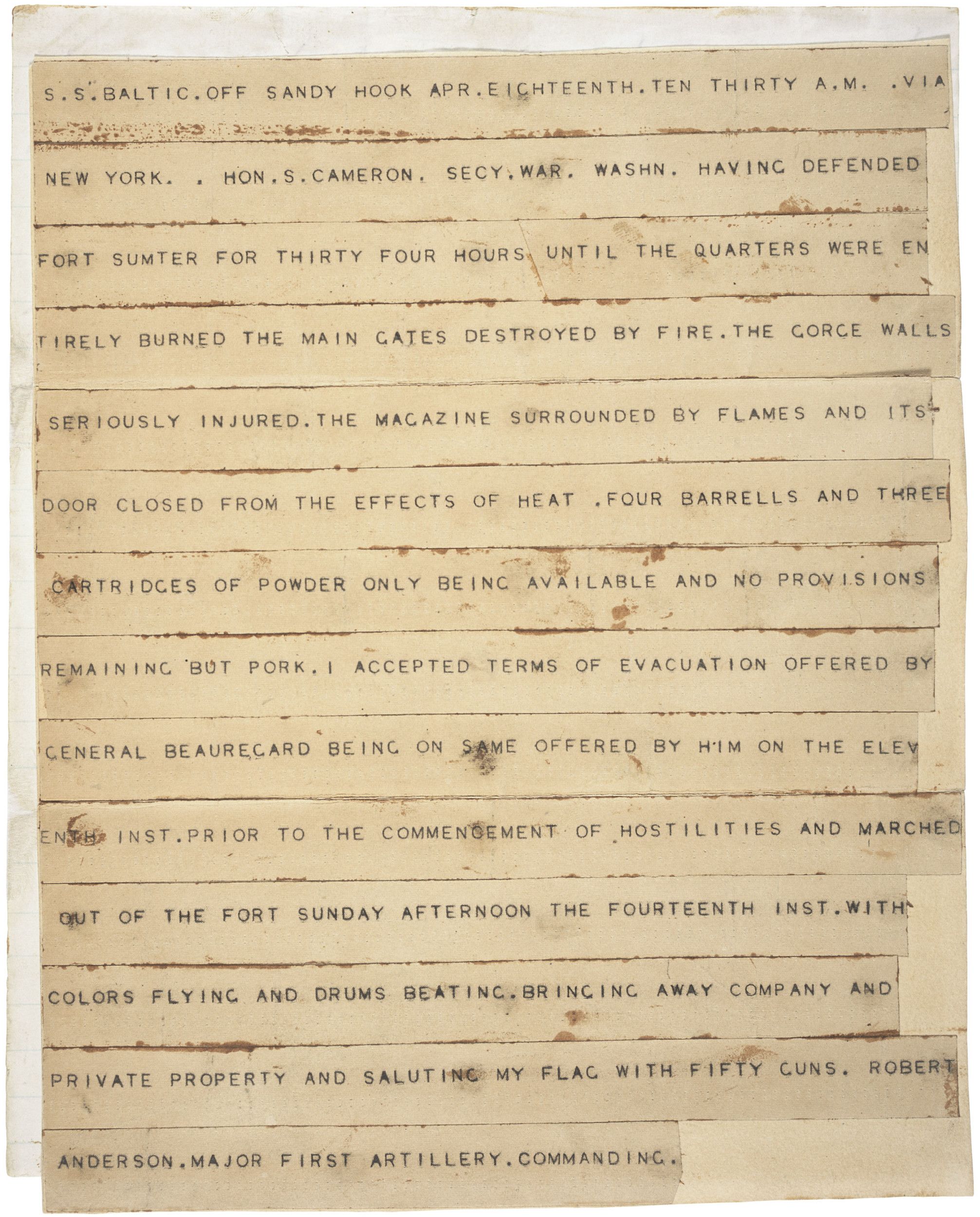
Telegram from Major Robert Anderson to the Secretary of War
Page 2
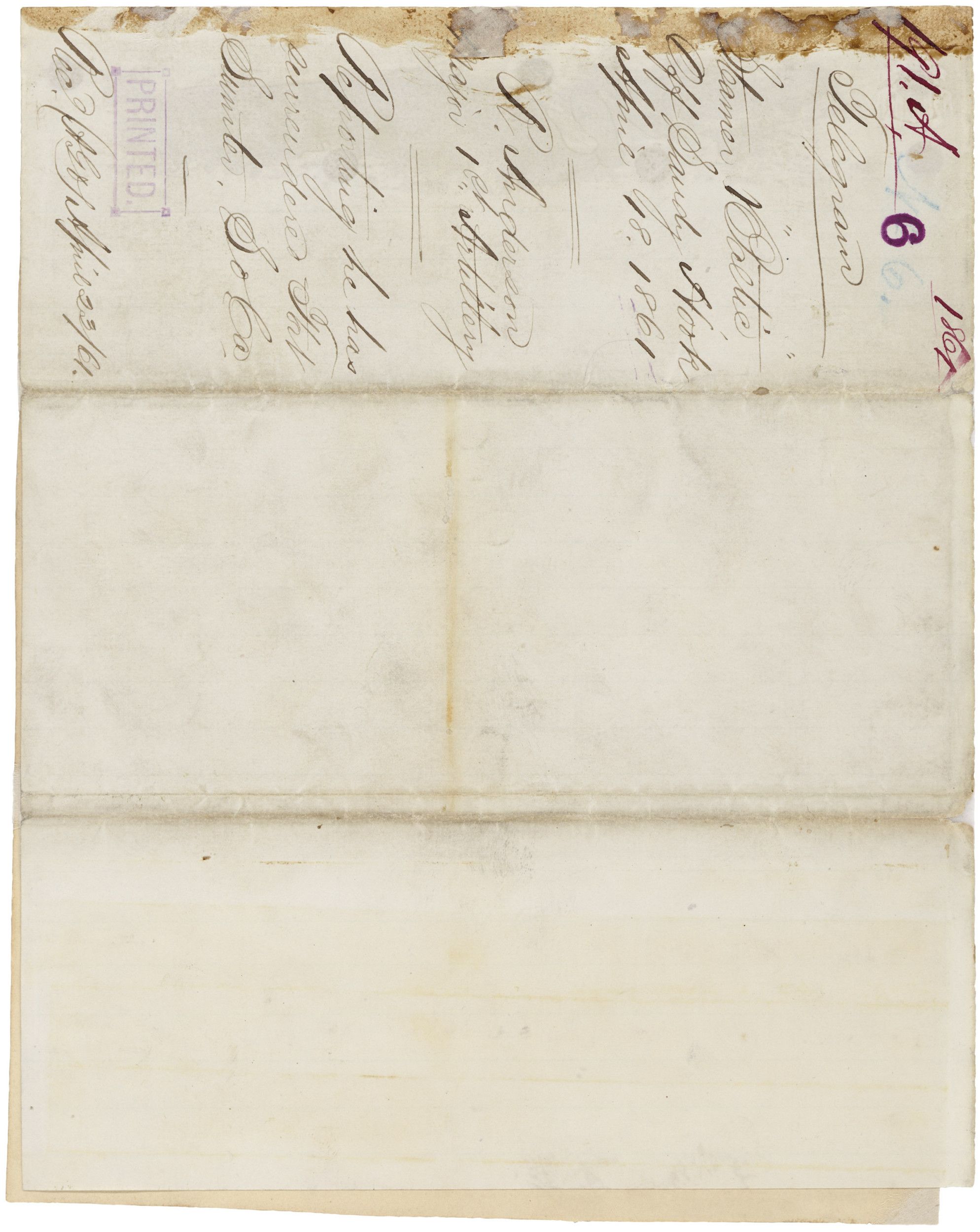
Document
Joint Resolution Proposing the Fifteenth Amendment to the United States Constitution
2/26/1869
To former abolitionists and to the Radical Republicans in Congress who fashioned Reconstruction after the Civil War, the 15th amendment appeared to signify the fulfillment of all promises to African Americans. Set free by the 13th amendment, with citizenship guaranteed by the 14th amendment, Black males were given the vote by the 15th amendment.
African Americans voted and held office in many Southern states through the 1880s, but in the early 1890s, steps were taken to ensure subsequent “white supremacy.” The 15th Amendment had been carefully worded to maximize its chances of ratification. It didn't go so far as to grant the right to vote to all citizens regardless of race —instead, it barred states from denying suffrage based on race, opening a loophole for literacy, land ownership, or other requirements. It was a loophole that Southern states quickly exploited to effectively ban Black people from the polls.
Literacy tests for the vote, “grandfather clauses” excluding those whose ancestors had not voted in the 1860s, and other devices to disenfranchise African Americans were written into the laws of former Confederate states.
Social and economic segregation were added to Black America’s loss of political power. In 1896, the Supreme Court decision Plessy v. Ferguson legalized “separate but equal” facilities for the races. For more than 50 years, the overwhelming majority of African American citizens were reduced to second-class citizenship under the “Jim Crow” segregation system.
During that time, African Americans sought to secure their rights and improve their position through organizations such as the National Association for the Advancement of Colored People (N.A.A.C.P.) and the National Urban League, and through the individual efforts of reformers like Booker T. Washington, W.E.B. DuBois, and A. Philip Randolph.
The most direct attack on the problem of African-American disfranchisement came in 1965. Prompted by reports of continuing discriminatory voting practices in many Southern states, President Lyndon B. Johnson urged Congress to pass legislation “which will make it impossible to thwart the 15th amendment.” He reminded Congress that “we cannot have government for all the people until we first make certain it is government of and by all the people.”
The Voting Rights Act of 1965, extended in 1970, 1975, and 1982, abolished all remaining deterrents to exercising the right to vote and authorized federal supervision of voter registration where necessary. In 2013, the Supreme Court struck down a key provision of the act involving federal oversight of voting rules in nine states.
Transcript
Fortieth Congress of the United States of America;At the third Session, Begun and held at the city of Washington, on Monday, the seventh day of December, one thousand eight hundred and sixty-eight.
A Resolution
Proposing an amendment to the Constitution of the United States.
Resolved by the Senate and House of Respresentatives of the United States of America in Congress assembled, (two-thirds of both Houses concurring) that the following article be proposed to the legislature of the several States as an amendment to the Constitution of the United States which, when ratified by three-fourths of said legislatures shall be valid as part of the Constitution, namely:
Article XV.
Section 1. The right of citizens of the United States to vote shall not be denied or abridged by the United States or by any State on account of race, color, or previous condition of servitude—
Section 2. The Congress shall have the power to enforce this article by appropriate legislation.
ED McPherson
Clerk of House of Representatives.
Geo. C. Gorham
Secy of Senate U.S.
Joint Resolution Proposing the Fifteenth Amendment to the United States Constitution
Page 1
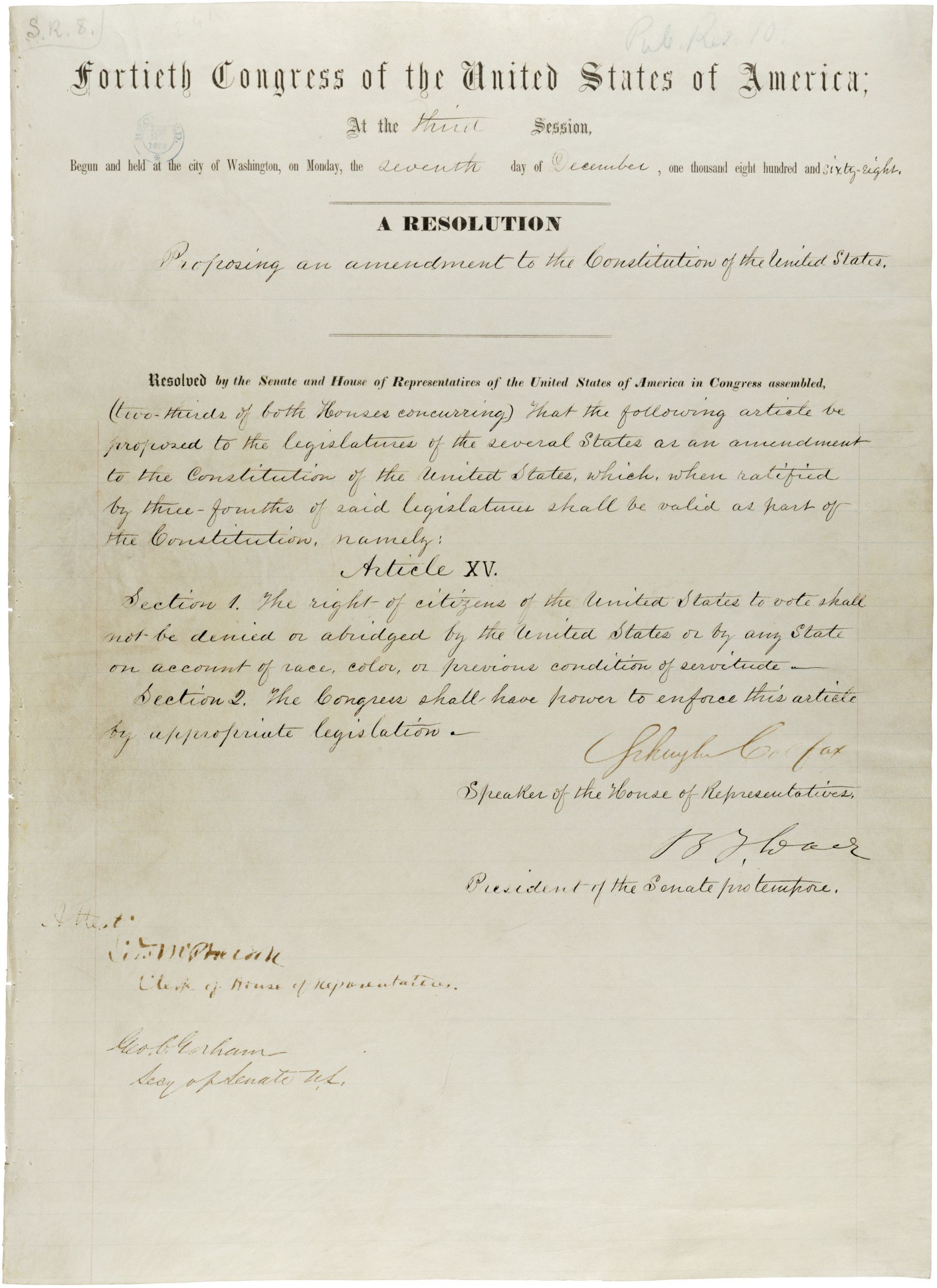
Document
Petition from Lewis Douglass and Others to the Secretary of War
1865
Transcript
[printed]Hon. E.M. Stanton, Secretary of War:
In view of the recent proclamation of the President calling for 300,000 volunteers, and appreciating the necessity of an immediate response to this call, we would respectfully petition that permission be given to raise a number of [italics] colored regiments, [end italics] to be officered [italics] exclusively [end italics] by [italics] colored men. [end italics]
In regard to the policy of this measure, we would respectfully urge that while many of the noblest of our race have sprung to arms with alacrity in defence of the Government, many others, equally loyal, have hesitated because one of the greatest incentives to enlistment, and the greatest stimulus to the strict performance of a soldier’s duty—the hope of promotion—has been denied them.
We confidently believe that the removal of this bar to a soldier’s ambition would result in an uprising of the colored people, unsurpassed even by the enthusiastic response to the President’s first call.
In regard to the capability of colored men to perform the duties of commissioned officers, we would respectfully suggest there are hundreds of non-commissioned officers in colored regiments who are amply qualified for these positions both by education and experience, and that others of our educated men, anticipating the granting of commissions to colored men by the Government, have applied themselves to the study of military tactics, in order that men properly educated might not be wanting to accept them.
And your petitioners will ever pray, &c.
LEWIS H. DOUGLASS, late Sergeant Major 54th Massachusetts Volunteers.
JAMES T. WORMLEY, Sergeant 5th Massachusetts Cavalry.
BENJAMIN OWSLEY, Sergeant 27th [strikethrough]New York [end strikethrough] Colored Troops.
CHARLES R. DOUGLASS, late Sergeant 5th Massachusetts Cavalry Volunteers.
JOHN H. RAPIER, A.A. Surgeon U.S. Army.
WILLIAM R. ELLIS, A.A. Surgeon U.S. Army.
THOMAS J. WHITE.
DAVID E. WYCOFF, late Sergeant 108th New York Volunteers.
JAMES R. MARTIN,
A.R. ABBOTT, A.A. Surgeon U.S. Army.
[double horizontal line dividing page]
We the undersigned, cordially endorse the above:
[signed] Jas S Negley Major Genl USA
[signed] N.P. Banks M.G. V.
[signed] R.T. Auchmuty Major & A.A.G. Vols.
[handwritten]
I endorse the above petition, believing that differences of race, color or nationality should be no obstacle to the appointment or promotion to the rank of commissioned officer if the applicant is otherwise qualified to command. It should be a sign of progress
and justice in this Government and a great vindication of the colored race, if the above problem could be solved satisfactorily, which I do not doubt, it can.
[signed] F. Sigel
Maj. Genl.
I believe that so soon as the men having the necessary military experience and capacity can be found, Colored men should upon merit be eligible to the command of colored
Companies and Regiments. In other words that color should be no barrier to
such promotion.
[signed] Stephen Miller
Govr. Minn
St. Paul Jany 16. 1865.
Petition from Lewis Douglass and Others to the Secretary of War
Page 1
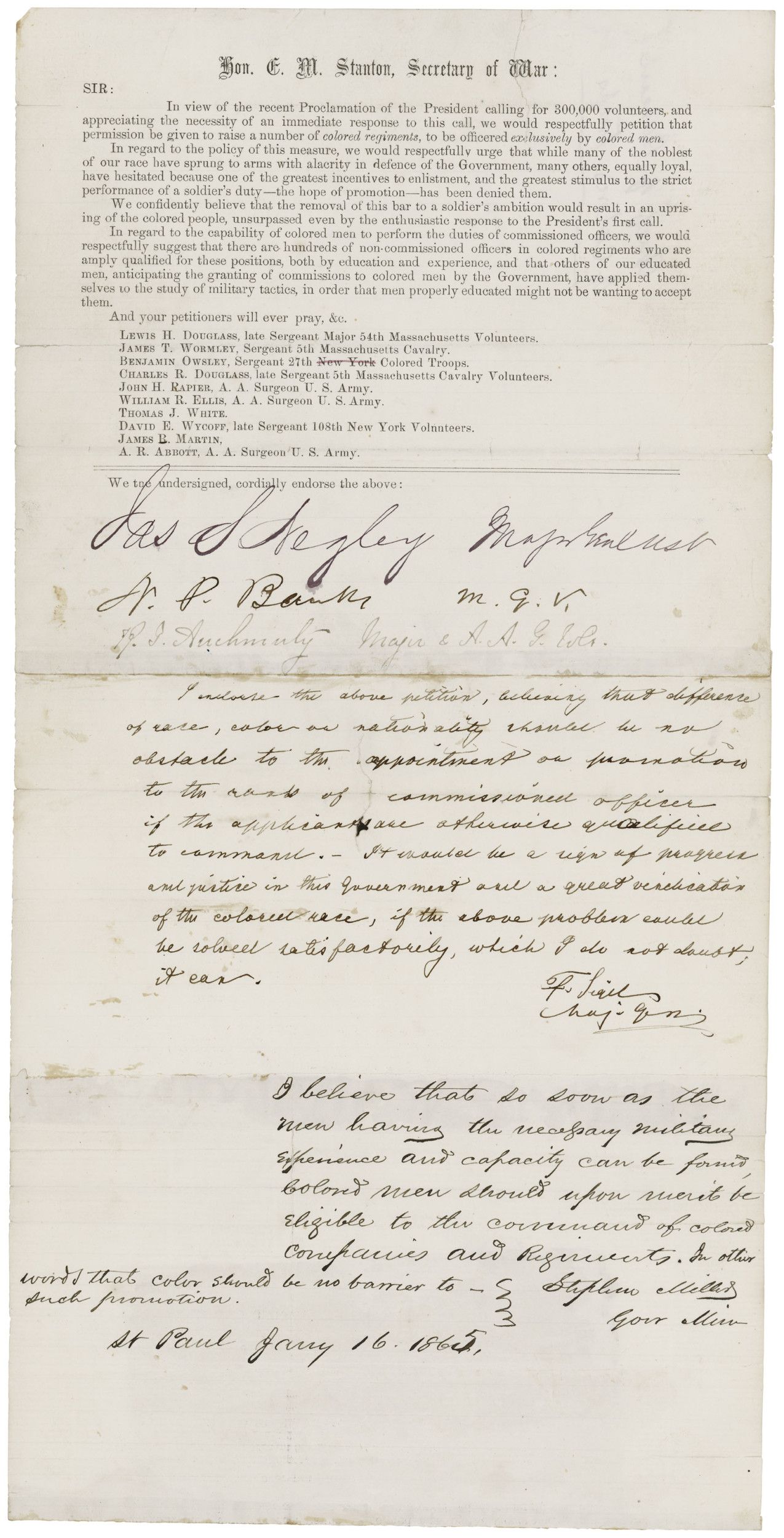
Petition from Lewis Douglass and Others to the Secretary of War
Page 2
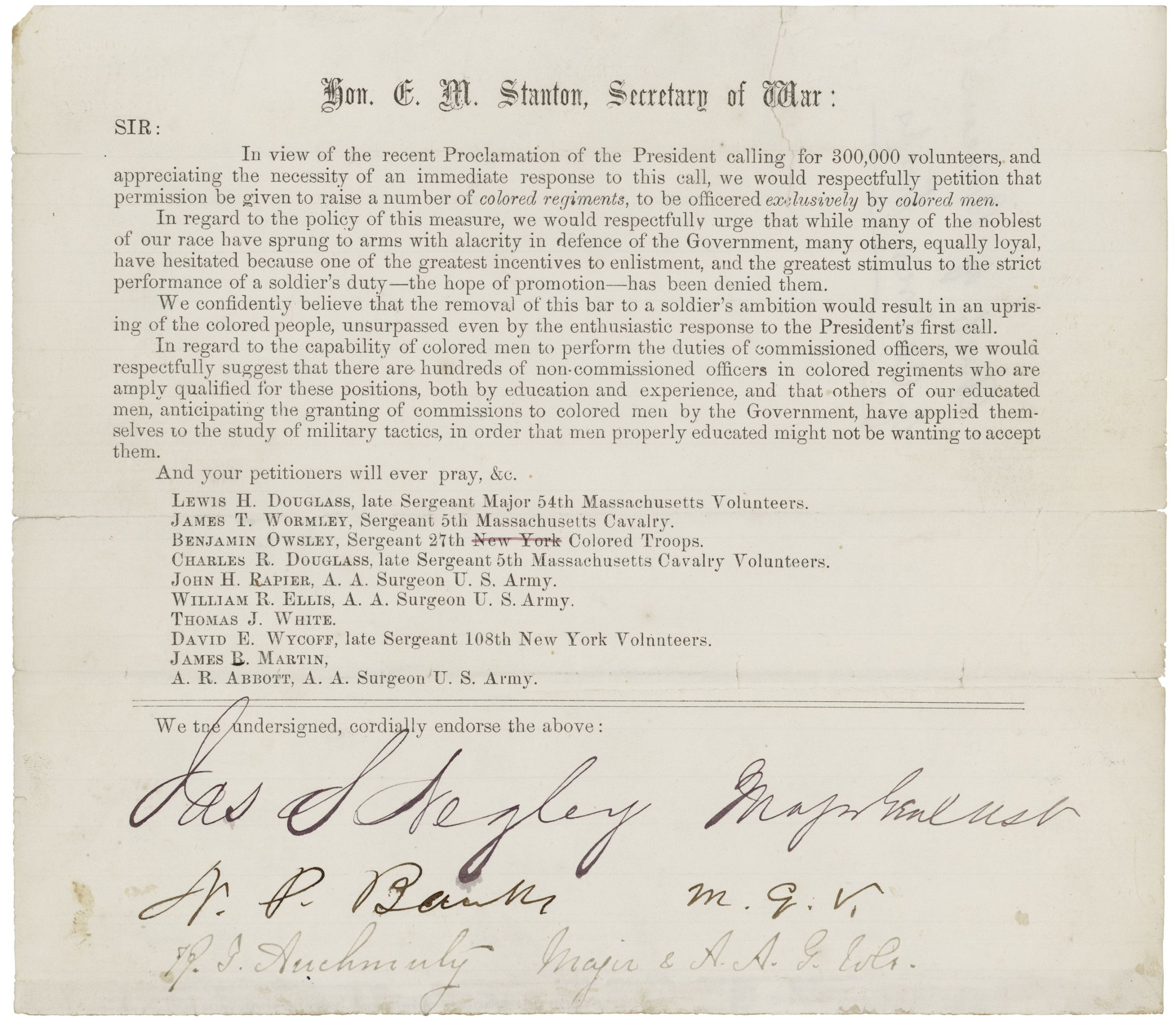
Petition from Lewis Douglass and Others to the Secretary of War
Page 3
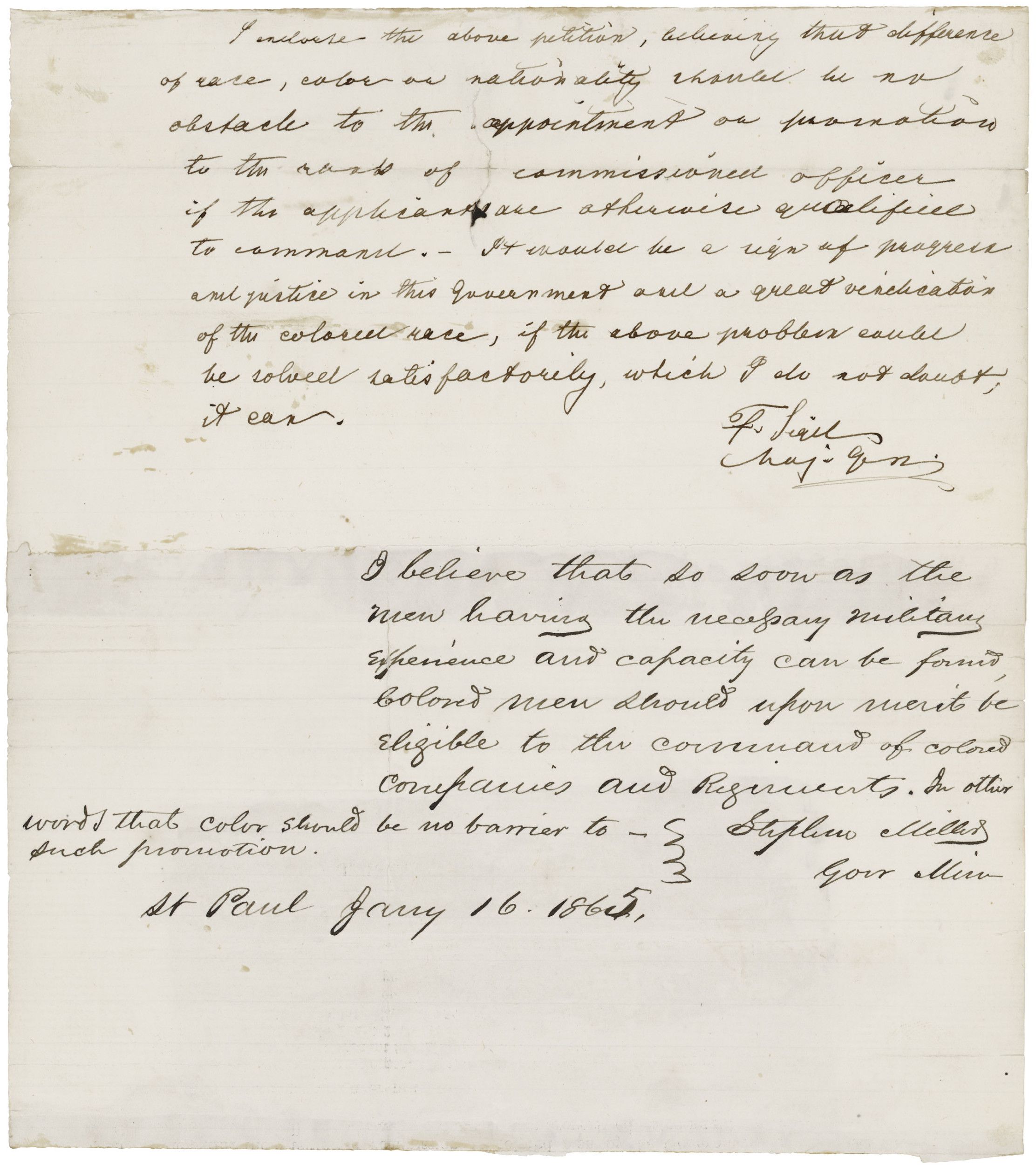
Document
Emancipation Proclamation
1/1/1863
Initially, the Civil War between North and South was fought by the North to prevent the secession of the Southern states and preserve the Union. Even though sectional conflicts over slavery had been a major cause of the war, ending slavery was not a goal of the war. That changed on September 22, 1862, when President Lincoln issued his Preliminary Emancipation Proclamation, which stated that enslaved people in those states or parts of states still in rebellion as of January 1, 1863, would be declared free. One hundred days later, with the rebellion unabated, President issued the Emancipation Proclamation declaring "that all persons held as slaves" within the rebellious areas "are, and henceforward shall be free."
Lincoln’s bold step to change the goals of the war was a military measure and came just a few days after the Union’s victory in the Battle of Antietam. With this Proclamation he hoped to inspire all Black people, and enslaved people in the Confederacy in particular, to support the Union cause and to keep England and France from giving political recognition and military aid to the Confederacy.
Because it was a military measure, however, the Emancipation Proclamation was limited in many ways. It applied only to states that had seceded from the Union, leaving slavery untouched in the loyal border states. It also expressly exempted parts of the Confederacy that had already come under Union control. Most important, the freedom it promised depended upon Union military victory.
Although the Emancipation Proclamation did not end slavery in the nation, it did fundamentally transform the character of the war. After January 1, 1863, every advance of Federal troops expanded the domain of freedom. Moreover, the Proclamation announced the acceptance of Black men into the Union Army and Navy, enabling the liberated to become liberators. By the end of the war, almost 200,000 Black soldiers and sailors had fought for the Union and freedom.
From the first days of the Civil War, enslaved people had acted to secure their own liberty. The Emancipation Proclamation confirmed their insistence that the war for the Union must become a war for freedom. It added moral force to the Union cause and strengthened the Union both militarily and politically. As a milestone along the road to slavery's final destruction, the Emancipation Proclamation has assumed a place among the great documents of human freedom.
Transcript
By the President of the United States of America:A Proclamation.
Whereas, on the twenty-second day of September, in the year of our Lord one thousand eight hundred and sixty-two, a proclamation was issued by the President of the United States, containing, among other things, the following, to wit:
"That on the first day of January, in the year of our Lord one thousand eight hundred and sixty-three, all persons held as slaves within any State or designated part of a State, the people whereof shall then be in rebellion against the United States, shall be then, thenceforward, and forever free; and the Executive Government of the United States, including the military and naval authority thereof, will recognize and maintain the freedom of such persons, and will do no act or acts to repress such persons, or any of them, in any efforts they may make for their actual freedom.
"That the Executive will, on the first day of January aforesaid, by proclamation, designate the States and parts of States, if any, in which the people thereof, respectively, shall then be in rebellion against the United States; and the fact that any State, or the people thereof, shall on that day be, in good faith, represented in the Congress of the United States by members chosen thereto at elections wherein a majority of the qualified voters of such State shall have participated, shall, in the absence of strong countervailing testimony, be deemed conclusive evidence that such State, and the people thereof, are not then in rebellion against the United States."
Now, therefore I, Abraham Lincoln, President of the United States, by virtue of the power in me vested as Commander-in-Chief, of the Army and Navy of the United States in time of actual armed rebellion against the authority and government of the United States, and as a fit and necessary war measure for suppressing said rebellion, do, on this first day of January, in the year of our Lord one thousand eight hundred and sixty-three, and in accordance with my purpose so to do publicly proclaimed for the full period of one hundred days, from the day first above mentioned, order and designate as the States and parts of States wherein the people thereof respectively, are this day in rebellion against the United States, the following, to wit:
Arkansas, Texas, Louisiana, (except the Parishes of St. Bernard, Plaquemines, Jefferson, St. John, St. Charles, St. James Ascension, Assumption, Terrebonne, Lafourche, St. Mary, St. Martin, and Orleans, including the City of New Orleans) Mississippi, Alabama, Florida, Georgia, South Carolina, North Carolina, and Virginia, (except the forty-eight counties designated as West Virginia, and also the counties of Berkley, Accomac, Northampton, Elizabeth City, York, Princess Ann, and Norfolk, including the cities of Norfolk and Portsmouth[)], and which excepted parts, are for the present, left precisely as if this proclamation were not issued.
And by virtue of the power, and for the purpose aforesaid, I do order and declare that all persons held as slaves within said designated States, and parts of States, are, and henceforward shall be free; and that the Executive government of the United States, including the military and naval authorities thereof, will recognize and maintain the freedom of said persons.
And I hereby enjoin upon the people so declared to be free to abstain from all violence, unless in necessary self-defence; and I recommend to them that, in all cases when allowed, they labor faithfully for reasonable wages.
And I further declare and make known, that such persons of suitable condition, will be received into the armed service of the United States to garrison forts, positions, stations, and other places, and to man vessels of all sorts in said service.
And upon this act, sincerely believed to be an act of justice, warranted by the Constitution, upon military necessity, I invoke the considerate judgment of mankind, and the gracious favor of Almighty God.
In witness whereof, I have hereunto set my hand and caused the seal of the United States to be affixed.
Done at the City of Washington, this first day of January, in the year of our Lord one thousand eight hundred and sixty three, and of the Independence of the United States of America the eighty-seventh.
By the President: ABRAHAM LINCOLN
WILLIAM H. SEWARD, Secretary of State.
Emancipation Proclamation
Page 1

Emancipation Proclamation
Page 2
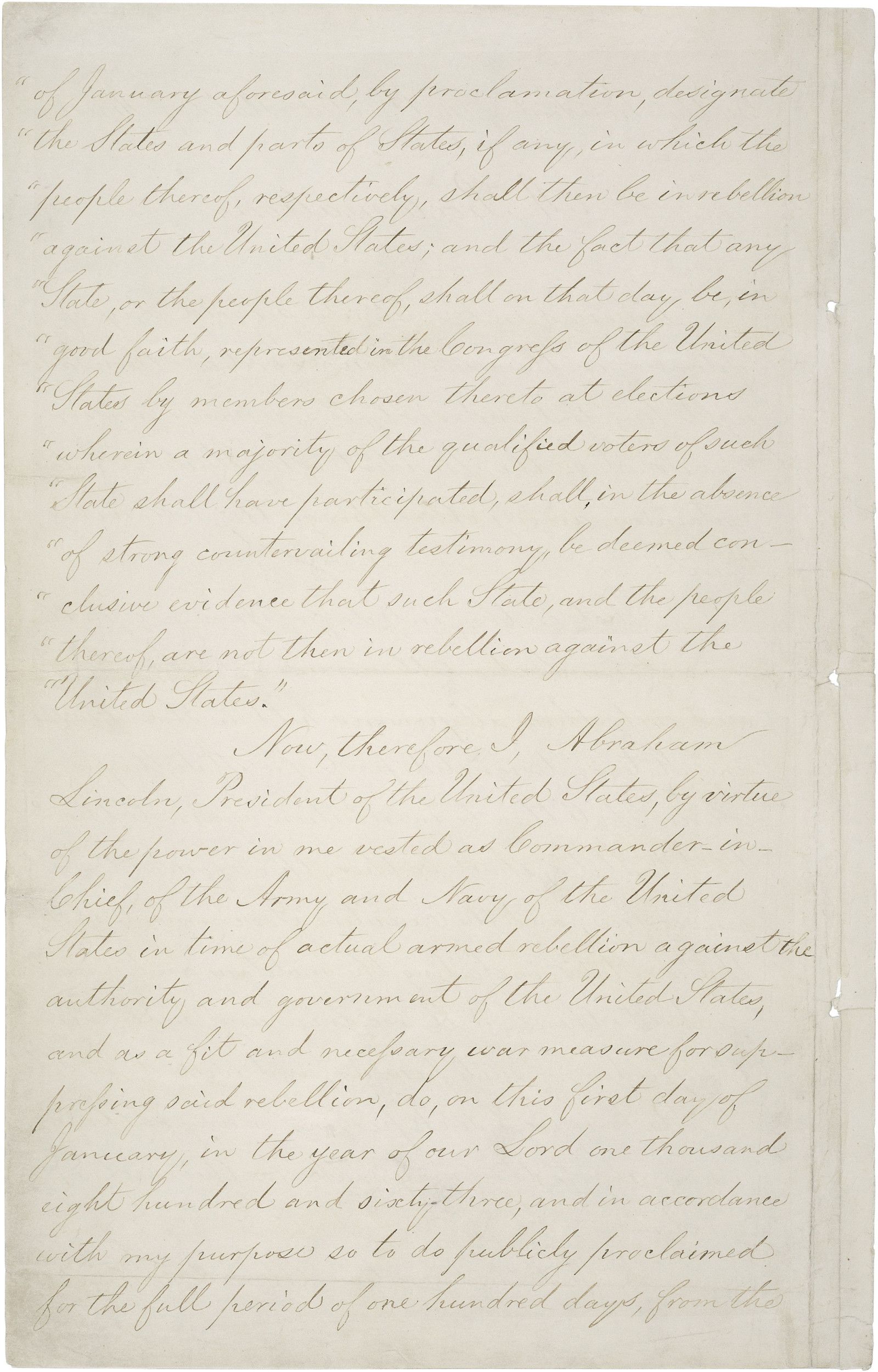
Emancipation Proclamation
Page 3
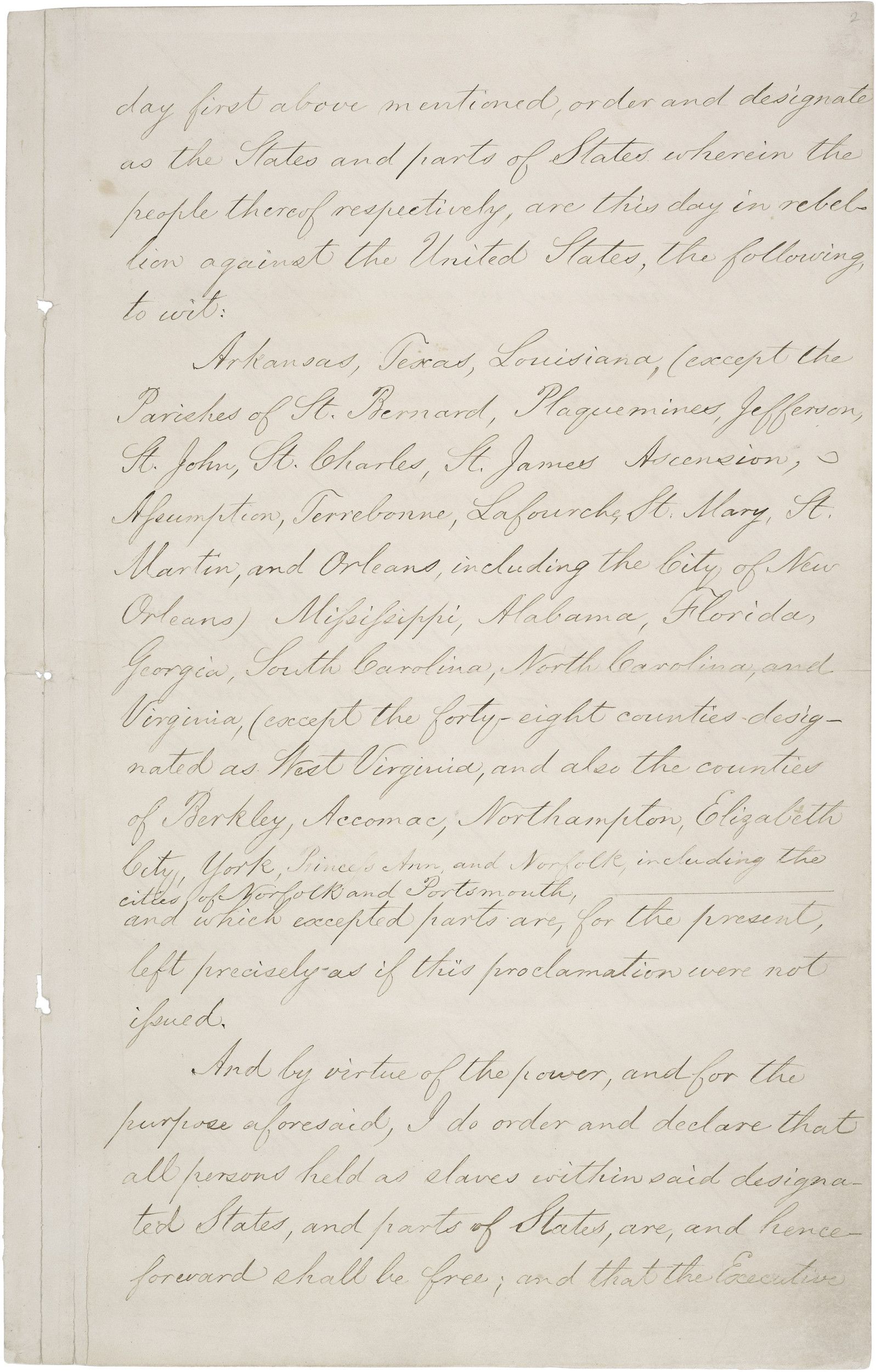
Emancipation Proclamation
Page 4

Emancipation Proclamation
Page 5
